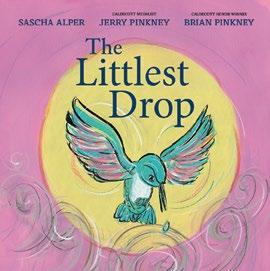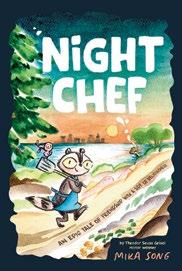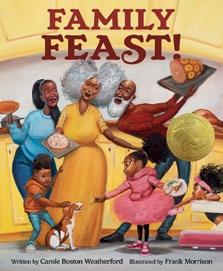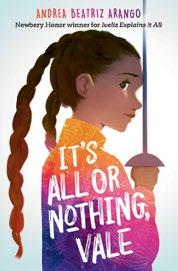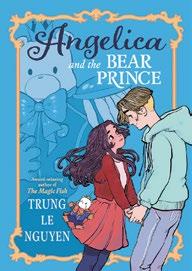HOLIDAY gift guide 2025





SEASON’S GREETINGS, READERS. It’s always a treat to bring you our Holiday Gift Guide. All year long, the editors have been making a list (and checking it twice) of the big, beautiful books that avid readers will love to give and receive. This time around, we’re featuring a smorgasbord of options for cookbook collectors, film buffs, artists and designers, fashion plates, history hounds, mystery lovers, thriller fans, graphic-novel enthusiasts, and young readers of every level. When the stockings are hung, and the candles are lit, you can count on Kirkus to have the right recommendation for everyone on your list.

David Hockney
Rosenthal, Norman Thames & Hudson, $60
A beautifully produced, engaging homage.

The Frick Collection: The Historic Interiors of One East Seventieth Street
Saloman, Xavier F.; photographs by Miguel Flores-Vianna Rizzoli Electa, $65
A room-by-room tour of the iconic museum heralds its long-awaited reopening.
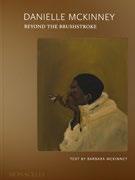
Danielle Mckinney: Beyond the Brushstroke
Mckinney, Danielle and Barbara Mckinney Phaidon, $49.95
This ingenious book pairs portraits with journal prompts to deepen engagement.

Spatial Alchemy: Design Your Home To Transform Your Life
Naiman, Olga Artisan, $35
Ably shows how mindful design serves personal goals.

Garris, Christopher; photographs by Guido Taroni Vendome Press, $75
Take a sensuous journey through resplendent Sicilian homes.
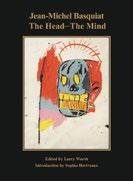
Warsh, Larry; with Sophia Heriveaux No More Rulers, $49.95
An intriguing look at a recurring motif in Basquiat’s oeuvre.

The American Art Book (Revised and Updated Edition)
Phaidon Editors and Helen A. Harris Phaidon, $79.95
A snazzy redesign of an essential survey of American art.

The Ohno Book: A Serious Guide to Irreverent Type Design
Edmondson, James Chronicle Books, $29.95
A fun fount of typographical knowledge.

Color Pattern Texture: The Foundation To Make Your Home Your Own
Yip, Vern Union Square & Co., $40
Interior design fundamentals from a sparkling TV personality.

Jason Polan: The Post Office
Fulford, Jason; art by Jason Polan Printed Matter, Inc., $35
A heartfelt appreciation of the “every person in New York” artist.
To learn more and purchase these books, visit Kirkus online.


Jane Austen: The Complete Novels
Illustrated by Sarah Young Introduced by Lucy Worsley
The Folio Society, $1,250
Austen gets the deluxe Folio Society treatment: the ultimate gift for Janeites and lovers of fine books.
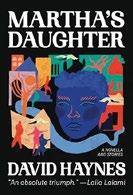
Martha’s Daughter Haynes, David McSweeney’s, $26
Haynes’ first collection of stories is a treasure trove of warmth, smarts, and wisdom.

My Brilliant Friend: The Four Volumes
Ferrante, Elena; trans. by Ann Goldstein Algonquin, $65
Ferrante fever returns with this 10th-anniversary hardcover edition of the Neapolitan Quartet.

King Sorrow Hill, Joe Morrow/HarperCollins, $38
At turns spooky and funny, with bits of inside baseball and a swimming pool’s worth of blood.

Follett, Ken Grand Central Publishing, $40
Vintage Follett. His fans will be pleased.

Lalami, Laila Pantheon, $28
An engrossing and troubling dystopian tale.

Moreno-Garcia, Silvia Del Rey, $29
Suspenseful and terrifying; Moreno-Garcia hits it out of the park yet again.

Levy, Amy Smith & Taylor Classics, $17.95 paper
How is it that Victorian novels never get old?
A lovely addition to the canon.

Stiefvater, Maggie Viking, $30
This luxurious novel is set to take the world by storm.
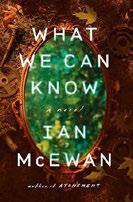
McEwan, Ian Knopf, $27
A philosophically charged tour de force by one of the best living novelists in English.
To learn more and purchase these books, visit Kirkus online.


Black-Owned: The Revolutionary Life of the Black Bookstore
Adams, Char Tiny Reparations Books, $32
A bounty of places to visit for those fond of literary tourism.
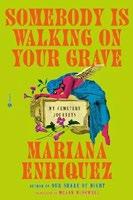
Somebody Is Walking on Your Grave: My Cemetery Journeys
Enriquez, Mariana; trans. by Megan McDowell Hogarth, $30
Amusing travel tales and mini histories collected across the Americas and Europe.
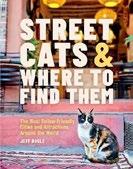
Street Cats & Where To Find Them: The Most Feline-Friendly Cities and Attractions Around the World
Bogle, Jeff Running Press, $24
An irresistible collection of international cats, photographed by a “cat dad.”
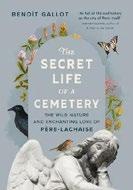
The Secret Life of a Cemetery: The Wild Nature and Enchanting Lore of Père-Lachaise
Gallot, Benoît; illus. by Daniel Casanave, trans. by Arielle Aaronson Greystone Books, $25
A spirited look at Père-Lachaise, as told by its philosophical and funny curator.
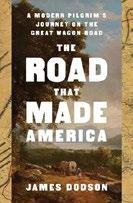
The Road That Made America: A Modern Pilgrim’s Journey on the Great Wagon Road
Dodson, James Avid Reader Press, $32
Armchair travelers will enjoy Dodson’s wanderings.

Gupta, Naina Princeton Architectural Press, $29.99
A ravishing celebration of a watery world.

Macfarlane, Robert Norton, $31.99
Are rivers alive? Macfarlane delivers a lucid argument in the affirmative.
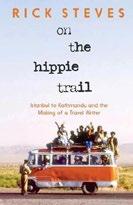
On the Hippie Trail: Istanbul to Kathmandu and the Making of a Travel Writer
Steves, Rick Avalon Travel, $30
Reliving the unpretentious pleasures of the Hippie Trail.
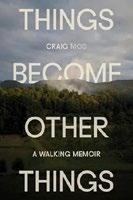
Mod, Craig Random House, $31
Just the thing to read along with Basho and other pilgrims into Japan’s back country.

Italy: In the Footsteps of the Great Artists
Trend, Nick; illus. by Cassandre Montoriol Thames & Hudson, $65
A richly detailed, innovative travel guide.

The Last Sweet Bite: Stories and Recipes of Culinary Heritage Lost and Found
Shaikh, Michael Crown, $30
A revealing inquiry at the intersection of food, culture, war, and power politics.
To learn more and purchase these books, visit Kirkus online.


Six Seasons of Pasta: A New Way With Everyone’s Favorite Food
McFadden, Joshua; with Martha Holmberg Artisan, $40
For restaurant-quality pasta at home, McFadden is your man.

Party People: A Cookbook for Creative Celebrations
Larson, Brie and Courtney McBroom DK, $35
Larson and McBroom help host unforgettable get-togethers.

Russ & Daughters: 100 Years of Appetizing
Federman, Niki Russ and Josh Russ Tupper; with Joshua David Stein; photography by Gentl & Hyers Flatiron Books, $39.99
The last word in smoked fish, babka, and more deliciousness from New York’s Lower East Side.

Family Thai: Bringing the Flavors of Thailand Home
Myint, Arnold and Kat Thompson Abrams, $40
International Market chef Myint offers a warm welcome to Thai home cooking.

Something From Nothing
Roman, Alison Clarkson Potter, $37.99
A new cookbook from Roman is something to celebrate.

Setting a Place for Us: Recipes and Stories of Displacement, Resilience, and Community From Eight Countries Impacted by War
Hassan, Hawa Ten Speed Press, $37.99
A powerful collection of recipes and essays from a James Beard Award winner.
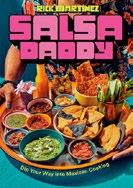
Salsa Daddy: Dip Your Way Into Mexican Cooking
Martínez, Rick Clarkson Potter, $32.99
A zesty offering from the author of Mi Cocina.
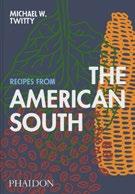
From the American South
Twitty, Michael W. Phaidon, $54.95
An exquisite celebration of Southern cuisine.
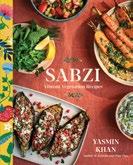
Sabzi: Vibrant Vegetarian Recipes
Khan, Yasmin Norton, $35
Mouthwatering vegetarian and vegan meals from award-winning food writer Khan.

The Italian Summer Kitchen: Timeless Recipes for La Dolce Vita
Whims, Cathy; illus. by Kate Lewis Norton, $28
This beautifully illustrated volume offers authentic Italian delights.
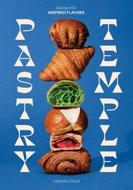
Pastry Temple: Baking With Inspired Flavors
Wood, Christina Sasquatch Books, $24.95
A self-taught baker demystifies brioche, puff pastry, and the classic croissant.
To learn more and purchase these books, visit Kirkus online.

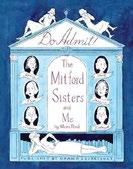
Do Admit!: The Mitford Sisters and Me
Pond, Mimi Drawn & Quarterly, $29.95
Whimsical cartoons reveal passionate lives.
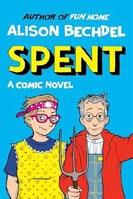
Spent: A Comic Novel
Bechdel, Alison Mariner Books, $29.99
Bechdel is incisive, tender, and funny—often at the same time.

Ginseng Roots: A Memoir
Thompson, Craig Pantheon, $35
A spectacular and inspired graphic memoir that traces the many threads of a remarkable root.

The Novel Life of Jane Austen: A Graphic Biography
Barchas, Janine; illus. by Isabel Greenberg Black Dog & Leventhal, $28
A treat for the international army of Janeites.

Gaysians
Curato, Mike Algonquin, $32
A tender and compelling coming-of-age story.

Tongues: Volume 1
Nilsen, Anders Pantheon, $35
Superb graphic art meets an exceedingly odd tale, and to wonderful ends.
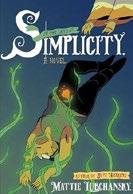
Lubchansky, Mattie Pantheon, $29
Intense, imaginative visuals pair well with the futuristic fight between idealism and oppression.

Weiner, Stephen; illus. by Dan Mazur NBM, $29.99
A heartfelt and absorbing biography of a master cartoonist, fittingly told in arresting images.

Yudori Fantagraphics, $34.99
A rich, engrossing tale that manages to be both concise and expansive.
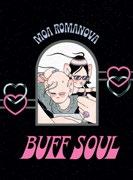
Buff Soul
Romanova, Moa; trans. by Melissa Bowers Fantagraphics, 29.99
A thoughtful story about the dangers of addiction ends with a hopeful possibility of reinvention.

Gauld, Tom Drawn & Quarterly, $21.95
Captnip for science geeks with a funny bone.

Nalamalapu, Denali Sai Timber, $21.99
A poignant portrait of an Appalachian environmental movement.
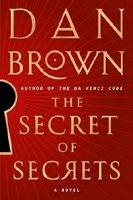
Brown, Dan Doubleday, $38
A standout in the series.
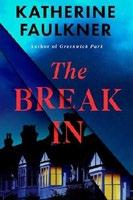
Faulkner, Katherine Scout Press/Simon & Schuster, $28.99
A psychological thriller rife with pretzel-like twists, gaslighting galore, and revenge-fueled machinations.
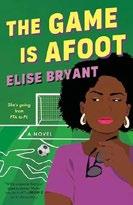
Bryant, Elise Berkley, $19 paper
Madcap suburban intrigue with a soupçon of self-help.
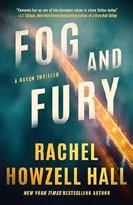
Hall, Rachel Howzell Thomas & Mercer, $28.99
This captivating blend of angst, mystery, and page-turning suspense delivers a top-notch reading experience.

Cosby, S.A. Flatiron, $25.99
Another strong outing by a modern noir master.

Herron, Mick Soho, $39.95
For fans of the TV show, an illustrated edition of the first book in the series, complete with a poster of Slough House.
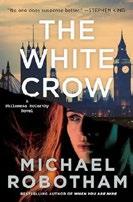
The White Crow Robotham, Michael Scribner, $28.99
End-to-end excitement for crime fans.

Hiaasen, Carl Knopf, $27
The perfect antidote for anyone who doomscrolls daily headlines: more crazed, rollicking, sharply written sendups like this.

The Dark Maestro Slocumb, Brendan Doubleday, $28 A virtuosic thriller.

Jalaluddin, Uzma Harper Perennial/HarperCollins, $17.99 paper
Who could resist “Jack Reacher in a dupatta”?
To learn more and purchase these books, visit

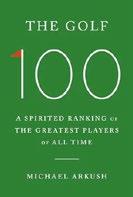
The Golf 100: A Spirited Ranking of the Greatest Players of All Time
Arkush, Michael Doubleday, $30
A fine primer for all those arguments about who was better than who.

The Warrior: Rafael Nadal and His Kingdom of Clay Clarey, Christopher Grand Central Publishing, $32.50
The man who ruled the clay courts gets the royal treatment.
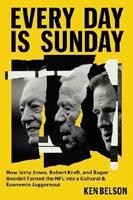
Every Day Is Sunday: How Jerry Jones, Robert Kraft, and Roger Goodell Turned the NFL Into a Cultural & Economic Juggernaut
Belson, Ken Grand Central Publishing, $30
An entertaining account of football’s seemingly unstoppable growth.
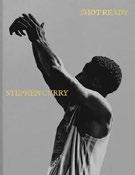
Shot Ready Curry, Stephen One World/Random House, $50
An NBA star’s winning exploration of how we can succeed in life.
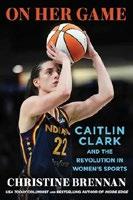
On Her Game: Caitlin Clark and the Revolution in Women’s Sports
Brennan, Christine Scribner, $29.99
An admiring look at a young hoop star’s effect on her game’s popularity.

The Football: The Amazing Mathematics of the World’s Most Watched Object
Ghys, Étienne; trans. by Teresa Lavender Fagan Princeton Univ., $19.95
For fans and nonfans alike, a kick.

Make Me Commissioner: I Know What’s Wrong With Baseball and How To Fix It
Leavy, Jane Grand Central Publishing, $32.50
Irreverent analysis from a baseball writer dismayed by the state of the game.

The Fight of His Life: Joe Louis’s Battle for Freedom During World War II
Smith, Johnny and Randy Roberts Basic Books, $32
A groundbreaking look at a boxing champion’s antidiscrimination efforts.

72 Stories: From the Baseball Collection of Geddy Lee Lee, Geddy Harper, $50
An inviting tour of our national pastime, led by a rocker with an infectious love of the game.
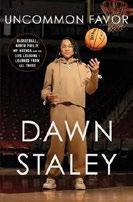
Uncommon Favor: Basketball, North Philly, My Mother, and the Life Lessons I Learned From All Three Staley, Dawn Black Privilege Publishing/Atria, $28.99
Instructive episodes from the rise and reign of a hardwood heroine.

Serrano, Shea; illus. by Ian Klarer Grand Central Publishing, $30
Enthusiastic appraisals of NBA and WNBA stars.

The Running Ground: A Father, a Son, and the Simplest of Sports
Thompson, Nicholas Random House, $30
An exemplary memoir of a life spent on the run.

From Ear to Ear: A Pianist’s Love Affair With Song
Blier, Steven Norton, $29.99
The healing powers of music and singing.

The Harder I Fight the More I Love You: A Memoir
Case, Neko Grand Central Publishing, $30
Sweet-and-sour memories of a songwriter’s early years.

Taylor’s Version: The Poetic and Musical Genius of Taylor Swift
Burt, Stephanie Basic Books, $30
A smart look at the beloved singer-songwriter.

This Year: 365 Songs
Annotated: A Book of Days
Darnielle, John MCD, $36
Far better than a typical lyrics collection.

Tonight in Jungleland: The Making of Born To Run
Carlin, Peter James Doubleday, $30
A sprightly tale of how a masterpiece was made.

Iron Maiden: Infinite Dreams
Harris, Steve; Bruce, Dickinson; Iron Maiden Thames & Hudson, $65
A headbanging romp of a beautifully designed book.

John & Paul: A Love Story in Songs
Leslie, Ian Celadon Books, $32
Fans will love this insightful approach to the band.
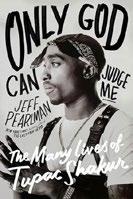
Only God Can Judge Me: The Many Lives of Tupac Shakur
Pearlman, Jeff Mariner Books, $32.50
A thorough accounting of a complex figure.

Song So Wild and Blue: A Life With the Music of Joni Mitchell
Lisicky, Paul HarperOne, $28
A beautiful tribute to a legendary musician and the act of creation.

Hit Girls: Britney, Taylor, Beyoncé, and the Women Who Built Pop’s Shiniest Decade
Princiotti, Nora Ballantine, $29
Fresh perspectives from a writer who’s crazy in love with pop music.
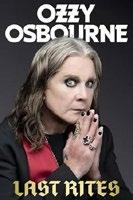
Rites
Osbourne, Ozzy with Chris Ayres Grand Central Publishing, $30
From rock’s Prince of Darkness, a posthumous (and poignant) remembrance.
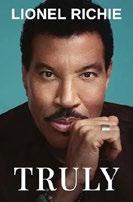
Truly: An Inspirational Journey Through the Life of a Musical Legend
Richie, Lionel HarperOne, $36
A wildly entertaining and utterly charming memoir.
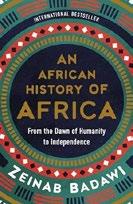
An African History of Africa: From the Dawn of Humanity to Independence
Badawi, Zeinab Mariner Books, $32.50
An elegant and vibrant history that will appeal to novices and experts alike.
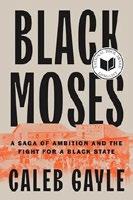
Black Moses: A Saga of Ambition and the Fight for a Black State
Gayle, Caleb Riverhead, $33
A welcome account of Black liberation and a struggle for civil rights.
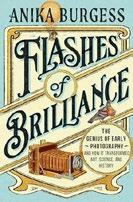
Flashes of Brilliance: The Genius of Early Photography and How It Transformed Art, Science, and History
Burgess, Anika Norton, $35
Scintillating history that’ll have you looking at photography in a new light.

Mexico: A 500-Year History
Gillingham, Paul Atlantic Books, $35
Essential, lively reading for anyone wishing to understand our neighbor to the south.

The Golden Road: How Ancient India Transformed the World
Dalrymple, William Bloomsbury, $32.99
A passionate tribute to the glories—and influence—of ancient India.
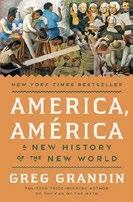
America, América: A New History of the New World
Grandin, Greg Penguin Press, $35
An authoritative history of the debates and brutality that made our world.

The Beast in the Clouds: The Roosevelt Brothers’ Deadly Quest To Find the Mythical Giant Panda
Holt, Nathalia One Signal/Atria, $29.99
Two sons of Theodore Roosevelt on a star-crossed expedition for the ages.
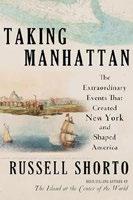
Taking Manhattan: The Extraordinary Events That Created New York and Shaped America
Shorto, Russell Norton, $29.99
How America’s biggest city was born: a bracing narrative.

The Sea Captain’s Wife: A True Story of Mutiny, Love, and Adventure at the Bottom of the World
Mazzeo, Tilar J. St. Martin’s, $30
A rip-roaring, seafaring adventure with a twist.
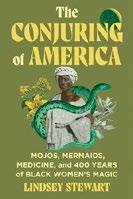
The Conjuring of America: Mojos, Mermaids, Medicine, and 400 Years of Black Women’s Magic
Stewart, Lindsey Legacy Lit/Hachette, $30
An entertaining, informative contribution to Black history.

Shifting Sands: A Human History of the Sahara
Scheele, Judith Basic Books, $32.50
A superb survey of an often-overlooked land.

The American Revolution: An Intimate History
Ward, Geoffrey C. and Ken Burns Knopf, $55.99
History shrouded in myth is made more interesting when laid bare.

Sings the Alphabet
Alexander, Kwame Sleeping Bear Press, $9.99
The Newbery Medalist leads tots on a groovy ABC-themed sing-along.

Chwast, Seymour Creative Company, $11.99
A whimsical and inventive take on the olfactory organ from a master designer.
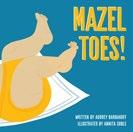
Barbakoff, Audrey; illus. by Annita Soble The Collective Book Studio, $12.95
A culturally rich ode to baby, from the little one’s “shayna punim down to [their] mazel toes.”

Douglas Kati & Ashley Jefferson Abrams Appleseed, $9.99
Happy families are wildly different in this joyfully inclusive series of lavishly photographed portraits.

Boynton, Sandra Boynton Bookworks, $6.99
A chorus line of critters pay tribute to everyone’s favorite fruit. Silliness incarnate.
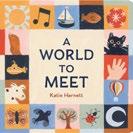
Harnett, Katie Rise x Penguin Workshop, $8.99
Brimming with anticipation for the wonders that await curious youngsters.

Your Farm
Klassen, Jon Candlewick, $8.99
A simultaneously empowering and instructive bedtime tale.
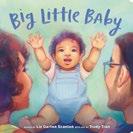
Big Little Baby
Scanlon, Liz Garton; illus. by Trudy Tran Rise x Penguin Workshop, $9.99
Baby contains multitudes as this elegant tale makes abundantly clear.
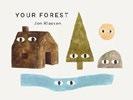
Your Forest
Klassen, Jon Candlewick, $8.99
Pure, unmitigated sleepy-time pleasure.

Walk With Me: A Counting Adventure
Uslan, Nancy E. Farrar, Straus and Giroux, $9.99
A hip, bouncy romp that invites youngsters to count everything from slithering snakes to buzzy bees.

Your Island
Klassen, Jon Candlewick, $8.99
For children yearning for an island of their own, deadpan delights await in this tale of somnolent creation.

The Pigeon Won’t Count to 10!
Willems, Mo Union Square Kids $9.99
Everyone’s favorite recalcitrant pigeon is back and funnier than ever! You can count on it.

Awan, Jashar
Simon & Schuster, $19.99
Captures the excitement of anticipation, the thrill of yearning realized, and truck love among the young.
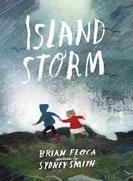
Floca, Brian; illus. by Sydney Smith Neal Porter/Holiday House, $18.99
The power of nature captivates and compels in this phenomenal tale of pushing limits.

Clanton, Ben, Corey R. Tabor & Andy Chou Musser Viking, $19.99
Move aside, Very Hungry Caterpillar. Meet the new queen of metamorphosis storytime splendor.

Harris, Shawn Neal Porter/Holiday House, $18.99
Let’s be readers and explore this book together—again and again.
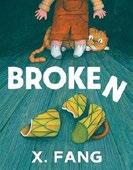
Broken
Fang, X. Tundra Books, $18.99
A common childhood experience, conveyed with an uncommon mix of sensitivity, mirth, and heart.

Kinkz, Eliza Kokila, $18.99
A deliciously effervescent celebration of family and resilience.

Lam, Thao Groundwood, $19.99
A unique, joyful celebration of bellies, bodies, and beauty.
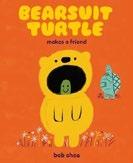
Shea, Bob Abrams, $19.99
An amiable romp, funny to look at and fun to read.

Cat Nap
Lies, Brian Greenwillow Books, $19.99
Utterly beautiful, playfully fun, and, above all, breathtaking.
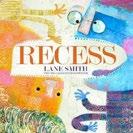
Smith, Lane Abrams, $19.99
Wilder than any rumpus, this recess isn’t just a break—it’s silliness incarnate!
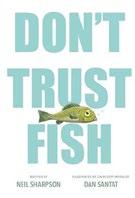
Sharpson, Neil; illus. by Dan Santat Dial Books, $18.99
A ribald and uproarious warning to those unschooled in fishy goings-on.
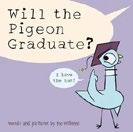
Willems, Mo Union Square Kids, $18.99
An earnest graduation gift: sweet for lifelong fans, cheerfully encouraging for striving, future graduates.

The Incredibly Human Henson Blayze
Barnes, Derrick Viking, $17.99
Bold, extraordinary storytelling: not to be missed.
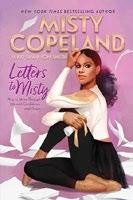
Copeland, Misty with Nikki Shannon Smith Aladdin, $19.99
Affirming life lessons to encourage athletes, creatives, and everyday dreamers.

Omnibird: An Investigator’s Handbook
Clarkson, Giselle Gecko Press, $24.99
A truly stellar work that will delight bird enthusiasts while converting the ambivalent into eager avian investigators.

Fitzharris, Lindsey & Adrian Teal; illus. by Lindsey Fitzharris Bloomsbury, $19.99
Macabre, madcap, and surprisingly wholesome in its positivity.
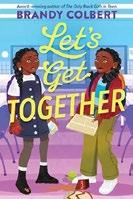
Colbert, Brandy Clarion/HarperCollins, $19.99
A compassionate, emotionally intelligent story about family and belonging that will resonate widely.
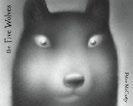
The Five Wolves
McCarty, Peter First Second, $29.99
Striking and provocative.
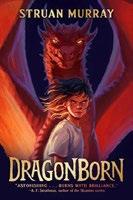
Murray, Struan Dutton, $19.99
Come for the dragons but stay for the suspenseful reveals and relatable characters.

Amina Banana and the Formula for Friendship
Safadi, Shifa Saltagi; illus. by Aaliya Jaleel Bloomsbury, $16.99
A winning series starter with layers of depth.

Yasmin Bandara Levels Up!
Ranganathan, Romesh & Susie Day; illus. by James Lancett Puffin/Penguin Random House UK, $15.99
Online gaming, family expectations, friendship, and honesty, explored with balance, humor, and insight.
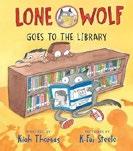
Lone Wolf Goes to the Library
Thomas, Kiah; illus. by K-Fai Steele Neal Porter/Holiday House, $16.99
Another can’t-miss outing with an irresistible, introverted antihero.
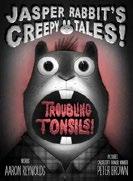
Reynolds, Aaron; illus. by Peter Brown Simon & Schuster, $13.99
Extraordinary introductory terror, beautiful to the eye and sure to delight younger horror enthusiasts.
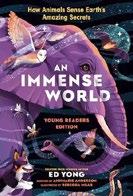
An Immense World (Young Readers Edition): How Animals Sense Earth’s Amazing Secrets
Yong, Ed; adapt. by AnnMarie Anderson; illus. by Rebecca Mills Bright Matter Books, $24.99
An insightful and informative look at the animal kingdom with high appeal for lovers of nature and science.

Poetry Prescription: First Aid
Ed. by Alma, Deborah Macmillan Children’s Books, $12.99
This warm, comforting poetry collection is just what the doctor ordered.
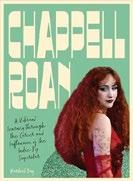
Chappell Roan: A Vibrant Journey Through the Career and Influence of the Indie-Pop Superstar
Day, Harbert Epic Ink/Quarto, $19.99
An empowering, unapologetic portrait of creative risk and queer joy.

Butterfly Heart
Åstot, Moa Backe; trans. by Agnes Broomé Em Querido, $19.99
Limns the volatile peaks and valleys and emotional quicksand of adolescence with compassion and wry humor.

Death in the Jungle: Murder, Betrayal, and the Lost Dream of Jonestown
Fleming, Candace Anne Schwartz/Random, $19.99
Extraordinary and illuminating.
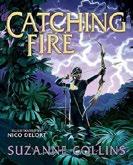
Catching Fire: Illustrated Edition
Collins, Suzanne; illus. by Nico Delort Scholastic, $36.99
This book is lit!

Hekate: The Witch
Gill, Nikita Little, Brown, $19.99
Fiercely feminist, this reimagining of a lesser-known goddess crackles with magic.
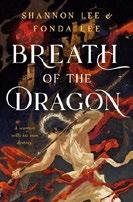
Lee, Shannon & Fonda Lee
Wednesday Books, $21
A complex, hard-hitting, epic martial arts journey.

Tiffany Aching’s Guide to Being a Witch
Pratchett Rhianna & Gabrielle Kent; illus. by Paul Kidby Harper/HarperCollins, $21.99
A charming and comforting return to the world of Terry Pratchett’s witches that will delight completists.

Maldonado, Crystal Holiday House, $19.99
Fill up the tank because this one is taking you for a sweet ride.

Sambury, Liselle McElderry, $24.99
A bold and bloody series opener.
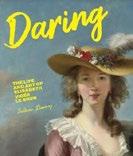
The
and Art of Elisabeth Vigée Le Brun
Pomeroy, Jordana Getty Publications, $21.95
Beautifully executed; a visual and narrative treat.

Thao, Dustin Dutton, $19.99
An aching story of love, loss, and learning to look forward.

Jazzy the Witch in Broom Doom
Bagley, Jessixa
Simon & Schuster, $14.99
A comical, witchy, and sweetly affirming read.
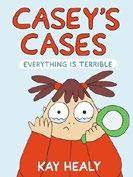
Casey’s Cases: The Mysterious New Girl
Healy, Kay Neal Porter/Holiday House, $16.99
The mysteries are fun, but the highlight is the friends we’ll make along the way.

Cabin Head and Tree Head
Campbell, Scott Tundra Books, $13.99
A wildly original tale with the buddy-based charm of Frog and Toad but imbued with a wacky energy all its own.

I’m a Dumbo Octopus!: A Graphic Guide to Cephalopods
Lambelet, Anne Graphic Universe, $12.99
An informative, buoyant, and wildly original look at some marine marvels.

The Nefarious Nights of Willowweep Manor
Garrity, Shaenon K.; illus. by Christopher Baldwin McElderry, $24.99
Thoroughly clever and delightfully weird.

Mafalda: Book One
Quino; trans. by Frank Wynne Elsewhere Editions, $18
A historical comic strip with ongoing relevance and plenty to laugh about.

Night Chef: An Epic Tale of Friendship With a Side of Deliciousness!
Song, Mika Random House Graphic, $20.99
A deeply satisfying adventure for readers young and old.

Empire
Terry, Laura Graphix/Scholastic, $24.99
Engagingly original, featuring a likable protagonist and plenty of humor and tenderness.
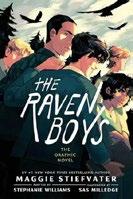
Raven Boys: The Graphic Novel
Stiefvater, Maggie; adapt. by Stephanie Williams; illus. by Sas Milledge Viking, $24.99
A treat for series fans and new readers alike.
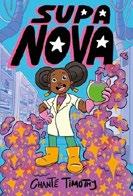
Supa Nova
Timothy, Chanté Nosy Crow, $9.99
Just the ticket for unstoppable young mixers and makers with big dreams.

Tadiar, Tori; colors by Diana Sousa Disney-Hyperion, $24.99
A bright beginning to a new graphic fantasy series.
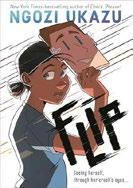
Flip
Ukazu, Ngozi First Second, $25.99
Flipping awesome.
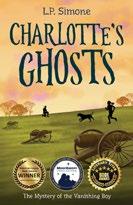
Charlotte’s Ghosts Simone, L.P.
A middle-grade cross-genre standout.
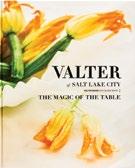
Valter of Salt Lake City : The Magic of the Table Nassi, Valter with Elaine Bapis
This joyous celebration of food and life mixes a captivating story with gorgeous photos.
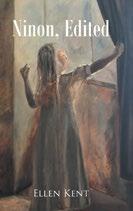
Ninon, Edited Kent, Ellen
A sometimes-overwritten but realistic and often touching story of intricate family relationships.
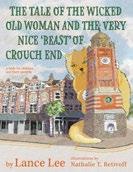
The Tale of the Wicked Old Woman and the Very Nice ‘Beast’ of Crouch End Lee, Lance; illus. by Nathalie T. Retivoff
A gorgeously unusual, emotionally redeeming parable with plenty of heart and just the right touch of magic.

The Search for Shalom Dickerson, Will
A well-researched, distinctly Christian guidebook for finding peace in an era of violence and anxiety.

Beyond Australia
Forrest, Lee
A richly drawn and always-entertaining time-travel novel for younger readers.

Johnston, Christopher
A measured generational family saga about the passing of a way of life.
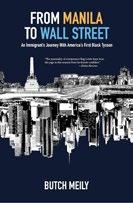
Meily, Butch
The personality of entrepreneur Reg Lewis leaps from the page in this memoir from his former confidant.
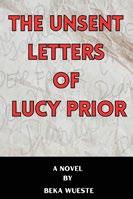
Wueste, Beka
A deeply introspective and emotionally resonant novel.

An engaging novel that hooks readers in with a fast-paced story of forbidden love.
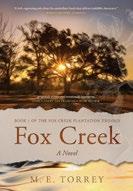
A rich, engrossing tale about the antebellum South that delivers indelible characters.
To learn more and purchase these books, visit
online.


Unpacking the Attic
Mracek, Ann M.
A heartfelt remembrance that presents a tender reckoning with the past.

Go Pick Peas: A Childhood Out of Touch
Verbout, Melanie
A thoughtful and affecting remembrance of a challenging upbringing.
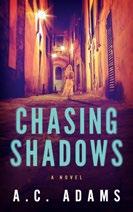
Chasing Shadows
Adams, A.C.
Secrets and lies collide in this sinisterly effective thriller.

The Lost Coast Robinson, Daniel
A fiery tale of vengeance that keeps the tension high.

Rapid Rogers, Randall
A dark, invitingly whimsical tale that grows more mysterious as the pages go by.
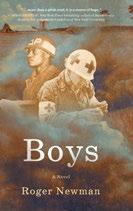
Boys Newman, Roger
A powerful and nuanced novel about racial tensions in 20th-century America.

Winter Tenney, Rhya
A delightfully weird and surprising tale of the paranormal.
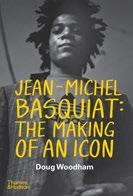
Woodham, Doug
An insider’s look at an artist’s world.
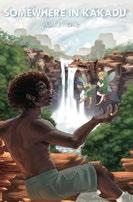
Somewhere in Kakadu Ritchie, Cat
A leisurely children’s fantasy with an ecological message.

Kirkus Star
Yours for the Season Jalaluddin, Uzma
An interculturual holiday rom-com that fully nails the promise of its premise.

Maor’s Christmas Tale
Clarke, Mark A.; illus. by Melissa Kenny
A captivating retelling of the Nativity for kids.
To learn more and purchase these books, visit Kirkus online.

A heartfelt picture book that celebrates art and connection through an unlikely friendship, from award-winning creator Eric Velasquez.
The perfect gift to share with loved ones this holiday season!
Named to Kirkus Reviews’ Best Books of 2025
“Lushly rendered.”
—Publishers Weekly
“A fantastical testament to the joy of seeing yourself in the art you seek out.”
—Kirkus Reviews
“This extraordinary wordless book features expressive illustrations that depict a unique friendship.”
—School Library Journal

Also Available in Spanish as Elosopolarylabailarina

Explore Now! The Polar Bear and the Ballerina


FEATURING 276 Industry-First Reviews of Fiction, Nonfiction, Children’s, and YA Books


Plus author interviews, genre lists, and the full complement of new reviews OUR TOP 300 YOUNG READERS’ TITLES OF THE YEAR

ISBN: XXX-X-XX-XXXXXX-X

Daniel Nayeri
MiddleGrade Nonfiction
Sonja Cherry-Paul
Kate McKinnon
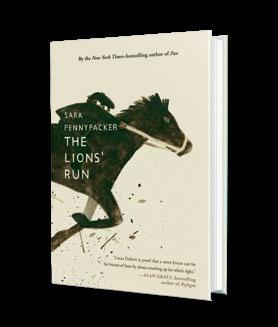
Nathanael Lessore
Huda



FROM THE EDITOR’S DESK
THERE IS NO guaranteed path for a book’s success, and the paths that do exist are often meandering. Take the case of Lucas Schaefer’s The Slip, which won the Kirkus Prize for Fiction this fall. As a debut literary novel, released as readers were turning their attention to summer fare, it faced steep odds, and it’s always difficult for an unknown author to break through in the crowded publishing marketplace.
A positive Kirkus review, which typically lands about two months before a book’s publication, can certainly help. The Slip received a coveted Kirkus star, with our reviewer enthusing, “Franzen/Roth/ Irving comparisons earned and deserved.” The Slip was off to a good start, and an ecstatic rave from
Washington Post critic Ron Charles—“I spent most of the week not just reading this story but cheering it on in a state of unhinged excitement”—cued it up for a big splash.
But oh, the fickle business of book publishing! Admiring reviews were forthcoming from the Wall Street Journal and the Village Voice , but where was the New York Times ? Neither Oprah nor Reese nor Jenna—queens of the book club scene— came calling. This novel of wildly outsize ambitions was enjoying a respectable but decidedly modest launch.
Still, The Slip was among the hundreds of books to be considered by the fiction jurors for this year’s Kirkus Prize. Like our reviewer
Frequently Asked Questions: www.kirkusreviews.com/about/faq
Fully Booked Podcast: www.kirkusreviews.com/podcast/
Advertising Opportunities: www.kirkusreviews.com/book-marketing
Submission Guidelines: www.kirkusreviews.com/about/publisher-submission-guidelines
Subscriptions: www.kirkusreviews.com/magazine/subscription
Newsletters: www.kirkusreviews.com
For customer service or subscription questions, please call 1-800-316-9361
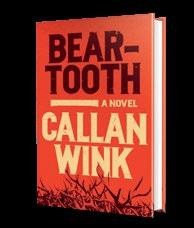
and Charles, they fell in love. So did Kirkus’ editors. The novel was named a finalist in August, and at the ceremony in New York on October 8, it took the $50,000 prize. “To be a debut novelist means to constantly try against the odds to be part of the literary conversation,” Schaefer told the audience. It was gratifying to see a truly deserving book beat those odds.
As the year draws to a close, I like to look back on the titles we loved that didn’t always get the buzz they deserved. Here are three of my top candidates:
Beartooth by Callan Wink (Spiegel & Grau, February 11): This Western-flavored heist novel features two discordant brothers living off the grid who are roped into a bizarre plot to smuggle a large cache of valuable elk antlers out of Yellowstone National Park, part of the way on a river raft. What could possibly go wrong? Wink wraps his deft character study in an intensely suspenseful narrative.

Misbehaving at the Crossroads: Essays & Writings by Honorée Fanonne Jeffers (Harper, June 24): Jeffers’ first novel, The Love Songs of W.E.B. Du Bois , was anointed by Oprah’s Book Club. This less-accoladed work of nonfiction, like any collection, is uneven, but the author’s essays about her rural Georgia family and a diary of caring for her elderly mother are as moving as they come. I hope we’ll get a memoir from this gracious and graceful writer.
Endling by Maria Reva (Doubleday, June 3): This debut novel by a Ukrainian Canadian writer begins as an unruly satire of the romance tours that draw international bachelors to Ukraine—seen partially through the eyes of a scientist determined to save a rare breed of snail—and explodes into metafiction with the Russian invasion of 2022. It’s sui generis.

Co-Chairman
HERBERT SIMON
Interim Publisher & CEO
JUDY HOTTENSEN jhottensen@kirkus.com
Chief Marketing Officer
SARAH KALINA skalina@kirkus.com
Publisher Advertising & Promotions
RACHEL WEASE rwease@kirkus.com
Indie Advertising & Promotions
AMY BAIRD abaird@kirkus.com
Author Consultant
KEELIN FERDINANDSEN kferdinandsen@kirkus.com
Lead Designer KY NOVAK knovak@kirkus.com
Magazine Compositor
NIKKI RICHARDSON nrichardson@kirkus.com
Director of Kirkus Editorial ROBIN O’DELL rodell@kirkus.com
Kirkus Editorial Senior Production Editor
MARINNA CASTILLEJA mcastilleja@kirkus.com
Kirkus Editorial Production Editor
ASHLEY LITTLE alittle@kirkus.com
Copy Editors
ELIZABETH J. ASBORNO ALYSSA CHOINIERE
JOE HONG
NANCY MANDEL
BILL SIEVER
Mysteries Editor THOMAS LEITCH
Co-Chairman
MARC WINKELMAN
Editor-in-Chief TOM BEER tbeer@kirkus.com
President of Kirkus Indie
CHAYA SCHECHNER cschechner@kirkus.com
Fiction Editor
LAURIE MUCHNICK lmuchnick@kirkus.com
Nonfiction Editor JOHN McMURTRIE jmcmurtrie@kirkus.com
Young Readers’ Editor
LAURA SIMEON lsimeon@kirkus.com
Young Readers’ Editor
MAHNAZ DAR mdar@kirkus.com
Editor at Large MEGAN LABRISE mlabrise@kirkus.com
Senior Indie Editor DAVID RAPP drapp@kirkus.com
Indie Editor ARTHUR SMITH asmith@kirkus.com
Senior Editorial Assistant
NINA PALATTELLA npalattella@kirkus.com
Senior Indie Editorial Assistant
DAN NOLAN dnolan@kirkus.com
Indie Editorial Assistant
KATARINA YERGER kyerger@kirkus.com
Contributing Writers
GREGORY McNAMEE
MICHAEL SCHAUB

Contributors
Colleen Abel, Erin Addis, Paul Allen, Stephanie Anderson, Mark Athitakis, Kit Ballenger, Colette Bancroft, Audrey Barbakoff, Nell Beram, Elizabeth Bird, Kimberly Brubaker Bradley, Melissa Brinn, Jessica Hoptay Brown, David Bushman, Ana Cackley, Kevin Canfield, Timothy Capehart, Charles Cassady, Ann Childs, Jeannie Coutant, Katherine Daly, Kim Dare, Michael Deagler, Cathy DeCampli, Dave DeChristopher, Elise DeGuiseppi, Steve Donoghue, Anna Drake, Jacob Edwards, Gina Elbert, Lisa Elliott, Ilana Bensussen Epstein, Joshua Farrington, Brooke Faulkner, Eiyana Favers, Margherita Ferrante, Renee Fountain, Mia Franz, Harvey Freedenberg, Jenna Friebel, Robbin Friedman, Laurel Gardner, Jean Gazis, Emily A. Gordon, Vicky Gudelot, Ellie Halleron, Sean Hammer, Aaron Hicklin, Loren Hinton, Ashley Holloway, Natalia Holtzman, Terry Hong, Kathleen T. Isaacs, Darlene Ivy, Wesley Jacques, Kevin Jagernauth, Jessica Jernigan, Jennifer Johnson, Betsy Judkins, Maya Kassutto, Lyneea Kmail, Maggie Knapp, John Kynch, Carly Lane, Laurel Larrew, Christopher Lassen, Tom Lavoie, Judith Leitch, Seth Lerer, Coeur de Lion, Barbara London, Patricia Lothrop, Sawyer Lovett, Wendy Lukehart, Michael Magras, Mandy Malone, Thomas Maluck, Gabriela Martins, J. Alejandro Mazariegos, Breanna McDaniel, Courtney McDermott, Cari Meister, Kathie Meizner, J. Elizabeth Mills, Sabrina Montenigro, Clayton Moore, Andrea Moran, Rhett Morgan, Liza Nelson, Therese Purcell Nielsen, Ari Nussbaum, Tori Ann Ogawa, Connie Ogle, Ife Olatona, Mike Oppenheim, Emilia Packard, Andrea Page, George Pate, Hal Patnott, Bethanne Patrick, Deb Paulson, Tara Peck, Rebecca Perry, John Edward Peters, Jim Piechota, Christofer Pierson, Vicki Pietrus, Shira Pilarski, Cathy Poland, Margaret Quamme, Carolyn Quimby, Kristy Raffensberger, Isabella Ranallo, Kristen Bonardi Rapp, Darryn Reams, Stephanie Reents, Amy Robinson, Soumi Roy, Gia Ruiz, Lloyd Sachs, Bob Sanchez, Caitlin Savage, Gene Seymour, Jerome Shea, Sadaf Siddique, Linda Simon, Wendy Smith, Margot E. Spangenberg, Allison Staley, Sydney Stensland, Allie Stevens, Jennifer Sweeney, Deborah Taylor, Desiree Thomas, Renee Ting, Caroline Ward, Katie Weeks, Vanessa Willoughby, Kerry Winfrey, Marion Winik, Jean-Louise Zancanella
Your patrons don’t want to wait – and neither do you.
IngramExpress® ensures you get the books you need when you need them.
IngramExpress Benefits
In-Stock inventory
Fast, free shipping
Order from any distribution center
No order or shipment minimums
Competitive discounts
Discover IngramExpress at ingramcontent.com/express

Sign up Today: Save up to 40% on books over $16.99 through January 31, 2026.


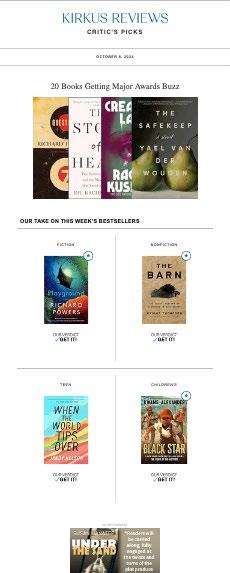
The literati gathered in lower Manhattan on October 8 to attend the 12th annual awards ceremony.




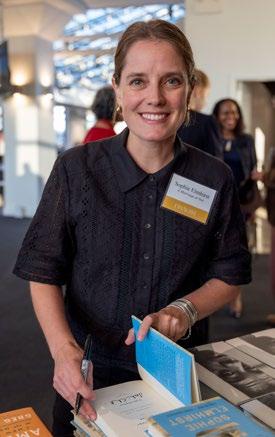






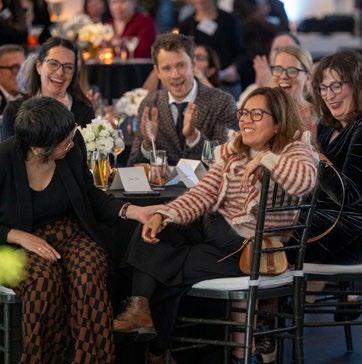



AS THE END of the year approaches, everyone’s busy looking back, thinking about best books lists and gift guides, but there are still plenty of exciting new books coming out. Here are some December novels you won’t want to miss.
Casanova 20: Or, Hot World by Davey Davis (Catapult, December 2): An unusual post-pandemic novel that focuses on art, love, and mortality. Adrian is a Casanova figure, a man so beautiful he’s always been desired by everyone he meets—until the Covid-19 vaccine becomes available and he takes his mask off. Suddenly, mysteriously, his appeal is gone. Meanwhile, his best
friend, Mark, a painter, learns that he’s dying of the disease that killed his mother and sister. Our starred review calls this “a rare gem of a book—afraid of neither joy nor sorrow and patient enough to find the human heart inside all its gorgeous language.”
House of Day, House of Night by Olga Tokarczuk, translated by Antonia Lloyd-Jones (Riverhead, December 2): The Nobel Prize winner follows up The Books of Jacob, about an 18th-century messiah figure, and The Empusium , about a tuberculosis sanitorium, with a novel set in small Polish village that our starred review says “seems to contain the


entire world within it.” The narrator—a woman who may resemble the author herself—has just moved to the village, and stories about the place accrue, encompassing both past and present. “As a whole, the book is at once simpler and, at the same time, infinitely more complex than it at first appears,” writes our critic. “An exquisitely constructed, mercurial gem.”
The Living and the Dead by Christoffer Carlsson; translated by Rachel Willson-Broyles (Hogarth, December 2): If you’re a fan of Scandinavian crime fiction, Carlsson is an author to know; this is his third book to be published in the U.S., and our starred review calls it “brooding and brilliant.” In 1999, two teenagers are found dead after a party in a southwestern Swedish town, and
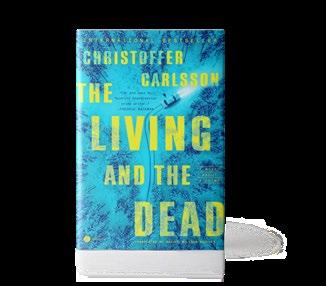

the crime is never solved. Twenty years later, a similar crime sets off further detonations in the community. This novel “goes beyond clever plotting to examine Swedish identity, life in a new era, and the ties between living and dying,” according to our review.
The Rest of Our Lives by Ben Markovits (Summit/ Simon & Schuster, December 30): Markovits was born in Texas and now lives in London, but he isn’t as well known here as in the U.K., where this novel was shortlisted for the Booker Prize. Tom Layward made a deal with himself 12 years ago when he discovered that his wife was having an affair: He’d stay with her till their kids went to college. Now, as they’re about to take their younger child to start her freshman year, he and his wife have a fight, and she stays home. Tom remembers his vow, drops his daughter off at school, and just keeps driving. Markovits makes Tom a complex character, and “this controlled, quietly moving portrait of a life in decline coasts to a halt in an unexpected place,” according to our starred review.
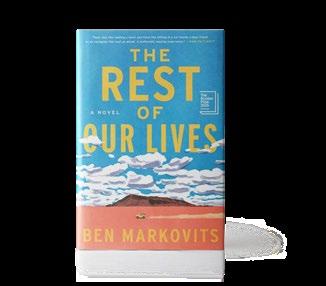
Laurie Muchnick is the fiction editor.
A disquieting and savage era of not-so-benign neglect of at-risk Black New Yorkers during the Reagan years is evoked with poignant warmth and unflinching precision. It’s the middle of the Morning-in-America 1980s and the era’s go-go financial opulence is an unfounded rumor in East Harlem, where the crack epidemic has taken hold along with its attendant crime wave and debilitating malaise. One very early morning in October 1985, Matilda “Twin” Johnson, a lifelong El Barrio resident and self-styled “roaming soul” who is “almost six feet tall… [and] a kiss away from three hundred pounds,” comes across the body of 12-year-old Tyrone Jackson in a pile of garbage. Going against her initial instincts and the
stringent demands of her drug-dealing Uncle Manuel, Twin notifies the police. Tyrone’s mother, Anita, a military widow and postal worker, is devastated and determined to solve his murder with help from her “crazy” friend Wanda, whose own son Daryl is more prone to trouble with the NYPD than Tyrone. The women are aided by their earnest, ambitious neighborhood pastor, the Rev. Carl Harpon, whose church has been burned down in a suspicious fire. (Daryl is a prime suspect.) Reynolds—author of Knee-Deep in Wonder (2003)— deftly weaves in the lives of other local residents, including the mothers who, like Anita and Wanda, no longer have a church to go to but maintain their solidarity
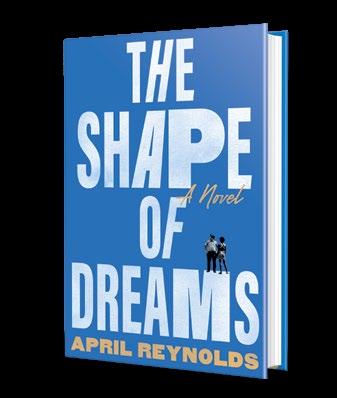
Reynolds, April | Knopf | 304 pp. | $29 February 3, 2026 | 9780593316863
by getting the neighborhood involved in finding out who killed Tyrone, whose own final days are recounted in flashbacks. As the months pass, Anita and Wanda are pulled deeper into despair by false leads, dead ends, and the toxic allure of crack itself, even while their neighbors continue to help search for Tyrone’s
killer. Reading this engrossing novel is like watching East Harlem morph into the shape of a shabby but tenacious dreamer imprisoned in a time and place where dreams can be snuffed out as haphazardly as the lives of its young. A crafty murder mystery in the multihued form of an urban symphony.
an earthy
who’s riveting to know.
DREAMING OF DEAD PEOPLE
Kirkus Star
Belben, Rosalind | And Other Stories (144 pp.) $19.95 paper | August 5, 2025 | 9781916751316

A reissued novel from a wildly original writer explodes the form with a sensual exposé of midlife. Lavinia is 36, restless and judgmental in London or Venice but truly herself in woods and fields with the animals she loves. She is somewhat feral, in fact, and that is one of the charms of this spellbinding novel, first published in 1979. While modern life has changed radically since then, perhaps especially for women, Belben is still walloping readers with visceral vignettes. The novel arranges facets of Lavinia’s life and mind through six thematic sections: on sex and celibacy, Robin Hood (yes, from the 14th century), childhood, travel, loneliness (“In every patch a papa, a mama, and their heart-shaped-faced children, a family circle, complete, into which I intrude….I am a moth”), and the end of life for various creatures, including a beloved dog. Belben sketches scenes with a calligraphy brush and quick washes of color. Her renegade heroine recalls a solo traveler from Jean Rhys or Renata Adler, guzzling the world in elegant decrepitude. An imaginary daughter named Jessie sometimes accompanies her. Her parents haunt her, too, but the lost people she dwells on include versions of herself. Every creature and object is charged and embodied: “The dwellings had their eyelids down.” She sees herself in everything and everyone, living in layers of history and
literature. Accordingly, Belben’s language is exciting, mined from biblical and Shakespearean cadences: “I am aware of isolated parts of my body which have no feeling; they feel and feel not; such as the hair on my skin.” She is unafraid of gore and puns. As singular as Belben is, she shares a juicy terrain with lusty intellects (Harold Brodkey, Jeannette Winterson); tender, rooted poets (D.H. Lawrence, Dylan Thomas); rhapsodic magpies (Gertrude Stein, James Joyce); fantastical artists (Hieronymus Bosch); and playfully morbid filmmakers (Yorgos Lanthimos, Daina Oniunas-Pusić). Belben collages a primal, dreamlike landscape that is a thrilling privilege to visit. This is social history, too, a takedown of the “old maid” as cautionary tale. It is remarkable how much younger 36 seems now than in Belben’s telling, and what Lavinia calls “the glow of celibacy” is all the rage. Readers who delight in women’s radical fantasies will also be rewarded by the wicked visions from a time when finding erotic freedom with a self-celebrated female body was revolutionary. The novel fires on all senses with an earthy, frank heroine who’s riveting to know and impossible to forget.
Boland, Kathleen | Viking (304 pp.) | $29 January 13, 2026 | 9780593834480
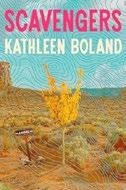
A mother and daughter rekindle their relationship as they search for buried treasure. Bea Macon makes a living foreseeing disasters. Her job as a commodities analyst in New York demands that
she predict and profit from floods, hurricanes, and droughts, all of whose seemingly imaginary consequences occur far from the desk she rarely leaves. When Bea prophesies a storm that never arrives, she’s visited instead by a slew of personal disasters: HR, the feds, termination, blacklisting. Alone and unemployed, Bea buys a one-way ticket to her last resort—her mother. Although Bea approved the house in Salt Lake City and pays its rent, it’s her first visit, and the first time the two have lived together since Bea was 13 years old. Bea and her mother, Christy, stiffly get in and out of each other’s way in the manner of those lacking true intimacy. Both women tread society’s surfaces, bereft of any substantive ties to anchor them, including with one another. Living in proximity seems only to reveal that they are strangers. Christy is a character, not a caretaker. When B ea was 13, Christy followed her husband to Canada in pursuit of divorce papers, only to end up living with him, his new girlfriend, and their son for the following years while Bea traversed middle and high school without her. Bea finds her mother’s resourcefulness embarrassing, her optimism foolish. Chief among Christy’s totems of naïve optimism is her map: She’s an avid member of an online forum called the Conversation, whose devotees plumb the wilderness in search of an alleged treasure hidden by a recluse dubbed the Poet. When the mother-daughter duo is evicted, Bea decides to tag along on Christy’s trip to a town called Mercy and accompany (and heckle) her mother on the next leg of her journey. Bea and Christy’s adventure is marked by shady characters, dizzying desert heat, and the kind of disasters Bea can neither predict nor prevent. This depiction of a mother-daughter relationship is agonizingly apt, proof that mothers can, at times, bring out the best in their children; they do bring out the worst. A slow-to-start book eventually results in rich, vivid characters. Gasps of gorgeous prose are weighed down by occasionally plodding plot points.
Like panning for gold; there are moments that gleam with brilliance.
Burke, James Lee | Atlantic Crime (400 pp.) $28 | February 10, 2026 | 9780802166609
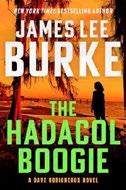
New Iberia
Detective Dave Robicheaux, who’s been kept mostly on the sidelines for the past five years, makes a welcome return in a starring role in this turn-of-the-20th-century tussle. Dave arises from sleep to see a bunch of kids set off a bottle rocket into his backyard. The rocket lights a fire he promptly puts out, but the kids, who mean no harm, turn out to be witnesses who saw a tall stranger in a black raincoat drag a big plastic bag into his yard. The bag turns out to contain the remains of a young woman who’s been stripped, drugged, and murdered. Who killed her, who dumped her in Dave’s yard, and who is she? Dave and his new partner, Det. Valerie Benoit, hunker down to answer all three of these questions. The victim turns out to be Clemmy Benoit, an obvious relative about whom Val has little to say and a friend of Dave’s adopted daughter, Alafair, a novelist who’s come for an extended visit.
The suspects include Lloyd D’Anjou, a redneck colleague who’s bent on harassing Val; Jerry Carlucci, the skeevy owner of a saloon, a café, and a brothel; and Sidney Ludlow, a mobster seeking to open a casino on land he means to acquire one way or another. Since this is New Iberia, they’re all guilty of something. So are Dave and his old pal Clete Purcel, a private detective who’s fallen off the wagon; both of them periodically surrender to their righteous rage. When Alafair is kidnapped, the sense of danger is intensified for fans who remember that her father has already outlived three wives.
The hero’s goal—“I’ve got to find a way of seeing things the way they really are”—has rarely been more resonant.
Clarke, Lucy | Atlantic Crime (400 pp.) | $18 paper | January 6, 2026 | 9780802167170

A plane crash comes to define the lives and memories of two sisters.
Two years after her sister Lori’s plane crashed somewhere in the Pacific Ocean and was never found, Erin learns that the pilot is still alive. She travels to Fiji to see if she can learn more about what happened to the ill-fated flight, sure there must have been other survivors— and riddled with guilt because she was also supposed to be on the plane, but she and Lori had a blow-out fight the night before the flight and she never showed up at the airport. It was supposed to be a sister’s bonding trip, paid for with the joint checking account Lori still shared with her cheating ex. But instead, it becomes the defining tragedy in Erin’s life because even after the deaths of their parents they had each other, while “losing Lori was like…like someone had just reached up and plucked the sun right out of the sky.” The novel unspools like a split screen, with chapters alternating between Erin’s first-person narrative in the present as she interrogates the pilot about what he knows, and Lori’s third-person perspective from the day of the plane crash forward. In this way Clarke builds the suspense, the narrative, and the emotional resonance brick by brick, creating a slow burn until the past and present finally collide. She also creates two very human, emotionally empathetic women to anchor her thriller. There are some twists, most notably a smart ending, that provide even more complexity in the lives of the two sisters. Clarke explores the power of familial ties— between siblings, between mothers and children, between fathers and sons— against the backdrop of a Lost-worthy plane-crash-on-a-desert-island scenario. Resonates with the real-world impact of grief and trauma.
Coben, Harlan & Reese Witherspoon Grand Central Publishing (352 pp.) | $32 October 14, 2025 | 9781538774700

A widowed and disgraced plastic surgeon is drawn into a Russian oligarch’s evil schemes.
Witherspoon’s adult fiction debut, co-authored with thrillermeister Coben, opens as heart surgery performed by Dr. Marc Adams in a North African refugee camp is interrupted by the explosive invasion of armed militants. It’s the last we will see of Marc in this dimension. The next chapter jumps ahead one year to a ceremony at Johns Hopkins University in Baltimore where his widow, Maggie McCabe, is supposed to be presenting an award in honor of her mother. Miserable and anxious about appearing in public after having lost her medical license, she consults with her late husband on her phone—not via supernatural means, but using a “griefbot,” an amazingly lifelike and functional AI app created by her genius sister, Sharon. Once the griefbot coaxes her to brave the sneering masses, she learns she’s been replaced on the podium anyway. But she runs into a former professor, a celebrity plastic surgeon, who requests a meeting with her at his office in New York and won’t take no for an answer. Next thing she knows, there’s $10 million in her bank account and she’s on a private plane heading to a palace outside Moscow where she’s been engaged to perform off-the-record surgery on billionaire Oleg Ragoravich (new face) and his girlfriend, Nadia (new boobs). And…we’re off. A whirl of surgeries, chases, and escapes ensues as Maggie gradually comes to understand who these people are and what they have in mind for her, and how it connects to Marc and their missing friend and business partner, Trace Packer. She is aided by her delightful father-in-law, Porkchop, owner of a biker bar in New York City and a very handy guy to have on your team if you’ve run afoul of an
international criminal organization. From the palace in Rublevka the action moves to Dubai and then Bordeaux, climaxing in a high-stakes illegal heart transplant. But wait—is Marc really dead? What happened to Trace? Who is Nadia really? Though these smoldering questions don’t quite catch fire, it’s a good first try for Witherspoon. Maybe not the most thrilling thriller, but the role of AI in coping with grief gives this novel pathos and interest.
Collett, Ryan | Morrow/HarperCollins (304 pp.) $30 | January 20, 2026 | 9780063463509

A gay man approaching his mid-30s in London discovers that his troubles follow him through time. George’s life is unraveling. He’s lost his data entry job, his boyfriend left him, and he survives by dog walking—often bypassing app rules to walk six dogs instead of four. While simultaneously wrangling his doggy horde in Greenwich Park and trying to remove his ex’s name from an internet bill, two pups escape, triggering chaos that somehow sends George hurtling back to the year 1300. Confusing the medieval peasants with his polyester clothing and glowing phone, George is imprisoned for months in a dirt cell, eventually escaping alongside Simon, an indentured servant with whom he feels an irrefutable connection. They journey to Simon’s land up north, left by a late uncle who, Simon says, was killed by a dragon. After months together, George is summoned by King Edward, forcing him to choose between the life he left and the life he’s building. The novel critiques modernity more than it explores medieval life, though it incorporates real historical speculation, like Prince Edward’s rumored relationship with Piers Gaveston. Told through George’s stream-of-consciousness narrative, it
shifts between 14th-century life and reflections on modern society, contrasting medieval brutality with 21st-century depravity (“In the modern world, you don’t have to worry about running into severed heads, you just have to make sure not to google them”). While the science-fiction and fantasy elements set up intriguing premises, the story focuses on George’s passivity and internalized homophobia; his frequent self-hatred may frustrate readers (especially in the slower first half), but allows room for growth. Despite heavy themes, the book includes genuinely funny moments, such as George and Simon attending a Round Table tournament and being shushed for not respecting the troops.
A humorous, genre-defying, meandering analysis of present-day life as seen through a medieval lens.
Collins, Morris | Dzanc (326 pp.) | $27.95 February 10, 2026 | 9781938603525

A contemporary Jewish philosopher grapples with the meaning of the Holocaust in modern life.
Following a complaint from a troubled student, Jacob, a young philosophy professor, loses his job teaching a course on Jewish theology after the Holocaust and shortly thereafter learns that his wife has been having an affair. With his life in shambles, a chance encounter on the streets of New York City with Baer, a Holocaust survivor, leads him to Baer’s niece Rachel, a frustrated art historian and widow of an ultra-Orthodox Jew who died by suicide after she led him to follow his sister out of that community. The pair embark on a trip to an isolated estate on an island off the coast of Maine owned by Alex Baruch, a disgraced scholar who’s attempting to entice Jacob into supporting his
Manhattan Kabbalah Center. They’re there ostensibly to attend an auction of a sketch illustrating a scene from the biblical story of Job that Baer claims was given to him by its creator and later stolen. At Baruch’s sanitarium they’re joined by a handful of others with personal or familial connections to the Holocaust, mirroring Jacob’s own link through his father, the child of survivors, born in a displaced persons camp in Germany and unable to shed his inherited trauma. Several times during the course of their stay, Jacob and some of the guests visit the titular tavern, a ramshackle establishment where wooden angels spring to life to deliver bad Borscht Belt standup comedy. Despite its sincerity and frequently evocative prose, the novel founders on an opaque narrative that forsakes chronology or any other intelligible structure and shifts abruptly between the perspectives of Jacob and Rachel, as it attempts to illuminate both the ordeal of Holocaust survivors and the struggles of the generations that followed them, all while exploring its main characters’ emotional turmoil. Inside this psychologically complex and seductive stew of provocative ideas is a profound story, but it can’t escape the oppressive weight of Collins’ high-concept approach to telling it.
An earnest attempt to plumb the depths of Jewish ancestral memory.
Cook, Robin | Putnam (352 pp.) | $32 December 9, 2025 | 9798217044931

In his 15th adventure, forensic pathologist Jack Stapleton stumbles into a terrorist plot in an unlikely location. A doctor friend invites Jack to help with an autopsy in Essex Falls, New York, deep in the Adirondacks. Looking on the trip as a mini vacation for himself and his wife, he accepts. The corpse had until
recently been a healthy man who then developed rapid neurogenerative symptoms similar to Alzheimer’s disease before his death. Jack arrives with thoughts of doing a quick autopsy and then cooking steaks on a grill, but more deaths occur. What’s going on? Is this the beginning of an epidemic? The story has three plot vectors: Jack; the Diehard Patriots, a small band of disgruntled militia wannabes who harmlessly fire their AR-15s in the deep woods; and four “Netherlanders” hired by the Diehard Patriots to train them. But the alleged Dutchmen are in fact Russian bioterrorists with their own nefarious agenda: To poison the town’s water supply as a pilot project that would eventually allow Holy Mother Russia to wipe out millions of Americans. They set up a lab to brew a poison based on a theta prion gene as they convince their D.P. hosts they are brewing beer. The “proof-of-concept field trial” has begun, but early results are uncertain. Meanwhile, they have killed several locals using Novichok, a Russian nerve agent. The plot is plausible, but the story simply isn’t scary. The D.P.s mainly serve as a device to get the Russians into the story, but they are otherwise feckless. And readers may not mind, but there seems nary a sentence that Cook couldn’t make more concise. Surely, he didn’t just phone this one in. That said, Jack does fine autopsies, as readers will discover in vivid detail. Early chapters engender more curiosity than dread among the good guys, though eventually there is a violent payoff. Readers and Russkies know all the crucial details long before the authorities, who summarize their findings in the epilogue. No big surprises, but generally enjoyable.

Jean’s pursuit of a place in the world is convincing in its sheer rawness.
JEAN
Dara, Maxie | Berkley (288 pp.) | $19 paper December 2, 2025 | 9780593815816
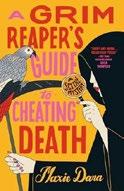
Twins go on the lam when one of them has a date with death. Being stuck at work on her birthday seems fitting for Nora Bird, whose special day has felt marked by death since the untimely demise of both her parents on the same day 18 years earlier, when she was 8. It’s all the more fitting because Nora’s work is quite literally the work of death. Like a modern spin on the Grim Reaper, Nora’s role involves the Secure Collection, Yielding, Transport, and Handling of Essences, suitably abbreviated to S.C.Y.T.H.E. Nora’s just trying to make the day go by when she gets her latest case: Charles Bird, set to die in a crash at 11:15 a.m. Charles Bird, as in Nora’s twin brother, Charlie. Though it goes against everything she signed up for in her job, Nora dashes over to Charlie to try to protect him from the inevitable, loading him and his newly acquired African gray parrot, Jessica, into the car to hit the road for anywhere-but-here. The only trouble is that neither is sure where to seek refuge, and things stall as they try a few dead-end options while S.C.Y.T.H.E. keeps tracking them down (but how?). Leaving the country seems the only option. Canada’s Virgo Bay, a place their father had old friends—or maybe family—might provide some sort of protection for Charlie while Nora figures out a plan. The path to Virgo Bay is more than a little confusing, but what the twins find there is worth every
moment of trouble, and it may lead them to answers for questions they never knew they had about their parents.
A slow start builds to something bigger, but the payoff may not be enough.
Dunnigan, Madeleine | Norton (224 pp.)
$29.99 | January 13, 2026 | 9781324105640
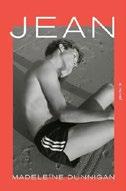
A quietly restless coming-of-age at a British boarding school for wayward boys in the summer of 1976. We meet 17-year-old Jean, “Lord of Unluck,” as he receives a warning in the headmaster’s office of Compton Manor, the “House of Nutters,” his mother, Rosa, has sent him to after years of misadventures and expulsions. At Compton, Jean is an outsider among outsiders, his Jewish heritage and scholarship status ensuring his hackles stay up around the “the boys who are good at sport and who speak in loud, posh voices.” Among these lucky few is Tom, a popular boy who, in the final months of school, begins to seek Jean out for shared joints and other illicit intimacies. Their relationship is fenced in by secrecy—there are rumors, of course, about what an upper year boy might solicit from a younger student in the back toilets, but “none of this would be said aloud. No one is, nor ever will be, a faggot”—and time, as their final school year speeds to an end. Tom remains indistinct, to the reader as well as to Jean, which is part of the point; the novel, true to its title, is a meditation on Jean and the particular clockwork of his adolescent agony. The
voice is a restrained third-person present-tense, its dialogue rendered without quotation marks. Dunnigan’s prose is carefully simple, and while some passages shimmer with piercing insight, the story can feel constrained by its own dedication to subtlety. The commitment to this austere mode makes the odd moments of clunky disclosure all the more jarring: metaphors made literal, realizations spelled out, pinches of traumatic memory reemerging just in time to contextualize destructive behavior. Even so, Jean is a compelling protagonist, his split-knuckled pursuit of a place in the world convincing in its sheer rawness. Bruising, interesting, occasionally sublime.
Faliveno, Melissa | Little, Brown (352 pp.) $29 | January 20, 2026 | 9780316588195

A New Yorker heads to the Northwoods of Wisconsin to renovate her parents’ cabin after her mother’s mysterious disappearance.
Sam, who’s 38, grew up in Wisconsin and often spent time with her parents at Hemlock, a cabin in the Northwoods that her father had built himself with an eye toward retiring there. But those plans were derailed first by the mental decline of Sam’s alcoholic mother and then, more recently, by her disappearance, when she took off into the woods and never returned. To spare her father, Sam offers to make repairs and ready the cabin for sale. Leaving her male partner behind in Brooklyn— Sam is androgynous and has dated both men and women—she arrives in Wisconsin to the same sense of not fitting in that she’s carried since her tomboy childhood there. This time, the sense of otherness is amplified by some strange experiences: First, a doe Sam feeds begins speaking to her. Then, though she’s been sober for
nearly a year, Sam begins drinking again and finds herself routinely waking up in the woods in the mornings with no memory of how she got there. And then there’s her body, undergoing some…unusual transformations. Now that she’s returned home, is Sam becoming someone—or something—new? Or merely what she’s been deep down all along? Faliveno plays with some fun gothic tropes—the isolated setting, a mind fraying—and it’s especially satisfying to see these transposed onto the Upper Midwest, which is captured here in both its beauty and ugliness. The novel doesn’t have the taut pacing one might expect of a story that should be suffused with dread and suspense, though, and the connections between its themes—grief, addiction, class, sexuality—and its eerie plot elements never quite become clear.
A debut novel that can’t quite tame its wild and promising elements.
Fallon, Rebecca | Simon & Schuster (336 pp.) $29 | February 3, 2026 | 9781668089477
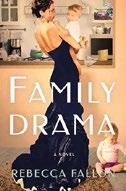
A novel with an unusual timeline, one that teeters between a woman’s determination to have an acting career in the 1980s and her small family’s future difficulties.
Once, women in Salem, Massachusetts, were tried and convicted as witches due to their supposedly superhuman abilities. Bewitchingly beautiful Susan Byrne plays one of the Salem witches at a local museum for an agonizingly long three years as she waits for a break that will get her to stardom. Before that break arrives, she meets tenure-track historian Alcott Bliss; they fall in love and marry, and Susan agrees to remain in his beloved Boston environs. Perhaps playing an alleged witch affected her more than she realized, as Susan seems superhuman when she lands a recurring role on a
long-running daytime soap opera and begins an arduous weekly commute between coasts—even after the young couple agrees to start a family. As scenes of their twins, Sebastian and Viola, years later alternate with scenes of Susan and Al’s increasingly strained relationship, it seems something has to give. Readers will know what that something is from the opening chapter set during Susan’s funeral when the twins are 7, but the expert shuffle between the two time periods will keep them invested in the familial sleight of hand so many will practice in the early years of parenthood. The dealer’s-choice structure allows Seb and Lola to reach adulthood without feeling tethered in roles as progeny; they love and hate their parents in differing amounts at different times, while remaining individuals capable of real achievements and heartbreaking mistakes. The contrast of Susan’s foreshortened career with her best friend Orson Grey’s ascending stardom might be employed in one plot twist too far, yet this bit of business serves to underline one of the kid’s mistakes. In the end, like the soap opera Susan stars in, this drama allows readers to “dissolve; feel your own problems grow trivial against the melodrama, against the height of what a human can feel.”
The author’s emotional intelligence shines through in this affecting novel’s quirky, evolving characters.
Frick, Kit | Emily Bestler/Atria (272 pp.) | $18 paper | December 2, 2025 | 9781668022535

Four friends gather to memorialize a woman’s death, clouded by darkness even five years later. Frick has crafted an entry in the genre of stories that entertain by revealing what terrible people the rich are. Its four main characters aren’t really rich yet, but they’re aspirational: David McKinnon
aspires to be a successful screenwriter, Sirina Shaw aspires to be a famous actor, Harper Gates aspires to be a writer, and Luca di Adamo aspires to find a wealthy boyfriend to support him in idle luxury. What the four have in common is their college friendship with someone truly rich: heiress Clare Monroe. As the book begins, the four receive an invitation to attend a memorial for Clare—a bit belatedly, since she’s been dead for five years. All of them were there when she drowned during a wild New Year’s Eve party, an event they each recall with dread. But it’s hard to turn down the invitation, which includes first-class travel and a week at the Monroe family’s palazzo on the shore of Lake Como, all expenses paid. So they gather in Italy, and as they reconnect, flashbacks flesh out the web of bargains and betrayals their friendships with each other and with Clare were built on—everybody is guilty of all sorts of things. Weird stuff happens, Clare’s possessions showing up in guest rooms and then disappearing, and everyone starts to notice how creepy old Aunt Catherine is. Things are not simple enough to be explained by a creepy aunt, though, and suspicion grows in all directions. Readers who insist on likable characters might look elsewhere, but the author keeps the pace revving like the classic sports cars the guests drive on some of their excursions, and she builds tension well. She also packs the book with enough status-object porn to make readers drool. It’s a little too easy to guess the most villainous villain, but there’s entertainment along the way.
This thriller paraphrases Fitzgerald: The rich are different from you and me—they’re worse.
Guterson, David | Norton (256 pp.) | $29.99 January 20, 2026 | 9781324111054
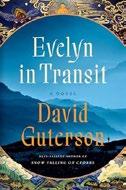
An awardwinning author continues to hone his craft. In the opening scene of this novel, someone called Evelyn has an epiphany while climbing a tree. In the next scene, someone called Tsering has an epiphany while making eye contact with a yak. Both have the same thought in their moment of enlightenment: “I’m alive…I’m separate from everything else.” As the narrative progresses, it becomes clear that Evelyn is a girl growing up in Indiana and Tsering is a boy growing up in Tibet. It also becomes clear that enlightenment is not an unalloyed blessing—if it’s any kind of blessing at all. Both characters diverge from the paths they’re expected to follow, with complicated results. In another writer’s hands, the question that animates the final third of this novel— no spoilers—might be the whole show. This author has other things in mind. Guterson first gained widespread attention with Snow Falling on Cedars (1994), in which he turned courtroom drama into meditative prose. Our Lady of the Forest (2003) was, among other things, an insightful exploration of how we deal with spiritual guidance delivered by imperfect messengers. Like Snow Falling on Cedars, Guterson’s novel The Final Case (2022) includes a murder trial, and, like that previous work, it asks serious questions about what we believe and why we believe it. This new book feels familiar in that the author is still interested in the same moral and
Sophie Hannah has surely written a true original here—not an easy feat.
NO ONE WOULD DO WHAT THE LAMBERTS HAVE DONE
philosophical themes, but it also feels different in that Guterson has clearly set himself free from the encumbrance of plot and detail and most of the trappings of a typical novel. This is a compliment. Perhaps the best way to appreciate this book is to regard it as a set of interconnected fables. Like the heroes of fable, both Evelyn and Tsering only emerge as real when the reader adds the details that make them real.
For patient readers with open hearts.
Hannah, Sophie | Sourcebooks Landmark (400 pp.) | $17.99 paper | January 20, 2026 9781464264306
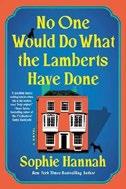
A mysterious manuscript tells the story of a vendetta leading to a perplexing crime culminating in unexplained deaths. Detective Conner Chantree sheepishly brings his superior officer a pieced-together bundle of papers he claims may indicate that a murder was committed in a case that was recently closed. Nearly the rest of the novel offers the contents of this manuscript, which purports to tell the tale of a feud between the Lamberts and the Gaveys, two families in the village of Swaffham Tilney, England. The narrative reveals that the two families are already enemies due to bad blood over a house as well as accusations of bullying between the two teenage daughters, but it leans sympathetic to the Lambert side as it describes how things get really nasty when daughter Tess Gavey reports to the police that she has been bitten by Champ Lambert, the other family’s Welsh terrier. Mother Sally Lambert will do anything to save her Champy, especially as she still mourns the unfortunate death of their first dog, Furbert, after he ate a peach pit. So she teams up with Corinne Sullivan, a wealthy eccentric who previously
caused great friction in Swaffham Tilney due to the Agatha Christie Book Club War. Together with Sally’s eager kids, her reluctant husband, and the loyal Champy, the women set out to prove him innocent—or else go on the lam. There is a great deal of charm here; Sally in particular, and the way she relates to her children both furry and otherwise, is the epitome of a fierce maternal love that grounds the more ridiculous moments of the story. While Parts 2 and 3, which comment somewhat self-consciously on the rest of the novel, feel like a satirical bridge just a little too far, Hannah has surely written a true original—not an easy feat. “Quirky” might be a generous— or possibly reductive—description, but readers who love this book will love it. An absolutely absurdist romp for dog-loving mystery fans.
Hirsch, Joseph | Underground Voices (386 pp.) | $14.99 paper | December 1, 2025 9780998892382
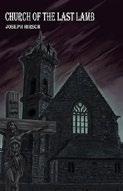
A restless schoolteacher journeys to the heart of darkness to prove his worth during the zombie apocalypse.
We’re 15 years into the end of the world and the whole deal sucks for Dr. Jonathan Greenway. The mild-mannered professor was fortunate to be teaching a class for the U.S. Army when the dead began rising from their graves. Now he’s a second-class citizen at a fortified base somewhere in the American Rust Belt, splitting his time teaching “New History” to thankless child soldiers and literally shoveling shit at the biomass factory. As he yearns for a stable life with his girlfriend, Jon’s temper runs afoul of the fascist tinpot dictator that runs the joint, and he’s quickly banished to a rapidly dwindling reconnaissance squad. Not that the “Chum Bums,” as they’re known, are crack
soldiers—their commanding officer is still haunted from having to icepick his infant daughter, while the rest are expendable conscripts at best. When surveillance reveals a remote church with the power to instantly kill zombies dead (again), the Bums set out on the treacherous journey to investigate. Beset by the dead as well as the Calaveras, a masked death cult from Mexico, Greenway and his comrades finally manage to reach their goal. At the titular refuge, they find that mad chemist James Warnocky has warped theology, science, and alchemy into an infernal combination, though one that holds promise to perform exactly as promised. It’s a good old-fashioned bone-and-gristle cruncher right up George A. Romero’s alley, but there’s more to it. The writing is crisp, punctuated with military patois and medieval violence while Greenway struggles not just to make sense of the horror, but his own place in it. Much like the experiences found in The Walking Dead and 28 Days Later, what’s wrong in this world is human, not some dark force waiting to ambush a hero with a heart of gold. It’s just us. Smart, bleak, and rare—a wide-eyed stare into the abyss sans hope or hysteria.
Johnston, Bret Anthony | Random House (224 pp.) | $28 | February 24, 2026 9780399590153
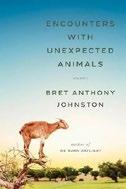
In a dozen stories, men and boys of Texas cope with loss and anxiety, and cross paths with a menagerie of wildlife. The “unexpected animals” are literal in almost all the stories in Johnston’s second story collection, following the novel We Burn Daylight (2024): snakes, horses, ferrets, dogs, a caiman lizard; cameos by deer and brown pelican, albatross, elephants,
and more. Among the exceptions are the title story—in that one, the wild thing is a teenage girl. Johnston gives his regular-guy male protagonists a lot to handle; some do better than others. Anxious fathers often fall short, younger protagonists learn the hard way that tragedy, loss, and the inscrutability of other people are here to stay. Little kids can be abducted or suffer terrible injury; parents can run off or die. The seriousness of these themes is lightened somewhat by quirky elements and snappy dialogue. In “Paradeability,” a widowed dad takes his son, aka Po’ Boy the Hoboy, to a clown convention. In “Dixon,” violent confrontations and a missing daughter share space with an embezzled shipment of Dairy Queen kids’ meal toys. In “Miss McElroy,” a young man whose parents have died visits the home of an older woman he was obsessed with in his younger years; her always scary son, now a former Marine, is living at home post-Afghanistan, amusing himself by copying porn images in charcoal. “If failing to buy your crazy son a stack of Hustlers is on the ballot, I’ve got Mother of the Year stitched up,” she notes. “Time of the Preacher,” a pandemic rendezvous which also appears in The Best American Short Stories 2025 , is the closest the collection comes to a lighter mood. The last story, “Half of What Atlee Rouse Knows About Horses,” contains the book’s most unforgettable scene, in which the aging, diminished protagonist watches a wild stallion save a drowning colt. Maybe there is hope?
The author’s empathy for his troubled characters illuminates their predicaments and mistakes with a solemn, steady light.

Knausgaard, Karl Ove | Trans. by Martin Aitken | Penguin Press (512 pp.) | $32 January 13, 2026 | 9780593832806

A photography student strikes a deal with, perhaps, the Devil.
Knausgaard’s acclaimed six-volume autofiction epic, My Struggle (20122018), inevitably drew accusations of extreme narcissism for the author. But the Karl Ove character conjured up in those books was defined by his ordinariness; this bleak, somewhat overstuffed novel truly is a portrait of self-absorption. Kristian Hadeland is an aspiring art photographer who, in 1985, has left his native Norway to study in London. Disdainful of his teachers’ criticism of his work, he decides to cut his own path, often in troubling ways; for instance, he attempts to boil a dead cat down to its bones in his apartment for the sake of a vague photo project. After cutting off contact with his parents in a fit of pique, his sole friend is Hans, a mysterious Dutch expat working as a stage designer for a production of Doctor Faustus. And this novel is essentially the Faust tale with a modern spin, following Kristian’s path after the Mephistophelian Hans befriends him, pivoting on an altercation between Kristian and a homeless man who dies after they tussle over a cigarette lighter. Hans has pulled some levers to help Kristian escape a manslaughter charge, freeing him to pursue photo-world glory. But at what cost? Many familiar Knausgaardian elements are at play here: Granular explorations of youth and art-making, philosophizing on religion, a scatological detour. But the author is more concerned with ethics than in his previous books, and this novel is overly bulky for the kind of straightforward morality play it imagines. It also asks the reader to spend a lot of time with a profoundly unlikeable young Kristian, who repetitively bemoans how every career opportunity is beneath him and that family and women are drags on artistic greatness. As in the Faust story, comeuppance arrives, but it takes a while.
Knausgaard at his darkest, and most sluggish.
Langsfeld, C. William | Counterpoint (272 pp.) $27 | February 3, 2026 | 9781640097230

After murdering his childhood friend Rust Hawkins, Tom Horak hides out in a cabin in the Colorado Rockies, revisiting his painful past and awaiting his inevitable capture.
Life has been a series of cruelties for Tom. His drunken father subjected him to mental and physical abuse; his mother died slowly from cancer; his free-spirited girlfriend, Rose, took up with Rust, married him, and, following a tryst with Tom, had a baby, Gus. The fierce winter passes slowly in the cabin, where the unrepentant killer subsists on moose meat and bad memories. “Even in the daylight, sun obscured by thick clouds and snowfall, Tom saw only darkness.” His life’s one pleasure, doting on Gus—to Rust’s great irritation—is gone. The boy, abandoned by his mother long before Rust’s death, is taken in by the faith-torn Lutheran pastor Morris Green. Retiring cop Marshal Thomlison, whose work is mostly tossing drunks in jail, unhappily goes after Tom. In different ways, all of the characters struggle with unanswerable questions concerning belief, family, community, and violence. So powerful is the language and reflection in this, Coloradan Langsfeld’s first novel, that the plot is secondary. Here are people who “decided to force themselves through the motions of
things no longer felt in the heart.” The sounds of Tom’s isolation—“the cree-cree of his boots in the hard snow,” “the muffled skitter of powdered [moth] wings struggling against cloth and heat”—speak louder than his inner thoughts. Steeped in existential despair, this stripped-down novel at its best rises to the level of roots masters Michael Farris Smith, Tom Franklin, and Brian Panowich—great company for a writer who will only get better.
A haunting fait accompli captured by a strong new voice in Western noir.
Lewis, Susannah B. | Thomas Nelson (400 pp.) | $18.99 paper | December 9, 2025 9781400347384

Five women gather for a birthday celebration at a waterside Georgia estate. After her husband Jeffrey’s unexpected early death, Moira Allyson turned to alcohol to numb her pain. And when she decided to throw herself a 50th birthday weekend, only four women accepted her invitation: Erin Pepperell, her housekeeper and a single mother; Nell Rehman, a married Southern Baptist with two children; Gemma Gardner, a married realtor with one child; and Celia Kate Stokes, a married homeschooling mother of three. As the five women share the events of the luxury weekend, the pain of their past and current lives comes up. Erin left an abusive marriage and can barely make ends meet; Nell is a recovering alcoholic who leans very heavily on God and her faith; Gemma is a large, self-deprecating woman with a husband who verbally insults her >>>
A haunting tale by a strong new voice in Western noir.
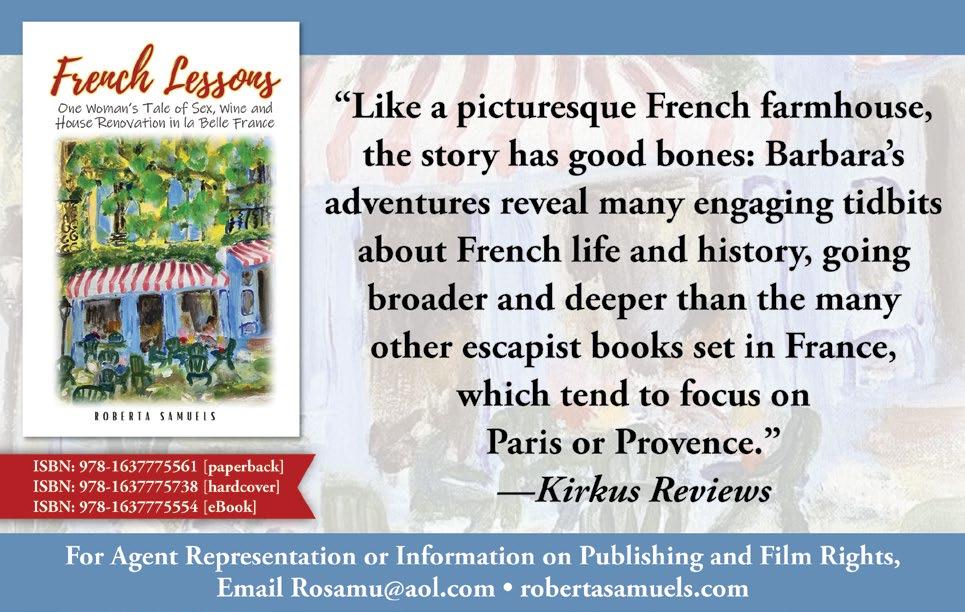



EDITORS’ PICKS:
Predatory Natures by Amy Goldsmith (Delacorte)
Troubling Tonsils! by Aaron Reynolds, illus. by Peter Brown (Simon & Schuster)
Joyride: A Memoir by Susan Orlean (Avid Reader Press)
The Librarians by Sherry Thomas (Berkley)
THANKS TO OUR SPONSORS:
A Girl and Her Dog and Me by Mike Stetz
Seven Exits by Rosenna Bakari
No Woman Left Behind by Kate Grant
The King of Nothing by Liv O’Day
Where Is Love? by Annie Caboose, illus. by Raymund James Dakay
Fully Booked is produced by Cabel Adkins Audio and Megan Labrise.

Janice Hallett talks literary suspense on our Mystery, Thrillers & Horror episode. BY MEGAN LABRISE
On this special episode of Fully Booked , Janice Hallett joins us to discuss The Killer Question (Atria, September 23), in celebration of the Mystery, Thrillers & Horror Issue of Kirkus Reviews . “A quintessential British pub, an escalating quiz-night rivalry, and a deeply personal mystery unfold in this clever epistolary tale,” Kirkus writes in an enthusiastic review of Hallett’s latest, calling it, “a masterclass in plotting. Warning to readers seeking emotional footing: The rug will be yanked again and again.”
Hallett is the author of such celebrated murder mysteries as The Examiner, The Mysterious Case of the Alperton Angels , The Appeal , and The Twyford Code. She is a former magazine editor, award-winning journalist, and government communications writer. A playwright and screenwriter, she penned the feminist Shakespearean stage comedy NetherBard and cowrote the feature film Retreat . She lives in London.
Here’s a bit more from our review of The Killer Question : “Making a pitch to a Netflix documentary producer, Dominic Eastwood promises a doozy of a yarn when he outlines the first part of the story of his aunt and uncle, Sue and Mal Eastwood. The couple runs The Case is Altered, a cozy Hertfordshire pub known for its community spirit and beloved Monday Quiz. Trivia lovers, including the Plucky Losers, the most regular regulars, treat the quiz with endearing gravity, mirroring Mal’s pride in crafting each week’s questions to be obscure, fair, and challenging. But the arrival of a new team, the enigmatic Shadow Knights, upends the pub’s gentle


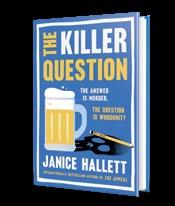
The Killer Question Hallett, Janice Atria | 448 pp. | $30 September 23, 2025 9781668083536
rhythms.…Dominic’s pitch to producer Polly takes a darker turn as a text exchange between Mal and a local police officer reveals that a body’s been found in the local waters. The victim, it turns out, was known for cheating at local pub quizzes—a detail that rattles Mal and Sue, especially as deeper ties to their past come to light.”
In conversation, Hallett and I cover the stakes her characters must face, epistolary fiction, the enduring appeal of whodunnits, novel writing, screenwriting, one-star reviews, and other dark matters.
Then editors Laura Simeon, Mahnaz Dar, John McMurtrie, and Laurie Muchnick share their most thrilling recommendations.
Editor at large Megan Labrise hosts the Fully Booked podcast.

The Pulitzer Prize–winning author’s Villa Coco will be published next spring.
Andrew Sean Greer has a new novel coming next year, People magazine reports.
Doubleday will publish the author’s Villa Coco in the spring. It says the book “showcases his wit, sophistication, and deep knowledge of focaccia in this magical and madcap tale.”
Greer made his publishing debut in 2000 with the story collection How It Was for Me and followed that up with novels including The Path of Minor Planets, The Confessions of Max Tivoli, The Story of a Marriage, and The Impossible Lives of Greta Wells Greer won the Pulitzer Prize in 2018 for his comic novel Less, and he published a sequel, Less Is Lost, in 2022.
Villa Coco will follow an unnamed young man who works for a wealthy widow in the Italian countryside; he is hired as an archivist but finds himself embarking on a number of odd jobs around the estate. “Told with the signature wit, insight, and deeply felt humanity that made Less an international phenomenon, Villa Coco is a dazzling, sun-soaked ode to life itself—a romp through a youthfully self-constructed emotional obstacle course, a meditation on what we give and take from others, and a bawdy Mediterranean ballad about becoming who you’ve always wanted to be,” Doubleday says.

Villa Coco is slated for publication on June 9, 2026.
—MICHAEL SCHAUB






The romance novelist was known for “bonkbusters” such as Riders .
Jilly Cooper, whose gleefully sexy romance novels set in the Cotswolds made her a cultural icon in the U.K. and a bestselling author on both sides of the Atlantic, has died at 88, the Guardian reports.
Cooper, a native of Essex, England, worked as a reporter, copywriter, and newspaper columnist before making her literary debut in 1969 with the advice book How To Stay Married. Her first novel, Emily, was published in 1975; it was the first in a series that also included Octavia (1977) and Imogen (1978). Cooper took the publishing world by storm in 1985 with Riders, which followed a group of sex- and party-loving British equestrians. The book became an iconic


“bonkbuster”—a bestselling novel with plenty of sexual content—and was the first in Cooper’s Rutshire Chronicles series, which continued for 10 more books, including Rivals (originally published as Players in the U.S.), which was recently adapted for a Hulu series. Cooper’s most recent novel, a Rutshire Chronicles installment titled Tackle!, was published in 2023. Cooper’s fans paid tribute to her on social media. On the platform X, novelist Philip Hensher wrote, “Blessings upon the head of Jilly Cooper. In my view, her novels—funny, panoramic, vividly written and beautifully observed—will still be read decades from now.”—M.S.

size at every moment; and CK is riddled with anxiety about her children. Nell is confident—and tiresomely repetitive— that prayer, leaning on God, and quoting scripture is what it takes to lead every woman into the light, as she feels it has done for her. (The light being a relationship with God, near-constant prayer, and church attendance.) This is a story of five women getting to know one another and each other’s struggles. It is heavily interspersed with Bible verses and lengthy speeches from Nell that preach her version of Christianity and salvation. And though the story has a similar premise as Elin Hilderbrand’s The Five Star Weekend (2023)—a birthday weekend and deepening female friendships—it lacks the empathy, humor, and warmth of that volume.
A religious novel that advocates a single type of faith for all.
Lloyd, Josie & Emlyn Rees | Putnam (352 pp.) $30 | February 10, 2026 | 9798217177073

A long-married couple stumble on a time machine and relive crucial scenes from their lives.
Adam and Jules have been together for 25 years and have begun to take each other for granted. Their lives are stale, and their grown children are sullen and living at home. Adam is plugging away at a job he can’t stand, while Jules is struggling to make her catering business work and secretly drowning in credit card debt. When Jules tries to throw out a box of old mixtapes, Adam can’t bear to see them go—to him, the tapes signify how much they’ve always meant to each other, even if they haven’t shared one (or properly connected) in years. He pops one into his ancient stereo and is, surprisingly, yanked back in time to the moment he gave Jules the tape. Soon he and Jules are both traveling in time and re-experiencing moments from their pasts. They promise
YOU & ME AND YOU & ME AND YOU & ME
not to alter anything, but neither of them can help making what, at first, are tiny changes—Adam convinces his past self to start a workout routine, while Jules tells past Adam not to grow a beard. Soon, though, they’re making bigger changes to give themselves the lives they deserve, and those changes create massive, unanticipated shifts in their current reality. Is it possible they’ve created a life where they don’t even end up together? Co-writers Lloyd and Rees create a touching portrait of a marriage in crisis as Adam and Jules relive their best and worst moments and watch their children grow up in the blink of an eye. They’re forced to reexamine their biggest regrets and decide if living through horrible things actually helped them become the people they are. Ultimately, the story is a reminder to live in the present and appreciate the tiny moments that make up a life—as one character tells Jules, “Happiness is learning to love what you already have.”
A lovely, emotional look at the importance of everyday joys and appreciating what’s in front of you.
Kirkus Star
McConigley, Nina | Pantheon (224 pp.)
$26 | January 20, 2026 | 9780593702246
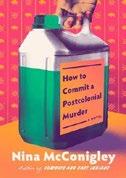
A coming-of-age story about an Indian American girl struggling to figure out many things about herself, such as whether she and her sister should kill a relative.
It’s the summer of 1986, dead solid center in the middle of the Reagan decade, and sisters Georgette Ayyar and
Agatha Krishna Creel are trying to make the best they can of awkward pre-adolescence in the oil town of Marley, Wyoming. They are daughters of Indian parents, Girl Scouts, Catholic school students, and named after their mother’s favorite authors—Heyer and Christie, respectively. “We were named after proper white ladies, even if we ourselves were never proper anything,” Georgie recalls. They are taken aback when their placid lives are disrupted by the arrival from India of their mother’s brother, Vinny, his wife, Devi, and their son, Narayan, who are all moving into their Cottonwood Cross home to stay. “Vinny Uncle made us shadow people,” Georgie says. And it is for the reason of feeling somehow split in two (“like freeze tag,” Georgie argues) that she and Agatha decide that Vinny Uncle must die. Their method: sneaking small amounts of antifreeze into his drinks. “Bright Mountain Dew in big cups,” Georgie recounts. “It was surprisingly easy to make him sick.” As her uncle gets gradually sicker, Georgie attends summer camp, watches the wedding of Prince Charles and Lady Diana, takes part in the local county fair and Fashion Revue, and waits for something to happen. Along the way, the narrative takes sardonic divergences, mostly in the form of multiple-choice romance questionnaires like the kind found in magazines. Examples: “How Do You Know If You’re Ready To Have a Sexual Relationship?”; “Is He Bad for You?” and, even, “Do You Have What It Takes To Kill?” Which is something Georgie finds herself asking, even as she and her sister are carrying out this inexplicable mission, for which they blame, among other things, British colonialism. Though framed like a funny, ferociously allusive grown-up version of a YA whodunit, McConigley’s debut novel carries deeper, knottier mysteries than the curious crime at its center.
Wittily observant and achingly tender.
Meltzer, Brad | Morrow/HarperCollins (400 pp.) $32 | January 6, 2026 | 9780062892430

An unlikely duo deals with multiple connected murders.
Andrew Fechmeier, dying from CreutzfeldtJakob disease, stitches a secret object in the suit he plans to be buried in and leaves it in a funeral home. Then in a motel, an attacker stabs him to death when he doesn’t divulge where the object is, setting up a series of slayings in this tense thriller. The trouble had started years ago with a group of teenagers calling themselves The Breakfast Club, named after the movie. They’d stolen the object that now is getting them killed, one by one. This is the third outing for Zig and Nola, who are not friends or colleagues—she doesn’t even especially like him, but each has helped the other in times of dire need. Jim “Zig” Zigarowski is a skilled mortician who has helped make many combat victims look presentable. An amiable but odd fellow, “it took a mortuary to make him feel alive.” He speaks kindly to the dead as he stitches together parts of their skulls and dresses them presentably for viewing. “You know how to speak funeral,” he’s told, and when he spots fake morticians at the funeral home, he sees trouble. Nola Brown is a sketch artist whose personality grew a protective shell due to an unusually messed-up childhood. Nola’s mother, Daniella, died, supposedly by suicide, when Nola and her twin brother, Roddy, were 3 years old. But she has Zig’s admiration and gratitude, as she had saved the lives of both Zig’s daughter and Zig himself. But Roddy, now a cop estranged from Nola, believes their mother was murdered by the same person who killed Fechmeier and for the same reason. Nola has no good feelings for Daniella and would as soon forget her. Nola generally walks around feeling pissed, but underneath that hardness is a smart, caring person. There will probably never be an action figure of Zig the
amiable mortician who is strangely attracted to pain, because the real energy comes from Nola, who may or may not survive hellacious hand-to-hand combat with a bad guy. Dark and quirky fun.
Meyer, Lily | Viking (336 pp.) | $29 February 3, 2026 | 9780593835142

An anti-romantic finds herself at odds with her own beliefs when she falls in love with not one, but two men. Meyer’s provocative novel follows Sylvie Broder from her childhood in a New England town where “families agonized aloud about college but never tuition” into adulthood. Growing up at odds with her quiet and rule-obsessed parents, Sylvie was only allowed to be her loud, emotional, and messy self while visiting her joyful grandparents, who were Holocaust survivors. Then, in high school, she falls in love with “famously perfect” Jonah Sabransky. Over the course of an 11-year relationship that includes marriage, Sylvie submits herself to his increasingly cruel wants, needs, and desires—and becomes smaller and meeker with every passing year. When she finally leaves, she does so without a word. As she attempts to rebuild her life, Sylvie starts a philosophy Ph.D. program, seeks out one-night stands, and avoids Jonah’s endless emails. In both her life and her dissertation work, Sylvie dreams “of the world after romance,” because public-facing relationships kept “women from flourishing and corroded true love.” Her marriage not only completely leveled her life and relationships, but her belief in the concept of romance. These rigid beliefs are beautifully challenged when she meets two distinctly different men: sweet and understanding Robbie, who lets Sylvie be exactly who she is, and boisterous and family-centric Abie, who opens Sylvie up in ways she never knew possible. As she falls in love, she lets go of what she knows
and begins to understand how she feels. Meyer has rendered Sylvie with such complexity that she’s able to garner empathy from the reader despite her selfishness and shortcomings. Steeped in current events and philosophical theory, the book also deftly explores abuse, monogamy, the #MeToo movement, Judaism, love, and power dynamics in and out of the bedroom. A less capable writer would stumble under the weight of the book’s intricate themes, but Meyer’s prose is both graceful and skillful. A charming and complex book full of intellect, humor, and—despite its title—romance.
Nemens, Emily | Tin House (400 pp.)
$28 | February 3, 2026 | 9781963108668

A crew of five women friends, long-distance since college, weather the travails of their 40th year. Each chapter of Nemens’ sophomore novel opens with a line or two from the group chat shared by Carson the writer, Gregg the politician, Hillary the doctor, Bella the litigator, and Reba the former consultant, or with one of their individual texts to or from someone else. This infrastructure helps move the timeline and the plot; in addition, a thumbnail guide to the characters appears at the beginning of the book. With five central characters, many supporting ones, and a trajectory covering two decades, almost year by year, these elements are helpful. “Another quiet stretch for the women was 2014. In the eighteen months prior they had all turned thirty (Reba, with her basketball gap year, was the first across the threshold; Gregg brought up the rear).”
As the omniscient narrator goes on to fill in details from each friend, as well as current events, cultural moments, and updates on Britney Spears, it’s tempting to picture giant timelines papering the walls of the author’s study. Her management of the five-pronged, often
high-drama plot, the rotating points of view, and the characters’ constant introspection is impressive. Yet somehow the sheer complexity of it all keeps the book from developing enough momentum to ever become fully immersive, and none of the five main characters evokes the kind of identification that invites the reader to connect emotionally. A typical moment has Carson meditating on the ways she and each of her friends has fallen short of their dreams. Gregg, for example, “was blind to the gotcha of promoting progressivism while being inextricably bound up with the latest (last?) stage of late-stage capitalism; she couldn’t see, or wouldn’t acknowledge, her normie marriage, the patriarchy of her prenup, how her big-shouldered and bruising careerist tendencies, cloaked as they were in pastel blazers, were only nominally better than Zeke’s cutthroat business acumen.” In fact, that cutthroat acumen of Gregg’s husband Zeke will play a major role in the book’s gut-punch climax, rewarding the reader who’s paying attention to all the details. Full of intelligence, social consciousness, and cultural engagement.
Ní Chuinn, Liadan | Farrar, Straus and Giroux (160 pp.) | $17 paper January 20, 2026 | 9780374620028

The past is never far away in these debut stories about Irish intergenerational trauma.
Ní Chuinn (a pseudonym for a Northern Irish writer) takes up the inheritance of characters born after the Troubles, an ethnic and national conflict that took place in Northern Ireland from the 1960s to 1998. In “We All Go,” the narrator Jackie’s parents are carjacked, and his mother, too pregnant with him to spring from the passenger seat, goes into labor days later covered in cuts from the broken windshield. Named after his
grandfather, who was interned by the British Army, Jackie longs to know more about his past, but his father is dead, and his family has no interest in reliving it, even though, the narrator explains, “they’re here, inside me…things unspoken as though that makes them unseen.”
Elsewhere, in “Daisy Hill,” John, who has already lost so much, goes to visit his uncle, who’s in the process of trying to kill himself. John’s interest in the past drives his contemporaries crazy, but he understands that yet another member of his family has been broken by what he survived. Here, the unseen and unspoken become visible and loud in the story’s final section, which takes the form of a litany of violent acts committed by the British Army against Northern Irish children and adults. Calling these stories intricately woven doesn’t do them justice. In the ones set in Northern Ireland, complex extended family relationships sew together the fabric of the fiction in surprising ways; in the stories set elsewhere, Ní Chuinn gathers loosely connected narrative threads and perspectives, using juxtaposition to create unlikely connections. Both approaches suggest that pain and loss are sewn into the cloth of families and communities and that the cost of intimacy is too often suffering. “I missed my mother,” reflects the narrator of a story about named and unnamed generational violence. “Since I was a teenager, she’d broken in my shoes for me. She insisted. I had seen her feet bleed.”
Wholly original, quietly disquieting short fiction.
Novack, Rebecca | Avid Reader Press (240 pp.) | $28.99 | February 10, 2026 9781668214619
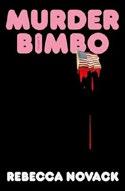
Three ways of looking at a bizarre and prescient story of political assassination.
“I’m a thirtytwo-year-old sex worker who just killed a politician on what I thought were the orders of
the American government. Here’s your chance to catch me before I become a scapegoat, a punching bag, or a monster who needs reputation restitution. Please, please, please turn me into a feminist antihero.” Murder Bimbo, as she describes herself in the email quoted above, addressing a podcast host named Justice Bimbo, may not sound ripped from the headlines, but her victim, Meat Neck, is eerily familiar. Young, handsome, claiming his is “a new kind of conservatism,” he is anathema to the queer community, particularly the narrator’s desperately missed ex-girlfriend, aka X. “Is there a bigger act of love than murder?” wonders the accidental assassin after perpetrating Meat Neck’s demise—at which point he becomes the subject of a special four-part series called Killing Baby Hitler: Meat Neck and the Making of an American Folk Hero. It’s amazing to think that all this was written long before Charlie Kirk was killed. That is intriguing in and of itself, but whirling around those provocative plot elements is a fractured narrative that will tax many readers’ comprehension and patience. Structured in three acts which continually reshape the identities of the characters and the details of the events surrounding the murder, the drama screeches to a halt with an epilogue that navigates back toward a more conventional storyline. Or maybe not. By the end of the book, one’s brains are so thoroughly scrambled that one can only stare at the author’s bio—Novack is a mother of two with a masters in theological studies from Harvard Divinity School, living with her husband and children in the Hudson Valley! Surely this is the final plot twist. Requires sophistication and patience beyond the reach of the ordinary reader.

For more fiction reviews, visit Kirkus online.
Page, Libby | Berkley (416 pp.) | $30 February 3, 2026 | 9798217186990

A widow receives a year’s worth of books from her late husband and learns to live again in the process.
Matilda “Tilly” Nightingale always loved reading. It was her constant as a child, it led to her job as an editor in London, and she even met her beloved husband, Joe Carter, in a bookstore. But when Joe is diagnosed with cancer, Tilly stops reading altogether. After Joe dies, Tilly finds herself going through the motions at work and at home—until she gets a call from a local bookstore owner, Alfie Lane, saying he has a special gift for her from Joe. It’s a copy of Matilda by Roald Dahl, the classic children’s book about a girl who loves to read, and a letter from Joe. Before he died, he’d visited Alfie at Book Lane and set up a year of books for Tilly—one for each month, each with some sort of instruction or encouragement. Even though Tilly has no intention of getting back into reading, she finds herself drawn to the pages and the bookstore. Soon, the monthly books are encouraging her to cook, travel, and see a horizon beyond the pure grief she’s been living with. As the bookstore becomes a second home, Alfie becomes a treasured friend. Page creates a cozy world that shimmers with whimsy even as she delicately explores grief. It’s easy to understand why Tilly is reticent to open up her life, but that makes it all the more satisfying when she learns to let people in—whether those people are her family members or new friends. Alfie faces his own challenges in owning a bookstore, and the scenes in Book Lane are delightfully reminiscent of You’ve Got Mail. The novel serves as a reminder that books have the power to shape lives, and, as Tilly puts it, “Adventures are waiting for you. It’s time to open the page.”
The perfect cozy read for book lovers, sure to break and heal hearts.
Patterson, James & Imogen Edwards-Jones Little, Brown (416 pp.) | $32
December 1, 2025 | 9780316580519
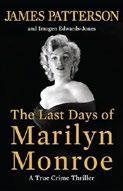
Nearly a hundred years after Marilyn Monroe’s birth, Patterson and co-author Edwards-Jones recount her dramatic life.
The novel begins with the death of the troubled actress, apparently from an overdose of sleeping pills. Immediately, questions surface: Were all the medications on the nightstand prescribed? If she did take her own life, where was the drinking glass for the water to wash down the pills? Contradicting the title, the authors then shift back in time to show Norma Jeane as a young adolescent who goes “from String Bean to hubba-hubba in one summer.” She comes from a broken family—a mother in and out of mental health facilities, a father she never knew, a guardian who’s ready to send her back to the orphanage—which leads to her first marriage, at 16, to a local factory worker turned Marine, Jim Dougherty. The chronological narrative follows Norma Jeane as she becomes Marilyn; as she fights to build a career in Hollywood; as she marries and divorces and has affairs with famous men; as she abuses pills and alcohol, attempting to fill the emptiness that plagues her throughout her short life. What’s not clear is Patterson and Edwards-Jones’ goal here. The early details of Marilyn’s biography are told in short chapters, with few more deeply developed scenes. Sometimes there will be a piece of dialogue or an excerpt from a letter that is presented as authentic—and truly, the bibliography suggests an incredible amount of research. So…why is this a novel? How is this framing of Marilyn’s story new? There is some work at building a conspiracy theory about the Kennedys (which has been hinted at before by James Ellroy); there is some suggestion that her death may have been murder (which has been explored before
by Donald H. Wolfe); and there is a clear romanticization of this tragic, gorgeous life (which has been imagined before by Joyce Carol Oates).
It’s a very readable American tragedy—but what’s new, and what’s the point?
Rader-Day, Lori | Minotaur (352 pp.) $29 | January 6, 2026 | 9781250393739
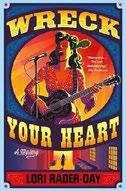
Messy felonious mom, annoying newfound sister, and murder: It’s not a country song, it’s her life. Fed up with her no-account boyfriend, aspiring country singer Dahlia “Doll” Devine convinces the landlord to let her into Joey’s apartment to retrieve her personal effects before crashing with her friend Oona, whose dogs, Bear and Lemon, greet her warmly. Next, it’s off to McPhee’s Tavern, where Doll sings for her supper to the delight of the three pub regulars whom she tags the Jims: Primary Jim, Lumpy Jim, and Silent Jim. Chicago’s an unconventional locale for a country thrush, but as her tart first-person narration shows, Doll’s an unconventional gal. Just as she’s feeling a bit more in control, her messy mom, Marisa, glamorous and self-involved and usually on drugs, shows up unexpectedly—very unexpectedly, considering she hasn’t been around since Doll was 6, two decades ago. Fortunately, Doll’s dependable former guardian, Alex, appears to pick up the pieces and back Doll up. Though not her biological dad, he’s always been there when she needed him. But things don’t get any calmer for Doll. A waiflike girl named Sicily shows up at McPhee’s with the news that she and Doll are sisters. Her description of Marisa as a caring and responsible parent wildly diverges from Doll’s experience. Joey’s found dead in the alley behind the tavern, and gruff detective Vince Aycock arrives looking for answers. Then Marisa goes missing. The murder investigation jockeys for Doll’s attention as she and Sicily
unsteadily search amid other comic distractions. If it’s not one thing, it’s your mother.
A buoyant thriller with vivid characters and wisecracks aplenty.
Rivera Garza, Cristina | Trans. by Christina MacSweeney | Graywolf (288 pp.) | $17 paper | February 3, 2026 | 9781644453698

An author in search of a history that’s been all but erased.
Rivera Garza’s latest book to be translated into English begins with an exhausted man on horseback racing to the “transit point” of Estación Camarón in northern Mexico. His name is José Revueltas, and the Mexican Communist Party has sent him to the settlement, near the country’s Irrigation System No. 4, where the community’s cotton workers have gone on strike. Revueltas, an author and activist, really existed, and he wrote about the strike in his novel Human Mourning (1943). There’s also a real-life couple in Rivera Garza’s novel: Estación Camarón laborers José María Rivera Doñez and Petra Peña Martinez, whose son, Antonio Rivera Peña, is Rivera Garza’s father. The author’s grandparents and Revueltas were both at Irrigation System No. 4 around the same time, but Rivera Garza doesn’t know if they ever met, which is in large part because the history of the region— and the town itself—have been erased: “We can’t go to Estación Camarón because Estación Camarón doesn’t exist,” Rivera Garza writes, “but we go there anyhow.” This book functions as an account of that journey, in which she tries to discover the real stories of her ancestors, which results in frequent frustration: “I have never felt the passage of time to be a punishment as strongly as in the towns cotton has passed through, with its trail of protests against the exploitation and inequality resulting from
its cultivation.” This remarkable book is billed as a novel but resists classification; it blends biography, history, literary and ecological criticism, and, crucially, memoir. Rivera Garza beautifully asks vital questions about whose stories get to be preserved: “Belonging is the mechanism we use to make time palpable again,” she writes. “Writing, which convenes the past, summons it, also invites us to be there.” This is undeniably a major accomplishment. A masterful blend of genres from a shining light of Mexican literature.
Rose, Heather | Summit/Simon & Schuster (336 pp.) | $29 | January 27, 2026 9781668094914
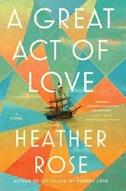
Australian author Rose has written a historical novel about the island of Tasmania— largely settled by convicts transported against their will, along with other social outcasts—through the experience of one determined 19th-century settler, not a convict but a grieving widow starting her life over.
The only catch is that 23-year-old Caroline Douglas, who disembarks in Hobart with her nephew, Quill, was never married. She’s actually Caroline Colbert, and Quill is not her nephew but a 10-year-old cabin boy she purchased from a ship’s captain (who bought him from the boy’s father). Caroline has arrived from New York City, having previously fled London to avoid arrest for thievery, the lucrative career she took up after her French-born father, Jacques-Louis, a respected London apothecary, was convicted of murder in 1836. She’s moving to Van Diemen’s Land—soon to be renamed Tasmania—aware that he was shipped to the prison on nearby Norfolk Island. With the ambivalent hope of finding Jacques-Louis, who may or may not have gone mad, Caroline buys land and raises wine grapes. It’s not a coincidence that in pre-revolutionary France,
before his parents met the guillotine, the Colbert family business was winemaking. If this seems like a lot of backstories, it is. Tying her earnestly researched history of the period to the origin story of one fictional family, Rose employs a surfeit of subplots, along with lessons in wine making and excerpts from poetry, primarily The Rime of the Ancient Mariner Expect several murders and sexual assaults, characters in multiple disguises, gratuitous cameos by historic figures, madness, villainy, and one rather thin romance. Caroline and Quill, who have an idyllic mother-son relationship, become close friends with their neighbors, the historically accurate Swanstons, and fictional Cornelius, a skilled blacksmith with secrets of his own. Although secondary characters border on two-dimensional good or evil, Caroline is a refreshing mix, continually weighing morality against ambition. Her absorbing consideration of the rewards and limitations of personal reinvention becomes the book’s great strength. There are genuine insights into human nature in this exhausting, sometimes overwritten deep dive into Tasmanian history.
Saeed McLynn, Fiza | Park Row Books (368 pp.) | $18.99 paper | January 13, 2026 9780778305965

A gloriously sinister carnival attraction changes the lives of an abandoned British child and a French detective. British writer Saeed McLynn’s lush, suspenseful debut begins just before World War I, as Parisian detective Laurent Bisset is investigating the disappearance and probable death of several riders on a carousel designed by a man who vanished just before it was to make its debut. Meanwhile, on an island off the coast of England, young Maisie Marlowe, uncertain of her parentage and scorned for her “almond-colored” skin, is growing up hungry and illiterate in a swarm of
foster kids until, in a scene out of Dickens or a fairy tale, she is whisked by an aunt she has never met to live at a mansion owned by Sir Malcolm Randolph. When Aunty Mabel and Malcolm’s daughter, Catherine, die suddenly of scarlet fever, Malcolm moves to Chicago, where his brother lives, taking Maisie with him, and on a whim, buys the very carousel on which the French deaths occurred, turning it into the centerpiece of a new amusement park. And then the disappearances from the carousel start again. Laurent arrives from Paris to investigate and to fall for the now 20-something Maisie, despite multiple obstacles, including their respective spouses and kids, as well as some scheming relatives and a few mobsters. Saeed McLynn nicely juggles the possibility of a supernatural cause for the disappearances and a more naturalistic one, leaving the reader guessing until the very end. Maisie is a plucky heroine, as deft at business as she is at dodging the many obstacles life throws in her way. Saeed McLynn’s British scenes have touches of magic, both dark and light; her Chicago scenes are historically accurate without being ponderous; and the lovingly detailed Silver Kingdom amusement park is irresistibly charming. A sumptuous treat for romantics and the young at heart.
Sayles, John | Melville House (544 pp.) $32 | January 20, 2026 | 9781685892272

Scene from the lives of those caught in the tentacles of the Depression-era Ford Motor Company.
Filmmakernovelist Sayles wrote and directed Matewan (1987), a classic film about a miners’ strike, so this story, which largely turns on unionization efforts at the automaker, understandably appeals to him. Henry Ford himself is largely offscreen; instead, Sayles emphasizes the ground-level workers who find themselves under the
corporate heel, until they find a path to resistance. Among the most engrossing are Rosa Schimmel, a daughter of Eastern European Jewish immigrants who becomes involved in the organizing efforts, and Zeke Crowder, a factory-floor worker, who like most Black Ford employees, was thrust into the most dangerous jobs. Side plots abound, most prominently involving Fordlandia, the company’s ill-fated attempt to farm rubber trees in Brazil. But there are other scenes involving the mob’s engagement with the company, Henry’s enchantment with Nazism, Diego Rivera’s arrival to paint murals on the company’s behalf, Joe Louis’ heavyweight title, journalists, radio pundits, Klansmen, race riots, romances, and more. Indeed, too much: Sayles’ novels generally lean toward the epic, but in this case the book—which stretches from the start of the Depression to the end of World War II—feels at once overstuffed yet thin when it comes to each individual plotline. As Sayles notes in the acknowledgements, Detroit in this era was “more a high-pressure crucible than a genteel American melting pot,” but a little less scene-cutting would deliver the message more clearly. Still, though the plot is busy, the message is simple and potent: Unchecked corporate power is a path to the mistreatment of humans, but people have the capacity, together, to win back their dignity.
A well-researched if manic trek through the perils of industrialization.
Schott, Lauren | Harper/HarperCollins (320 pp.) $30 | January 20, 2026 | 9780063432710
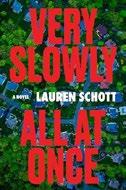
A mysterious benefactor turns menacing for a young couple with financial problems. Everything comes at a price. That’s the lesson in Schott’s first book for adults, a suspense novel about a married couple striving for upper-middle-class success whose lives veer off course when financial problems ambush them. On the outside, the future appears rosy for the
Evanses: They have two young daughters, an expensive new house in an exclusive neighborhood and once-solid careers. But Mack, who teaches English at a Cleveland technical college, falls under official scrutiny after throwing parties for his students, just as he has to take over the staggering monthly payments for his mother’s assisted living facility in Florida. His wife, Hailey, a divorce attorney, runs afoul of her successful law firm when she finds herself caught between a warring couple, neither of whom seems inclined to pay their bill. So when the Evanses start getting checks in the mail from an unknown business called Sunshine Enterprises, the money is welcome, and Mack can’t resist spending it. But then a mysterious entity starts making outrageous and illegal demands in return, and Mack and Hailey can only wonder how far they’ll go to prop up their crumbling American dream. The threat, of course, is the sort of far-fetched plot device that would be rendered impotent by calling the police, but Schott comes up with enough roadblocks to keep the story feasible, and she fills the story with enough suspects to keep you guessing. She’s also effective at chronicling the unraveling of the Evanses’ marriage and makes a strong case for the all-too-real perils of living beyond one’s means. The perspective shifts among Mack, Hailey, and a malevolent observer who provides insight into motivation, and while the ending isn’t entirely satisfying, getting there can be entertaining. A thriller with plenty of tension despite being powered by an improbable plot device.
Shriver, Lionel | Harper/HarperCollins (304 pp.) $30 | February 10, 2026 | 9780063482142
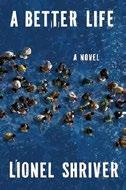
Shriver, who’s flirted with hard-right ideology, cozies up to the Great Replacement conspiracy theory. Gloria and Nico Bonaventura live in a large Queen Anne house in Ditmas Park, Brooklyn.
Gloria, the matriarch, is a 62-year-old liberal divorcée eager to support migrants arriving in New York. Enrolling in a city program paying residents to take in migrants and ease overstressed hotels and shelters, she soon welcomes Martine Salgado, an asylum-seeker from Honduras. Gloria’s 26-year-old son, Nico, college-educated but unemployed, resents the intrusion, but is committed to observing before passing judgment. What he witnesses is a doom-mongering fiction about immigrant invasion. With the stately Queen Anne serving as a metaphor for a once-mighty America built on the backs of white Europeans, the Bonaventura home is speedily filled with ever more Honduran migrants, eager to exploit subsidized housing, food, and medical care. Gloria is pressed to give ransom money to Martine to rescue her (maybe) kidnapped children back home, which is only the start of the bleeding. Martine isn’t a stock immigrant character, and her relationship with Nico has an interesting push and pull, but Shriver complicates her mainly to serve the trope of the inscrutable foreigner. The remainder of the migrants are uncivilized schemers at best, gangsters at worst. The asylum system, immigration enforcement, and leftism are not above critique, but Shriver all but revels in meme-grade complaints about “calculated, premeditated welching,” “welfare shoppers,” “Black Lives Matter loonies,” and “nonsensical trans crap.” Fitting such cliches, the climax promulgates a might-makes-right scenario fit for a John Wayne film. Shriver has long taken pride in heterodox thinking, which has made for some fine novels. Here, though, she’s persuaded that savaging liberal pieties represents a brave stance, when this rehash of The Camp of the Saints is just hackneyed paranoid xenophobia. Her worst book, by a wide margin.

Stanley, Kelli | Severn House (336 pp.)
$29.99 | January 6, 2026 | 9781448317547

A woman on the run in the 1980s takes refuge in a Northern California haven she comes to realize is overrun by secrets of its own.
Arriving in moody, fogcovered Humboldt County after a four-day trip on a Greyhound bus, Renata Drake hopes the isolation of Garberville will grant her anonymity. She’s fled Washington, D.C., and a past shrouded in moral ambiguity: something violent, something righteous, something she won’t reveal, maybe even to herself. Taking a janitorial job at the Southern Humboldt Community Hospital and seeking shelter in the town library, Renata, or Nattie, as she becomes known, tries to live invisibly. But she can’t ignore the secrets others in the small town try to hide, and her curiosity about the tales of three missing girls over the past three years haunts Nattie just like the specter of her sister, Josie. The town’s illicit economy, as part of California’s Emerald Triangle of cannabis production, has been both a lifeline and a liability. Funding that undergirded the town infrastructure is threatened with the increased presence of law enforcement. The enforcers, in turn, are more concerned with prosecuting offenders than preserving human life, and the advent of the Campaign Against Marijuana Planting is clearly seeking to wipe out the whole operation. Nattie’s compelled to do her own investigating when she sees her new boss, Doris, receive word that they’ve found 16-year-old Jennie Dayton dead. Reordering her priorities, she’s determined to make inroads into the crimes while trying to keep her own past under wraps.
This series debut, more smoke than fire, promises a reckoning but keeps much in reserve.
Sussler, Betsy | Spuyten Duyvil (252 pp.) | $22 paper | January 26, 2026 | 9781963908879
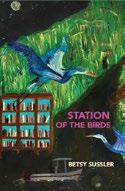
A young man sets up a smuggling operation in his native Louisiana.
“New Orleans shimmies,” Sussler writes at the outset of her strangely haunting debut: “formed from a swamp into a Creole capital, it’s all sweat and longing, the sweet smell of decay and wild, wild wails.” This is a novel full of longing—and wild wails, for that matter—though not so full of straightforward plot. Here’s what we’re given: Daryl Monroe, our intrepid hero, returns to his backwoods Louisiana home after his mother dies and he’s disinherited by his wealthy father. Turns out Daryl has a plan to set up an illegal smuggling operation to undermine his father, an operation that draws on the talents of his former childhood friend Michael Duvet. Duvet, meanwhile, absolutely does not, in any way, have any resentments about the different opportunities the two boys grew up with or the ways they each put those opportunities to use. But that’s all neither here nor there: The heart of the novel is in Sussler’s narrative voice, which favors a uniquely lyrical style. For the most part, this is a welcome approach: No one else writes like Sussler, the editor-in-chief of BOMB Magazine. But there are parts—and they seem to come more and more often as the novel progresses—where even the simplest, most literal meaning is sacrificed to something more florid. As a reader, you might prefer a time-out to untangle the basics of a given scene: Who else is sitting in the car right now, you might wonder. What day is it? A bit more restraint on Sussler’s part would have served her well.
An experimental debut in which narrative comes second to lyricism, sometimes to the book’s detriment.
Vargas Llosa, Mario | Trans. by Adrian Nathan West | Farrar, Straus and Giroux (256 pp.) | $28
February 24, 2026 | 9780374616250

A parting novel, short and brooding, by the late Nobel Prize–winning author. The Peruvian writer and sometime politician Vargas Llosa (1936-2025) intended to end his writing career with a study of Jean-Paul Sartre, “who was my master when I was a young man.” This novel, however, was his last work, and it owes something to the bleaker existential literature, with perhaps a nod to Elias Canetti’s Auto-da-Fé as a study of a man driven bonkers by books and ideas. The man in question is Toño Azpilcueta, “a scholar of creole music” who had given most of his life to collecting records and and being badly paid for writing essays and reviews while hoping to be named to a university chair in Peruvian studies. His world changes when the self-styled “proletarian intellectual” attends a concert at the home of a fellow gourmand of music and discovers a brilliant young guitarist whose audience, Toño rhapsodizes, responds with “reverential silence.” (The novel’s title is meaningful.) That the young man is insufferable and soon absents himself does nothing to dissuade Toño from arriving at the eccentric thesis that, in the years following the defeat of the Shining Path, only Peruvian vernacular music could give the nation a sense of unity and direction. He writes a book to that effect, ever dissatisfied with the argument and altering it edition after edition, gaining that university post in the bargain and becoming a well-known figure in a city where he’d previously been nearly anonymous. It doesn’t take long for that world to come crashing down. Along the way, Vargas Llosa takes subtle digs at academia, psychiatry, politics, Peruvian society, the literary world, and the fever dreams that inspire messianic projects that inevitably fail. It’s not the masterpiece that Aunt Julia and the Scriptwriter and The
War of the End of the World were, but it has its charms.
A graceful, pensive farewell by a master storyteller.
Williams, Nikesha Elise | Scout Press/ Simon & Schuster (336 pp.) | $28.99 January 27, 2026 | 9781668051948
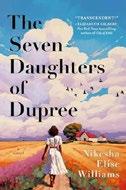
“The South takes from you, and the North can’t save you,” muses one of the matriarchs in Williams’ sprawling, affecting saga of the Dupree family. Weaving together the stories of the complex lives of several generations of Black women from the 1860s to the 2020s, Williams delivers accounts of self-determination, resilience, and resistance in the face of monstrous violence, prejudice, and misogyny. Tati, a Chicago teenager prone to documenting her thoughts in poetry, searches for clues about the identity of her absent father, a man her single mother, Nadia, avoids talking about. Tati’s grandmother, Gladys, carries secrets of her own. When Tati asks about the details of Gladys’ move in the 1950s from the family’s hometown of Land’s End, Alabama, her questions are rebuffed: “Everything don’t need to be remembered,” is Gladys’ shrouded reply. The harrowing, cautionary, and sorrowful stories of prior ancestors Ruby, Jubilee, and Emma are recounted as Williams gradually reveals the history of earlier generations of the Dupree family. The spectral presence of the earliest Dupree daughter, whose identity and life story remain obscured by the passage of time and long-term secrecy, is omnipresent throughout the generations. As Tati continues her investigations into her own heritage, family secrets are sometimes reluctantly shared. Unvarnished descriptions of the atrocities of slavery and racism, as well as their corrosive aftermath, are conveyed directly and brutally. Rising out of the horrors, however, are the strong and unique bonds among the “uppity-ass Dupree women.” (Realistically, not all the bonds are immediately those of
affection.) A beautifully woven motif of Black women caring for each other’s hair as a comfort, livelihood, or sign of closeness runs throughout the book, reinforcing the images of female power.
Williams’ genealogy of pain and survival pulls no punches.
Xander, Iliana | Poisoned Pen (320 pp.) $17.99 paper | December 2, 2025 9781464266539

T hree young women have high hopes of success in New York until their dreams turn to ashes.
One of Natalie Olsen’s two best friends died of cancer. Now she stands at the bedside of the other, Cara, who’s been left in a coma with little brain activity by a super-strong date-rape drug. Cara left a club with a stranger and was found unconscious at a bus stop. Another woman is in the hospital in the same condition, and the police are looking for answers. After Natalie, who knows more than she’s saying, saves a handsome, well-dressed man named Nick from being struck by a passing car on 34th Street, she’s rewarded with an offer of a short-term job she really needs. While having coffee with Nick, she spies a magazine cover with a picture of the man Cara left the club with. The good-looking redhead is Nick’s boss, Geoffrey Rosenberg, cryptocurrency king and CEO of IxResearch, and the job is cleaning at his stunning estate. The position will not only help Natalie financially but give her a chance to spy on Rosenberg, who may have put her friend in a coma. The estate staff are distinctly unfriendly, and there are cameras everywhere and very strict rules, especially about alcohol. Natalie is hired to help at a big party being thrown to celebrate the company’s going public. Despite being in danger every minute, Natalie continues to hunt for clues that will uncover the truth about what happened to Cara. Nothing and nobody are what they seem in this creepy thriller filled with greed, paranoia, and revenge.








Paula Byrne



Gill Hornby


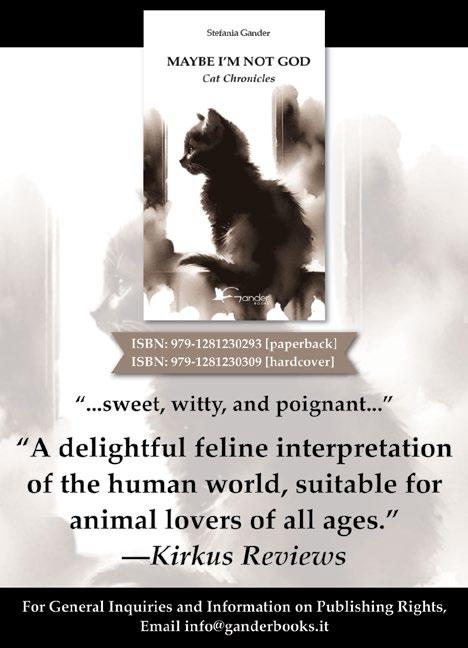
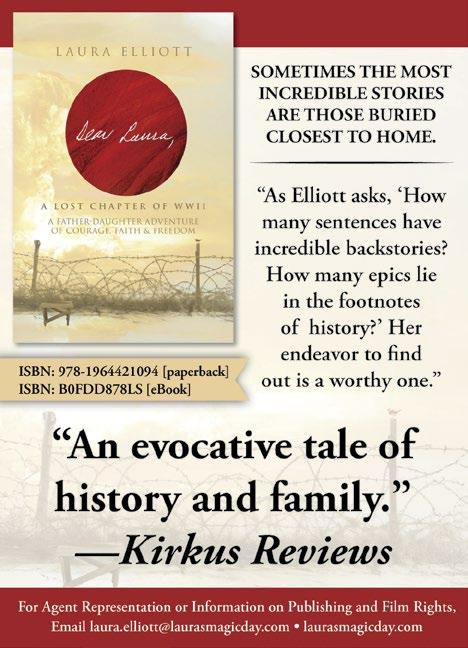
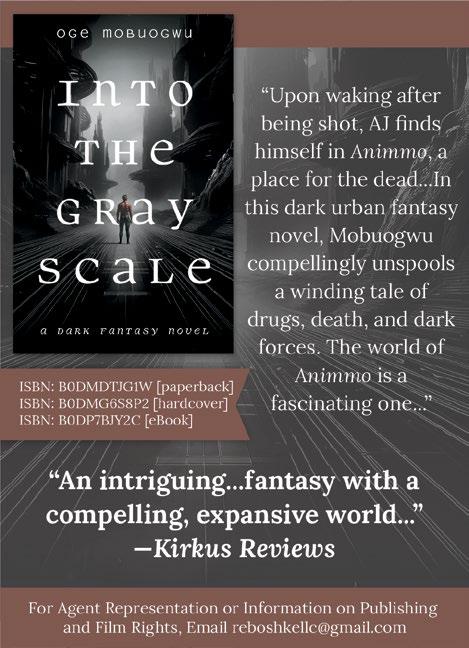

Jason Bateman will direct the film based on John Grisham’s 1997 novel.
Tom Holland is set to star in a film adaptation of John Grisham’s The Partner, reports Deadline Grisham’s novel, published in 1997 by Double -
day, follows Patrick Lanigan, a lawyer who stole $90 million of dirty money from his firm and absconded to Brazil. He’s brought back to Mississippi to stand trial and prepares to expose secrets. In a starred review, a critic for Kirkus wrote, “Grisham comes up with a masterfully bittersweet end…that may be his most satisfying ever.”
Holland, known for his role as Spider-Man in the Marvel Cinematic Universe movies, as well as for movies such as Cherry and Uncharted, will play Lanigan. Jason Bateman, the Arrested Development and Ozark actor, will direct; he previously helmed the
films Bad Words and The Family Fang. The screenplay is written by Graham Moore (The Imitation Game, The Outfit ). Bateman and Grisham are among the film’s executive producers.
Grisham’s books have been adapted for the screen many times before. His blockbuster novel The Firm formed the basis for a 1993 film directed by Sydney Pollack and starring Tom Cruise and Jeanne Tripplehorn, while his debut, A Time to Kill, was

adapted into a 1996 movie directed by Joel Schumacher and starring Sandra Bullock, Samuel L. Jackson, and Matthew McConaughey.
—M.S.


Berry, Connie | Crooked Lane (336 pp.)
$29.99 | December 9, 2025 | 9798892422093

Antiques dealer Kate Hamilton, an American living in a British town called Long Barston, is involved in yet another case of historical murder.
Actually, Kate, who’s married to DCI Tom Mallory, has two, possibly three murders to solve: two in the present, the other from the 14th century. An archeological dig has discovered a woman so well-preserved that the searchers can tell that her eyes were blue. Kate and her colleague, Ivor Tweedy, have been asked to examine the grave goods, including a magnificent pearl, which are being stored at an estate called Ravenswyck Court, on whose grounds they were found. They’re invited to dinner at Finchley Hall, home of Kate’s friend Lady Barbara Finchleyfforde, to meet the archeologists, from the University of East Anglia. Their leader, Dr. Simon Sinclair, is a brilliant backstabber willing to do anything to advance himself. The rest of the team includes Barbara’s adopted niece, Dr. Celia Whybrew; Dr. Niall Nevin; and two Ph.D. candidates, Mark Lambe and Tamzin Oliver. The owner of Ravenswyck Court is wealthy entrepreneur Alex Belcourt, whose wife, Carrie Holgate, disappeared years ago. He hires Kate to discover the truth about Egemere Woman in honor of his beloved wife. The site is picketed by people opposed to disturbing the dead—even though the dig had already been suspended—and everyone is shocked to discover Sinclair lying dead in one of the trenches, apparently murdered. Tom is well aware of his wife’s talents when it comes to murder investigations, but his ambitious new DI, Amy Cartwright, is looking for credit herself. As the police check the alibis of the obvious suspects, Mark Lambe finally gets his wish to investigate a nearby plague pit, where the pregnant corpse of Carrie Holgate is
found. With Tom busy on another case, Kate has her hands full. The modern cases are a treat, and there’s an added bonus of the 14th-century murder.
Cooper, Lettice | Poisoned Pen (320 pp.) | $15.99 paper February 24, 2026 | 9781464253713
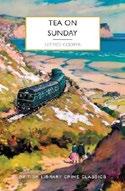
Cooper’s methodically plotted whodunit, her only contribution to the genre, must have already seemed retro when it was first published in 1973. Alberta Mansbridge frequently invites guests to tea on Sunday, but this week is different: She doesn’t answer the door, leaving the elect to wait in the bitter cold outside, because she’s been strangled as she sits at her desk. Although everyone tirelessly insists that everyone else (along of course with themselves) couldn’t possibly have done such a thing, it’s clear that Alberta must have admitted her killer to her securely locked home herself. By and large, then, Chief DI Frank Corby has only eight suspects to consider, some of them obligatory. Anthony Seldon is the nephew who’s stubbornly refused to take his allotted place in the family business, and Lisa Seldon is the teenage model he married. Dr. Ewan Musgrave is Alberta’s physician, Russell Holdsworth her accountant and business manager, John Armistead the veteran managing director of Albert Mansbridge Ltd. Then there are the wild cards. Myra Heseltine had been Alberta’s best friend until they quarreled six months ago and Myra moved out of Alberta’s home (why was she invited back, and why did she accept the invitation?). Sexy industrial designer Marcello Bartolozzi, Alberta’s protégé, was about to move into the apartment Myra vacated. And Barry Slater, an ex-con Alberta had befriended while she was volunteering in prison, is a protégé of a very different stripe. Cooper (1897–1994) plants plenty of red herrings for Corby to dig into, but
the rhythm of his investigation and its anticlimactic big reveal make this latter-day Golden Age puzzle read more like the world’s gentlest procedural. A genuine curiosity that could have been published a century ago or yesterday.
Delany, Vicki | Crooked Lane (304 pp.)
$29.99 | January 6, 2026 | 9798892422116
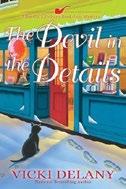
A woman plunges to her death in icy water. Was it accident, suicide, or murder?
English expatriate Gemma Doyle, half-owner of the Sherlock Holmes Bookstore and Emporium at 222 Baker Street, West London, Massachusetts, also has a quarter interest in Mrs. Hudson’s Tea Room with her friend Jayne Wilson. Now that Jayne is about to marry chef Andy Whitehall, owner of the Blue Water Café, everyone’s scrambling to make their wedding perfect. Andy’s throwing a birthday party for Jayne six days before their wedding, but things don’t go as smoothly as he’d hoped. Gemma, who has the keen observational powers of Holmes himself, notices that Jayne’s former boyfriend, waiter Robbie Ellis, is definitely unhappy with the upcoming nuptials. To add to the problems, Andy is at odds with his new sous-chef, Martin, and his former girlfriend, Tina Armstrong, adds to his discomfort when she crashes the party. Going out on the deck overlooking the harbor, Gemma and Jayne notice that the gate to the dock is open and something’s in the water. Jumping into the frigid harbor, Gemma and Andy almost drown in their futile attempt to save Tina. Upon her arrival, Det. Louise Estrada locks everything down until she can investigate what might be a murder. Estrada, the partner of Gemma’s boyfriend, Det. Ryan Ashburton, is no fan of Gemma, who’s been involved in solving far too many murder cases. With the wedding approaching and Andy a primary suspect, Gemma goes into sleuthing mode and
finds plenty of people at the party who might have wanted Tina dead. A delightful mystery with plenty of suspects for the intrepid sleuth to investigate using her distinctive Holmesian methods.
Doherty, Paul | Severn House (224 pp.) $29.99 | January 6, 2026 | 9781448313136

Another cluster of cases for a medieval Sherlock Holmes.
Despite the approach of Easter, life in London, especially in Brother Athelstan’s Southwark parish of St. Erconwald’s, is never free of danger. William the Weaver bursts into the church asking for sanctuary after having killed the Ishmaelite, a moneylender with an evil reputation. Unable to work, the dying William had taken a loan to support his family, and when he couldn’t repay it, the Ishmaelite demanded William’s wife and daughter in his bed, so William stabbed him, seeing it as self-defense. Athelstan has solved many a murder with Sir John Cranston, Lord High Coroner of London, but when William is soon found murdered in the locked church, his death is almost the least of their problems. A member of the Fishmongers’ Guild comes to Athelstan in anguish and confesses that a year ago, he and other guild members raped a handsome young Castilian man they’d hired to dance at a party, who later died of his wounds. In revenge, someone is killing guild members with a crossbow after sending them written warnings. Nor is all well at St. Osyth’s Priory on the Thames outside London, where Sister Veronica, Chaplain John, and a pair of newly arrived twin novices are among those who live a surprisingly pampered life. John of Gaunt, young King Richard’s uncle and the power behind his throne, is interested in St. Osyth’s deep-water inlet, which he uses to unload cargo from Castile. Gaunt is an enemy of the London guilds, which have too much power for his liking, but he still asks Cranston to investigate the murders
and the loss of a great treasure. Most of the tangled plots and murders are related, but where’s the common thread?
A clever sleuth works deep in the heart of a sordid city as the scent of evil rises from every page.
Gilbert, Victoria | Crooked Lane (288 pp.)
$29.99 | January 13, 2026 | 9798892422154
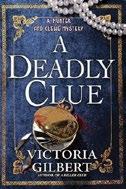
A reclusive millionaire treats his social anxiety by solving murders. Cameron Clewe has every reason to be distrustful of others since his father abandoned him and the rest of the family conspired to keep his true patrimony a secret. But his cold-hearted stepfather did leave him enough money to indulge his two chief interests: collecting books and investigating unsolved crimes. These are interests rather than passions, for Cameron doesn’t have enough energy to be passionate about anything. Even his feelings toward personal assistant Lauren Walker lie dormant, despite the prodding of his personal librarian, motherly Jane Hunter, to please just do something about them. When Jane collects 10 volumes that business tycoon Macnamara Stewart promised to Cam and he finds a note stashed in a copy of My Cousin Rachel from Stewart’s late daughter, Kimberly, who claims that someone’s trying to kill her, Cam’s two interests converge. He agrees to investigate whether Kimberly’s death, supposedly by suicide, was really murder, although his motivation seems more a vague sense of civic virtue than burning curiosity or moral outrage. The problem with writing a hero who’s painfully conflict-averse, of course, is that stories need conflict to propel the narrative forward. When the villains are more interesting than the hero, it’s a problem, even when justice is served in the end.
A whodunit most likely to satisfy readers who like their mayhem really tame.
McDermid, Val | Atlantic Crime (432 pp.) $28 | December 2, 2025 | 9780802164391

T he bones in question actually speak volumes, especially to DCI Karen Pirie, who does her very best to amplify their plea for justice.
Convinced that the original investigation five years ago got it all wrong, New Zealander Drew Jamieson wants Police Scotland’s Historic Cases Unit to look more closely into the death of his brother, hotel manager Tom Jamieson, whose fatal tumble down Edinburgh’s Scotsman Steps was ruled an accident. Using a computer image search, Drew claims to have identified Tom’s killer as dodgy surgical instruments manufacturer Marcus Nicol. At the same time, a mudslide beneath the M73 motorway reveals the skeleton of freelance investigative journalist Sam Nimmo, who vanished more than 10 years ago after the death of Rachel Morrison, his pregnant fiancée. Assumed then to be her killer, Nimmo’s now revealed as another victim. The two cases couldn’t possibly have any connection—until an examination of Nimmo’s research just before his death reveals that he was working on an accusation of bribery at soccer games by professional gamblers and the rape of an anonymous guest shortly after a high-class party thrown by Lord Haig Striven-Douglass in support of Scottish independence. It turns out that Justified Sinners, the secretive monthly men’s book club Nimmo had joined months before his death, had lost two of its members, including Tom Jamieson, to untimely deaths. Calling on experts of every stripe to help identify and pursue new leads, Karen and her team labor to connect the dots as she waits anxiously to hear whether Rafiq, the Syrian refugee physician she’s come to love, can get a Canadian passport to travel to Scotland. None of these plot lines turns out well for the characters. But readers will be rewarded by a richly textured experience.
Kirkus Star
The Murder at World’s End
Montgomery, Ross | Morrow/ HarperCollins (336 pp.) | $30 January 6, 2026 | 9780063458772

A vainglorious viscount is murdered in this 1910-set mystery— Montgomery’s first novel for adults and the launch of the Stockingham & Pike series.
As the novel opens, narrator Stephen Pike, not yet 20 years old and fresh from a two-year stint at a London prison, finds himself in Cornwall at World’s End, taking a job as a second footman at a remote manor house. (So far, so Downton Abbey.) He arrives at a time of high anxiety: Lord Stockingham-Welt has seen to it that the windows of Tithe Hall have been boarded up in anticipation of Comet Halley’s appearance—“This time, it will be the end of the world,” he insists. The comet spares the earth, but the night doesn’t spare the viscount: The next morning, he’s found dead in his study, which was locked from the inside, with an ancestral crossbow’s bolt in his eye. Who better than un-alibied recent inmate Stephen to take the blame for the murder?
To Stephen’s aid comes Miss Decima Stockingham, the viscount’s elderly great-aunt, who makes Downton Abbey’s Violet Crawley seem like an earth mother. A frustrated scientist, Miss Decima hated her late nephew—“Conrad stole my inheritance, my sister, my career… everything”—but she hates Stephen’s victimization more. The book’s ingenious reveal, which hinges on a long-buried Stockingham family secret, is reached through a combination of Miss Decima’s scientific-inquiry-fueled deductions and Stephen’s precocious puzzling (the story features both a hedge maze and a spot-the-difference-style brainteaser). The odd-couple intergenerational sleuthing duo is a welcome new arrival on the historical-mystery scene, with Stephen’s squeamishness about Miss Decima’s filterless fuming a mainstay of the book’s unremitting humor (Stephen: “I’d never
heard language like it…and I’d just spent the last month sharing a bunk with a man called Filthy Mick”).
A paragon of the locked-room historical mystery.
Murrin, Orlando | John Scognamiglio Books/Kensington (320 pp.) | $28 December 16, 2025 | 9781496751973

A chef-turnedfood writer goes on an all-expenses-paid Atlantic cruise only to find himself caught up in the murder of the friend who invited him. Narrator Paul Delamare knows he’s out of his depth from the moment he sets foot on Maldemer, the superyacht his friend Xéra de Sully, a former patisserie owner, has reserved for her post-wedding celebration. A struggling British food writer, Paul suddenly finds himself surrounded by the bride and groom’s high society friends and family who are anything but his kind of people. Paul’s discomfort only grows after he’s wrongfully suspected of stealing an expensive necklace from Xéra’s stateroom. His uneasiness turns to devastation when a cake he bakes to cheer Xéra up gets linked to her sudden death a day after the theft. Seeking justice, Paul makes several chilling discoveries that suggest not all is as it seems aboard the impossibly beautiful Maldemer. The yacht is way off course and heading toward a small volcanic island in the middle of the Atlantic. Worse still, non-British female deckhands he sees get abused by crew members live locked away at the bottom of the ship. Murrin’s deft handling of the many subplots layered into this well-crafted mystery is only part of what makes the story so readable. Quirky characters (like the ship’s eye-patch wearing chef, who
inspires Paul to go back into the kitchen), unexpected twists (like Paul’s email correspondence with a tarot-reading friend whose cards reveal just how dangerous his sleuthing will become), and a small collection of mouthwatering recipes at the end of the book work together to create a unique novel that tantalizes as it entertains. A wickedly delicious mystery spiced with unexpected secrets and intrigue.
Olson, Karen E. | Pegasus Crime (320 pp.) $27.95 | March 3, 2026 | 9798897100545

The second in Olson’s Modern Tudor series, following An Inconvenient Wife (2024), brings his children into Hank Tudor’s messed-up marital history.
Kate Parker had every reason to know what she was getting into when she married billionaire Hank Tudor. Yet his former assistant somehow seems surprised when their wedded bliss turns sour shortly after their honeymoon, much as it did in his five previous marriages. It’s hard to know who exactly is the eponymous woman in this updated version of King Henry VIII’s life. Supposedly strong and self-sufficient Kate comes scurrying back to Hank when he insists he needs her help locating Lizzie, his kidnapped daughter. Nan Tudor, his second wife, has better reasons to come when called: She’s Lizzie’s mother, and the person who contacts her is the kidnapper, not Hank. Still, she spends as much time resenting Hank for forcing her to leave Lizzie in his care as she does searching for her daughter. His fourth wife, doormat Anna, lets Hank walk all over her. And wife number five has already been killed off in Olson’s previous volume. In her author’s note, Olson mentions that people complain either that she stays too
close to Henry’s saga or that she strays too far. Actually, she does both. She includes details that make no story sense just because they happened in history, like Hank’s affair with Jeanne, a stand-in for Jane Seymour. She also invents details that make no historical sense, like Anna’s same-sex marriage to Joan. But the main problem is that none of the wives is a sympathetic figure, and listening to them whine is like hearing Elon Musk’s baby mamas complain about him. Well, duh? A royal mess.
Phillips, Rob | Minotaur (336 pp.) | $28 March 17, 2026 | 9781250385871
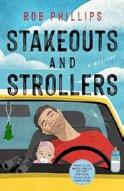
A reporter turned private eye helps a motherless teenager track down her goodfor-nothing dad. Times are tough in the newspaper game. So Charlie Shaw isn’t surprised when the San Francisco Chronicle furloughs him despite his Pulitzer Prize nomination. He’s earned enough street cred walking the crime beat for ex-cop Dwayne Powell to take him on as an investigator at Powell and Associates. Powell starts him out with easy stuff, like snapping shots of wandering wives—assignments tame enough for him to take his six-month-old daughter with him on surveillance. Fortunately, Charlie leaves Callie home when he stakes out Deborah Wellington’s houseboat rendezvous, only to see her much younger paramour beaten to a pulp by a tattooed thug in an Escalade. The complication here is that he’s not the only one watching the attack: 16-year-old Friday Finley is sitting across the road in in her late mom’s 4Runner hoping that Mr. Tats will lead her to Shawn, the father who ghosted her even though he’s the only family she’s got left. New dad Charlie, appalled that a father would leave his daughter in the lurch, not only offers to find Shawn Finley gratis but puts Friday up at his and wife Ryan’s minuscule North Beach home for the duration. Readers who love lost-cause crusaders may admire Charlie’s determination to reunite Friday with Shawn. But
others may wonder, after he ends up staring down gun barrels for three nights running, why a devoted dad like Charlie would risk orphaning his own daughter just to facilitate a reunion that one of the participants definitely doesn’t want.
Fast-paced fun for readers who don’t care if it all makes sense.
Qiu Xiaolong | Severn House (224 pp.)
$29.99 | January 6, 2026 | 9781448317172

History’s darkest episodes cast a long shadow. When Chen Cao, the former Chief Inspector of the Shanghai Police Bureau who now directs the Shanghai Judicial System Reform Office, receives an unexpected phone call from the retired cop known as Old Hunter, he suspects he’ll be asked a favor. And indeed, Old Hunter unspools a romantic yarn involving Mei, nicknamed Shanghai’s Number-One Developer, and Xiaohui, aka X, once a promising student at Shanghai University and now a fortuneteller working on sketchy Red Dust Lane. A flashpoint for this relationship was the Tiananmen Square massacre of 1989. X has disappeared, and Old Hunter asks Chen to investigate; curious by virtue of his own history, Chen agrees. Each installment in this series—whose author, born in Shanghai, now lives in St. Louis—provides a lesson for Western readers on recent Chinese history told through the contemplative eyes of poet and bureaucrat Chen. As Chen ages, the novels include more literature and more nostalgia. Each chapter in Chen’s 14th case documents a day in his search and begins with a pair of poems, one a Chinese classic, hundreds—sometimes thousands—of years old, and one by Chen himself. Illumination ultimately comes through the words of the two former lovers, in print and recording. The mystery of X is also a MacGuffin for Chen’s melancholy reminiscence, stretching all the way back to his childhood during Mao’s Cultural Revolution. Qiu’s title is a nod to a classic Joseph Conrad story about identity, duality, and isolation.
A provocative weave of history and mystery anchored in literature.
Todd, Charles | Mysterious Press (312 pp.) $28.99 | March 10, 2026 | 9781613167236
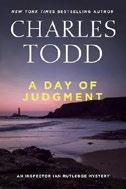
His 1921 promotion doesn’t protect Chief Inspector Ian Rutledge from getting sent to remote Northumberland to investigate a death that doesn’t look all that suspicious. Even after the local coroner has established that boat pilot and chart maker Oswin Dunn was killed by a blunt instrument somewhere far from the beach on Ross Sands where his body washed up, Rutledge realizes that his job isn’t to work out whodunit but to keep the local churches from any hint of scandal. With the failure of Plan A (assure the world that the aging Dunn died a natural death), he’s forced to fall back on Plan B (craft a story about his death that assures the world that his corpse did not float down from the nearby Holy Island). Goaded by both his superior, Chief Supt. Markum, and his familiar, Hamish MacLeod, the soldier he ordered executed for refusing to continue fighting the Great War, Rutledge shuttles between the bare-bones Ship Inn, where he’s staying, and the posh Bamburgh Castle Inn, where there’s a telephone. The discovery that Dunn’s sister, Ilsa, had married traveling German salesman Herman Krüger, before she left the village supplies a motive for Dunn’s murder—hatred of the Hun— that would seem only one of several possible motives if Todd hadn’t gone out of his way to announce it in his prologue. The only question remaining is why Dunn’s disposition and behavior were changed so dramatically by the sinking of HMS Ascot by a German U-boat the day before the 1918 Armistice. And that’s one Rutledge, after examining the evidence, can answer with an authority that would bring satisfaction to anyone but his own tormented soul.
A welcome final revelation suggests that happiness may yet await the troubled hero.
Alban, Emma R. | Avon/HarperCollins
(400 pp.) | $18.99 paper | January 13, 2026
9780063428775

While competing for the same man, two ladies realize they would rather win each other. The 1817 Season is in full swing in Bath, and as yet another ball begins, everything is going just as Lady Rosalie (and her mother) have planned. She looks perfect in her gown and has only two friends left to pair off with suitable men. And of course, she’s nearly engaged herself, to future viscount Mr. Dean, even though she feels no real passion for him. So it’s a shock when the Pine family, new in town, are announced at the ball and immediately begin to unravel their plans. Miss Catherine Pine and her mother seem set on snatching Mr. Dean away from Rosalie, and the women are soon circling each other carefully at one social event after another, intensely looking for opportunities to prove their superiority and eventually admitting to being at war. But Rosalie soon realizes that her strong feelings for Catherine actually remind her of how she felt for her first love, Jane, and Catherine starts to admit that what she feels for Rosalie is closer to what she felt during her first kiss with another girl. As their attentions turn away from their competition and toward each other, it’s easy enough for them to find an opportunity to explore their attraction physically. After all, who could object to two
women taking tea together alone in a parlor? But though their mutual adoration develops into love, society does not offer any pathways toward the future they dream of sharing, and they struggle to find a path forward together. Alban’s latest Sapphic Regency romance, loosely based on Northanger Abbey, is a sweet and spicy enemies-to-lovers story, enhanced by copious details about life in Regency Bath that will forever influence how readers think about what it means to “take [the] waters” there. Alban’s ability to center the blossoming of a romantic relationship without minimizing the importance of friends and family is on full display here, granting the story an extra measure of complexity that heightens the intense connection between Rosalie and Catherine. Their happily-ever-after is perhaps a little too optimistic given the book’s setting, but readers will likely be too charmed to mind. A witty and queer Regency romance full of fun references for Austen fans.
Dent, Lizzy | Putnam (368 pp.) | $19 paper January 6, 2026 | 9798217045204

A Formula 1 team principal has to work with a struggling driver who also happens to be her childhood crush. Chloe Coleman has her work cut out for her as team principal of Arden Racing, the worst team in F1. Not only does she have the monumental task of getting her team back on top, but as one of the first
female team principals, she faces sexism and a lack of respect. Her job becomes even harder when Matt Warner joins the team. Once one of the most promising drivers in the sport, he’s been flailing ever since the fiery crash that severely injured his best friend. But Matt isn’t just another driver to Chloe. He was a close friend to her when they were kids, and she nursed an unrequited crush on him for years—until he ditched her when his career took off. Matt’s trauma and his refusal to talk about it make it hard for Chloe to help him succeed, and they butt heads for a short while—that is, until their chemistry becomes too intense to ignore. They fall into a clandestine love affair quite quickly, ending any “will-they-or-won’t-they” tension. The suspense comes more from their parallel career journeys as Chloe learns to believe in herself and demand respect, while Matt learns to forgive himself and face his fears. Chloe and Matt are both afraid that being honest about their relationship could tank Chloe’s career, provide fodder for the rumor mill, and distract them from their shared goal of transforming Arden into a truly great team. The conflict in their relationship—keeping their love a secret from the prying press—never feels as high-stakes as their career conflicts, but there are enough steamy scenes and hijinks along the way to keep readers entertained. A fun and fast-paced racing romance.
Eden, Lucy | Forever (320 pp.) | $17.99 paper | December 2, 2025 | 9781538756997
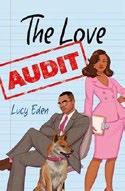
When two workplace rivals compete for the same opportunity, they never imagine they’ll end up in a fake marriage. Jasmine Morgan has gotten to where she is as a PR strategist because she’s good at her job,
and, up until now, there’s been no sign of that changing. However, when she’s given a project involving the revitalization of a small Florida town, it’s made clear that she has competition in the form of her distractingly attractive archnemesis, Derek Carter. What makes the stakes even higher is that the winner of the most successful pitch doesn’t just get bragging rights—they also get to keep their job. As they reluctantly descend on Miller’s Cove together, they’re instantly at odds, but their arrival also attracts attention from the locals, who are suspicious of any outsiders who might be poking into the town’s business. To win their trust, Jasmine agrees to swallow her pride and consent to Derek’s idea that they pose as a pair of blissful newlyweds. It shouldn’t be all that hard to pretend to be in love with her professional rival, especially since she knows how good he looks with his shirt off, but their shared hotel room makes keeping her distance easier said than done. As their investigation into Miller’s Cove intensifies, so does their attraction, until the lines between fake and real start to blur. Eden’s latest contemporary romance has an intriguing premise but is lacking in execution; there’s no real build-up to the fake-marriage arrangement that makes up the bulk of the story, so Jasmine and Derek’s growing romance feels less than earned, especially on the heels of a combative dinner. While the story is full of familiar tropes that could prove appealing for some readers, it also spends too much time with its leads physically separated, when more interactions between Jasmine and Derek would have allowed their romance to develop more deeply on the page. This romance could have used a better PR strategy.

Ferguson, Lana | Berkley (400 pp.) | $19 paper | December 2, 2025 | 9780593953693
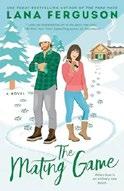
Tess Covington is a talented, successful contractor who just learned that she’s a late-in-life omega wolf shifter. Her new boss, surly innkeeper Hunter Barrett, is an alpha who’s opposed to the remodeling she’s there to do.
Stark, Stacia | Avon/HarperCollins (432 pp.) $32 | December 30, 2025 | 9780063436718

For more romance reviews, visit Kirkus online.
Tess hasn’t made it public that she’s being considered for her own HGTV makeover show, but she runs her career like a well-oiled machine. She posts a lot of her remodels on social media, granting her a certain level of celebrity, and leans on her brothers to help run the business she took over after a stroke made it impossible for her father to keep working. Hunter’s last serious relationship with an omega 10 years ago left him deeply wounded, ending when his parents were killed in a car accident and he moved back home to take care of their lodge— hence his resistance to change. With few exceptions, Tess keeps her newly diagnosed omega status to herself. Unfortunately, as an alpha, Hunter sniffs her out and seems to be the only person capable of helping her with her sudden heats, so there’s a lot of very smutty caretaking. The specificity of omegaverse hierarchy might be new to some readers, but Ferguson’s worldbuilding is quick, easy, and deeply horny. General romance readers might enjoy the grumpy-meets-sunshine and stranded-in-a-snowstorm tropes, although for a book about shifters, the characters spend surprisingly little time in wolf form. There’s not much danger of character development or surprising plot elements here, but for fans excited to read about animalistic mating, that might be enough.
A book that will wolfishly appeal to the most heated fans of omegaverse erotica.
A romantasy mash-up of Crave (2020) and Fourth Wing (2023) from the bestselling author of A Court This Cruel and Lovely (2023). When an undead stranger shows up on Arvelle’s doorstep, he offers her an impossible choice: Agree to kill the emperor, or watch her brother die. The bad news is that the emperor is an ancient and very powerful vampire protected by an elite company of soldiers. The good news is that Arvelle is a champion fighter herself—or at least she used to be. And, left with a choice that is no choice, she sets out for the capital to do the impossible. This is, on the whole, an engaging read. The Rome-inspired setting is interesting, its magic system is well-defined, and the politics of the emperor’s court is a nice complement to the action in the arena. Arvelle is a complex but sympathetic protagonist and Stark surrounds her with characters who also feel real— most importantly, the boy who broke her heart and the emperor’s sadistic son. The pacing is a bit slow at the beginning, but readers who get past the first third of the book will be amply rewarded. Fans who come to romantasy mainly for the love story may be slightly disappointed that the romance elements mostly stay in the background, while other readers may appreciate the emphasis on the action (and, of course, there are more installments to come).
Stark has been building a dedicated following since she self-published Speak of the Demon in 2021, and her Kingdom of Lies series has been huge on TikTok. This author clearly understands the demands of her chosen genre: She knows how to hit the tropes while introducing intriguingly novel details and maintaining suspense.
Epic stakes, palace intrigue, and plenty of magic: Stark’s newest series is off to a solid start.

JOHN McMURTRIE


ARE THERE ANY greater wits than Brits? Tim Curry is just the latest person to prove the point. As evidenced in his new memoir, Vagabond (Grand Central Publishing, October 14), the actor best known for his role in The Rocky Horror Picture Show has not lost his sharpness— despite a 2012 stroke that limited his mobility. The book is not intended to be a “juicy Hollywood tell-all,” he writes. “Not because my moral compass won’t allow it, or because I haven’t had ample run-ins with juicy celebrities—but simply because I find such books immensely dull and highly susceptible to gathering dust.” Furthermore, he notes, “I won’t be dishing out lurid details of my love affairs.… I have loved and been loved and I hope you have, too. But I’m not interested in your romances. And specifics about my affairs of the heart


or the bedroom are— respectfully—none of your fucking business.”
Curry is one of many celebrities who’ve turned to books to explore their lives or tell of pursuits that go beyond their professions.
Fellow actor Nick Offerman is one of them. His latest book, written with Lee Buchanan, is Little Woodchucks: Offerman Workshop’s Guide to Tools and Tomfoolery (Dutton, October 14). Droll as ever, Offerman shares his love of carpentry with aspiring woodworkers. Our review commended Little Woodchucks as “a thoroughly enjoyable book that’ll leave you with a craving to get creative.”
Another actor who has applied her talents to writing is Zosia Mamet, whose debut essay collection is Does This Make Me Funny? (Viking, September 9). Mamet grew popular thanks
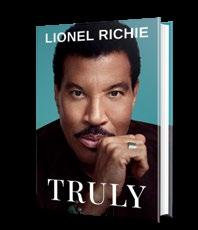

to the HBO series Girls, but she writes of how she fought “fears that I would never make it as an actress.” Our reviewer called the book “funny and moving” with “some of the best descriptions of acting since Al Pacino’s Sonny Boy.”
Geddy Lee, lead vocalist and bassist for Rush, is no stranger to the written word, having penned a bestselling memoir, My Effin’ Life, in 2023. Now he’s back with 72 Stories: From the Baseball Collection of Geddy Lee (Harper/HarperCollins, September 30). When not playing music, Lee has been collecting baseball memorabilia for decades. Our review lauded the book as “an inviting tour of our national pastime, led by a rocker with an infectious love of the game.”
Lionel Richie waited until age 76 to write a book. Not that he’s had much free time: When not touring—and selling more than 100 million
albums—the superstar has been an American Idol judge. His autobiography, Truly: The Official Inspirational Journey Through the Life of a Musical Legend (HarperOne, September 30), earned a starred review that sang its praises as a “wildly entertaining, utterly charming memoir.”
Richie isn’t the only long-beloved performer with a book out. Dolly Parton, with Tom Roland, has written a career retrospective that’s rich in photos. Star of the Show: My Life on Stage (Ten Speed Press, November 11) is, in our reviewer’s opinion, “as cheerful and bighearted as the legend herself.” As the Queen of Country has said, “Everybody’s life is a soap opera. Everybody’s life is a country western song; depends on who’s writing it.”
John McMurtrie is the nonfiction editor.
A wide-ranging writer on his football fixation.
Is our biggest spectator sport “a practical means for understanding American life”? Klosterman thinks so, backing it up with funny, thought-provoking essays about TV coverage, ethical quandaries, and the rules themselves. Yet those who believe it’s a brutal relic of a less enlightened era need only wait, “because football is doomed.” Marshalling his customary blend of learned and low-culture references—Noam Chomsky, meet AC/DC— Klosterman offers an “expository obituary” of a game whose current “monocultural grip” will baffle future generations. He forecasts that economic and social forces—the NFL’s “cultivation of revenue,” changes in
advertising, et al.—will end its cultural centrality. It’s hard to imagine a time when “football stops and no one cares,” but Klosterman cites an instructive precedent. Horse racing was broadly popular a century ago, when horses were more common in daily life. But that’s no longer true, and fandom has plummeted. With youth participation on a similar trajectory, Klosterman foresees a time when fewer people have a personal connection to football, rendering it a “niche” pursuit. Until then, the sport gives us much to consider, with Klosterman as our well-informed guide. Basketball is more “elegant,” but “football is the best television product ever,” its breaks between plays— “the intensity and the nothingness,” à la

Klosterman, Chuck | Penguin Press | 304 pp. $32 | January 20, 2026 | 9780593490648
Sartre—provide thrills and space for reflection or conversation. For its part, the increasing “intellectual density” of the game, particularly for quarterbacks, mirrors a broader culture marked by an “ongoing escalation of corporate and technological control.” Klosterman also has compelling, counterintuitive takes on
football gambling, GOAT debates, and how one major college football coach reminds him of “Laura Ingalls Wilder’s much-loved Little House novels.” A beloved sport’s eventual death spiral has seldom been so entertaining. A smart, rewarding consideration of football’s popularity— and eventual downfall.

What makes us human is our innate ability to put events into sequence, to build suspense.
THE
Good Bones: Glorious Relics From the Age of Reading
Allen, Brooke | Tivoli Books (242 pp.) | $18 paper | November 3, 2025 | 9781966218128

Transitioning into a “postliterate” society.
“The sacred bones of a literary culture [are] being ground into dust by technology and AI and many other distractions,” writes essayist Allen. To help remedy this decay, she offers a set of appreciative essays on canonical European and Anglophone writers, focusing on the personalities of writers and how fictional and historical characters interact to offer lessons in living lives of beauty. Many of her writers—Samuel Butler, Somerset Maugham, Osbert Sitwell, and Ogden Nash, among others—achieved success despite hardship or criticism. “Light verse used to be a vital part of American culture, high and low,” Allen writes in her essay on Nash. Why has Sybille Bedford never escaped her status as “one of the twentieth century’s most attractive literary curiosities?” How can the plays of Horton Foote teach us that “we are all orphans wandering alone through life, and the consolations of community and family are fleeting at best?” The more you read these essays, the more you are convinced that there is something wrong with you: Distracted by modernity, you have lost grace and humor in the face of, writes Allen, “our Robespierrean practice of cancellation.” Most of Allen’s writers remain products of their own time, with their own prejudices and foibles. Can we truly get past Patricia Highsmith’s misanthropy? Can we forget Sitwell’s
politics? Is Truman Capote anything other than the self-caricature he became? Many of these essays originally appeared in venues noted for their highly curated conservatism: the New Criterion, the Wall Street Journal, Christianity Today Published over the past 25 years, they offer a road map to a reader unhappy with the way the world has turned out. A provocative appreciation of neglected writers from a leading critic.
Ashton, Kevin | Harper/HarperCollins (384 pp.) $30 | March 3, 2026 | 9780063438699
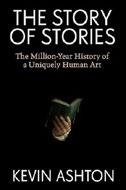
Storytelling: “nature’s solution to the problem of being a highly social, highly intelligent species.”
“Anyone who thinks ‘emotions are what make us human’ has never been welcomed home by a dog.” So writes Ashton, author of How To Fly a Horse: The Secret History of Creation, Invention, and Discovery. But that dog isn’t going to tell you what it did while you were gone. What makes us human is our innate ability to put events into sequence, to develop characters and motivations, and to build suspense and reward attention. From campfire tales and cave art, through epics and portraiture, cuneiform tablets, Renaissance art, telegraphy and smartphones, narrative is everywhere. There is memorable storytelling here, too, for example, on the futuristic sterility of a Chinese silicon chip factory. “Anyone who enters the factory floor must first
walk over sticky, fly-paper-like doormats, wrap themselves in an antistatic coverall made of conductive fibers, seal it with boots, a hood, a pair of goggles, and two pairs of gloves, and pass through a series of air locks, all to protect the factory and its product from the mortal dangers of dust. What lies beyond the air locks is a sterile alien world, bathed in yellow light, that seems as large as an ocean, with walls farther away than the eye can clearly see, almost empty of organic life.” Because the author is an innovator in technology, the payoff of the book lies with a note of caution in an age of digital storytelling: “The new storytelling technologies of our near future will conflate truth and lies and manifest falsehoods in ways beyond anything we have ever experienced….We must become more self-aware, engage in more self-reflection, and feel more doubt and humility than ever before.”
An ambitious celebration of storytelling, with a warning about the delusions of AI and the deceits of social media.
Block, Stefan Merrill | Hanover Square Press (288 pp.) | $30 | January 6, 2026 9781335000989

A childhood in limbo, disfigured by a mother’s trauma.
“Once upon a time, there was a boy. The boy used to have friends, like any other kid. He went to school in the mornings. He lived in a place that was not exactly like any other place. But now the boy is no one, and he lives in a town called Nowheresville.” The child who wrote that story grew up to become a successful novelist; this memoir follows three novels. After the family moved from Indiana, to Plano, Texas, and thanks to newly passed homeschooling laws, Block’s mother decided to pull him out of fourth grade and educate him at home, though little attempt at teaching or learning beyond some math lessons and a deck of
trivia cards was ever made. She professed to believe him a genius who would only be held back by the curriculum of school and who was too sensitive for its social realities. Never imagining how long this might go on or “what those lost years with Mom will become”—and desperate to pull his mother out of her anger and despair following the move—young Stefan assures his principal that he wants this, too. An eerie, brutally lonely horror movie of a childhood ensues, including an episode in which Stefan and his older brother (spared the homeschool option) are forced to crawl instead of walk when they are at home because their mother believes it will improve their handwriting and a protracted attempt to bleach Stefan’s hair back to baby blond using hydrogen peroxide. When Stefan finally demands to go to public high school, he faces obstacles ranging from intractable cystic acne to a suicide epidemic that will claim 19 of his classmates. While fully communicating the absurdity and frustration of his homeschool years, the author withholds judgment of his mother, eventually learning of the life experiences that aggravated what seems to be undiagnosed mental illness. For the lack of regulation of homeschooling that continues to this day, he has harsher words. Like Tara Westover’s Educated, a compelling and horrifying account, leavened with flashes of rueful humor.
“Post-Truth” Present
Boucheron, Patrick | Trans. by Willard Wood Other Press (400 pp.) | $23.99 paper November 4, 2025 | 9781635423754

A French scholar addresses the storytelling—to say nothing of the fabulations—that underlie politics.
Early in this sometimes difficult text, which owes much to fellow Collège de France professor Michel Foucault, Boucheron distinguishes
analytical logic from fiction, noting that whereas the former gives the illusion that the world is logical, the latter “reveals to us the possibilities of thought.” The stories that critique or shore up political discourses, whether, as Boucheron goes on to examine, the films of Charlie Chaplin or medieval art and modern novels, describe “a reality that does not yet exist.” Yet sometimes it does: As Boucheron, a medievalist, writes, numerous monarchs have attempted to legitimate their rule by revealing dreams that placed them in world-changing contexts. One was the English king William II, who, troubled by a dream in which he consumed human flesh, sought the counsel of a priest, who told him boldly and baldly that he had consumed Christ, “and being a tyrant you devoured him whole.” Fictions differ from facts, of course; in a sharp analysis, the author distinguishes lies, which acknowledge that there is an objective truth, from the “bullshit” of Donald Trump and minions: “The bullshitter couldn’t care less about truth and is just looking to dominate.” Boucheron’s text, drawn from a series of lectures, is sometimes repetitive, both allusive and elusive, and often nebulous in a Parisian intellectual sort of way (and never mind that he snaps, “Intellectuals are the first to concede to tyranny because it allows them, basically, to set themselves off from the people”). All the same, in a narrative that wanders from the subversions of medieval epics to the cynical prescriptions of Machiavelli, Boucheron closes with a dour and timely note from Klaus Mann about how power works: “It’s as if people are afflicted with a kind of physical repugnance for the truth.”
A nimble work of political philosophy and history that probes the stories told by tyrants and patriots.

Bourdain, Anthony | Ed. by Kimberly Witherspoon | Ecco/HarperCollins (512 pp.) $35 | October 28, 2025 | 9780062863959

For a review of a book on Project 2025,
An anthology that ranges across both Bourdain’s core writings and his lesser works. Bourdain, notes editor Witherspoon, “had wanted to be a writer all his life.” His fame as the host of several television travel series, she adds, was accidental: The gigs were someone else’s idea, but as long as he got to write, it was fine. Some of the pieces assembled here are near-transcripts from those shows, and longtime fans will hear Bourdain’s voice in every word, as when he eats a street taco in the Mexican city of Puebla: “You quickly shove one of the tacos into your mouth, wash it down with a big pull from a can of cold Tecate—which you’ve previously rubbed with lime and jammed into a plate of salt, encrusting the top—and you can feel your eyes roll up into your head.” Elsewhere, alcohol being a constant, Bourdain celebrates a Sardinian wine made by “an old man sitting in the corner reading a soccer magazine, a cigarette dangling from his lips,” and declaring that he wouldn’t trade a trunkful of big-ticket vintages for the rustic red; offers lessons on how to drink vodka in Russia (“knock back your entire shot in one gulp”); and populates his fictions with woozy, boozy characters (“Naturally, work like this required alcohol”). There are other drugs aplenty as well, befitting Bourdain’s longtime worship of Hunter S. Thompson and the culture of restaurant work in the golden 1970s and ’80s: “We thought ourselves dangerous, trend-settingly debauched, and, of course, in no time at all, had made a serious botch of it all.” But whatever his topic, absent a few forgettable pieces of juvenilia, Bourdain delivers whip-smart, mot juste, and funny pronouncements on the world.
And never mind that he condones putting ketchup on a hamburger. A welcome gathering of work by a writer—and traveler, chef, and truth teller—gone too soon.
Brouws, Jeff | MIT Press (216 pp.) | $39.95 February 17, 2026 | 9780262051750
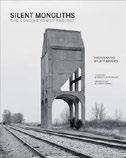
Concrete behemoths haunt rural landscapes. Coaling towers, the subject of this mesmerizing, eerie photo essay, once functioned as coal storage containers for steam engines, hovering high above train tracks, positioned so that trains could pause to receive fuel beneath them. In the early part of the 20th century, newly developed architectural techniques allowed for these towers, previously built from fragile, flammable wood, to be more sturdily crafted out of concrete reinforced with steel. By the 1950s, however, these impressively permanent structures fell into disuse, as diesel trains supplanted coal entirely. Often remotely situated, they were left to age and decay beside farms, amid forests, and on the edges of small towns. Photographer Brouws made an impressive pilgrimage of sorts over the course of five years, traveling around the United States and Canada to capture documentary images of approximately 100 still-standing towers. In “Typology,” the first section of this collection, Brouws focuses his camera on the curious shapes of long-dormant towers. Some resemble grain silos; others look like barns lifted aloft, by turns spindly, portly, and occasionally wildly lopsided, like something built out of blocks by a toddler at play. A second section, “Typographies,” moves the lens out a bit further, placing coaling towers in situ—some still reside, disused, above active train lines; others fade quietly into copses of trees. A few are so awesomely decrepit and odd that they almost seem alive, wobbling like Baba Yaga’s house on
shaky chicken legs. Brouws’ work here is informed by typology theory and the New Topographics movement, which is broadly fascinated with the relics of decaying Americana, but this book also serves, more widely, as a meditative mirror to readers. What happens to what is forgotten? How do we decode what lies in disuse?
A bleak but beautiful observance of past progress.
Brown, David S. | Scribner (496 pp.) | $31 December 2, 2025 | 9781668204191

A study of Theodore Roosevelt that doesn’t shy from the less palatable sides of his views and character. Trustbusting, pugnacious, and convention defying, Roosevelt is held in generally high regard by both scholars and the public, usually ranking fourth in what biographer/historian Brown calls “the parlor game of presidential rankings.”
Like those who edge him out—Washington, Lincoln, and FDR—Roosevelt’s presidency was forged in crises, most economic rather than martial; though he was famed for his service in the Spanish American War, he was prouder of being a peacemaker in bringing the Russo-Japanese War to an end. In that regard, reading between Brown’s lines, it’s easy to see that American racism was enough of an affront to Japanese pride that the later Pacific War would seem almost inevitable; there Roosevelt again tried to be a peacemaker of a kind, attempting to convince the San Francisco school board that segregating Asian students “risked plunging the country into a dangerous international incident.” One of the strong points of Brown’s narrative is that it takes on Roosevelt’s own racism headlong: As the author notes, Roosevelt’s version of Manifest Destiny required the
extermination of “our main opponents,” namely Native Americans, and his presidency was badly tarnished by racial episodes involving Black Americans, with one of his sons posthumously resurrecting a remark by the old man that “the negro…has been kept down as much by lack of intellectual development as by anything else.” There are better books on Roosevelt—David McCullough’s Mornings on Horseback remains essential—and Brown doesn’t break much ground overall. Of value, though, is his likening of Roosevelt to Donald Trump, “who also challenged the country’s democratic norms” and merrily exhibits the egocentricity (albeit much amplified) and self-satisfaction of his predecessor.
Not the first book to turn to on TR, but with points of interest for completists.
Bryant, Howard | Mariner Books (320 pp.) $27.99 | January 20, 2026 | 9780063308169

Groundbreaking heroes, Cold War combatants. With subtlety and insight, respected sportswriter Bryant spotlights Black men who rose to professional preeminence before landing on opposite sides of a political standoff. In 1949, world-renowned stage performer and unabashed socialist Paul Robeson reportedly declared it “unthinkable” for Black Americans to “go to war on behalf of those who have oppressed us for generations” against the more equitable Soviet Union. Robeson might’ve been misquoted, but his apparent comments aided Red Scare opportunists. Soon thereafter, Jackie Robinson, modern Major League Baseball’s first Black player, told the House Un-American Activities Committee that Robeson’s remarks were “silly” and unpatriotic. Bryant astutely
plumbs the meaning of Robinson’s congressional appearance, made “at the behest of Branch Rickey,” his Brooklyn Dodgers boss. Robinson had long been subjected to vile bigotry, “but the United States remained his country,” and its “contradictions gnaw[ed] at him.” Rickey, among a “coterie of anticommunists,” persuaded Robinson “that testifying against Robeson was part of his responsibility.” Criticism from another prominent Black man sped Robeson’s professional ruin, recounted here in poignant detail. The first Black man to play Othello in the U.S. alongside a white cast, Robeson too was a top athlete who pushed to integrate baseball. But after the Robinson contretemps, Robeson’s appearances were targeted by violent racists and his accomplishments removed from reference texts. He spent “his last years in seclusion.” Robinson later “regretted” his Robeson comments, his widow said. This book is a narrative and interpretive triumph. Bryant is excellent at explaining midcentury communism’s appeal to some Black Americans and at viewing his subjects’ actions through the lens of ideas developed by W.E.B. Du Bois. His tightly focused reporting on a sad mid-20th-century episode says plenty about the injustices of the 21st.
A first-rate look at the very public ideological quarrel between Black superstars.
Burstein, Andrew | Bloomsbury (480 pp.)
$32.99 | January 13, 2026 | 9781639737680

Close-up portrait by a noted Jefferson scholar aimed at “advancing historical knowledge without prescriptive politics.” This does not mean excusing Thomas Jefferson’s decades-long involvement with the enslaved Sally Hemings, who bore the first of their seven children when she was still a teenager. Historian Burstein depicts him as typical of his aristocratic Southern
How a “perennial outsider” became “a decisive player in American politics.”
BERNIE FOR BURLINGTON
caste in the ability to compartmentalize, writing eloquently about the dehumanizing effects of slavery while availing himself of its sexual and economic prerogatives. Jefferson performed a similar sleight of hand with Native Americans, asserting his respect for their noble ways as he pursued expansionist policies that drove them off their land. Analyzing Jefferson’s character and behavior, Burstein sees his central dilemma as the conflict between his publicly proclaimed desire for a quiet, private life and his equally powerful drive for power and fame. Jefferson emerges here as controlling, secretive, and vindictive, always ready to make political disagreements personal and rarely inclined to revise opinions even if contradicted by the facts: “His idealism as a theorist might be said to have predisposed him to be a tad insensitive to the real lives of people with whom he had no contact.” It’s not a pretty picture, and little in it is particularly new, though Burstein’s psychological insights are impressively detailed and grounded in valuable historical context. He delves compellingly into Jefferson’s motivations for a variety of incidents: his famous feud as Washington’s secretary of state with Alexander Hamilton (“the better Machiavellian,” in Burstein’s judgment), the Louisiana Purchase during his presidency, and his postpresidential creation of the University of Virginia, “framing a curriculum in which America’s founding principles were taught the ‘right’ way.” Controlling to the last, he left behind a memoir portraying himself as “a reluctant hero” and a three-volume collection of his notes from the 1790s portraying Washington as the “unfortunate pawn” of the hated Hamilton.
A nuanced, warts-and-all examination of a complicated Founding Father.
Chiasson, Dan | Knopf (576 pp.) | $35 February 3, 2026 | 9780593317495

Before Vermonters sent him to the Senate. Neatly blending biography and memoir, Chiasson, an accomplished poet and critic, recalls growing up in a New England city that elected a socialist mayor. Thus began the rise of Bernie Sanders, “the perennial outsider” soon to become “a decisive player in American politics.” The Sanders seen here is at once a singular figure and the emblem of an era. He and his first wife bought 85 acres for $2,500 in 1964, just before Vermont became a hippie magnet. The Brooklyn-raised carpenter and freelance writer shared the newcomers’ antiwar views, but as “a fan of diner food, basketball, and country music, he was a snag in the countercultural fabric.” Sanders lost several elections in the 1970s. Known for “harangues” about tax policy and corporate power, he was viewed “as somewhat cracked,” writes Chiasson, whose boyhood memories add lived-in detail. When Sanders made the rounds in Chiasson’s neighborhood around 1980, his grandfather said, “Don’t open the door—it’s Sanders!” In 1981, Sanders won the first of four two-year terms as Burlington’s mayor. In Chiasson’s colorful chapters about city hall under Sanders, we see him rage at future Vermont Governor Howard Dean (at issue: a bike path) and win unlikely support from police and gun owners. Few political books are this well written. Sanders, speaking to Burlington’s “poor and elderly,” realized that “Vermont was
not any old wilderness: a dense cultural understory, with established political customs and mature social hierarchies, hid in the larkspur.” It’s not clear that Chiasson needed 500-plus pages to tell this story, but his elegant sentences, evocative scene setting (remember 1980s “fern bars”?), and insightful conclusions about Sanders’ “consistency” and durable message far outweigh this charming book’s minor flaws.
An observant, eloquent dual portrait of an uncommon public servant and his adopted home city.
Cooke, Julia | Farrar, Straus and Giroux (448 pp.) $32 | February 24, 2026 | 9780374609788

Women who defied convention. Journalist Cooke recounts the lives of three restless, ambitious female writers: Emily “Mickey” Hahn (1905-1997), Martha Gellhorn (1908-1998), and Rebecca West (18921983). In alternating chapters, she follows their careers, affairs, marriages, family lives, and, most of all, their relentless travels, as they worked to make names for themselves in a male-dominated field. Their lives intersected with one another and other female writers—Hahn became friends with West; Gellhorn with fellow journalist Virginia Cowles; West with Dorothy Thompson—but those relationships could hardly be called a sisterhood. “Competing journalists,” Cooke notes, “wanted to be compared to men, not to one another.” As correspondents for major publications, each
brought a personal perspective to their reporting from Spain, China, war-ravaged Europe, and the U.S. “West,” Cooke writes, “had a thrilling way of layering the historical, personal, legal, and moral into the reported: her observations were so sharp, her style at the very surface of any story. Hahn’s bestselling books, like her reporting, thrummed with curiosity about human relationships: gendered dynamics, sex, friendship, family life. Gellhorn’s elegant sentences trained a reader’s attention, often with an unflinching awareness of injustice, on the people impacted by war.” Domestic life could frustrate them: Gellhorn married and divorced Ernest Hemingway, always straining to go out on her own as a war reporter; she adopted an Italian orphan when she was 41. West had a difficult relationship with her son, the offspring of her affair with H.G. Wells. Hahn advised one of her daughters never to learn to cook or drive a car, lest she be tied down to chores. Each allowed for a “slippery adherence to some feminine norms” while staunchly rejecting those that would quash their determination to succeed. A lively, sympathetic triple biography.
DePalma, Anthony | Morrow/ HarperCollins (272 pp.) | $30 February 3, 2026 | 9780063464391
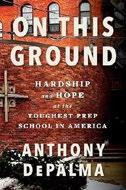
Playing on God’s team. In the summer of 1967, Newark, New Jersey, was beset by violence and arson. Civil unrest forced the city’s premier Catholic high school, St. Benedict’s, to close in 1973,
Three ambitious female writers who defied convention.
but a devoted band of Benedictine monks revived the campus. Over the next 50 years, St. Benedict’s became one of the most demanding and rewarding private high schools in the U.S. DePalma, author of The Cubans: Ordinary Lives in Extraordinary Times, writes that the school has become the pipeline for historically underrepresented urban youth, educating them in mind, body, and spirit. “Second chances remain a hallmark of St. Benedict’s.” “Strict” does not fully convey the toughness and the love that teachers bring to their students. A better word might be “uncompromising,” for there are no gives and takes, no negotiations here. You make it or you don’t. And if you do, you gain not just an education. You gain a soul. Sport is central to the curriculum. Students learn to work as a team. Some of those teams have become the best in the country. “St. Benedict’s doesn’t hold traditional pep rallies. It doesn’t need to.” Some readers may find this book overripe praise for times gone by. “Opening yourself to the divine might seem a remote message to teenagers today,” the author writes. Honor codes script daily life. Indeed, “it is the honor code that keeps locks off all lockers.” And as we follow a group of students through their senior year up to graduation, we may well ask just what the secret sauce is that makes these kids so successful. “St. Benedict’s teaches character and integrity, pushing kids through difficult challenges, and helping them bounce back after failures.” Such nostrums may sound like clichés now. Not everything here translates into every classroom. But for a select few, it has been a blessing.
A love letter to an inner-city Catholic high school, full of praise for faith and rigor.

Donnellan, Aimee | St. Martin’s (320 pp.) $21 | November 18, 2025 | 9781250389060
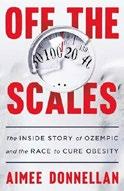
On the race to mint a lucrative weight-loss drug.
Glucagon, a peptide hormone that plays a role in controlling blood sugar, was discovered more than a century ago. Half a century later, working in a laboratory at Rockefeller University, Yugoslavian immigrant Svetlana Mojsov wondered if it might be harnessed to treat diabetes. There were challenges, as Reuters correspondent Donnellan recounts: “She first needed to make it synthetically in a lab. Once she had created the hormone, she could then track down its origins in the body using antibodies, reveal its active form…and prove that it impacted blood sugar. None of this had been done before.” Numerous other scientists were working on related problems, including a ferociously talented team of researchers at Denmark’s Novo Nordisk, which purchased the patent rights to the resulting GLP-1 from one of Mojsov’s colleagues—after which, for years, Mojsov had to fight legally for her share of the patent royalties. She has since been recognized for her work, but the story points to a long-standing truth that women in science have to wage more than just intellectual battles. Meanwhile, the question of glucagon’s workings expanded to an even more lucrative realm: Since obesity is a known cause of type 2 diabetes, why not synthesize the hormone as a weight-loss drug? Thus unfolds the second part of Donnellan’s story, turning from scientific competition to the larger social implications: Better health might yield greater economic productivity, diets might improve (since those who take weight-loss drugs consume less sugar and fat), and health dollars can go to treating other maladies. “The potential ripple effects
of this healthcare revolution are difficult to overstate,” Donnellan comments, and she makes this abundantly clear in her rich, even action-packed narrative of medical discovery.
A tangled plot stuffed with big money, towering egos, and innovative science, capably told and without an ounce of flab.
Doolen, Andy | Johns Hopkins Univ. (392 pp.) $34.95 | December 2, 2025 | 9781421453286

Absorbing life, set in the early republic, of a white man who sided with Native Americans—and lost.
In the early 19th century, a white boy was taken captive by Kickapoo Indians and traded among several local tribes until being adopted by an Osage family. Rather than turn against them, John Dunn Hunter became a strong advocate of Indigenous rights, writing books and articles, visiting Thomas Jefferson at Monticello, traveling to Britain and gaining the support of social reformers William Godwin and Robert Owen. He was nearly unique, historian Doolen writes, in being widely heralded rather than being met with “suspicion, fear, and loathing,” as white people who lived among Native Americans usually were. Yet his influence was limited: The uprooting of the Southeastern tribes was just one episode of the injustices done in his lifetime. It was among one of them, the Cherokees, that Hunter met with disaster; having moved southward from the Indian Territory into Texas, they sent Hunter to Mexico to appeal for a land grant, which never materialized, even though “the new republic of Mexico, badly needing loyalists on the frontier to deter the expansionist ambitions of their sister republic to the north, had made land available for settlement.” Hunter and a faction of Cherokees made
common cause with white Americans who had also settled in Texas to rebel against Mexican rule, which led to betrayal and death. The author describes Hunter’s eventful life in a swiftly moving narrative that has modern implications. As he writes, those Native Americans were not extirpated, against the odds, and their descendants have been effective in legal challenges to redress wrongs done to them. Likening Hunter to the abolitionist John Brown, even though “Hunter could not easily be cast as part of America’s redemption story,” Doolen foresees the possibility of the Cherokees’ being awarded financial reparations for the loss of their Texas holdings.
A skillfully spun tale of a man forgotten by history, whose story deserves to be known.
Drochon, Hugo | Princeton Univ. (264 pp.)
$35 | January 6, 2026 | 9780691181554

A cogent argument that democracies are always ruled by a minority. British political scientist Drochon takes a broad view of democracy and its central paradox: namely, that elites rule democracies, whether the well-educated technocrats of the French government or the populists governing such nations as the U.S. (Donald Trump is a member of the economic elite) and Italy (Georgia Meloni, though claiming outsider status, “has been a member of the Italian political class since 2006”). What keeps those elites from becoming entrenched and immovable is a process that Drochon calls “dynamic democracy,” a constant tension between those in power and those out of power: The putatively populist Trump was preceded by the more or less establishment Barack Obama and Joe Biden. Moreover, democracy is refreshed through social movements that interact with the elites through institutions: “Democracy is achieved when a social movement places enough pressure on the
established elite that a faction of it joins with the rising elite to overthrow the old elite.” The takeaway is both that true democracy is a practical impossibility and that dynamic democracy is “forward-facing,” tending to progressivism. Drochon builds his argument on a synthesis of classical thinkers on elites and democracy, such as Gaetano Mosca, who idealized an “open elite” that admitted deserving members of the lower classes, and Vilfredo Pareto, to whom we owe the term “elite” in the first place and who observed that democracies displaced aristocracies, which “degenerate” and collapse under their own weight. Another theoretician whom the author enlists is C. Wright Mills, who held, presciently, that “the top of the American system of power is much more unified and much more powerful, the bottom is much more fragmented, and in truth, impotent, than is generally supposed”—which explains, at least in part, why the in-power elites in Congress seem so uninterested in what the electorate actually wants. A timely, provocative analysis of the nature of power in supposedly democratic polities.
Dylan, Bob | Simon & Schuster (208 pp.) $45 | November 18, 2025 | 9781668222218

What Dylan saw.
A companion to an exhibition of Dylan’s paintings at London’s Halcyon Gallery, this volume contains 100 of Dylan’s black-andwhite drawings, created from 2021 to 2022, aptly described as quick studies. With texts by television writer and producer Eddie Gorodetsky and writers Jackie Hamilton and Lucy Sante, the images include portraits and landscapes, houses and interiors, cohering into a kind of visual diary. There are train tracks at a crossing, a tree house, cowboy boots, a bridge over the Seine, a street scene in Stockholm, and a man—“Max Moonbeam”—who, according to the
accompanying text, transformed himself from a would-be actor to a weight lifter and classicist. Dylan drew a variety of performers: boxers, a wrestler, a piano player, a puppeteer, and a jazz guitar player, among others. The writers contribute vignettes for some images: “New Kid on the Block” shows a teenager, eager to impress, smoothing Brylcreem into his hair with intent: “His best friend was his comb,” the text reveals, “and he carried it in his back pocket.” Roller skaters embracing each other on the rink inspire a poignant backstory: the woman has been diagnosed with Parkinson’s, yet five years later she and her companion are still skating, just not as often. Some texts read like prose poems. A skeleton key, for example, is “a simple piece of metal that unlocks hearts and souls, unlocks the chambers where mystery resides. It twists and turns, it’s the key to life’s hidden schemes.” A sketch of a nursery with a crib is accompanied by a story of wrenching tragedy. The pencil drawings themselves are energetic, capturing a moment, gesture, or scene with quick, loose lines. A rocker’s drawings reflect an observant eye.
Fancourt, Daisy | Celadon Books (320 pp.) $28.99 | February 3, 2026 | 9781250364531
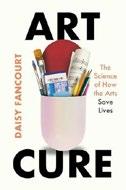
Making art central to living.
In her debut book, awardwinning psychologist and epidemiologist Fancourt makes a strong case for the significance of the arts—“the forgotten fifth pillar of health”—in every aspect of well-being. Drawing on considerable scientific research and her own experiences, she presents evidence that art affects every physiological system: mental health, brain health, movement, stress and pain, healthy behaviors, and longevity. She defines art broadly as encompassing activities such as dancing, singing,
creating art in any medium (including knitting), playing a musical instrument, reading a book, and going to the theater, museums, concerts, or exhibitions. Even 30 to 60 minutes a week engaging in the arts, she advises, can lead to improvements. Throughout the book, Fancourt introduces individuals who serve as striking examples for the benefit of art: a woman diagnosed with multiple mental illnesses who turned her life around after joining a drawing class; a man with dementia whose memory for beloved songs was stimulated by listening to music on headphones; a boy with cerebral palsy whose dexterity improved when he went to magic camp. Besides these compelling anecdotes, the author marshals impressive statistics to support her assertions that the arts can induce happiness, alleviate depression, spur life-affirming behavior, positively affect longevity, bolster the immune system, help define one’s sense of identity, and promote a sense of agency. In each chapter, she suggests ways to create a “personalized arts prescription” to fit one’s particular psychological and physiological needs, ending with a list of 10 practical tips for integrating art into one’s daily life and community. She advocates supporting local artists, initiating community arts groups, and actively campaigning for schools, workplaces, hospitals, and nursing homes to promote arts activities. An inspiring book that’s based on persuasive science.
Feldman, Gayle | Random House (1,072 pp.) $40 | January 13, 2026 | 9781400060276

Engaging biography of the man who was at the center of the American publishing scene— and ubiquitous in many other venues—for half a century.
Benoît Cerf (1898–1971), who changed his name to Bennett, was born into an
entrepreneurial Jewish family and came to publishing after working on the Columbia University newspaper, armed at 21 with a considerable inheritance. He spent some of it acquiring the Modern Library, whose reputation he would build by signing books such as Thomas Mann’s Death in Venice and James Joyce’s Ulysses. It was his determined legal defense of the latter that cleared Joyce’s novel, banned as pornography, for sale in the U.S.—and, as publishing veteran Feldman writes of Cerf and partner Donald Klopfer, “the signal achievement that catapulted them and their infant upstart, Random House, onto the map of America and the world.”
The name was something of a joke, indicating the serendipitous nature of its early publishing program, but Cerf’s intent to become “one of the greatest publishers of the country” was well planned: He championed writers’ careers, essentially promising the likes of Ted Geisel, aka Dr. Seuss, that he’d “take everything he wrote, for adults or kids,” and publishing a string of sometimes difficult greats: Stein, Faulkner, Auden, Ellison, Michener, Capote, Angelou, Welty—the list goes on. At the same time, he made his own outside reputation as the author of often groan-worthy joke books, a newspaper columnist, a friend of Hollywood’s jet set (his wife’s first cousin was Ginger Rogers), and a frequent television presence on, among other shows, What’s My Line? All fitted the nature of a man who called himself “an awful ham.” As Feldman chronicles, even though Cerf’s many extracurricular pursuits may have impressed some publishing purists as unseemly, they all helped sell books, from paperback bodice rippers to the most august literature. A well-crafted life of a publisher whose world spanned culture high and low, and whose influence endures.

Let the Poets Govern: A Declaration of Freedom Felix, Camonghne | One World/Random House (192 pp.) | $26 | March 3, 2026 9780593242148

The power of the poetic.
A poet, speechwriter, educator, political organizer, and activist, Felix melds memoir, history, and political critique to argue for the significance of poetry “to mark the design of the world we see and the world we desire to conjure.” As a student at DeWitt Clinton High School in the Bronx, Felix was an incorrigible rebel. “The American education system,” she decided, “is the first place where the imagination of the oppressor is made material in the life of the subordinate.” She found a more congenial learning community at Urban Word NYC, where practicing poets taught poetic structure: “I lapped it up like a thirsty animal,” she writes, “letting it fill me.” But her connection to poetry was subsumed by political work as a speechwriter and press secretary for New York Governor Andrew Cuomo and a speechwriter for Elizabeth Warren. Both left her frustrated; disillusioned, she returned to poetry. “The poet witnesses our ignorance and tells us about the material and spiritual power of language, that which shapes our reality,” she asserts. “The poet tells us the truest stories about who we are.” Among the poems that Felix includes in this volume are “erasure poems” formed by redacting legal documents, such as the South Carolina Slave Code of 1740, the No Child Left Behind Act, and Executive Order No.
147: A Special Prosecutor to Investigate and Prosecute Matters Relating to the Deaths of Civilians Caused by Law Enforcement Officers. What surfaces after the redaction are stark indictments of racism and oppression. Felix sees poetry as consistent with activism, inspiring a response and eliciting action. “It is not the poem that changes the world,” she writes, “but the poem that changes the person.” The poem “is always political.”
An impassioned manifesto.
Ford, Clyde W. | Amistad/HarperCollins (352 pp.) | $29.99 | January 13, 2026 9780063309814

A reexamination of popular notions and legends affords a deeper appreciation of the history of Black people in America.
Ford, a prolific novelist and nonfiction author, has written extensively on the African American experience from different angles. This book is more like a collection of essays than a straightforward chronological narrative, though the chapters move roughly from the appearance of the first Africans in Virginia in 1619 to the passage of the Civil Rights Act in 1965. Along the way, Ford explores more or less familiar stories, elucidating subjects that include, for example, the matrilineal line (and mysterious sexuality) of post-Revolutionary Black polymath Benjamin Banneker;
For more biographies, visit Kirkus online.
“It is not the poem that changes the world, but the poem that changes the person.”
How “a simple rumor” could lead to dozens of executions.
THE GREAT RESISTANCE
the uncredited influence of Islam on slave culture, courtesy of highly educated West Africans among the early enslaved population, about a third of whom were Muslim; the real story behind Juneteenth, when the federal government cracked down on recalcitrant slave owners in Texas, forcing them to honor the surrender of the Confederacy and the passage of the 13th, 14th, and 15th Amendments. A gifted and erudite storyteller, Ford illuminates connections running through the centuries until the “Black Freedom Struggle,” as he prefers to call what is better known as the Civil Rights Movement—the genius, courage, and strength of an unjustly oppressed people with an acute awareness of the world around them and a hunger to make things right. With powers working to censor the ugly truths of the history of race relations in the United States, Ford has given us an important book about that history that will benefit any reader. A thought-provoking chronicle that speaks to our times.
Britain’s
Foster, Ann | Hanover Square Press (320 pp.) | $32.99 | February 10, 2026 9781335000637
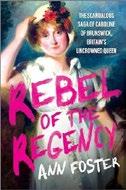
A defiant royal. Making her book debut, Foster, host of the Vulgar History podcast, offers a chatty, gossipy biography of Caroline of Brunswick (1768-1821), the unhappy wife of George IV and, briefly, queen of Britain. When Caroline accepted a marriage proposal from the
eldest son of George III, she looked forward to escaping her overprotective family. For his part, George, known as Prinny, agreed to marry so that Parliament would pay his mounting debts. He cared nothing about Caroline, since he already was secretly married to a commoner. Overweight, hard-drinking, and beset by health problems, Prinny was hardly a dream husband. He turned up drunk at their first meeting and was drunk at the wedding that elevated Caroline to princess of Wales. Nine months later, she gave birth to a daughter; she and Prinny lived apart thereafter, and she was barred from seeing her child. Mired in court intrigue, Caroline engaged in behavior—fostering wards, living abroad, allegedly taking lovers—that caused some to deem her insane. Prinny hated her, and in 1811, when he became regent after his father became too ill to reign, he banned Caroline and his daughter—both popular among the public—from his court. His efforts to divorce Caroline— intensifying after George III died, making her queen—only served to increase her popularity, as did decades of economic hardship that incited hatred of the self-indulgent Prinny and his gilded court. Foster contextualizes Caroline’s life within roiling political and social change, but she blunders in trying to make her relatable by comparing her to pop culture figures, such as Taylor Swift, Britney Spears, and “the wildest members of Bravo’s Real Housewives franchise.” Caroline was colorful enough in her own time to not need updating. An eventful life, told with enthusiasm.

Gibson, Carrie | Atlantic Monthly (624 pp.) $35 | January 6, 2026 | 9780802165497

For more history books, visit Kirkus online.
A broad-based history of rebellion, escape, and agitation in the name of abolition in the slaveholding Americas. Writes historian Gibson, resistance against slavery “was built into the system as it evolved, even after the slave trade spread up and down the [West African] coast.” Although a long-popular image is that of subdued villagers sadly but compliantly accepting their fate, Gibson notes that armed Africans set upon the caravels of the first enslavers with fleets of canoes, firmly believing, as one Portuguese captain was told, that “we Christians ate human flesh, and that we only bought negroes to eat them.” In a sense they were correct. In the European colonies of the Americas, the enslaved had almost no chance of ever returning home, as their cultures were consumed and their families broken apart. So it went for 400 years, from those first Portuguese slave ships all the way down to the final emancipation in late-19thcentury Brazil. Gibson writes of the communities of the formerly enslaved, freed by manumission or escape, in the remote jungles and badlands of the colonies, noting in passing numerous ironies and curiosities—for one, that Haitian revolutionary leader Toussaint Louverture owned or rented enslaved people himself, and for another, that Black enlistees in the British army, having run away from the Southern plantations to which they were bound, were among the troops that burned the White House in the War of 1812. Gibson mixes little-explored episodes with better-known stories such as Denmark Vesey’s conspiracy, swirling around “a simple rumor [that] could alert a militia and cause 35 necks to snap in a matter of weeks.” Throughout, as does Sudhir Hazareesingh in his
contemporaneous and more fluently told study Daring To Be Free, Gibson insists on the primacy of the enslaved themselves as agents of their own liberation, “the true instigators of liberty.”
A solid contribution to the literature of the New World slave trade.
Hazzard, Kevin | Grand Central Publishing (336 pp.) | $30 | March 3, 2026 | 9780306835186
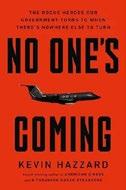
Defying death during an epidemic.
In this inspiring, cinematic book, a daring American aviation firm rescues seriously ill medical workers in West Africa. The author, a former paramedic, is well matched with the subject. He skillfully builds dramatic tension, though a handful of scenes read like extracts from a punched-up screenplay. In 2014, Phoenix Air, a Georgia-based outfit that hauls unusually sensitive cargo—“dynamite, warheads, smallpox”—was tasked with getting Ebola-infected American medical professionals back home from Liberia. As Hazzard relates in a very specific rundown of the symptoms, the disease is excruciating and highly communicable. We see handy Phoenix staffers outfit a jet with a bespoke biocontainment unit and secure approval from “a dozen federal agencies.” We witness the mission’s impact on those involved; online dating is tricky when your name is linked with a disease that leaves patients “gushing” bodily fluids. Hazzard makes policy debates interesting. Traditionally, American doctors sickened abroad were treated where they fell ill. But “treat-inplace” wasn’t popular with physicians, inspiring the Centers for Disease Control and Prevention to work with Phoenix. Less compellingly, Hazzard picks low-hanging fruit—jingoistic tweets and apocalyptic posts in newspaper comments sections—to demonstrate that the
“audacious plan” to effectively “import Ebola” was controversial. The author describes one of the book’s main sources, a Phoenix executive he met several years after the Ebola flights, as “a world-class salesman” and “a P.T. Barnum for our age.” So it’s not surprising that some of the proceedings have an oft-told, just-so quality. In Hollywood-ready scenes, real-life characters are ultracool, with pithy quotes at the ready, when facing extraordinarily daunting challenges and panicky government functionaries. These overly polished anecdotes don’t help a generally solid record of real-life heroism. A stirring account of the dauntless ingenuity that saved lives during an infectious disease outbreak.
Aided the French Resistance in World War II
Henderson, Bruce | Gallery Books/ Simon & Schuster (336 pp.) | $30 November 11, 2025 | 9781668051412

Valor and sacrifice in the skies over Europe. Hollywood loves the French resistance; military historians not so much, but journalist Henderson, author of Hero
Found: The Greatest POW Escape of the Vietnam War, has an eye for wartime derring-do. By the time the U.S. entered World War II, British Prime Minister Winston Churchill, a far more hands-on leader than Franklin D. Roosevelt, was already an enthusiastic supporter of the resistance, which had begun slowly after the 1940 French defeat, expanded after Hitler’s June 1941 invasion of Russia, but received its greatest boost in 1943 when thousands of guerrilla bands (the Maquis) fled to the country to evade a law requiring all able-bodied Frenchmen to work in Germany. Throughout 1942 and 1943, Britain’s secret service flew planes over France, dropping supplies and agents. The U.S. was slow to get involved
but late in 1943 began accepting volunteer crews from one of its largest bombers, the B-24, to undertake these dangerous, nighttime missions. From early 1944, individual planes would take off after dark, fly hundreds of miles, a task requiring superb navigation, and watch for a flashing light signal from the ground before dropping their load. By 1944, French resistance was organized and active in conducting intelligence and sabotage, tasks that peaked with the Normandy landings in June but continued until the war’s end. The author does not ignore the ongoing debate over whether this was an efficient use of Allied military resources, but mostly he describes the missions. There are biographies of individual fliers, French resisters, and agents dropped along with the supplies. A minority were women. Successful missions—60% to 70% succeeded—receive their due, but more pages describe those that weren’t, so there is a steady stream of mishaps, crashes, dramatic escapes, individual tragedies, and heroics. Not an untold story, but Henderson is a pro, so readers are in good hands.
Jennings, Scott | Morrow/HarperCollins (288 pp.) | $27.99 | November 18, 2025 9780063472174
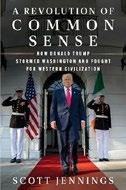
A hagiographic celebration of “Trump 2.0.” CNN commentator and sometime political operative Jennings allows that Donald Trump has his rough edges, but he’s quick to explain them away: “We didn’t hire a barbarian to sing soprano in the choir; we hired him to beat back the savages.” The savages, naturally, aren’t the folks who stormed the Capitol on January 6, 2021, the ones whom Trump pardoned in the first days of his second term. No, you won’t

The comedian and actor is best known for his 1989-1994 late-night talk show.
Aresenio Hall will tell the story of his life and career in a memoir, People magazine reports.
Atria/Black Privilege will publish the entertainer’s Arsenio: A Memoir next spring. In the book, the publisher says, Hall “reveals the ups and downs of his remarkable career as a trailblazing pioneer with this behind-the-scenes, star-studded, no-holdsbarred memoir of celebrity, race, and show business.”

For more celebrity memoirs, visit Kirkus online.
Hall worked as a stand-up comedian and actor before launching The Arsenio Hall Show in 1989. The syndicated late-night talk show became a pop culture phenomenon, drawing guests such as Eddie Murphy, Paula Abdul, and Bill Clinton. Clinton, at the time governor of Arkansas and a presidential candidate, memorably wore sunglasses and played a rendition of “Heartbreak Hotel” on saxophone.
The show was canceled in 1994 and brought back to the air in 2013, running for less than a year. Since then, Hall has appeared in films including Coming 2 America and television series such as The Mayor and All About the Washingtons
“This bracingly candid memoir offers a new appreciation for this raw talent and gifted storyteller, who nightly, for six years, hosted what felt like a televised ‘party’ that changed the landscape of late-night television and brought Black culture into living rooms across America,” says Atria/Black Privilege.
Arsenio is slated for publication on April 7, 2026.—M.S.





Neurologist Masud Husain won the Royal Society’s award for Our Brains, Our Selves.
Neurologist Masud Husain has won the 2025 Royal Society Trivedi Science Book Prize, given annually to a book of popular science writing, for Our Brains, Our Selves: What a Neurologist’s Patients Taught Him About the Brain. Husain’s book, published in February by Canongate, explores how people’s identities are influenced by brain functions, as revealed through the stories of seven of his patients.
Sandra Knapp, the chair of judges for the prize, said in a statement, “With Our Brain, Our Selves, Masud Husain has written something that is both scientifically rigorous and deeply engaging, which is no small feat. This book is a beautiful exploration of how problems in the brain can cause people to lose their sense of self,

such that they become unrecognizable to loved ones or at times rejected by a society to which they felt they belonged. All this is skilfully interwoven with Husain’s personal story of moving to the U.K. as an immigrant in the 1960s, where he found himself grappling with his own sense of belonging.”
The Trivedi Science Book Prize, which comes with a cash award of 25,000 British pounds (about $33,600), was established by the U.K. scientific academy the Royal Society in 1988. Previous winners include Jared Diamond for Guns, Germs, and Steel: The Fates of Human Societies; Gaia Vince for Adventures in the Anthropocene: A Journey to the Heart of the Planet We Made; and Ed Yong for An Immense World: How Animal Senses Reveal the Hidden Realms Around Us.

—M.S.

For more books of popular science, visit Kirkus online.




Christina MacSweeney
Elie Honig
David Margolick
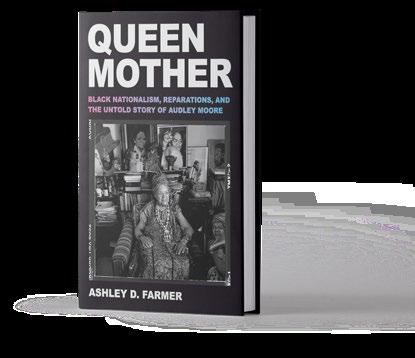



hear about January 6 here, aside from a somewhat sheepish allowance that Trump suffered a tad, politically, before regaining his massive popularity (numbers underplayed, of course, by a villainous mainstream media). The savages in question are the putative enemies of Western civilization, the radical leftists who demand that boys be allowed to play girls’ sports and that people be treated equally. Borrowing a term from Trump himself, Jennings deems this “common sense,” though one has to wonder where lies the common sense in that pardon, among other recent moments. For Jennings, though, Trump seemingly can do no wrong: He’s saving the country by, for instance, “renaming the Gulf of Mexico as the Gulf of America and changing Denali back to Mount McKinley,” matters that, he suggests, Americans care deeply about. (Now, about the cost of those eggs…) He’s bought into every narrative: The president has plenary power (“the White House is the boss of every federal employee”), Trump is a master of comedy (as when, for instance, he quipped that “nobody has ever heard of” the African nation of Lesotho), and all Democrats are required to believe “that MS-13 gang members living in the US illegally must be protected at all costs” or risk being canceled. Oh, and Defense Secretary Pete Hegseth is “affable and knowledgeable, far beyond the caricature painted of him in the mainstream press.”
A tedious exercise in bending the knee.
Kraus, Daniel | Counterpoint (320 pp.) $28 | March 10, 2026 | 9781640097155
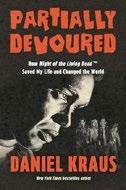
An obsessed fan of a pioneering zombie film explores its creation, fan lore, and deeper meanings.
Kraus, author of this lively, conversational study of the 1968 horror classic Night of
How much does he love the classic horror movie? He’s seen it 300 times.
PARTIALLY DEVOURED
the Living Dead , has the proper bona fides for such a project: An accomplished horror and thriller author, he completed a couple of unfinished fiction projects by Dead director George A. Romero, including 2020’s The Living Dead. But perhaps more importantly, he’s a Dead superfan, estimating he’s seen the film 300 times. And as the book shows, he’s drawn plenty of insights from the film and its legacy. Walking through the movie minute by minute, he discusses the offbeat backgrounds of each actor (prospective female lead Betty Aberlin worked on Mr. Rogers’ Neighborhood ); the clever efficiencies Romero used to deliver the film on a budget, particularly the public-domain sound effects; and the peculiarities of the script, which have plenty to say about racism, herd mentality, and sexism. Kraus, who seems to have experienced every film, comic, video game, and T-shirt relating to the film, can be obsessively detailed in his observations: What kind of radio is reporting that humans are being “partially devoured” by zombies? What’s that book on the farmhouse shelf? Still, his storytelling isn’t off-puttingly geeky or fixated on fans-only details. That’s partly because he’s so personable, weaving Dead details into his own history as a teenage filmmaker, writer, and horror fan. But mainly he’s persuasive about the idea that the film is not just a horror classic but a passkey through America’s darkest instincts, from the MLK assassination to the January 6, 2021, insurrection. (A digression on the troubling case of Kyle Rittenhouse is particularly inspired.) “The film is America,” he writes. “Can we even call what we are doing living? Or are we long dead and only going through the zombie motions?” A sage take on a low-budget classic.
Lachi with Tim Vandehey | Tiny Reparations (352 pp.) | $30 January 27, 2026 | 9780593851579
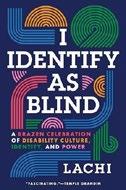
A musician/activist offers 10 personal essays that explore her life as a blindidentified woman. Lachi knew early on that she wanted to be a singer. But because she had no low-vision Black female role models, she kept her dreams to herself, vowing instead to forge an identity “out of thin air, pure grit, and a touch of golden wit.” Then, in 2016, the year she seemed poised for a breakthrough in the music world, she went from being “blindish” to legally blind. Lachi leaned into the adaptability and resilience a blind identity afforded her and stepped into the self-loving, celebratory “Yaaas Queen Energy” that has fueled her success as an activist, musician, and entrepreneur. Rather than succumb to stigma, she made visual disability her superpower. That mindset in turn gave her the boldness to found RAMPD, a platform for amplifying disability culture in the music industry, and launch a successful line of “cute-ass Glam Canes” that “tell the blind and cane-using communities ‘You are worth being seen and feeling sophisticated.’” The author’s intersecting identities— blind, female, and Black—also allowed her to better understand a disability community/movement that tended to privilege and showcase disabled white (male) people and adopt a more allencompassing disability justice framework to think about disability
rights. Within that context, disabled people “rocking the most marginalized identities are the ones most impacted by systemic ableism.” That she lost what vision she did have at a young age made her more sensitive to the fact that “we’re all likely to transition into having a full-time disability one day, temporarily or permanently, because of injury, illness, or good old Father Time.” Lively, wise, and candid, this book offers profoundly necessary insights into the complexities— and joys—of living with disability. A provocative invitation to rethink what it means to be disabled.
Lassiter, Jonathan Mathias | Legacy Lit/ Hachette (320 pp.) | $30 | November 4, 2025 9780306833052
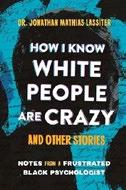
A disgruntled psychologist reviews the impact of racism on his life.
In a prologue, clinical psychologist Lassiter, who defines himself on multiple occasions throughout the book as a “Black, same-gender-loving man with a chronic illness,” deplores the fact that Black men make up fewer than 1% of the psychologists in the United States. He establishes a definition of “whiteness mindset,” which “privileges white ways of understanding the world and concentrating power among white people,” as opposed to “the mindset, originating among the peoples of East Africa, southern Africa, and the Nile Valley regions,” that highlights “a harmonious relationship with the Earth, resources, and other human beings.” He then proceeds, moving systematically through his life from childhood on, to blame whiteness mindset for pretty much everything that has gone less than perfectly in his life. His (Black) father is unhappy that Lassiter is gay? Whiteness mindset. He didn’t get the position for which he thinks he did an “amazing job”
at the interview and which went instead to a “fair-skinned Latina”? Whiteness mindset. Lassiter’s targets are legion, but one of the most frequent is the “nice white women” who, he says, “make up 55 percent of the psychologist profession.” “I hate niceness,” he says. “Nice people are fake.” The memoir does make some valuable points: Certainly many people seeking help from psychologists would benefit from being able to work with a Black male psychologist, or a gay psychologist, or a psychologist familiar with the impact of sickle cell disease. And it’s impossible to dispute that Lassiter’s professional and personal life has been impacted by racism. But the continual and frustratingly vague evocation of “whiteness mindset” reduces a complex experience to jargon.
A potentially intriguing memoir flattened by bombast.
Lynch, Marc | Oxford Univ. (272 pp.) | $34.99 December 1, 2025 | 9780197827857

A scathing critique of American policy in a volatile part of the world made so, at least in part, by that very policy.
Lynch, a specialist in international affairs, writes sharply of what he calls America’s “morally and strategically catastrophic policy” in the Middle East, premised on support for autocrats in a region whose burgeoning and mostly young population is “bursting with frustrated talent and boundless potential that neither needs nor wants America to provide order.” Those people are, of course, the ones whom the autocratic regimes labor to suppress, and American policy, Lynch says, assists those regimes in the clampdown. The worst turn, by the author’s account, was the invasion of Iraq in 2003, a “performative war”—in the words of political scientist Ahsan Butt—that had every possibility of furthering democratization in the region
but instead shored up a policy marked by a long tradition of bullying. Lynch quotes pundit Jonah Goldberg: “Every ten years or so, the United States needs to pick up some small crappy little country and throw it against the wall, just to show the world we mean business.” Iran, our current bête noire, offers greater challenges. Lynch observes that most of America’s good works in the Middle East—food aid, peace negotiations—are responses to its own bad acts, from uncritical support of Israel to the penchant for propping up “friendly dictators.” Surprisingly, the author suggests that one step toward rebalancing the political order in the Middle East would be to allow Iran to develop nuclear weapons; such proliferation would spread to Saudi Arabia and other powers and have “one key effect: it would reduce or eliminate the dependence of the Gulf states on the United States for security and survival.” While that suggestion is eminently debatable, Lynch’s evenhanded argument for remaking American policy in the Middle East is well taken. A convincing case for a more equitable approach to power relations in a fraught region.
MacDonald, Keza | Knopf (304 pp.) | $32 February 3, 2026 | 9780593802687
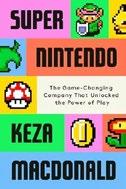
A deep dive into the game company that gave us Mario, the Wii, and Covidera comfort. Though most commonly associated with video games like Super Mario Bros. and The Legend of Zelda, the Japanese firm Nintendo has a history that stretches back to the 1890s, when the company specialized in card games. As MacDonald, games editor at the Guardian , explains in this study of the company’s history, Nintendo has eschewed the high-res innovations of
its competitors and instead focuses on creating a sense of play and family friendliness. It enjoyed early successes in the ’80s with the arcade game Donkey Kong but truly exploded when it got into the console business and introduced plumbers Mario and Luigi. (Their iconic mustaches and overalls, MacDonald notes, were less style choices than workarounds with the limits of rendering humans in 8-bit environments.) The book is structured around chapters dedicated to particular games rather than eras or consoles, which has its virtues. Nintendo classics like Pokemon, The Legend of Zelda, and Wii Sports each demonstrate a variation on the company’s philosophy of play; Animal Crossing, a cozy game that was deeply embraced during the early months of Covid, is especially well treated here. But a structure focused on particular games and their multiple variants seems to give MacDonald license to occasionally get in the weeds about gameplay and fan chatter. (An appendix ranks her 50 favorite Nintendo games.) And because Nintendo can be famously tight-lipped about its financials, the book lacks broader context around the gaming industry. Still, MacDonald digs up some insights from designers and enthusiasts, and if the book generally shades toward corporate hagiography, it chronicles a company that has time and again delivered games that have enchanted millions.
Gaming history written with a fan’s verve, for better and worse.
Markee, Patrick | Melville House (352 pp.)
$31.99 | December 2, 2025 | 9781685891671

A distinguished New York advocate for homeless people examines how modern homelessness is both “an antecedent and symptom” of a New Gilded Age. Researchers too often dismiss homelessness as a social problem that
will “always be with us.” But the truth is far more complex. Drawing on historical analysis, policy research, and his own experiences working with homeless people, Markee argues that modern mass homelessness is an offshoot of the neoliberal agenda that has overtaken American politics. He begins by suggesting that the current “New Gilded Age” era mirrors the original Gilded Age’s extreme inequalities. Taking New York as his starting point, Markee examines the relationship between urban homelessness to economic crises like the Panic of 1873 and the Great Depression. Both led to dispossession, especially among those already made vulnerable by race or class, but it was not until the recession of the 1970s—and the brutal policies of austerity that defined it—that the modern phenomenon of mass homelessness emerged. Yet the problem was never linked to systemic/policy failures that resulted in, for example, the loss of affordable housing or the deinstitutionalization of the mentally ill. Rather, blame was laid on homeless people themselves, who were categorized as a blight on urban spaces and demonized as criminals. From New York, mass homelessness spread to other cities across the United States during the 1980s as a pro-capitalist Reagan administration laid the foundation for Trumpian “oligarchical ethnonationalism.” Despite the current dominance of neoliberalism, Markee holds out hope that more compassionate policies—like laws ensuring the right to shelter—can return incrementally through continued social activism that remembers the sacrifices of homeless people Markee memorializes by name throughout the book. A humane study that advocates for a necessary reclamation of human dignity.

McDermid, Val | Atlantic Monthly (160 pp.)
$22 | January 6, 2026 | 9780802167811

Silent snow. Scottish crime novelist McDermid is best known for her uncompromisingly realistic “Tartan Noir” detective stories, featuring the down and out, the violent, and the vain. But pick up this book, and you’d never know it. This is a sweet, reflective memoir on the cold season in Scotland. McDermid remembers “guising,” a kind of proto-Halloween tradition of dressing up in late October. She recalls Guy Fawkes Day bonfires. She luxuriates in the warmth of Christmas hearths. Edinburgh itself becomes a personality: “a city addicted to the crash, bang, wallop that goes with the heavenly glamour cascading down Castle Rock from the Esplanade to the gardens below. The city doesn’t confine itself to 5 November nor does it wait for winter—on every night of the Edinburgh Military Tattoo during the festival month of August the sound of fireworks reverberates through the city centre.” There is an easy domesticity to the reflections here. “Winter means soup,” and in paragraphs of recipes and memories of meals, McDermid writes a story of her own creative life. Writing is like cooking. As her Scottish mother says, “There isnae a recipe” for soup. “More a rummage.” And so, we rummage through her childhood, as each holiday and farm and street corner go deep into the stockpot, simmered until they blend into a heady literary broth. Illustrated with charming woodcuts, with just over a hundred pages of large type, the book is a warm bowl, fit for an hour by the fire. Readers of McDermid’s fiction may miss the blood and anger of crime. Instead, here, you can almost hear the carolers amid the snow and pan across the quiet fields. An endearing panorama of Scottish winters, told by a crime novelist on holiday from horror.
Kirkus Star
Mendenhall, Emily | Univ. of California (264 pp.)
$28.95 | January 6, 2026 | 9780520421523

A medical anthropologist at Georgetown University examines the fraught relationship between those who suffer from disabling chronic conditions and the American medical establishment.
Invisible illnesses like endometriosis, Lyme disease, and long Covid typically present as a constellation of vague, sometimes intermittent symptoms that include pain, chronic fatigue, and brain fog. As different as these conditions are from each other, they are also similar in how misunderstood they are in the medical community. Drawing on cultural history and interviews with scientists, policymakers, and activists (many of whom suffer from chronic conditions), Mendenhall argues for transforming the health care system by recognizing the experiences of complex patients as “legitimate sources of knowledge.” A large part of the problem comes from the fact that complex patients and doctors “speak different languages” and do not understand each other. Patients may feel unseen by clinicians who lean into authoritative discourse and a “one size fits all” approach to diagnosis, while clinicians may not fully comprehend the patient’s (often very individualized) experiences. In discussing endometriosis, for example, the author shows how female complaints get labeled—and ultimately dismissed—as functional neurological disorder (FND), an updated version of the Hippocratic notion of hysteria or “wandering uterus” syndrome. She argues that symptoms for this and other chronic ailments must be considered in context of what she terms a patient’s “bodymind,” since body and mind, along with the patient’s environment, are “deeply integrated.” Only then can the
Artificial intelligence will affect nearly everything, often without us realizing it.
HOW
chronically ill begin to more successfully navigate their conditions and remake their lives in more substantive ways. Elegantly written and rigorously researched, Mendenhall’s book offers a much-need challenge to a monolithic health care system to respond in more humane and holistic ways to the suffering of those facing complicated, long-term health issues.
An incisive study that illuminates the myriad complexities of chronic illness.
Mims, Christopher | Crown Currency (256 pp.) $31 | January 27, 2026 | 9798217086184

An examination beneath the hood of artificial intelligence and an elaboration of its applications, misconceptions, and history. How to sift through the AI hype? How can AI be so effective yet still have flaws and hallucinate? How can you use AI to become more productive? Where is the AI field headed? These are the major questions that Mims, a technology columnist for the Wall Street Journal, explores with an expertise that is not only accessible, but entertaining and profound. In enlightening reflections on 24 AI laws, Mims takes us on a winding journey through the inner workings of AI and its topical use cases, with historical breaks along the way, each chapter ending with summaries and definitions. Whether you are a consistent user of AI (or what Mims prefers to call “simulated intelligence”) or are new to the field, he skillfully balances
catering to both camps, warning the reader of impending technicalities. The author shares examples that include a lawyer turning to AI in a deposition, Clorox’s marketing team relying on AI to generate advertisements, and scientists using AI in their research. Mims moves masterfully across great swaths of human knowledge with curiosity and competency (and is sometimes comedic: “Neuroscience is a pretty shit way to try to understand the human mind”). At the end of this technological foray, Mims concludes that AI is a tool and an assistant that will affect nearly everything, often without us realizing it, to the same degree as the internet. For anyone looking to be on the cutting edge of technology, from understanding AI to improving their lives with it, this book is a must-read.
A significant and pioneering survey of artificial intelligence that is as engaging as it is useful.
Murphy, Kate | Celadon Books (320 pp.) $28 | January 27, 2026 | 9781250352453

Exploring “the most consequential social dynamic most people have never heard of.” Synchrony is the alignment of your body and mind with an external source. Through new technologies, this phenomenon is only recently being studied by scientists. You can “click” or experience synchrony with just about anything: people, nature, animals, fictional or famous characters, and even inanimate
objects like cars, planes, and boats. Murphy, author of You’re Not Listening, presents an overview of the field of synchrony, along with a plethora of examples of mysterious human connections—whether it is the ways we connect with our pets or the story of psychiatrist Hans Berger, inventor of electroencephalography, falling off a horse and his sister sensing a disaster. Synchrony, writes Murphy, is “a natural wonder that is far from fully understood. Some researchers suspect it may be an amplification or elaboration of so-called quantum entanglement—a phenomenon Albert Einstein famously called ‘spooky action at a distance’—where interacting subatomic particles begin to behave as one, even when separated in time and space.” Although the writing is smooth and accessible, the author’s theme is spread too thin and feels more speculative than scientific. From a 2022 TikTok video of a woman accepting a sandwich, to generosity at a Dairy Queen drive-through, to lawyers acting out psychodramas, the colorful variety begs the question: Isn’t everything synchrony? Is texting an emoji really “trying to compensate for the missing facial expression and body language that humans rely on to find resonance?” That all being said, the last chapter’s analysis of our current epidemic of loneliness (and its causes) is compelling and concerning (warning: tech companies are hiring neuroscientists to make us click more deeply with their digital content), the examples and quotes throughout are frequently insightful (even if, like many psychological studies, a reiteration of common sense), and what the book lacks in rigor and cohesiveness, the author makes up for with her enthusiastic vibe. An often obvious but diverting jaunt through the nature of human connection.
Nadler, Steven | Princeton Univ. (272 pp.)
$29.95 | April 7, 2026 | 9780691285238
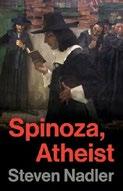
Live and love well. The 17th-century Dutch Jewish philosopher Baruch Spinoza developed a theory of ethical behavior without the presence of a judging God. He rejected notions of a deity with a personality, human-seeming, who intrudes on the everyday life of creation. He denied the divine origin of scripture (claiming that it was a human-written, literary text). He thought miracles a fantasy. And yet, he hated being called an “atheist.” Atheists, he claimed, were those who thought of God as if God were a person, with judgments, grudges, and motives. Instead, Spinoza imagined a unique supreme being, the worship of whom “consist[s] only in justice and loving-kindness.” As Nadler, a University of Wisconsin–Madison professor, summarizes it: “True religion…does not demand any particular conception of God, or even any belief in God whatsoever, much less empty rituals and ceremonies. True religion consists only in the ethical behavior of loving one’s fellow human beings and treating them with justice and charity.” Benign though these views may seem, they did not sit well with Spinoza’s contemporaries. He was excommunicated from the Jewish congregation, vilified by zealous Christians, mocked by fellow intellectuals, and hounded out of town by his neighbors. Much of the subtlety and ambiguity in Spinoza’s writings was missed by his contemporaries, but much is illuminated in this clear, unpolemical, and judiciously written book. The text is not an argument for atheism in a
Vilified, mocked by fellow intellectuals, and hounded out of town by neighbors.
SPINOZA, ATHEIST
one-dimensional, denying sense. It is an argument for living a virtuous life on life’s terms. Even his most virulent critics found in Spinoza’s works “fine maxims on the duties of an honorable man.” In a time like ours, when honorable men are in short supply, Spinoza goads us into finding virtue in ourselves.
A magisterially clear introduction to Spinoza’s arguments for living virtuously without the need of a judging God.
Newman, Brooke N. | Mariner Books (464 pp.) $32.50 | January 27, 2026 | 9780063290976
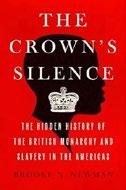
Royals profited handsomely from slavery, says this account. Historian Newman, author of A Dark Inheritance: Blood, Race, and Sex in Colonial Jamaica, opens in 1558, when Elizabeth I assumed the throne of a nation with an empty treasury and an economy dwarfed by three European empires: France, Spain, and Portugal. The queen did well, although Newman points out unsettling details. Spain and Portugal fiercely defended trade monopolies over gold, silver, and agricultural products from Africa. Slavery was harder to defend because some Africans had no objection to selling members of other tribes, and English traders often simply raided coastal towns and kidnapped their inhabitants. Elizabeth encouraged this semi-piratical behavior, often loaning navy vessels and always insisting on a percentage of the take. Profits continued under successors James I and Charles I, who encouraged settlements throughout North America. The first major colony at Jamestown was a catastrophe before settlers discovered that tobacco farming was profitable. Growing tobacco is grueling; hired or indentured labor proved unsatisfactory, so growers quickly tapped into the thriving African
slave trade. All 13 colonies possessed slaves until early in the 19th century, although most went to southern states to grow tobacco and later cotton. As Britain’s monarchs lost power after upheavals in 1640 and 1688—especially power to levy taxes—their involvement with slavery increased because they needed money. Beginning with Charles II (reigned 1660-1685) and ending with George IV (Britain abolished slavery in 1834), they used their remaining authority to grant monopolies; accepted cash, stock, and honors from slavers who hoped for favors; and used influence with Parliament and rival monarchs to line their pockets. Readers may grow tired of gnashing their teeth, since every monarch acted shamefully and the author herself discovers disgraceful racism in the traditional heroes of abolition, but it’s an engrossing tale. An account of powerful people behaving badly that’s hard to resist.
Newsham, Gavin | Diversion Books (320 pp.) $29.99 | March 17, 2026 | 9798895150948
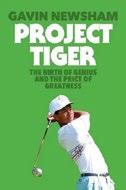
A father grooms his son for golfing success. Newsham, co-founder of Golf Punk magazine, wants readers to understand how Tiger Woods’ “strange, dysfunctional, and stage-managed childhood” affected him. The author starts by telling the story of Woods’ father, Earl, and the racism he experienced. “Project Tiger” began when the 10-month-old toddler hit balls with his tiny putter. In October 1978, Tiger, not quite 3, was on The Mike Douglas Show. With his parents’ encouragement, he was becoming a “cold-blooded golf assassin.” In 1987, he beat his father for the first time. Earl Woods focused on his son’s mental toughness as they both fought against racism. They even suffered it at Earl’s home course, the Navy Club. As Tiger
won more tournaments across the country, his bravado grew, Newsham writes. Pitches from college golf coaches poured in. When he got an invitation to play in the Los Angeles Open, the course got numerous racist calls. Newsham writes that father and son often showed “disrespect” to the young man’s opponents. Earl began fielding calls from management companies, including prestigious IMG, which hired him as a scout for a hefty salary. Tiger was the first African American to win the U.S. Amateur Championship. At Stanford, he was still getting racist taunts. Tida, his mother, was getting tired of her husband’s bragging and “exploitation of their son’s vulnerability.” The more success Tiger had, the “more entitled—and bombastic—Earl Woods appeared to become.” Tida honed the private Tiger. He had a “ruthlessness on the golf course [that] had been hardwired into him.” His marriage ended in divorce, and severe injuries from a car crash damaged his game. Tiger’s collapse “wasn’t just shocking but, in many ways, predictable, given the childhood he missed out on, his father’s behavior, and the entitlement he felt as the world’s greatest golfer.”
A searing indictment of Tiger Woods’ father.
Kirkus Star
Nganang, Patrice | Farrar, Straus and Giroux (464 pp.) | $32 | January 20, 2026 9780374614515

The noted Cameroonian novelist recounts a “happy childhood” in a tumultuous era. In whole or part, Cameroon, in West Africa, was alternately ruled by the French, Germans, and British, so, Nganang writes in the opening pages, his hometown of Youandé is “the only African city that has a German name with French accent aigu.” The tension among the colonizing powers expresses
itself materially when Nganang decides to become a “scale boy,” weighing people on the street, and has to choose between a French and a German brand of scale. He chooses the German—in a touching moment toward the close of the narrative, one of his sisters finds the same model and gives it to him as a remembrance— and sets to work. It seemed for a time as if that make-do job was destiny, the natural course of events in an impoverished nation ruled by a dictator. Nganang, strong-willed and disciplined, had already rejected work with better prospects, apprenticing in a mechanic’s shop staffed by Chadian refugees fleeing civil war at home, subject to the prejudice of Cameroonians who, though of many ethnicities, always had room to disdain outsiders as they “metonymically blemished their ethnic group in general for the deeds of one.” Nganang’s happy childhood turns out to have had its Dickensian moments (“When I made a mistake at home, Papa would slap me…. When the mistake was more than grave…he would ask me to go and select the whip he would use to flog me”), but it provided him with a fine education in the ways of the world that informed his writing early on and steered him toward his life as a storyteller, of which he writes, “From my three mothers, I have the conviction that great literature is gossip mixed up with philosophy.”
An elegant, closely observed memoir of challenges overcome on the path to becoming a writer.
Nguyen, C. Thi | Penguin Press (368 pp.) $32 | January 13, 2026 | 9780593655658
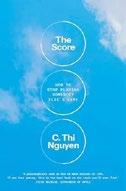
A philosophical theory of games and what it means to win them. Nguyen, a professor at the University of Utah, opens with a challenging question: “Is this the game you really want to be
playing?” The question inspires two accounts of how scorekeeping enters into play. One involves rock climbing, which, a friend tells him, has a guiding ethos: “Man, you gotta just savor the movement.” The second is a very different kind of game, the publication of academic works and the scoring system that is used to indicate the prestige of the journals in which they appear, as well as the influence they exert on the field. That scoring system encourages scholars to keep their heads low and their work narrowly focused on “fairly arcane technical questions,” a game that Nguyen, by necessity, bought into, setting his big-picture, wild-haired philosophical concerns aside. We all have choices, of course, and when it comes to such scorekeeping, Nguyen holds: We can either subvert and modify the rules or be “captured” by them, either play the game in order to play the game or play it in order to win by criteria not of our own making, what Nguyen calls “striving play,” in which there’s a gulf between goal (victory) and purpose (fun). Scoring systems constrain us, while, by the author’s account, a game properly designed provides the liberatory scaffolding for players to create new selves: “Games are an art form that works in the medium of agency itself.” Though largely jargon-free, Nguyen’s narrative can sometimes be heady to the point of headachy, but he’s also delightfully irreverent, as when he lampoons “a certain kind of gamer asshole” who lives in a zero-sum world and has to win every time—and who, as a result, is “just evil.”
An engaging look at the games we play and whatever freedom we might have as we do so.
Pinto, Maria | Univ. of North Carolina (240 pp.) $23 paper | October 28, 2025 | 9781469689791

C ommon mushrooms provide a springboard for wideranging essays.
In her first book, avid amateur mycologist Pinto, a “neurodivergent, naturalized US citizen from the Caribbean, and a descendent of enslaved people,” weaves her personal history and infectious affection for the “understudied kingdom” of fungi into nine essays that anchor themselves in the specifics of a particular type of mushroom before bouncing off to consider topics such as the aftermath of forest fires, psychedelic experiences, Haitian zombies, the impulse toward suicide, and the complicated ethics of foraging. Based in Boston, Pinto does much of her mushroom hunting in the Northeast, as when she heads with a friend to New Hampshire to seek out “sharp and spicy” matsutake mushrooms, with their “wonderful wee domes, like someone has just poured au jus over a perfectly poached goose egg.” But she also ventures further afield, as when she investigates the farming of black winter truffles, with their odors of “garlic, motor oil, soy sauce, wine, and acetone” in the Virginia Piedmont. Pinto isn’t afraid to let a dark, and darkly humorous, side show, as when she recounts with relish the horrifying speech about the effects of
When “album-oriented rock”—or “AOR”—ruled the airwaves.
deadly mushrooms that she gives to her mushroom tour groups, or when she describes a zombie ant, possessed by a fungus, “mycelium made ambulatory,” in the process of becoming “a fungal sculpture, bursting cottony at the seams.”
But her essays also fizz with gratitude and sensual pleasure: “The study of mushrooms taught me to see plenty, abundance, and potential where I’d been taught there was none.” Even the most mycophobic would have a hard time reading her essays without falling a little in love with her alternately forbidding and thrilling subjects.
This delectably provocative fungal sampling gives the reader much to savor.
Rees, Paul | Da Capo (528 pp.) | $30 February 24, 2026 | 9780306836046

An oral history of the hard-todefine, easy-tolove rock music genre. You might not have heard the term “album-oriented rock,” or “AOR,” but you know the music when you hear it. The genre that ruled the airwaves in the late 1970s and most of the ’80s, AOR was marked by melodic, hard-edged rock with high production values: Think Journey, Heart, or Kansas, and imagine you’re driving down the highway on a hot summer night, and you’re on the right track. Music journalist Rees tells the story of the genre’s ascendancy, which at the time “was as much the reigning soundtrack of Middle America as country music is today.” Rees credits the beginnings of AOR—originally a radio-industry term of art—to Boston’s self-titled 1976 debut album and its smash-hit lead single, “More Than a Feeling.” Its success led to hits from other bands, including REO Speedwagon, Styx, and Toto, which delighted listeners but rankled critics: As Dennis DeYoung of Styx said, “The fact of the matter is,
Foreigner, like all of those bands in the ’70s, were immediately dismissed by people in the rock press. Because they had the audacity to write memorable songs that people liked.” MTV debuted in 1981 and maybe led to the genre’s eventual decline: Rees flags Billy Squier’s so-badit’s-just-really-bad 1984 video for “Rock Me Tonite” as a canary in the coal mine for the genre, which lost its appeal to mainstream listeners who ended up turning to country. Rees does a great job compiling quotes and anecdotes drawn from interviews with musicians, producers, and journalists; it’s a tightly edited oral history that manages to be both informative and entertaining. He also makes a good case that the genre never disappeared but rather “seeped back into the mainstream” and “ingrained itself into the fabric of American music.” This is a deeply fun look at music that might have lacked hipster cachet but, for a period of time, defined a nation. A treat for 1970s and ’80s rock fans who never stopped believin’.
Robb, Graham | Norton (416 pp.) | $34.99 January 20, 2026 | 9781324074946

A discursive and epoch-jumping account of Britain’s identity and history.
Imagine that a well-read uncle pulls you aside after dinner and says that he has something fascinating to show you in his cluttered office. For hours, he lectures you on old maps, revised history, and personal anecdotes from his travels. This hypothetical uncle could be Robb, the author of The Discovery of France, who takes the reader, in his new book, on a haphazard tour through Britain’s history, from the earliest proto-villages to the present day. If you are passionate about the lost details of history and the historian’s dilemma of capturing the elusive, distorted past, you may find Robb’s enthusiasm and nitty-gritty
perspective infectious. In preparing the reader for his creative endeavor, the author writes, “No creature or nation lives in chronological order, and so there would be room for the surprising contractions, dilations and reversals of time.” The project’s conception, in its refusal of standard storytelling or historical chronicling, has merit. But some readers will likely find the contracting and dilating approach— interrupted by descriptions of landscapes and explanations of boundaries—to be wearisome. The author shares personal memories that include a nightmare his mother once had, a childhood neighbor’s view, an old book in red leather being passed down by a line of ancient aunts, his father leaving a note for an assistant, his school being older than Eton, and finding an issue of National Geographic in his uncle’s garden shed that reported the discovery of Pluto. The overflow of personal detail—and jokes that often don’t hit—overshadows the narrative thread. A tedious tale that oscillates between reminiscences and historical facts.
Scorsese, Martin with Antonio Spadaro Grand Central Publishing (144 pp.) | $29 November 4, 2025 | 9781538775387
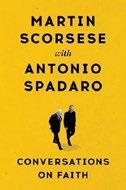
One of America’s greatest directors discusses his faith. Few directors since Robert Bresson and Ingmar Bergman have made as many films that grapple with questions of faith as Martin Scorsese. In many of his movies, he has explored the topics of grace and redemption and the ethical quandaries faced by conflicted protagonists. Beginning in 2016, Spadaro, an Italian Jesuit priest, paid many visits to New York to talk with Scorsese about faith, a common thread “that accompanies me through the maze of life and explores a lifelong preoccupation of Martin’s that is present in all of his work.” Over these seven conversations,
they discuss everything from Scorsese’s asthma-plagued childhood in Queens and Little Italy, where he found comfort in the nearby Catholic school “because the streets were so rough” and where a 23-year-old priest who loved cinema was such a positive influence on the young Scorsese that he briefly considered entering the clergy, to his legendary directing career. These wide-ranging chats cover many topics, including the reason Scorsese incorporates violence into almost every film—“We have to face it in order to understand that it’s within our human nature”—and his appreciation for directors like the Dardenne brothers, who “don’t look away from ugliness or the tough aspects of life around them, but the possibility of redemption is always there for their characters.” Most of this book is devoted to The Last Temptation of Christ and Silence, the Scorsese films that most overtly address questions of faith. It’s all fascinating stuff for cinephiles, especially those interested in the intersection of motion pictures and spirituality. Along the way, Scorsese offers insights into the realities of filmmaking, as when he says he had to shoot Silence in Taiwan because it was cheaper than Japan, where the story is set, and had to contend with “earthquakes, typhoons, and the Taiwanese cobra—apparently, they were in season, which people kept from me.” Keen observations on faith from a cinema maestro.
Shea, Neil | Ecco/HarperCollins (240 pp.) $28 | December 2, 2025 | 9780063138575

In the Arctic, “cold is freedom.” What will happen when it warms? National Geographic writer Shea has traveled throughout the far north and illuminates it with an emphasis on climate change.
He concentrates on lands from northern Canada to Norway, which are warming three or four times more rapidly than temperate regions. The heat is destroying the Arctic cryosphere—sea ice, snow, permafrost, weather patterns, and ocean currents that bind this world together. Like the U.S., Canada has more or less gotten its act together and no longer treats its Indigenous people as less than human, but this doesn’t include protecting them from modern life. Today, hardly any Inuit keeps a dog team or travels by dogsled. Largely self-governing, they live in houses, hunt with rifles, and prefer snowmobiles. Hunting and fishing remain a preoccupation, a beloved tradition but also essential for food. Traveling far south to obtain medical and dental care is a hardship, and a major irritation remains the lack of cell phone reception. Already inhabited by Inuit cultures, Greenland was settled by Vikings during the 10th century; by the 15th century, the Vikings had vanished, perhaps the result of a cooling climate. The author explores the reasons for their disappearance, an ongoing national archeological obsession, before returning his focus to climate change. Greenland, 80% of which is covered with ice, is the only nation with no temperate zone and no worries about overheating. Melting ice will free large areas for farming and mining, and many Greenlanders are looking forward to it. Moving on to northern Norway at the Russian border, Shea recounts vast changes in the two nations’ relations since World War II, an entertaining conclusion despite the absence of information on climate change. A fascinating, if grim, portrait of a region that’s getting less cold.
Slimak, Ludovic | Trans. by Andrew Brown Polity (210 pp.) | $29.95 | November 18, 2025 9781509569588

A French paleoanthropologist muses over the extinction of a species.
Working in western France, Slimak, author of The Naked Neanderthal: A New Understanding of the Human Creature, discovered that a group of Homo sapiens had taken up residence in a Neanderthal cave 54,000 years ago and remained for 40 years. Neanderthals themselves did not vanish for another 12,000 years, according to the latest evidence. Also present were innumerable sapiens’ flint points, similar to those thousands of miles to the east, revealing that early sapiens already followed ancient, widespread cultural traditions. The points could only have been useful in arrows, so archery was found in sites 40,000 years older than its supposed invention. On the site are remains of an ancient Neanderthal, whom the author and his team name Thorin (after “one of the last dwarf kings under the mountain” in J.R.R. Tolkien’s The Hobbit). A few scattered teeth and bone fragments provide the first evidence of contact between sapiens and Neanderthals—so precious that his team spends seven years employing only tweezers to precisely tease out each particle and preserve its context. By the book’s midpoint, it becomes clear that the site illustrates contacts between sapiens and Neanderthals before they went their separate ways. This makes it a
Greenland: the only nation with no temperate zone and no worries of overheating.
major finding. The author concludes that three waves of sapiens arrived in Europe over 12,000 years, which contradicts previous descriptions, and he elaborates on his hypothesis in details that will flummox readers not familiar with academic anthropological scholarship. The book’s second half defends his findings but emphasizes that no natural law governs the behavior of human societies, and thinkers who disagreed (Marx, Rousseau) are mostly known for being wrong. Readers searching for the details of human evolution should consult Ian Tattersall or Yuval Noah Harari. Slimak describes important findings, but his focus on their implications owes perhaps too much to his nation’s literary deconstructionists. Archeological theory for Francophiles.
Snorton, C. Riley & Darius Bost Beacon Press (232 pp.) | $28.95 January 20, 2026 | 9780807008553

A historical appreciation of queer Black culture and how it shaped American history. Professors and gender studies authorities Snorton and Bost collaborate on this survey of the rich, vibrant, and overlooked queer Black culture in the U.S. across a century. Their book spotlights dramatic defining moments in queer Black history and the pioneers and radicals who spearheaded and shaped their own paths as American blackness was becoming redefined. The authors explore how gender and sexual stereotypes of Black people during American colonization “confined them to a condition of racial inferiority and sexual non-normativity.” Reinforcing their arguments about the struggle of Black leaders to achieve visibility and viability during racial segregation and how coming out of the “racial closet” has resulted in greater marginalization, Snorton and Bost highlight queer Black activists and artists whose legacies precede them. Among them
are filmmaker Marlon Riggs, author James Baldwin, dancer Josephine Baker, Harlem Renaissance poet Countee Cullen, New York City DJ Frankie Knuckles, and scholar-activist Angela Davis, whose sexuality informed her community visibility and artistic contributions. Also included is a profile of defiant and outspoken Black drag queen Joan Jett Blakk, whose two presidential campaigns attempted to transform mainstream American politics, alongside a wide range of Black queer and transgender artists and performers whose contributions to their artistic genres made indelible imprints on American society and the greater entertainment community at large. Expanding across transgender protests of the 1960s, the Stonewall rebellion, and the post–civil rights and Black Power eras into marriage equality and the Black Lives Matter movement, the book elaborates on how these efforts have left Black queer and transgender people “on the margins of the LGBTQ movement.” Despite current waves of anti-queer and anti-transgender violence and historic (and current) efforts across generations to repress queer culture, the essential and underappreciated demographic of queer Black Americans perseveres and sustains. As interdisciplinary scholars, the authors believe that the honorable presentation of reminders and remembrances ensures a distinct and dynamic future for Black queer culture. An illuminating and innovative Black American queer history lesson.
Stubb, Alexander | Columbia Global Reports (216 pp.) | $17.99 paper January 13, 2026 | 9781967190102

Finland’s president forecasts a reordering of the world’s power relations.
“Power is changing hands— between the US and China, and into the hands of mid-size nations,” writes Stubb, a political scientist by
training. The U.S. may diminish through Trumpian isolationism, though it will remain a strong military power; China’s continuing emergence as a superpower may be hampered by economic stagnation. Meanwhile, Stubb contends, the Global South, with nations such as India and Brazil in the forefront, waits and watches—and increasingly demands a place at the diplomatic table. One index of the Global South’s stance, by Stubb’s account, is its reaction to Russia’s invasion of Ukraine, most of its constituent countries not hastening to take sides: “The reason was not indifference but dissociation—a sentiment that this is ‘your war, not ours.’” The Global South’s and Global East’s economic growth may eclipse that of the Global West, thanks to such things as protectionism and because the rest of the world is “tired of Western lectures on human rights and of global geopolitical considerations taking precedence over their national concerns.” Insisting, provocatively, that capitalism is failing in providing the fundamental value of economic growth, namely “quality of life,” Stubb counsels a return to free trade and advocates both healthy competition and cooperation, particularly as against the confrontational stances of the U.S. and China. Moreover, he prescribes means to foster a greater distribution of political power. One of his tenets is that the U.N. be modified so that its Security Council contains five more permanent members from Latin America, Africa, and Asia, a proposal that the current members roundly dislike. Stubb responds, smartly, “Unsurprisingly, they did not want to dilute their dominant position. Yet unless they accept the need to rebalance power, they will forfeit the chance to choose.”
A brief but weighty treatise of much interest to geopolitics watchers.

Trethewey, Rachel | Pegasus (304 pp.)
$29.95 | March 3, 2026 | 9798897100620
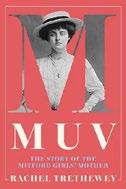
For more on geopolitics, visit Kirkus online.
The mother of the clan. Biographer Trethewey offers a well-researched life of the mother of the six famous Mitford sisters, Sydney Redesdale (1880-1963), who was, the author argues, “as eccentric, opinionated and ultimately misguided as her more extreme daughters.” Drawing on family papers, biographies, and interviews with some of Sydney’s descendants, she reveals a stubborn woman whose unwavering support of Hitler and lifelong antisemitism were prominent among her disturbing opinions. Married in 1904 to David Mitford, the second son of an aristocratic family, the couple did not expect much in the way of inheritance, but when David’s older brother was killed in action during World War I, followed by the death of his father, David and Sydney became Lord and Lady Redesdale. Unfortunately, the elevation in status did not come with an adequate income, and money problems, exacerbated by David’s bad business ventures, dogged the couple as their family expanded to seven children. With her own life circumscribed by societal expectations, Sydney, an ambitious woman with a keen business sense, was unable to contribute to shaping the family’s economics. As for mothering, some of her daughters praised her understanding and patience; others found her stifling, lacking “the imagination to think her daughters might be most fulfilled by living a life that was drastically different from her own.” Trethewey recounts familiar details of the sisters’ eventful lives, with Sydney rushing to support whichever daughter most needed her. Facing tragedy, upheaval, and rebelliousness, Sydney’s most salient quality, according to Trethewey, was an ability to develop “blind spots about anything unpleasant; it meant she saw what she wanted to see and edited out the
negative parts.” Trethewey admires her “courage and resilience” while remaining baffled by her political views.
A sympathetic biography of a complex woman.
Veale, Sara | Faber & Faber (288 pp.) | $34.95 February 10, 2026 | 9780571368563

Opening a door into the rich world of modern dance. Dance critic Veale calls the women dancers she profiles “unbridled voices” who use “their choices onstage and off to challenge expectations.” Between the 1890s and the 1910s, dancers probed creative new courses of movement. Isadora Duncan explored her “free dance” approach in Europe, performing barefoot in diaphanous costumes before bringing it to the U.S. in 1908—a “startling spark in the night.” Duncan epitomized social change and independence; her “repertoire bloomed like a hothouse rose” as she traveled the continent. A life of drinking and proselytizing damaged her later years. American Loie Fuller’s “Serpentine Dance” involved “vivid light projections and dizzying waves of silk.” Her career “thrived on imagination and metamorphosis.” She was all about movement, choreography, fluidity, saillike skirts and illumination. A huge success at the Folies Bergère, she even dabbled with scientific experiments. Canadian dancer Maud Allan’s provocative, much-maligned Vision of Salome, about sexual awakening, was hugely popular in 1908, inspiring ballet performers to experiment. Music was key to her dancing, which did much to broaden its appeal. The interwar years saw a rise in Black artists and the emergence of American icon Martha Graham, who was known for her introspective expressiveness and productivity. Graham’s role in modern dance was substantial, deeply influencing Veale’s own dancing. Anna Sokolow’s
prolific works, searing and sincere, focused on social justice. Graham student Sophie Maslow “addressed a national identity in flux” in the 1940s, fostering inclusivity. In the ’40s and ’50s, Pearl Primus and Katherine Dunham had a “game-changing influence on the racial diversity of modern dance.” Dunham’s extensive portfolio of the beauty of Black heritage is a hefty legacy indeed, while Primus “harnessed her body as a channel for fury, pride and authenticity…dance as a scream.” Enthusiastic profiles of dancers set within insightful social history.
Weisser, Olivia | Cambridge Univ. (236 pp.) | $29.95 | February 19, 2026 9781009651837

A richly textured portrait of a city steeped in shame. Weisser, a historian at the University of Massachusetts Boston, delivers a history lesson with a novelist’s eye for detail, resurrecting a London that is filthy, fearful, and alive with commerce and contagion. She begins, fittingly, with Samuel Pepys in 1664, fretting over his brother Tom, who is “deadly ill—and which is worse, that his disease is the pox.” Pepys calls in a second opinion, desperate to erase the stain, and persuades himself (and others) that the initial diagnosis was wrong. Weisser compares this quiet act of denial to the families of gay men in the 1980s and ’90s who altered obituaries to disguise AIDS-related deaths. The “pox,” she explains, was an elastic term encompassing many afflictions, mostly sexual, and all freighted with moral reproach. Londoners hid their shame behind wigs, face patches, and mercury-based ointments, while the city thrummed with peddlers and backstreet quacks hawking cures. At Bartholomew Fair, she conjures dancing monkeys, Venetian girls on rope, and prostitutes offering a good time—and a bad infection, scenes echoed in the bawdy
ballads of the age. Remedies mixed mercury, sassafras, and jalap; some involved digesting quicksilver and turpentine. Edward Jewel’s “Incomparable Extractum Humorale” was sold in 23 shops across London, from grocers to cheesemongers—a forerunner of modern pharmaceutical branding. Each chapter opens with a vignette—a maid hiding pills under her bed, a wife using her infection as evidence in court of her husband’s infidelity—and together they trace the disease from street to sickroom to courtroom. The author draws heavily on John Marten’s A Treatise of All the Degrees and Symptoms of the Venereal Disease (1707), one of the few substantial sources available to her. “The pox was the first modern disease,” Weisser writes, “but not for the reasons we like to think.” Her argument—that shame, not science, shaped how people experienced illness— feels startlingly contemporary.
A lucid, humane book that shows how fear, commerce, and desire made London both sick and modern.
Williams, Elliot | Penguin Press (384 pp.) $32 | February 10, 2026 | 9780593833704

A fast-paced tale of one of New York City’s defining moments unfolds in the 1984 subway shooting of four Black youths by Bernhard Goetz. Goetz, an eccentric loner who became an unlikely symbol of vigilante justice, claimed the four young men were attempting to mug him. The ensuing trial turned into a deeply polarizing media circus, exposing the city’s fraught tensions over race, crime, and public safety. Journalist and legal analyst Williams offers a vivid portrait of 1980s New York and the social and economic pressures that shaped the backdrop of the case. Through brisk, evocative prose, the author captures the
complexities of a troubled city and the crime that mirrored its contradictions. He deftly weaves in the roles of figures such as Ed Koch, Rudolph Giuliani, Al Sharpton, and Rupert Murdoch in crafting the public narrative of the “Subway Vigilante.” Goetz, who fled the scene and vanished into a subway tunnel, was later urged to surrender by Murdoch’s right-leaning New York Post, which editorialized: “The editors and reporters of this newspaper understand your anger and frustration….We endure the same fear and anger that exploded in you on Saturday.” Williams frames the courtroom clash between defense attorney Barry Slotnick and prosecutor Gregory Waples as a window into the city’s struggles with racism, fear, and declining quality of life. The trial, he suggests, became a referendum on the public’s faith in authorities to keep them safe. Williams concludes, “There are few undeniable truths to Bernhard Goetz’s story. Two are that the media have tremendous power to create heroes and villains, and that they, more than anyone or anything else, created Bernhard Goetz.”
A lively and haunting account of five men linked by a shooting—echoing New York’s enduring tensions over fear and race.
Wong, Mandy-Suzanne | Graywolf (176 pp.) $18 paper | February 17, 2026 | 9781644453735
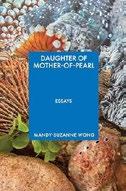
It’s a marvelous world.
Novelist and essayist Wong gathers 17 essays, illustrated with photographs, that animate the undersea world with creatures that have the capacity for yearning, love, hope, and loyalty. With a lyricism that evokes the poetry of Mary Oliver, Wong describes her encounters with a variety of sea life, such as the starfish, in whose gaze she feels evidence of her own insignificance. She and the starfish “communicated to each other the precious happenstance of our coexistence.” Humans, she writes, “prefer to envision other animals as abstract,
mechanistic ‘economies,’ incapable of wanting anything more than food and sex.” Not Wong: She considers the conundrum of an animal tearing off a part of itself that goes on living, a “polyvitality” that allows for one individual “simultaneously living many lives.” She considers the life cycle of the abalone, the snail’s creation of its shell, and the thoughts of creatures imprisoned in laboratories, where they are subjected to probing by giant earthlings. While most of her observations concern waterborne life, one day she discovers a specimen of otala lactea, a snail that has found its way into her family’s mailbox. Creating a habitat for it in a box, she develops a connection so intense that it seems like love. Her gentle coexistence with other life-forms stands in stark contrast to humanity’s predilection for exploitation, whether of oysters, implanted with foreign matter in order to produce cultured pearls, or snails deemed invasive and so targeted for elimination. “We’re a disgrace,” she writes, “because we bring suffering and extinction upon quiet little strangers.” Instead, she counsels respect and awe. Take jellyfish, for example, whose “flowing, glowing beauty” is worth admiring “without using them, as you yourself would wish to be admired but not used.”
A passionate paean to life’s wonders.
Ed. by Yuknavitch, Lidia | Grand Central Publishing (304 pp.) | $19.99 paper January 27, 2026 | 9781538765548

Writers confront their experiences of menopause and its aftermath. Novelist and memoirist Yuknavitch here collects 13 personal essays, including one of her own, representing women at various stages
of life, from different cultures, and with a range of feelings about hot flashes, mood swings, and the fact that, as Pam Houston sardonically notes, “Post-menopause, like it or not, death is the next big thing.” In the lively “She-Dandy,” Darcey Steinke considers menopause in other species, like the killer whale pod led by a postmenopausal female that strikes the author as “otherly, smelly, powerful, ridiculously awake.” Several of the essays make it clear that the story of menopause is inevitably tangled up in the stories of life as a whole. It’s an easy transition for Monica Drake—up to the time when her husband leaves her in a messy divorce, and the symptoms of menopause mix inextricably with feelings of rage and sorrow. Some of the best essays provide a view from the other side of menopause. Julia Alvarez sensitively finds her way by reaching out for “stories to steer by” and looks to older women as “muses to help me get wherever I was going.” Yuknavitch’s concluding essay nests her own wrenching experience of menopause into an extended footnote inside an uplifting meditation about the possibilities of change, in which she tells her readers that “you are not alone, but you are going to have to conjure your own story.” Not so much a map as an invitation to explore fearlessly one’s own unique experience, the book provides a chorus of generally calm, comforting, and often surprisingly humorous voices. Engagingly personal tales of an underreported stage of life.

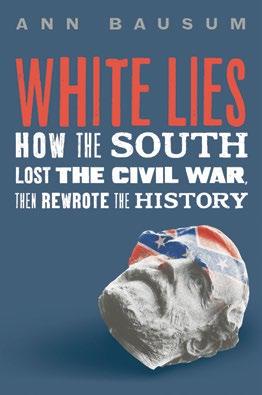









The best children’s books of 2025 take on some hefty themes—the beauty of imperfection, courage in the face of injustice, grief and loss—while still meeting young people where they are. Other selections turn gleefully goofy: A misanthropic wolf dodges snot-nosed kids and a cranky librarian on a trip to the library; a seemingly ordinary crow reveals that he’s a secret agent determined to save the world. These picture books and middle-grade titles are hilarious, surreal, and thought-provoking—sometimes all at once.

Abbott, Zoey | Caitlyn Dlouhy/ Atheneum (40 pp.) | $19.99
July 15, 2025 | 9781665956024
A sly seasonal pick for kids craving a dash of agency alongside their dress-up. (Picture book. 4-7)

Abtahi, Olivia | Illus. by Monica Arnaldo Kokila (40 pp.) | $18.99 | January 21, 2025 9780593620441
Sensationally true to life. (Picture book. 4-8)

Alcántara, Jacqueline | Nancy Paulsen Books (32 pp.) | $18.99 February 18, 2025 | 9780593620137
This thoughtful and meaningful look at extended familia is a true gem. (Picture book. 4-8)
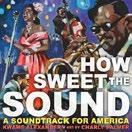
Alexander, Kwame | Illus. by Charly Palmer | Little, Brown (48 pp.) | $18.99 January 14, 2025 | 9780316442497
A work whose lyrical and artistic genius only becomes more apparent upon rereads. (Informational picture book. 5-10)

Alper, Sascha | Illus. by Jerry Pinkney & Brian Pinkney | Anne Schwartz/ Random (40 pp.) | $18.99
April 1, 2025 | 9780593309124
An inspiring example of the good that can result from one act, no matter how small. (Picture book. 4-7)

Alznauer, Amy | Illus. by Anna Bron Candlewick (48 pp.) | $18.99
March 4, 2025 | 9781536229479
Inspiration and validation for amateurs of all sorts, beautifully presented. (Picture-book biography. 7-9)

Awan, Jashar | Simon & Schuster (48 pp.) | $19.99 | February 25, 2025 9781665938150
Captures the excitement of anticipation, the thrill of yearning realized, and truck love among the young. (Picture book. 2-5)

Bardugo, Leigh | Illus. by John Picacio Little, Brown (60 pp.) | $19.99
August 26, 2025 | 9780316295703
Simply wondrous. (Picture book. 4-8)
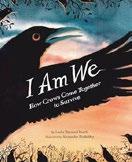
Barnard Booth, Leslie | Illus. by Alexandra Finkeldey | Chronicle Books (44 pp.) | $18.99 September 9, 2025 | 9781797226156
A moody, poetic study of a brilliant yet oft-misunderstood creature. (Informational picture book. 4-7)
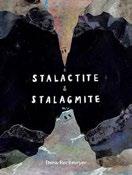
Beckmeyer, Drew | Atheneum (40 pp.)
$19.99 | March 18, 2025 | 9781665926638
Both gloriously expansive and goofy— in short, everything young readers could ask for. (Informational picture book. 4-8)

Bingham, Winsome | Illus. by C.G.
Esperanza | Abrams (48 pp.) | $19.99
July 8, 2025 | 9781419766930
A book to sink your teeth into. (Picture book. 6-9)

Brown, Lisa | Neal Porter/Holiday House (40 pp.) | $18.99 | July 22, 2025
9780823457182
An impressively understated, respectful exploration of a big change. (Picture book. 3-7)
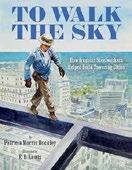
Buckley, Patricia Morris | Illus. by E.B. Lewis | Heartdrum (40 pp.) | $19.99
January 28, 2025 | 9780063046979
Awe-inspiring. (Informational picture book. 6-9)
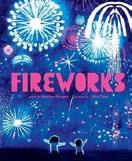
Burgess, Matthew | Illus. by Cátia Chien
Clarion/HarperCollins (44 pp.) | $19.99
May 13, 2025 | 9780063216723
A radiant celebration of all things summer. (Picture book. 4-7)
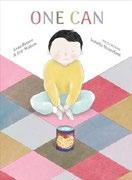
Button, Lana & Eric Walters | Illus. by Isabelle Malenfant | Groundwood (32 pp.) | $19.99 | September 2, 2025 9781773067346
A perfectly calibrated introduction to the concept of economic differences. (Picture book. 4-7)
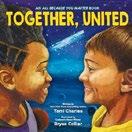
Charles, Tami | Illus. by Bryan Collier
Orchard/Scholastic (40 pp.) | $18.99
September 16, 2025 | 9781338752052
A lushly illustrated, uplifting work that beckons us to unite around our common humanity. (Picture book. 4-8)

Chin, Jason | Neal Porter/Holiday House (48 pp.) | $19.99 | May 6, 2025 9780823458493
Deeply empathetic, brilliantly illustrated, and chock-full of information. (Informational picture book. 4-8)
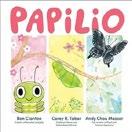
Clanton, Ben, Corey R. Tabor & Andy Chou Musser | Viking (48 pp.) | $19.99 March 4, 2025 | 9780593693254
Move aside, Very Hungry Caterpillar. Meet the new queen of metamorphosis storytime splendor. (Picture book. 3-7)

Connors, Jerrold | Dial Books (80 pp.) $20.99 | May 20, 2025 | 9780593859346
Charming, funny, strange, and sad. A better bio of Jim could hardly exist. (Picture-book biography. 5-8)
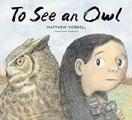
Cordell, Matthew | Random House Studio (40 pp.) | $18.99 | January 7, 2025 9780593649893
A title easily summed up in a single word: magic. (Picture book. 4-8)
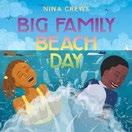
Crews, Nina | Greenwillow Books (32 pp.)
$19.99 | May 20, 2025 | 9780063390225
Pure joy. (Picture book. 4-8)
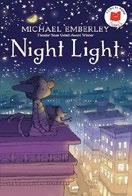
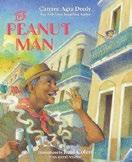
Deedy, Carmen Agra | Illus. by Raúl Colón | Margaret Quinlin Books/ Peachtree (48 pp.) | $18.99
March 4, 2025 | 9781682635681
Exceptionally lovely, like a gentle tug at the heartstrings. (Picture book. 4-8)
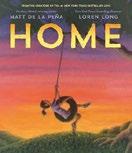
de la Peña, Matt | Illus. by Loren Long | Putnam (48 pp.) | $19.99
March 11, 2025 | 9780593110898
Simply divine. (Picture book. 4-8)
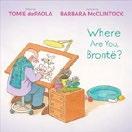
dePaola, Tomie | Illus. by Barbara McClintock | Simon & Schuster (48 pp.)
$19.99 | May 6, 2025 | 9781534418509
A gentle delight, simultaneously honoring both the dog dePaola lost and the artist we lost in turn.
(Informational picture book. 4-8)

Douglas, Kati & Ashley Jefferson Abrams Appleseed (24 pp.) | $9.99
December 2, 2025 | 9781419780141
Happy families are wildly different in this joyfully inclusive series of lavishly photographed portraits. (Board book. 1-4)
Emberley, Michael | Holiday House (40 pp.)
$14.99 | April 15, 2025 | 9780823458165
Series: I Like To Read Comics
A truly stellar nighttime adventure. (Graphic early reader. 5-8)
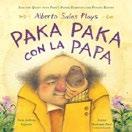
Alberto Salas Plays Paka Paka Con La Papa: Join the Quest With Peru’s Famed Scientist and Potato Expert
Fajardo, Sara Andrea | Illus. by Juana Martinez-Neal | Roaring Brook Press (40 pp.) | $19.99 | March 18, 2025 9781250838612
A remarkable path to starch-dom. (Picture-book biography. 4-8)
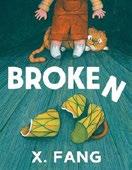
Fang, X. | Tundra Books (48 pp.) | $18.99 October 14, 2025 | 9781774882009
A common childhood experience, conveyed with an uncommon mix of sensitivity, mirth, and heart. (Picture book. 4-8)

Floca, Brian | Illus. by Sydney Smith Neal Porter/Holiday House (48 pp.)
$18.99 | July 22, 2025 | 9780823456475
The power of nature captivates and compels in this phenomenal tale of pushing limits. (Picture book. 4-8)
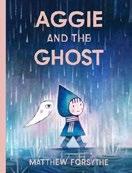
Forsythe, Matthew | Paula Wiseman/ Simon & Schuster (64 pp.) | $19.99
August 19, 2025 | 9781534478206
A witty year-round ghost tale that delivers a wonderfully unconventional conclusion. (Picture book. 4-8)
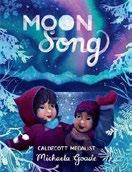
Goade, Michaela | Little, Brown (40 pp.)
$18.99 | October 7, 2025 | 9780316461634
A soothing and appreciative ode to family, the moon, and winter’s welcoming embrace. (author’s note) (Picture book. 4-8)

Graegin, Stephanie | Tundra Books (56 pp.)
$18.99 | July 8, 2025 | 9781774886205
Series: Tiny Bean’s Big Adventures, 1
Even the tiniest adventure can be considered big when blessed with such enormous charm. (Picture book. 3-6)
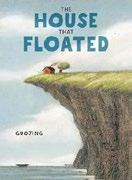
Guojing | Random House Studio (40 pp.) | $18.99 | September 16, 2025 9780593709054
A hopeful vision of love and persistence in the face of peril. (Picture book. 4-8)

Han, Sally Soweol | Bloomsbury (40 pp.)
$18.99 | May 27, 2025 | 9781547615063
Mesmerizing—and sure to inspire listeners to attend to the symphonies in their own environments. (Picture book. 3-6)

Handy, Bruce | Illus. by Julie Kwon Chronicle Books (44 pp.) | $17.99 October 14, 2025 | 9781797215044
Handy’s few words speak volumes. (Picture book. 3-5)
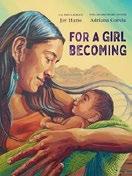
Harjo, Joy | Illus. by Adriana M. Garcia
Norton Young Readers (40 pp.) | $18.99
April 29, 2025 | 9781324052241
A stunningly illustrated, tender, and tenacious message—a boon to any bookshelf. (Picture book. 4-8)
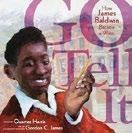
Harris, Quartez | Illus. by Gordon C. James | Little, Brown (40 pp.) | $18.99 January 7, 2025 | 9780316483933
A superb introduction to a master of the craft and a work of art in and of itself. (Picture-book biography. 5-9)
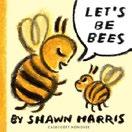
Harris, Shawn | Neal Porter/Holiday House (40 pp.) | $18.99 | February 11, 2025 | 9780823457090
Let’s be readers and explore this book together—again and again. (Picture book. 2-5)
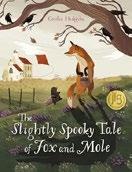
Heikkilä, Cecilia | Trans. by Polly Lawson Floris (44 pp.) | $19.99 | August 5, 2025 9781782509530
A triumphant blend of humor and horror, perfect for teaching and scaring by turn. (Picture book. 4-7)

Heuer, Lourdes | Illus. by Maxwell Eaton III Neal Porter/Holiday House (40 pp.)
$18.99 | April 8, 2025 | 9780823455706
A bittersweet tribute that makes a poignant connection between maps and the concept of home. (Picture book. 4-7)

Howe, James | Illus. by Jack Wong Abrams (48 pp.) | $19.99 | June 3, 2025
9781419755217
A harmonious tribute to one of music’s absolute greats. (Picture-book biography. 4-8)
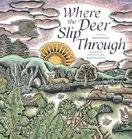
Howes, Katey | Illus. by Beth Krommes Beach Lane/Simon & Schuster (32 pp.) $19.99 | June 3, 2025 | 9781665918275
A visual and auditory delight. (Picture book. 3-6)
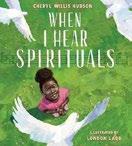
Hudson, Cheryl Willis | Illus. by London Ladd | Holiday House (40 pp.) | $18.99
January 7, 2025 | 9780823453801
A deeply resonant work that speaks to these songs’ historical— and present—meaning.
(Informational picture book. 6-10)

Huh, Jungyoon | Illus. by Myungae Lee
Trans. by Aerin Park | Eerdmans (40 pp.) | $18.99 | September 23, 2025 9780802856494
A quiet yet masterfully rendered reminder that decency is always worth the hassle. (Picture book. 4-8)
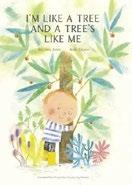
Jaoui, Sylvaine | Illus. by Anne Crahay Trans. by Claudia Zoe Bedrick
Enchanted Lion Books (48 pp.) | $19.99
April 15, 2025 | 9781592704248
Much like life itself, this story is a gift that deserves to be shared. (Picture book. 3-6)
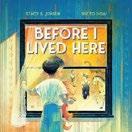
Jensen, Stacy S. | Illus. by Victo Ngai Neal Porter/Holiday House (32 pp.) | $18.99 | August 26, 2025
9780823452231
Jensen’s tour through time is a tour de force. (Informational picture book. 5-9)

Jonker, Travis | Illus. by Ruth Chan Abrams (40 pp.) | $18.99
February 4, 2025 | 9781419765032
Don’t bring up the rear! Be the first in line to read this laugh-out-loud story. (Picture book. 5-8)

Our Lake
Kang, Angie | Kokila (40 pp.) | $19.99
March 4, 2025 | 9780593698235
A sensitive look at the delicate process of navigating loss. (Picture book. 5-8)

Kaufman, Suzanne | Little, Brown (48 pp.)
$18.99 | June 3, 2025 | 9780316311663
A whimsical, luminous romp. (Picture book. 3-9)
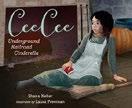
Keller, Shana | Illus. by Laura Freeman Charlesbridge (32 pp.) | $18.99
August 12, 2025 | 9781623543891
Rewarding, potent, and wholly original. (Picture book. 5-8)

Kim, Hye-Eun | TOON Books/Astra Books for Young Readers (48 pp.) | $18.99
March 18, 2025 | 9781662665530
A stunning ode to the natural world and the cyclical nature of imagination. (Picture book. 4-8)

Kinkz, Eliza | Kokila (40 pp.) | $18.99 April 1, 2025 | 9780593700235
A deliciously effervescent celebration of family and resilience. (Picture book. 6-9)

Klassen, Jon | Candlewick (24 pp.) | $8.99
February 4, 2025 | 9781536230833
Series: Your Places
Pure, unmitigated sleepy-time pleasure. (Board book. 2-4)
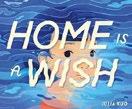
Kuo, Julia | Roaring Brook Press (32 pp.)
$18.99 | February 4, 2025 | 9781250881328
Elegantly constructed yet warmly comforting—a soothing balm for children undergoing similar changes. (Picture book. 4-8)

Lam, Thao | Groundwood (40 pp.)
$19.99 | April 1, 2025 | 9781773067643
A unique, joyful celebration of bellies, bodies, and beauty. (Picture book. 5-8)

LaRocca, Rajani | Illus. by Huy Voun Lee Christy Ottaviano Books (32 pp.)
$18.99 | May 27, 2025 | 9780316571753
A moving and captivating civics lesson. (Informational picture book. 4-8)
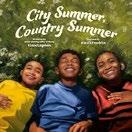
Laymon, Kiese | Illus. by Alexis Franklin Kokila (32 pp.) | $18.99 | April 1, 2025 9780593405567
A heartfelt, elegantly wrought, and triumphant tribute to Black boy kinship. (Picture book. 6-10)
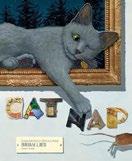
Lies, Brian | Greenwillow Books (48 pp.) | $19.99 | September 30, 2025 9780062671288
Utterly beautiful, playfully fun, and, above all, breathtaking. (Picture book. 3-6)
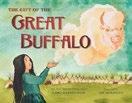
Lindstrom, Carole | Illus. by Aly McKnight Bloomsbury (40 pp.) | $18.99 February 25, 2025 | 9781547606887
This reverently told story is a true gift. (Picture book. 5-9)

Linke, Regina | Little, Brown (40 pp.)
$18.99 | April 1, 2025 | 9780316531153
A gentle adventure for big dreamers in small bodies. (Picture book. 4-8)

Lopez, Paloma Angelina | Illus. by Abraham
Matias | Charlesbridge (40 pp.) | $17.99
August 19, 2025 | 9781623544577
Gently magnificent. (Picture book. 4-8)
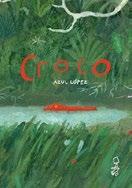
López, Azul | Trans. by Kit Maude
Tapioca Stories (40 pp.) | $18.95
October 28, 2025 | 9798988749974
Three cheers for this resourceful reptilian! (Picture book. 4-9)

Maillard, Kevin | Illus. by Rafael López
Roaring Brook Press (40 pp.) | $18.99
October 14, 2025 | 9781250821980
Stunning and essential. (Picture book. 5-9)

Mansour, Vivian | Illus. by Emmanuel
Valtierra | Trans. by Carlos Rodríguez
Cortez | Levine Querido (48 pp.) | $18.99
February 11, 2025 | 9781646145157
A gripping, thought-provoking migration saga. (Picture book. 4-8)

Marsol, Manuel | Trans. by Lizzie Davis
Transit Children’s Editions (64 pp.)
$21.95 | March 18, 2025 | 9798893389043
An achingly beautiful testament to life, love, and death among the stars. (Picture book. 5-8)

Martin, Marc | Candlewick Studio (48 pp.)
$18.99 | July 29, 2025 | 9781536232400
Truly stunning. (Picture book. 4-8)

McAlister, Caroline | Illus. by Jamie Green
Roaring Brook Press (40 pp.) | $19.99
February 25, 2025 | 9781250310378
A title worth moving to the head of the line. (Picture-book biography. 7-11)

Montgomery, Sy | Illus. by Matt Patterson
Clarion/HarperCollins (40 pp.) | $19.99
September 9, 2025 | 9780063325166
In the annals of true animal rescue tales, this one delights and uplifts. (Informational picture book. 4-8)

Paeff, Colleen | Illus. by Ji-Hyuk Kim McElderry (40 pp.) | $19.99
June 10, 2025 | 9781665931847
A wonderful tribute to a citizen scientist who harnessed the power of observation and discovery. (Informational picture book. 5-9)
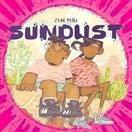
Peña, Zeke | Kokila (48 pp.) | $19.99
August 5, 2025 | 9780593700112
A hypnotic joy. (Picture book. 4-8)
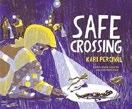
Percival, Kari | Chronicle Books (48 pp.)
$18.99 | January 7, 2025 | 9781797214566
Informative and beautiful.
(Informational picture book. 5-8)

Perrella, Eugenia | Illus. by Angela Salerno | Trans. by Sally Polson
Floris (32 pp.) | $18.99 | October 7, 2025
9781782509257
Both poignant and buoyant: a touching tribute to love and the endurance of the human spirit.
(Picture book. 5-8)
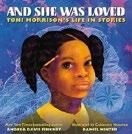
And She Was Loved: Toni Morrison’s Life in Stories
Pinkney, Andrea Davis | Illus. by Daniel Minter | Little, Brown (48 pp.) | $18.99
January 7, 2025 | 9780316182362
A potent example of the reach of artistic genius.
(Picture-book biography. 4-8)

Poliquin, Rachel | Illus. by Julie Morstad Candlewick (48 pp.) | $18.99 October 21, 2025 | 9781536230529
Witty, smart, and sophisticated.
(Informational picture book. 4-8)

Pritchard, Caroline Kusin | Illus. by Selina Alko | Simon & Schuster (40 pp.) | $19.99
February 4, 2025 | 9781665914970
A stirring testament to the power of books to unite us all for good.
(Informational picture book. 6-9)
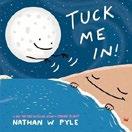
Pyle, Nathan W. | Random House (40 pp.) | $18.99 | September 2, 2025 9798217029433
A masterly combination of fantasy and science to tuck in to every bookcase. (Informational picture book. 4-8)
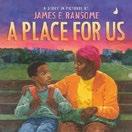
Ransome, James E. | Nancy Paulsen Books (32 pp.) | $18.99 | August 5, 2025 9780593324882
Thought-provoking, heartbreaking, and moving. (Picture book. 4-8)
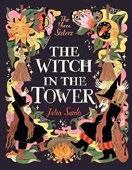
The Witch in the Tower Sardà, Júlia | Candlewick Studio (64 pp.) | $19.99 | September 2, 2025 9781536243017 | Series: The Three Sisters
Utterly spellbinding. (Picture book. 6-12)
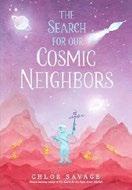
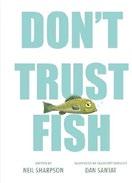
Savage, Chloe | Candlewick (32 pp.) $18.99 | September 30, 2025 9781536247497 | Series: Hidden Wonders
Clever, funny, and worth discussing. (Picture book. 4-9)
Sharpson, Neil | Illus. by Dan Santat Dial Books (40 pp.) | $18.99
April 8, 2025 | 9780593616673
A ribald and uproarious warning to those unschooled in fishy goings-on. (Picture book. 4-7)

Sidman, Joyce | Illus. by Melissa Sweet
Clarion/HarperCollins (40 pp.) | $19.99
September 2, 2025 | 9780358334767
An imaginative and insightful masterpiece of poetic correspondence that invites readers to discover new connections. (Picture book/poetry. 4-8)
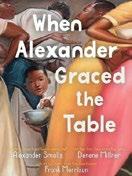
Smalls, Alexander & Denene Millner Illus. by Frank Morrison | Denene Millner Books/Simon & Schuster (40 pp.) | $19.99 | January 7, 2025 9781534488724
The joy of cooking—and family—brought to brilliant life. (Picture book. 4-7)
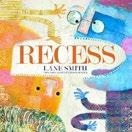
Smith, Lane | Abrams (40 pp.) | $19.99
July 22, 2025 | 9781419776892
Wilder than any rumpus, this recess isn’t just a break—it’s silliness incarnate! (Picture book. 3-6)
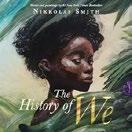
Smith, Nikkolas | Kokila (40 pp.) | $18.99
May 20, 2025 | 9780593619681
A triumph. (author’s note) (Picture book. 3-8)

Spillett, Tasha | Illus. by Daniel Ramirez Little, Brown (32 pp.) | $18.99
January 14, 2025 | 9780316422161
Weaves Two-Spirit self-expression and collective belonging into a beautiful tribute to Indigenous heritage. (illustrator’s note) (Picture book. 4-9)
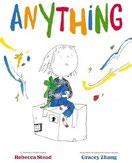
Stead, Rebecca | Illus. by Gracey Zhang
Chronicle Books (56 pp.) | $17.99
April 29, 2025 | 9781797215150
A sensitive, beautifully wrought meditation on change. (Picture book. 4-8)

Tabor, Corey R. | Greenwillow Books (40 pp.) | $19.99 | May 6, 2025
9780063373587
Storytelling at its most brilliant— and whimsical. (Picture book. 3-6)

Tagaq, Tanya | Illus. by Qavavau Manumie | Tundra Books (32 pp.)
$17.99 | April 8, 2025 | 9781774880579
A poetic homage to Indigenous families and their deep-seated connections to the natural world. (Picture book. 4-9)

Tagholm, Sarah | Illus. by Jane McGuinness | Bloomsbury (34 pp.)
$18.99 | March 18, 2025 | 9781526627339
A hopping good book perfect for budding biologists. (Picture book. 3-8)
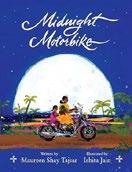
Tajsar, Maureen Shay | Illus. by Ishita Jain | Neal Porter/Holiday House (40 pp.) $18.99 | April 8, 2025 | 9780823456628
A visual feast sure to have readers finding magic in the mundane. (Picture book. 4-8)

Taussig, Rebekah | Illus. by Kirbi Fagan
Carolrhoda (32 pp.) | $19.99
April 1, 2025 | 9781728487700
Warm, poetic, and affirming. (Picture book. 4-10)
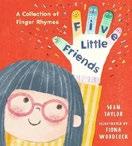
Taylor, Sean | Illus. by Fiona Woodcock
Candlewick (64 pp.) | $19.99
August 19, 2025 | 9781536242911
A fresh, wonderfully creative array of rhymes to get kids moving. (Picture book/poetry. 3-7)

Thimmesh, Catherine | Illus. by Shanda
McCloskey | Chronicle Books (56 pp.)
$19.99 | May 6, 2025 | 9781452144221
Funny, chock-full of science, and wonderfully complicated. (Informational picture book. 8-12)

Thomas, Tess | Illus. by Kamwei Fong
Levine Querido (48 pp.) | $19.99
September 2, 2025 | 9781646145737
A winning blend of crisp design, child-appealing illustrations, and positive messaging about selfexpression. (Picture book. 3-7)

Tolentino, Marcelo | Trans. by Rahul Bery
Blue Dot Kids Press (48 pp.) | $18.95
January 22, 2025 | 9798989858811
Imaginative play has never been this exciting. (Picture book. 4-7)

Tonatiuh, Duncan | Abrams (48 pp.) | $18.99
November 11, 2025 | 9781419764592
Utterly mesmerizing. (Picture book. 4-8)
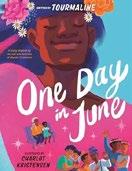
Tourmaline | Illus. by Charlot Kristensen Putnam (40 pp.) | $18.99 | May 27, 2025
9780593525371
A tribute as bright, luxuriant, and giving as Marsha herself. (Informational picture book. 3-8)

Vail, Rachel | Illus. by Chris Raschka Greenwillow Books (32 pp.) | $19.99 May 27, 2025 | 9780063414723
Embrace this lively, creative look at asserting one’s boundaries. (Picture book. 4-7)
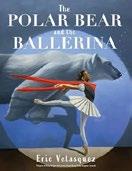
Velasquez, Eric | Holiday House (40 pp.)
$18.99 | October 14, 2025 | 9780823449187
Dreamy. (Picture book. 5-8)

Yuly, Toni | Little, Brown (40 pp.)
$18.99 | July 15, 2025 | 9780316497916
Simultaneously cozy and utterly engaging in its simplicity. (Picture book. 3-6)




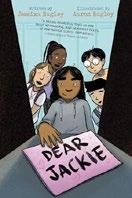
Alexander, Lori | Illus. by Rebecca Santo
Clarion/HarperCollins (128 pp.) | $18.99
January 28, 2025 | 9780063245990
Absorbing and inspirational. (Nonfiction. 8-12)
Applegate, Katherine | Illus. by Charles Santoso | Feiwel & Friends (272 pp.) | $17.99 September 9, 2025 | 9781250904362
Poignant and heartwarming. (Fiction. 8-12)
Arango, Andrea Beatriz | Random House (272 pp.) | $17.99 | February 11, 2025 9780593810927
Moving and insightful. (Verse fiction. 10-13)
Babbitt, Natalie | Adapt. by K. WoodmanMaynard | Illus. by K. Woodman-Maynard Farrar, Straus and Giroux (256 pp.) | $22.99 September 2, 2025 | 9780374391850
An homage navigated with confidence and care, as wise and wonderful as the original. (Graphic fantasy. 10-14)
Dear
Bagley, Jessixa | Illus. by Aaron Bagley Simon & Schuster (288 pp.) | $24.99 September 9, 2025 | 9781534496583
A funny, heartfelt look at growing up and pushing back against narrow expectations. (Graphic fiction. 8-12)

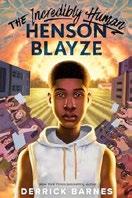
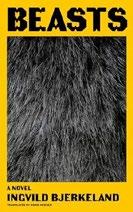
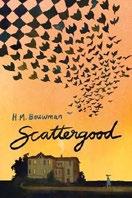

Bakes, Jules | Illus. by Niki Smith
Graphix/Scholastic (256 pp.) | $14.99 paper | February 4, 2025 | 9781338835861
Authentic and engaging. (Graphic fiction. 8-12)
Barnes, Derrick | Viking (272 pp.) | $17.99 September 23, 2025 | 9781984836755
Bold, extraordinary storytelling: not to be missed. (Fiction. 10-14)
Bjerkeland, Ingvild | Trans. by Rosie Hedger | Levine Querido (128 pp.) $17.99 | April 1, 2025 | 9781646145133
Dark and achingly upsetting; highly appealing for a great many horror readers, new and old. (Horror. 10-18)
Bouwman, H.M. | Neal Porter/ Holiday House (320 pp.) | $18.99 January 21, 2025 | 9780823457755
An engaging, textured, and deeply humane coming-ofage novel. (Historical fiction. 9-14)
Bowes, Arnolda Dufour | Illus. by Karlene Harvey | Groundwood (228 pp.) | $14.99 paper | August 5, 2025 9781773067742 | Series: Maggie Lou, 2
A high-energy love letter to rambunctious girls, big families, and Métis culture. (Fiction. 9-12)
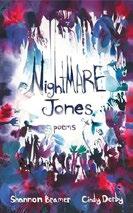


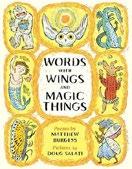
Bramer, Shannon | Illus. by Cindy Derby Groundwood (56 pp.) | $14.99
October 7, 2025 | 9781773069463
Delicious poetry paired with haunting art speaks with authority to the darkness so many kids crave. (Poetry/horror. 9-14)
Brown, Don | Abrams Fanfare (128 pp.) $15.99 | January 21, 2025 | 9781419773310
Series: Big Ideas That Changed the World, 6
Expansive, engaging, and lucid. (timeline, biographical note) (Graphic nonfiction. 11-13)
Kotani’s
Brown, Waka T. | Quill Tree Books/ HarperCollins (272 pp.) | $19.99 February 18, 2025 | 9780063230811
A thought-provoking, multilayered read that will leave a lasting impression. (Fiction. 8-12)
Burgess, Matthew | Illus. by Doug Salati Tundra Books (128 pp.) | $19.99 March 18, 2025 | 9781774880289
Broad and subtle in turn—verse to stay with readers for years to come. (Poetry. 7-11)
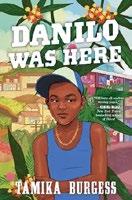
Burgess, Tamika | Harper/HarperCollins (304 pp.) | $19.99 | January 21, 2025 9780063159662
A compelling book that’s here to stay. (Historical fiction. 8-12)
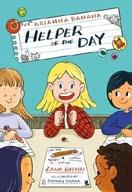
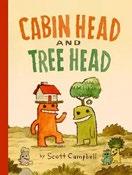
Button, Lana | Illus. by Suharu Ogawa | Orca (96 pp.) | $8.95 paper | February 11, 2025 9781459840010 | Series: Orca Echoes
A flawed but sympathetic character worthy of readers’ love. (Chapter book. 6-9)
Campbell, Scott | Tundra Books (88 pp.) | $13.99 | September 30, 2025 9781774885055 | Series: Cabin Head and Tree Head, 1
A wildly original tale with the buddy-based charm of Frog and Toad but imbued with a wacky energy all its own. (Graphic fiction. 6-10)

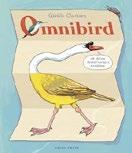
Cherrywell, Steph | Little, Brown (288 pp.) | $17.99 | September 16, 2025 9780316585941
Humor and heart entwine in this hilarious and wildly creative adventure. (Fantasy. 8-12)
Clarkson, Giselle | Gecko Press (96 pp.) $24.99 | October 7, 2025 | 9798765670514
A truly stellar work that will delight bird enthusiasts while converting the ambivalent into eager avian investigators. (Nonfiction. 8-13)

DiCamillo, Kate | Illus. by Carmen Mok Candlewick (80 pp.) | $16.99 April 29, 2025 | 9781536225303
Sensitive and quietly enthralling. (Early chapter book. 7-9)

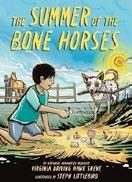
Dodd, Lily Berlin | Farrar, Straus and Giroux (352 pp.) | $17.99 | November 18, 2025
9780374393120 | Series: The Aerimander Chronicles, 1
Egg-cellent storytelling; readers will be eager for the second book. (Fantasy. 9-12)
Driving Hawk Sneve, Virginia Illus. by Steph Littlebird | Amulet/ Abrams (64 pp.) | $14.99
April 1, 2025 | 9781419759550
Infused with tenderness, this family story is simply lovely. (Chapter book. 5-8)

Dumon Tak, Bibi | Illus. by Annemarie van Haeringen | Trans. by Nancy Forest-Flier Levine Querido (224 pp.) | $19.99
February 4, 2025 | 9781646145102
A brilliant use of anthropomorphic animals, serving up facts and entertainment. (Nonfiction. 8-12)
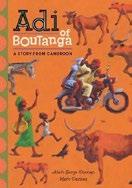

Dzotap, Alain Serge | Illus. by Marc Daniau | Eerdmans (60 pp.) | $18.99 April 15, 2025 | 9780802856296
A vivid account of Cameroonian village life. (Fiction. 7-11)
Eagle, Judith | Illus. by Jo Rioux | Walker US/Candlewick (288 pp.) | $18.99
December 2, 2025 | 9781536242683
Assured and atmospheric: a winner. (Mystery. 8-12)



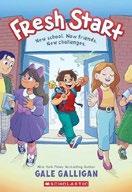

Edgmon, H.E. | Feiwel & Friends (240 pp.) | $17.99 | September 23, 2025
9781250874009
A clever, perceptive read that’s full of love for those who are different. (Paranormal. 9-12)
Faruqi, Saadia | Quill Tree Books/ HarperCollins (384 pp.) | $18.99
March 4, 2025 | 9780063115859
An authentically textured account of a young teen coping with a parent’s mental illness. (Fiction. 10-13)
Fitzharris, Lindsey & Adrian Teal Bloomsbury (160 pp.) | $19.99
October 14, 2025 | 9781547615025
Macabre, madcap, and surprisingly wholesome in its positivity. (Nonfiction. 9-14)
Galligan, Gale | Colors by K Czap Graphix/Scholastic | (288 pp.) | $24.99
$14.99 paper | January 7, 2025 9781338045864 | 9781338045840 paper
A hilarious and undeniably endearing tale of tweenhood. (Graphic fiction. 8-12)
Gidwitz, Adam | Dutton (352 pp.) | $18.99
February 25, 2025 | 9780593112113
Series: Operation Kinderspion, 2
A headlong thriller laced with provocative and topical historical truths. (Historical fiction. 8-12)
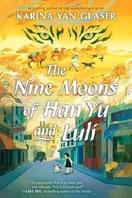
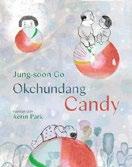
Glaser, Karina Yan | Allida/HarperCollins (432 pp.) | $19.99 | September 16, 2025
9780063284432
Thrilling, heartwarming adventures highlight commonalities that span centuries. (Historical fiction. 8-12)
Go, Jung-soon | Trans. by Aerin Park Levine Querido (128 pp.) | $21.99
March 4, 2025 | 9781646145140
An achingly lovely work laced with profound truths on love, death, and grief. (Graphic memoir. 10-14)
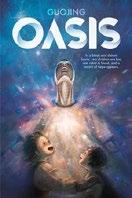
Guojing | Godwin Books (160 pp.)
$21.99 | $14.99 paper | February 18, 2025
9781250818379 | 9781250818386 paper
A thought-provoking, affecting allegory that reflects difficult realities yet is filled with love. (Graphic science fiction. 7-12)
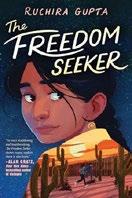
Gupta, Ruchira | Scholastic (320 pp.)
$18.99 | August 5, 2025 | 9781339012421
A riveting story of love, hope, and survival. (Fiction. 8-13)

Hale, Shannon | Illus. by Marcela Cespedes Colors by Lark Pien | Roaring Brook Press (240 pp.) | $22.99 | $12.99 paper
August 26, 2025 | 9781250843067
9781250843074 paper | Series: Dream On, 1
Heartfelt and accessible: another winner from a beloved author. (Graphic fiction. 8-12)
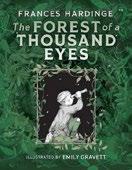
Hardinge, Frances | Illus. by Emily Gravett Amulet/Abrams (128 pp.) | $19.99
August 26, 2025 | 9781419777783
Sumptuous worldbuilding and deft plotting make for a harrowing dystopian story that nevertheless thrums with hope. (Fantasy. 8-12)


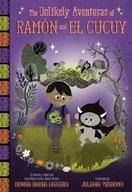

Hartman, Aubrey | Illus. by Marcin Minor Little, Brown (320 pp.) | $17.99
$8.99 paper | February 25, 2025 9780316575720 | 9780316575737 paper
Heartbreaking, marvelously funny, and generously redemptive. (Fantasy. 8-13)
Heilig, Heidi | Greenwillow Books (304 pp.) | $18.99 | March 25, 2025 9780063348363
A thrilling, thoughtful, and layered adventure story with fantastical elements. (Adventure. 8-12)
Higuera, Donna Barba | Illus. by Juliana Perdomo | Amulet/Abrams (160 pp.)
$14.99 | August 19, 2025 | 9781419777424
Beware the cucuy? Not when he’s this undeniably cool. (Fantasy. 7-10)
Higuera, Donna Barba | Illus. by Mariana Ruiz Johnson | Levine Querido (192 pp.) | $19.99
November 4, 2025 | 9781646147021
A magnificent spin on a well-known Aztec legend. (Mythology. 7-10)

Himmelman, John | Margaret Ferguson/ Holiday House (128 pp.) | $16.99
March 18, 2025 | 9780823458455
Overflowing with oomph and pizzazz, this collection will take up space in children’s minds for years to come. (Poetry. 7-12)
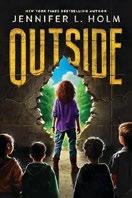
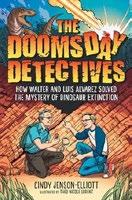


Holm, Jennifer L. | Scholastic (240 pp.) $17.99 | October 7, 2025 | 9781546138143
An ambitious and thrilling examination of survival, trauma, and connection. (Speculative thriller. 9-12)
Jenson-Elliott, Cindy | Illus. by Theo Nicole Lorenz | Tu Books (224 pp.) | $21.95 March 11, 2025 | 9781643791098
An outstanding resource. (Nonfiction. 10-13)
Kadarusman, Michelle | Pajama Press (224 pp.) | $18.95 | September 16, 2025 9781772783490
A well-realized story that shines a spotlight on an early feminist struggle. (Historical fiction. 9-13)
Kashiwaba, Sachiko | Illus. by Miho Satake | Trans. by Avery Fischer Udagawa | Yonder (152 pp.) | $18
May 27, 2025 | 9781632063922
Captivating and magical, with a dash of goodness baked in. (Fiction. 8-12)
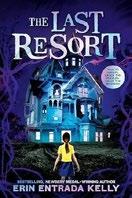
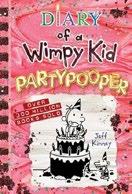

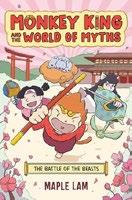
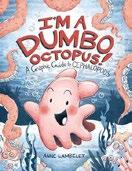
Kelly, Erin Entrada | Illus. by Naomi Franquiz Scholastic (240 pp.) | $17.99
September 2, 2025 | 9781546132431
Series: The Last Resort, 1
Hauntingly good and sure to possess any horror aficionado. (Paranormal. 8-12)
Kinney, Jeff | Amulet/Abrams (224 pp.)
$15.99 | October 21, 2025 | 9781419782695
Series: Diary of a Wimpy Kid, 20
A festive frolic—even if the frosting on the birthday cake does turn out to be mayonnaise. (Graphic/fiction hybrid. 8-12)
Lai, Remy | Henry Holt (240 pp.) | $22.99 $14.99 paper | January 14, 2025 9781250863300 | 9781250863294 paper
Honest, atmospheric, and full of heart. (Graphic fiction. 8-12)
Lam, Maple | Putnam (256 pp.) | $24.99
August 19, 2025 | 9780593524688 | Series: Monkey King and the World of Myths, 2
A stellar illustration of the timehonored, universal power of communication and mutual trust. (Graphic adventure. 8-12)
a
Lambelet, Anne | Graphic Universe (72 pp.) | $12.99 paper | March 4, 2025 9798765661376 | Series: Anne Lambelet’s Marine Life
Informative, buoyant, and wildly original. (Graphic nonfiction. 8-10)

Leavitt, Lindsey | Godwin Books (320 pp.)
$17.99 | May 20, 2025 | 9781250858528
Richly detailed and imagined; will invite repeat visits to harvest all the delights. (Fiction. 10-14)

Leigh, Lindsey | Penguin Workshop (96 pp.) | $17.99 | November 25, 2025
9780593889657
Burrows brilliantly into its topic with a will and a wink. (Graphic nonfiction. 8-12)
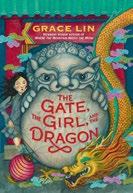


Lin, Grace | Little, Brown (352 pp.)
$18.99 | May 6, 2025 | 9780316478328
Captivating, thrilling, and emotionally satisfying. (Fantasy. 8-12)
Lukoff, Kyle | Dial Books (352 pp.) | $18.99 February 4, 2025 | 9780593618981
Powerful and awakening. (Fantasy. 10-14)
The
of the Photograph That Changed the Way We See Our Planet
Marcus, Leonard S. | Farrar, Straus and Giroux (160 pp.) | $21.99 | March 4, 2025
9780374392116
Provocative and thoughtful. (Nonfiction. 11-14)
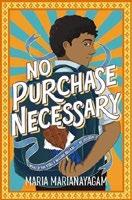
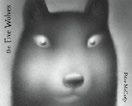
Marianayagam, Maria | Harper/ HarperCollins (256 pp.) | $18.99
January 14, 2025 | 9780063360921
Utter fun. (Fiction. 8-12)
Five Wolves
McCarty, Peter | First Second (288 pp.)
$24.99 | October 14, 2025 | 9781250170620
Striking and provocative. (Illustrated fiction. 10-adult)
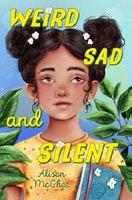

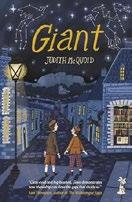
Weird Sad and Silent
McGhee, Alison | Rocky Pond Books/ Penguin (192 pp.) | $17.99 | May 6, 2025 9780593859674
A beautiful story of unvarnished honesty and tender hope—this courageous protagonist will capture every heart. (Fiction. 10-13)
of the Purple Pearl
McKinnon, Kate | Illus. by Alfredo Cáceres | Little, Brown (320 pp.) | $17.99 September 30, 2025 | 9780316555296
Series: The Millicent Quibb School of Etiquette for Young Ladies of Mad Science, 2
Unforgettably quirky, fast-paced fun. (Adventure. 8-12)
Giant
McQuoid, Judith | Little Island (224 pp.) $17.99 | June 3, 2025 | 9781915071637
A quietly charming, warmhearted story of enduring friendship. (Historical fiction. 8-12)

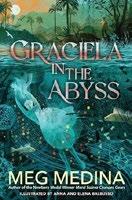
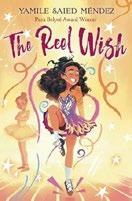

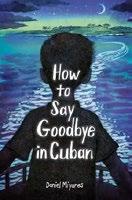
Meadows, Jodi | Holiday House (270 pp.)
$18.99 | October 21, 2025 | 9780823461226
A sweetly gratifying story that doesn’t shy away from moral complexities. (Fiction. 10-14)
Medina, Meg | Illus. by Anna Balbusso & Elena Balbusso | Candlewick (256 pp.)
$18.99 | July 1, 2025 | 9781536219456
A thrilling, action-packed journey filled with heart, bravery, and ghostly exploits. (Fantasy. 9-13)
Méndez, Yamile Saied | Tu Books (368 pp.)
$22.95 | April 22, 2025 | 9781643796437
A beautifully realized book that reminds readers that there’s more than one rhythm to dance to. (Fiction. 8-12)
Messner, Kate | Bloomsbury (288 pp.)
$17.99 | April 29, 2025 | 9781547616398
An adventurous work whose authentic voice celebrates the outdoors and everyday heroism. (Verse fiction. 10-14)
Miyares, Daniel | Anne Schwartz/ Random (240 pp.) | $21.99 September 30, 2025 | 9780593568293
A heartfelt, suspenseful story about family and resilience. (Graphic memoir. 8-12)



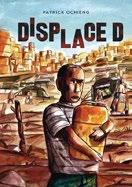
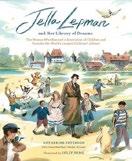
Monsef, Kiyash | Simon & Schuster (352 pp.) | $18.99 | February 4, 2025
9781665928533 | Series: Once There Was, 2
Breathless adventures in richly imagined settings—an entrancing sequel. (Fantasy. 10-14)
Mullarky, Alex | Kelpies (280 pp.) | $9.99 paper | February 4, 2025 | 9781782509172
A magically transcendent adventure that blends climate concerns with Celtic lore. (Fantasy. 9-12)
Nayeri, Daniel | Levine Querido (192 pp.) | $18.99 | September 16, 2025 9781646145669
A compelling testament to the power of education and empathy to light the way. (Historical fiction. 8-12)
Ochieng, Patrick | Carolrhoda (224 pp.)
$18.99 | August 5, 2025 | 9798765648698
Outstanding. (Fiction. 10-14)
Paterson, Katherine | Illus. by Sally Deng Chronicle Books (112 pp.) | $21.99 February 4, 2025 | 9781452182629
A stirring, singular tribute to a woman well aware of the importance of children’s books in times of trauma and recovery. (Biography. 8-12)
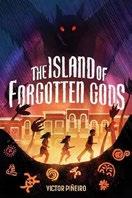
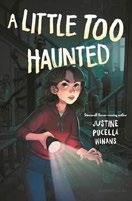
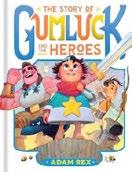
Piñeiro, Victor | Sourcebooks
Young Readers (304 pp.) | $16.99
August 5, 2025 | 9781728230559
An action-packed story of legacy, identity, and the enduring spirit of Puerto Rico. (Fantasy. 9-13)
Pucella Winans, Justine | Bloomsbury (272 pp.) | $17.99 | September 30, 2025 9781547616343
Sweet meets spooky—and it’s absolutely spectacular. (Horror. 9-12)
Rex, Adam | Chronicle Books (144 pp.)
$14.99 | April 29, 2025 | 9781797214528
Series: Gumluck the Wizard, 3
Funny, smart, and shot through with truly admirable exploits. (Fantasy. 8-10)
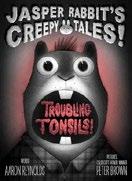
Reynolds, Aaron | Illus. by Peter Brown
Simon & Schuster (88 pp.) | $13.99
September 2, 2025 | 9781665961080
Series: Jasper Rabbit’s Creepy Tales!
Extraordinary introductory terror, beautiful to the eye and sure to delight younger horror enthusiasts. (Early chapter book. 6-9)
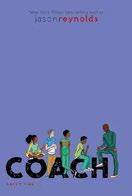
Reynolds, Jason | Caitlyn Dlouhy/ Atheneum (256 pp.) | $17.99
October 14, 2025 | 9798347102372
Series: Track, 5
A beautifully executed victory lap for a beloved series. (Historical fiction. 10-14)


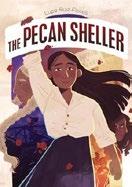

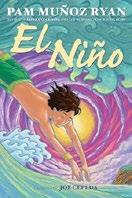
Rhodes, Jewell Parker | Illus. by Olga Ivanov & Aleksey Ivanov | Little, Brown (256 pp.) | $17.99 | January 14, 2025
9780316299336
An exciting gallop through real history with little-known heroes taking the lead. (Historical fiction. 8-12)
Rossell, Judith | Dial Books (320 pp.) $18.99 | May 27, 2025 | 9798217002405
Cinematic, amusing, and exciting: a slightly subversive, delightfully empowering, all-around winner. (Mystery. 8-12)
Ruiz-Flores, Lupe | Carolrhoda (256 pp.) $18.99 | April 1, 2025 | 9798765610527
A poignant, beautifully written tale. (Historical fiction. 10-14)
Rundell, Katherine | Illus. by Ashley Mackenzie | Knopf (304 pp.) | $15.99
September 11, 2025 | 9780593809907
Series: Impossible Creatures, 2
A spectacular return to a magical world. (Fantasy. 10-15)
Ryan, Pam Muñoz | Illus. by Joe Cepeda Scholastic (256 pp.) | $18.99
May 6, 2025 | 9781338068559
A compelling tale of love, loss, and myth. (Fiction. 8-13)

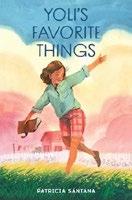
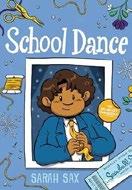


Safadi, Shifa Saltagi | Illus. by Aaliya Jaleel
Putnam (128 pp.) | $16.99 | May 20, 2025
9780593699225 | Series: Amina Banana, 1
A winning series starter with layers of depth. (Chapter book. 7-10)
Santana, Patricia | Margaret Ferguson/ Holiday House (272 pp.) | $18.99
September 30, 2025 | 9780823459483
A resonant story that beautifully captures the complexities of faith, family, and growing up during turbulent times. (Historical fiction. 10-14)
Sax, Sarah | Colors by Liana
Sposto | Knopf (288 pp.) | $21.99
August 26, 2025 | 9780593306963
Series: The Brinkley Yearbooks, 3
Emotionally astute and sure to inspire readers to embrace dancing to their own beat. (Graphic fiction. 8-12)
Scanlon, Liz Garton | Illus. by Dung Ho Knopf (128 pp.) | $16.99 | July 8, 2025
9780593644539 | Series: Bibsy Cross, 4
Poignant, funny, and perceptive—a lovely conclusion to a gem of a series. (Chapter book. 6-9)
Shang, Wendy Wan-Long
Scholastic (224 pp.) | $19.99
June 3, 2025 | 9781546115380
A heartwarming coming-of-age tale about swimming, sisterhood, and principles. (Fiction. 8-12)

Sky
Shulevitz, Uri | Farrar, Straus and Giroux (160 pp.) | $19.99 | August 19, 2025 9780374392468
Quietly potent and intensely empathetic. (Nonfiction. 10-18)
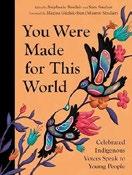
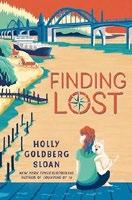
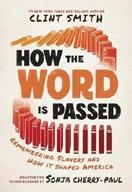
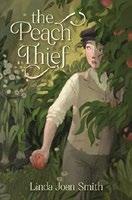
You Were Made for This World: Celebrated Indigenous Voices Speak to
Ed. by Sinclair, Stephanie & Sara Sinclair Tundra Books (120 pp.) | $21.99
July 29, 2025 | 9781774882566
These entries reverberate powerfully, both individually and as a whole. (Anthology. 8-12)
Sloan, Holly Goldberg | Rocky Pond Books/Penguin (208 pp.) | $17.99
October 7, 2025 | 9780593530252
Heartwarming and hopeful— readers will treasure this story of family and resilience. (Fiction. 9-12)
the Word
Smith, Clint | Adapt. by Sonja Cherry-Paul Little, Brown (272 pp.) | $18.99
September 2, 2025 | 9780316578509
Phenomenally executed. (Nonfiction. 10-14)
Peach Thief
Smith, Linda Joan | Candlewick (384 pp.) $19.99 | March 4, 2025 | 9781536237788
Nuanced, richly atmospheric, and exquisitely written. (Historical fiction. 9-13)

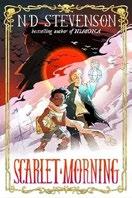
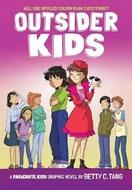


Song, Mika | Random House Graphic (160 pp.) | $20.99 | October 28, 2025
9780593303153
A deeply satisfying adventure for readers young and old. (Graphic animal fantasy. 6-10)
Stevenson, ND | Quill Tree Books/ HarperCollins (432 pp.) | $19.99
September 23, 2025 | 9780063210349
Series: Scarlet Morning, 1
Engaging, exciting, and enthralling in equal measure. (Fantasy. 8-12)
Tang, Betty C. | Graphix/Scholastic (288 pp.) | $24.99 | April 15, 2025
9781338832723 | Series: Parachute Kids, 2
Tugs at the heartstrings and will spark important, age-appropriate conversations on pertinent, broadly relevant topics. (Graphic fiction. 9-13)
Telgemeier, Raina & Scott McCloud
Colors by Beniam C. Hollman
Graphix/Scholastic (288 pp.)
$24.99 | April 1, 2025 | 9781338777222
Highly imaginative and cleverly conceived. (Graphic fiction. 8-13)
Thomas, Kiah | Illus. by K-Fai Steele Neal Porter/Holiday House (48 pp.)
$16.99 | May 27, 2025 | 9780823457809
Series: Lone Wolf, 3
Another can’t-miss outing with an irresistible, introverted antihero. (Early reader. 6-9)
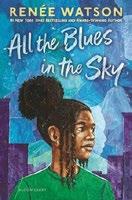
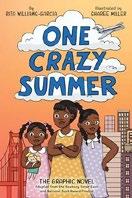
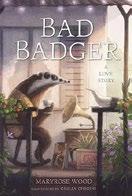
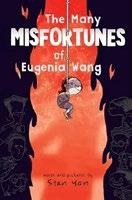

Watson, Renée | Bloomsbury (208 pp.)
$17.99 | February 4, 2025 | 9781547605897
A heartfelt portrait of the complexities of grief and the indomitable human spirit. (Verse fiction. 10-14)
Williams-Garcia, Rita | Illus. by Sharee Miller | Quill Tree Books/HarperCollins (304 pp.) | $15.99 paper | May 6, 2025 9780062935588
A fresh take for a beloved story that will introduce it to a wider audience. (Graphic historical fiction. 8-12)
Wood, Maryrose | Illus. by Giulia Ghigini Union Square Kids (192 pp.) | $18.99 February 25, 2025 | 9781454953456
Series: Bad Badger, 1
A tender friendship tale with a luster all its own. (Fiction. 7-10)
Yan, Stan | Atheneum (264 pp.) | $24.99 September 30, 2025 | 9781665943338
Slightly spooky and filled with humor and heart. (Graphic fiction. 8-13)
Yong, Ed | Adapt. by AnnMarie Anderson | Illus. by Rebecca Mills
Bright Matter Books (272 pp.) | $24.99 May 13, 2025 | 9780593810880
An insightful and informative look at the animal kingdom. (Nonfiction. 10-14)


THERE’S NO ONE more powerful than a children’s book author. These writers help young people understand topics like death and pain, make long-ago historical events come alive, and elicit peals of laughter. The Best Children’s Books of 2025 go even further—these works will transform kids into lifelong readers.
If a picture book is a dance between words and art, then Matthew Burgess’ Fireworks (Clarion/HarperCollins, May 13) is the literary equivalent of a perfectly executed pirouette. Two siblings spend a summer day roaming the city before taking in fireworks on the roof. Burgess’ onomatopoeia-filled prose explodes with a joie de vivre matched by Cátia Chien’s richly saturated images; author and illustrator depict a slew of urban summer pleasures, from a juicy watermelon to a romp through a fire hydrant’s refreshing spray.
Arriving as censors continue to wage war on books that offer authentic, nonwhitewashed views of the past, Nikkolas Smith’s The History of We (Kokila, May 20) feels especially crucial. Smith pairs spellbinding verse with startlingly intimate paintings

as he pays tribute to humani ty’s beginnings on the African continent. Backmatter explains that each of his images, whether depicting early people’s cave paintings, musical innovations, or scientific breakthroughs, references strides made by actual cultures.
Those who think picture books are all sweetness and light would do well to read Cecilia Heikkilä’s The Slightly Spooky Tale of Fox and Mole, translated from Swedish by Polly Lawson (Floris, August 5). In this wonderfully layered tale, well-meaning but self-centered Mole learns a lesson in friendship when Fox becomes fed up with his pal’s thoughtlessness. Heikkilä’s images are positively unnerving as Fox undergoes a bizarre transformation one evening. Slightly spooky? Absolutely, but this one’s all heart, too.


Seeking compelling middle grade? We’ve an embarrassment of riches this year. Renée Watson’s long been an author who goes where others fear to tread, and All the Blues in the Sky (Bloomsbury, February 4), which follows 13-year-old Sage as she mourns her best friend’s death, is no exception. Wracked by guilt and pain, Sage lashes out at the members of her support group. The result is an incredibly layered depiction of grief—messy, often ugly, but also rooted in Sage’s abiding love for her best friend.
Heidi Heilig’s middle-grade debut, Cincinnati Lee, Curse Breaker (Greenwillow Books, March 25) is both a witty, page-turning adventure and an accessible introduction to the unethical looting of world treasures, many of which end up displayed in Western museums or hidden in private collections. Cincinnati, a white
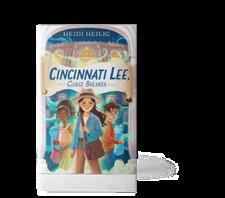

and Chinese American girl from New York City, tries to undo a family curse by repatriating a Peruvian artifact stolen by her archaeologist forebear. This rollicking tale, enlivened by Cincinnati’s wise-beyond-her-years voice, is equal parts provocative and sheer madcap fun.
With the graphic novel Cabin Head and Tree Head (Tundra Books, September 30), Scott Campbell transforms goofiness into an art form. Inhabiting a world populated by genial creatures who all sport something bizarre atop their heads (plants, telephone poles, treasure chests), the titular friends live their best lives; for this winsome pair, even something as simple as greeting their pals is cause for sheer, unadulterated glee.
Mahnaz Dar is a young readers’ editor. Laura Simeon contributed to this column.
Once one of the largest lakes on Earth, the Aral Sea has all but vanished from the map.
At the end of the Ice Age, melting glaciers form the great Aral Sea between Kazakhstan and Uzbekistan. The people call it “Mother Sea,” though it’s really a massive freshwater lake. Mother Sea offers her people the biggest fish to eat, provides them with clean water to drink, and lends her banks to bustling cities. But eager for more, the people take and take Mother Sea’s resources until nothing remains of the great lake but a vast desert whose soil is filled
with toxins. In spare, thought-provoking prose, this microhistory of the Aral Sea delivers a cautionary tale about the consequences of exploiting our planet. Rendered in blues and sandy browns, Mirtalipova’s striking pastel illustrations lend the story a swirling, fairy-tale quality, while swaths of arresting red mark the moment the people begin to drain the sea’s abundance, shifting the tone from dreamy to foreboding. Minimalist storytelling and in-depth backmatter work in tandem to create a book that will speak to a wide range of readers as it
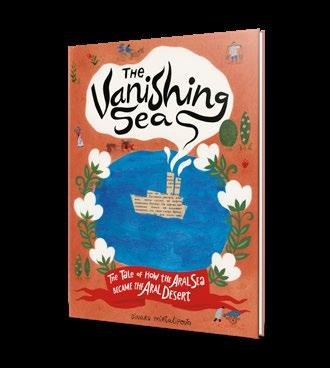
Mirtalipova, Dinara | Chronicle Books | 40 pp. $18.99 | February 3, 2026 I 9781797224596
highlights the devastating loss of such a resource in only a few decades. Illustrated figures are Central Asian with brown skin and dark hair; an author’s note includes photos of
Mirtalipova’s own family, hailing from Uzbekistan. A moving, memorable book that washes over readers with a call to stewardship. (timeline) (Informational picture book. 6-9)
Kirkus Star
Ackerman, Sara Holly | Illus. by Galia Bernstein | Knopf (32 pp.) | $18.99
January 13, 2026 | 9780593811061
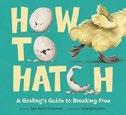
T his step-bystep overview of hatching addresses a gosling embryo directly.
Ackerman’s text cleverly oscillates between two registers: playful secondperson commands to the unhatched bird (“Aim your egg tooth. Jab. Inhale”) and factual sidebars explaining embryonic development. This dual-track approach accommodates varied attention spans and developmental stages; younger listeners can follow the energetic main narrative with its satisfying verbs (“UNZIP!” “PIP!” “KAPOW!”), while older children can absorb the scientific details in the teal-bordered text boxes. The vocabulary delights, with phrases such as “pipping muscle,” “ta-tap,” and “don’t dawdle.” Bernstein’s digital illustrations make wonderful use of negative space, isolating the cream-colored egg and golden gosling against clean white backgrounds that focus attention on minute anatomical details and incremental progress. Bernstein’s rendering of textures proves particularly effective—the gosling’s down shifts convincingly from slick, matted wetness to airy fluffiness. The baby’s parent demonstrates subtle shifts in posture and expression (vigilant neck stretching during pipping, tender head-tucking with hatchlings) that convey attentiveness without anthropomorphizing. Cross-section views inside the darkened shell rely on dramatic chiaroscuro to illuminate the cramped embryo’s struggle, creating visual tension that culminates in a lovely payoff as the gosling emerges at last.
A scientifically sound and artfully executed introduction to avian biology imbued with both wonder and accuracy. (glossary, author’s note, selected sources) (Informational picture book. 3-7)
A high-flying, illuminating celebration of kites, culture, and connection.
A
YEAR OF KITES
Adler, David A. | Illus. by Rob Shepperson
Holiday House (40 pp.) | $19.99
January 20, 2026 | 9780823455508
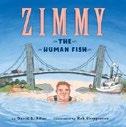
Russian American swimmer Charles Zibelman wowed audiences with his stamina and flair for drama.
Born in St. Petersburg in 1893, Charles (later nicknamed Zimmy) soon relocated to Chicago; like other Jewish families targeted by pogroms, the Zibelmans fled the country for a better life. At age 9, Charles was hit by a trolley, and his legs were amputated. Undaunted, he attached a roller skate to a board and propelled himself with his arms. He made money by offering swimming demonstrations (his missing legs allowed him to bounce “like a cork” in the water). Dubbing himself Zimmy, the Human Fish, he performed at carnivals and competed in international endurance contests. Noting his declining American audiences, the cigar-smoking showman decided to do something impressive in 1937: swim the Hudson River for 145 miles from Albany to New York City. After six days, he succeeded, setting a new record. Shepperson’s cartoon illustrations vividly convey both setting and Zimmy’s determination, while Adler’s text is upbeat and engaging, with well-chosen biographical details (for instance, Zimmy’s insistence that “cigars were as important to him as goggles”). The book’s final lines, however, offer a dubious takeaway: “Zimmy was unique. He refused to allow his disability to limit him.” Adler risks implying that disabled people facing societal or physical barriers
simply aren’t trying hard enough. Most figures, including Zimmy, present white.
An absorbing introduction to a talented showman and athlete, marred by a problematically framed conclusion. (source notes) (Picture-book biography. 6-8)
Alexander, Heather | Illus. by Sally Walker Union Square Kids (112 pp.) | $16.99
January 6, 2026 | 9781454961703

A timely tribute to the life and discoveries of the renowned primatologist and animal activist. Published without mention of Jane Goodall’s death in October of 2025, this record of her achievements offers a wellrounded picture of both her career and the scope of her intellect. Taking an interactive approach, Alexander divides her narrative into 10 chronological sections—inviting readers at the end of each to, for instance, sharpen their own powers of observation and keep a nature notebook like Jane did as a child, or more generally to think about the value of her patience and perseverance, to appreciate the significance of her discoveries about chimpanzee communication and family dynamics, and to follow her example by learning about animals and then taking action to protect them. Radiating confidence and warmth, Goodall’s slender blond figure poses gracefully in Walker’s illustrations with childhood friends and adult coworkers, amid groups of
expressive, individually drawn wild chimps, and later with her own darker-skinned grandchildren. In a fetching final scene, she celebrates her 90th birthday on a beach with a multiracial, multigenerational crowd of friends and supporters—and 90 dogs! Appealing and inspiring. (timeline) (Picture-book biography. 7-9)
Angleberger, Tom | Abrams Fanfare (96 pp.)
$14.99 | March 24, 2026 | 9781419772825
Series: Dino Poet, 2

In a second round of Mesozoic mischief, two prehistoric poets continue to hone their craft while trying to avoid being eaten by toothy critics. Having established in the opener that being “Poetry Pals” is far better than being predator and prey, Coelophysis and Frog set off to see the world and learn to write about it. They start by alternating spontaneous rhyming lines, advance to two-word poems that they dub “Blue Poos,” and finish up with “sound poems” created with a chorus of hooting, honking Parasaurolophus. Along the way, a supposedly bad—but really funny—poem (“How does a T-Rex pick his nose? / Arms too short, so he uses his toes!”) leads to a frantic flight from its irate subject, while an Archeopteryx named Hope drops in and out of view to fuel bits of wordplay and a wistful concrete poem from smitten Coelophysis: “I hope / to see / Hope / soon / and / hopefully / Hope / hopes / what I / hope.” Like the poems, the illustrations seem both simple and unpolished at first and, OK, second glances. But the hand-lettered verses and the googly-eyed dinos, both of which Angleberger places on layered swatches of creased and deckle-edged paper for a 3-D look, carry more than enough vim to leave budding poets roaring to join this brand-new writer’s group in its collective closing “ALL RIGHT!!!! Let’s WRITE!!!”
More sly poetry prompts, embedded in a raucous romp. (author’s note, further reading) (Graphic fiction. 7-10)
Ata, Iasmin Omar | Viking (256 pp.)
$24.99 | $13.99 paper | January 13, 2026 9780593117149 | 9780593117156 paper

An eighth grade girl who perceives emotions as flowers seeks to piece together the origin of her ability. Ever since Marlena Haddad can remember, she’s possessed an ability to see flowers that are visible only to her. They appear on herself and on other people to reveal their true feelings. When Marlena was younger, she tried to tell people about the flowers time and again, but no one believed her, leaving her feeling lonely and overwhelmed. When larger-than-life, nonbinary Ashe Lang transfers to Marlena’s middle school, Marlena soon learns that they not only see flowers on people too, but there’s also a mysterious connection between their pasts. Marlena hopes that getting to know Ashe will help her unlock the secret of why they share this strange, unwanted burden. But “asking Ashe about the flowers made them snap, somehow,” and now Ashe is actively avoiding her. Marlena’s journey to unlock her past, overcome what seems akin to a form of emotional synesthesia, and find healing drives an interesting plot; however, the adamant refusal by both young people’s parents to provide them with mental health support earlier feels deeply troubling. Ata’s mangalike digital illustrations are visually stunning, especially the beautifully detailed florals and the highly saturated, intensely colored dream sequences during which Marlena’s subconscious works to piece together fragments of a forgotten history. Brown-skinned, pink-haired Marlena is cued as being of Middle Eastern descent, while blue-haired Ashe presents white.
An earnest effort carried by visually impressive graphics. (Graphic fantasy. 8-12)
Bajaj, Monisha | Illus. by Amber Ren Bloomsbury (40 pp.) | $18.99 February 17, 2026 | 9781547612246

For almost 3,000 years, humans have flown kites in cultures across the globe. Beginning in January and continuing throughout the year with the repeated phrase opener “Kites fly high,” each spread features a child from a different part of the world, highlighting the seasonal, cultural, and historical significance of kite-flying in that region. Bajaj’s buoyant text is peppered with fascinating historical facts. The introduction of a fictional character on each spread makes the work even more accessible to a young audience: In Gujarat, India, during the festival of Uttarayan, Asha launches her kite from a balcony, using its sharp string to cut other kites down. In Maui, Hawaiʻ i, King Kamehameha once flew 100 kites all at once to honor the God of the Harvest. Ren’s digital illustrations depict doe-eyed cartoon youngsters and families flying intricate and colorful kites of all shapes and sizes amid vibrant ink wash landscapes. Characters are diverse in skin tone and clothing. Informative backmatter offers more context on the history of kites, a glossary, and a DIY kite tutorial, but blank world maps on the endpapers are a missed opportunity to geographically pinpoint the book’s featured locations. A high-flying and illuminating celebration of kites, culture, and connection. (Informational picture book. 4-7)

Baldridge, Grace Semler | Illus. by Fran Alvarez | Beaming Books (32 pp.) | $18.99
March 10, 2026 | 9798889836476

An introduction to the idea of a higher power for young children and the adults sharing this book with them.
Some questions are easy for parents to answer. Others are tough: “How did we get here? / Who made the earth grand? / Were humans haphazard / or something preplanned?” While Baldridge doesn’t provide those answers, she does broach the concept of divine love, which connects people to each other and which young people can connect to in many ways; prayer is one. The author neatly works in Luke 6:38: “The Love that you give / finds its way back to you.” Alvarez illustrates this point with an image of two friends exchanging a steaming mug for a cupcake: “So be kind to your neighbor. / Treat friends with respect. / Lend a hand or a favor. / Share a laugh and break bread.” Her artwork uses vibrant color, often not natural (i.e., a vivid orange pond, bright-red trees) and depicts family and friend groups of all types, diverse in skin tone and ability. While the hit-or-miss verses may be above young children’s heads in some cases, the work serves as a starting point for adults looking for ways to introduce kids to the concept of a higher power.
Not answers, but a basis for the conversations that will help kids understand and express their faith. (author’s note) (Picture book. 4-9)
Black, Michael Ian | Illus. by Debbie Ridpath Ohi Simon & Schuster (40 pp.) | $19.99 | February 24, 2026 | 9781665915243 | Series: The I’m Books

Actor, comedian, and writer Black and illustrator Ohi team up once more, this time for the story of an overscheduled youngster who must make time to relax.
The pigtailed young girl from the creators’ previous collaborations— among them I’m Bored (2012), I’m Sad (2018), and I’m Sorry (2021)—is fretting. The child’s friends—a flamingo and a sentient potato—want to have fun. But each time her pals propose a new activity, the girl has the same response: “I’m busy.” She has coding projects to finish, science experiments to try, and trumpet practice to attend; there’s never enough time. Plus, school is starting soon, and as the youngster frantically notes, “I’ve only got twelve years before college applications are due!” (Chuckle-worthy to be sure, but also, worryingly, this statement rings true.) Luckily, the tot finds the key—balance. (“Like balancing on one leg?” the flamingo asks, hopefully.) After flopping on the ground from pure exhaustion, the child recognizes the importance of taking time for oneself and friends. Deftly expressed stylistic choices from previous works are echoed here: color-coded text, one full spread of overwhelmed yelling (filled with oversize words), and, of course, the inevitable, full-circle moment: “I’m bored.” The child’s feelings are perhaps most effectively captured on Ohi’s brilliant endpapers, where the word
Forget bacon and eggs— Milwaukee mornings during WWII began with baseball.
busy grows, multiplies, and crowds the edges. The protagonist has skin the white of the page.
A sound reminder for all—both kids and the adults who are responsible for scheduling their time. (Picture book. 4-7)
Brewer, Z | Quill Tree Books/HarperCollins (288 pp.) | $18.99 | October 7, 2025
9780063245778 | Series: The Chronicles of Viktor Valentine, 2

A serious threat returns in this second series entry. Seventh grade still isn’t going well for Viktor. He got suspended following an accident involving his longtime bully, his best friend is acting chummy with said bully, Alys (his Slayer friend) hasn’t talked to him since the night they confronted manipulative vampire Lilith (whom Viktor impaled), and he hasn’t really discussed with his mom and dad their revelation that they’re vampires (very famous ones, in fact). The only good things to happen recently are his winning a copy of his favorite band’s new vinyl album and making a new friend, a centuries-old vampire who lives in the mausoleum that sits in a park in their town of Nowhere. Then Viktor receives a suspicious invitation from Lilith to attend a dinner party that’s most likely a trap. Meanwhile, Alys is haunted by memories from the eventful night with Lilith and burdened by her father’s demanding expectations. It’s a lot. Viktor, who experiences social anxiety, is likeable and his struggles are sympathetic, but the characters at times make decisions that don’t seem logical or consistent with their emotional truths. The climactic dinner party scene strains credulity and feels out of sync with the stakes established earlier, and the plot makes some disorienting detours that have little
payoff. Fans of Buffy the Vampire Slayer will enjoy spotting some easter eggs. Main characters read white. Let down by confusing characterization and apparently unconnected threads. (Paranormal. 8-13)
Briner, Karen | Holiday House (304 pp.) $17.99 | March 18, 2025 | 9780823456444
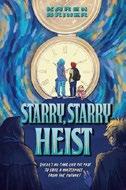
Thwarting a sinister time traveler’s ingenious scheme to steal great art gives two young strangers a common cause. Struggling to care for his mom, who’s suffering from serious and undiagnosed health issues, as well as dealing with being lonely and bullied, 12-year-old Maximum Rose-Rodriguez finds himself on an urgent mission. First he finds a cryptic note—in his own handwriting— inside a sandwich from a neighbor. Then he meets mysterious art historian Dr. Syzygy (“but you can call me DZ”), who tells him that Vincent van Gogh’s The Starry Night , which is slated for exhibit at Los Angeles’ nearby Griffith Park Observatory, is in danger—and that saving the painting would also help his mother. Max’s adventures take him on a wild ride that includes multiple trips back to 1889 for meetings with van Gogh himself. Briner packs in so many underdeveloped subplots that her main storyline struggles for visibility. Fortunately, the book includes numerous scene-stealers, including Max’s new friend and ally, Maybe Wells, an exuberant, blue-haired trans girl, as well as a rescued pet octopus and a memorable villain. Even if the baddie’s scheme collapses with convenient ease, the ending will leave art lovers pleased and reassured. Brown-skinned Max’s name cues some Latine heritage, and Maybe presents white.
Severely overstuffed with themes and subplots but will nonetheless stretch readers’ imaginations. (Science fiction. 9-13)
Campbell-Smith, Judy | Illus. by Maggie Carroll | Charlesbridge (32 pp.) | $17.99 February 17, 2026 | 9781623545703

Forget bacon and eggs—Milwaukee mornings during World War II began with Brewers baseball. Before the United States
entered the war, a young Black boy named Jimmy loved walking to the stadium with his Ma and Pop to watch the Milwaukee Brewers play. But in 1941, Pop joins the Navy and Ma starts to work nights at the factory as women across the country become part of the workforce. Jimmy misses going to baseball games. One evening, he’s surprised by an offer of free tickets from the Brewers owner himself, Mr. Bill Veeck. Jimmy declines because his Ma is at work, giving Veeck an idea. Soon the news breaks that the Brewers will play morning games and offer free admission for night-shift workers. At the first game, fans are delighted when Brewers coach Red Smith pops out of a four-poster bed right in the center field, clad in his pajamas, just before the first pitch. Vendors even sell coffee and cornflakes instead of frankfurters and popcorn. Though Jimmy and his family are fictionalized, a detailed author’s note explains the history of the Brewers’ morning games and addresses the choice to center the story on a Black protagonist, drawing attention to the often-overlooked Black women who joined the wartime workforce. Energetic scenes are described in upbeat prose and sketched with digitally rendered permanent marker outlines and a vintage colorway that evokes the period.
A playful baseball story with a helping of history. (bibliography) (Picture book. 5-7)
Kirkus Star
Cavallaro, Mike | Colors by Sarah Buck First Second (192 pp.) | $24.99 | $15.99 paper | February 10, 2026 | 9781250335944 9781250336019 paper | Series: Eowulf, 2

When mayhem erupts and a weapon of mass destruction falls into the wrong hands, Eowulf returns to save the day. In this second graphic offering following Eowulf: Of Monsters & Middle School (2024), New Jersey native Eowulf Wegmund (a descendant of Beowulf) is working at Vulcan’s Celestial Supply Shop. She receives an assignment from Vulcan, and not a moment too soon: She’d do just about anything to get out of cleaning her messy room. She’s tasked with guarding Balor’s Helm, a powerful helmet—and “one of the most destructive magical artifacts in history”— that’s being used as a prop on a movie set. At the Metropolitan Studios in Queens, she meets the monster stars Umo Klegginshredder and Vexla Verhoon. While on set, Eowulf learns that actors have been disappearing, including Umo’s dear friend Grogin Bransgoery—and when the helmet is stolen, Eowulf is on the case. Cavallaro’s sequel is bright and boisterous, blending vibrant, cinematic illustrations with engaging storytelling; it’s a great jumping-in point for new readers and a thrill for those already familiar with the first entry. Like its predecessor, this work features a strong emphasis on friendship and family, spotlighting the importance of human (and monster!) connection. Light-skinned, redheaded Eowulf is surrounded by a racially diverse supporting cast. The story draws from Irish, Finnish, and other world mythologies; fans of Rick Riordan’s expansive oeuvre will find much to enjoy here.
Two thumbs up for this delightful moviethemed romp. (Graphic fantasy. 8-12)
grant readers’ wishes for an enchanting, action-packed fantasy.
RELIC HAMILTON, GENIE HUNTER
Charles, Tami | Illus. by Meredith Lucius Charlesbridge (32 pp.) | $17.99 February 10, 2026 | 9781623545659
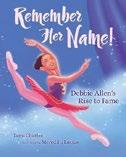
A picture-book salute to pioneering dancer Debbie Allen. “In the heart / of the Third Ward / of Houston, Texas, / beneath a star-covered sky… / the wind stirs its nighttime song / as Debbie begins.” Young Debbie starts to dance. But it’s the 1950s, and Black people face barriers: “White signs / painted with black words / with a message loud and clear: / people like Debbie / are simply not welcome here.” “Here” includes the local dance school. Debbie’s mother can’t abide the thought of her daughter’s wasted potential and dashed dreams, so “with the wind at their backs, / they cross the border, / feet planted on new soil.” Charles’ poetic approach to biographizing Allen’s childhood is lovely, though at times it relegates details to the backmatter: The “new soil” where Debbie and her mother relocate isn’t identified in the main narrative, for instance, though the author’s note clarifies that it’s Mexico City. Nor does the main text clue in readers about Allen’s considerable adult accomplishments; readers learn only that Debbie returns to Houston after “some years,” continues to dance, and ultimately enjoys a successful stage career: “Beneath the white-bright lights, / the music sings / as history unfolds.” Still, the verse sparkles, and the book’s reach-for-thesky imperative is reinforced by Lucius’ sleek and glossy digital art, in which
dancing Debbie is frequently flanked by twinkly stars.
Uplifting and glowing. (further resources, timeline) (Picture-book biography. 5-8)
Clark-Rhines, Yvonne & Monica ClarkRobinson | Illus. by Abigail Albano-Payton Quill Tree Books/HarperCollins (40 pp.) $19.99 | January 27, 2026 | 9780063251601
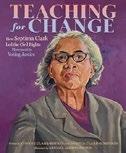
A n eloquent tribute to the character and achievements of a decidedly undersung mover and shaker of the Civil Rights Movement.
“Born poor. Born Black. Born a girl.” Septima Clark faced plenty of obstacles, but having learned peace from her daddy and strength from her mama, “Septima could always find a way.”
Growing up to become a teacher, she established a network of “citizenship schools” that by 1969 had helped over 700,000 Black students pass discriminatory voter registration tests and learn how to be community leaders and activists. Dr. Martin Luther King Jr. called her the Mother of the Movement and asked her to accompany him to Oslo to receive his Nobel Peace Prize. She went on battling discrimination of every sort, the authors conclude, even after the male leaders of the movement forced her to retire in 1970. “Mama Seppie” remains an icon, “the embodiment of Black Girl (Woman) Magic.”
Lyrics from the freedom song “Ain’t Gonna Let Nobody Turn Me ‘Round”
appear throughout. In stately oil paintings, Albano-Payton depicts Clark from grave child to formidable, gray-haired fighter—in schoolrooms, behind prison bars, on the march, and generally surrounded by equally serious, brown-skinned pupils and supporters of all ages. The work ends with notes from both co-authors; Clark-Rhines, Septima Clark’s granddaughter, pays tribute to her grandmother’s “perseverance, tenacity, strength, and…attitude of service for her people.”
Tardy, significant recognition. (timeline, select quotes)
(Picture-book biography. 7-9)
Kirkus Star
Relic Hamilton, Genie Hunter
Coelho, Joseph | Illus. by Hyun Song We Candlewick (288 pp.) | $19.99
February 3, 2026 | 9781536247978
Series: Relic Hamilton, 1

A 12-year-old British boy finds ancient magical lamps and unknowingly restarts a centuries-old supernatural conflict in the latest from former U.K. Children’s Laureate Coelho.
Relic Hamilton, who has Jamaican heritage and wears his hair in a tapered Afro, lives in London with his grandfather above Anansi Antiques, the Soho shop that’s been in their family for generations. It’s filled with treasures that Grandfather collected during his world travels. One day, when Relic is polishing metal objects in the basement, he accidentally releases a powerful evil genie from a brass lamp. Grandfather gets hurt, and Relic is swept up in a clandestine society of genie hunters. Time and space are upended as he’s pushed to his limits, searching for answers about what’s expected of him—a bullied kid who’s trying to save his grandfather and maybe even the whole world. Each short chapter opens with a few stanzas of poetry that set up Relic’s adventures and
provide a sampling of award-winner Coelho’s talents as a poet. The momentum of the storytelling, We’s full-page and spot art illustrations, and the combination of prose and poetry come together to create a portrait of an unlikely hero that unfolds in a fantastic middle-grade voice. Readers will arrive at the end impatient for the next series entry. Final art not seen. A trilogy opener that will grant readers’ wishes for an accessible, enchanting, action-packed fantasy. (illustrated character profiles) (Fantasy. 9-13)
Cooper, Abby | Illus. by Eliana Gutierrez Charlesbridge (32 pp.) | $17.99 March 10, 2026 | 9781623546427

An omniscient everybaby instructs other infants on the care and feeding of a new mother.
“Congratulations! It’s a… MOM!…You’ve introduced yourself, had a snuggle, and shared a meal. BUT…” A thought balloon reveals a newborn baby’s most pressing concern—“WHAT NOW?”— as the little one is cradled by Mom in a hospital bed. Fortunately, the narrator is here to walk a theoretical all-baby readership through Mom Care 101, dispensing both affirmations (“You’ve been preparing for this since you were the size of an avocado. If anyone can take good care of her, it’s you”) and practical advice (“Your new mom will require round-the-clock care, so it’s best to plan for staying up all night”). (Ah! So that’s why babies are awake at all hours.) In case it isn’t obvious by now, the book’s abundant humor is suited to adults familiar with new-parent agita (“Don’t plan on her wearing any one outfit for long. New moms are notorious for spit-ups and spills. It’s all part of the fun!”). While many kids will enjoy Gutierrez’s cartoonish digital art featuring adorable babies in a range of skin colors, some may be
confused rather than amused by images of the book’s despondent moms. In one such illustration, a “fussy” (crying, overwhelmed, and defeated) mother sits on the floor as a baby in a bouncy seat yowls across the room.
On-the-nose humor geared for new parents and precocious kids. (Picture book. 4-8)
Crull, Kelly | National Geographic Kids (32 pp.) $18.99 | February 3, 2026 | 9781426376221

What fearsome creature has hatched from that innocuouslooking egg? Juxtaposing artfully clipped stock photos with dino images, this tale invites young viewers to play a cleverly presented guessing game. Could the beady eye peeking out through a hole in the cracked shell belong to a…velociraptor? Do tracks leading away from bits of the broken eggshell mean that there’s a dinosaur loose in the book? Glimpses of “razor-sharp claws” and “bone-crushing jaws” lead to further speculation. It might be a T. Rex, “with a bite that could crush a car!” Or maybe a Utahraptor—“They used their claws as hooks to snare their prey, pin them down, and eat them alive!” writes the author with winning gusto. Or could it be a Deinonychus? “Their bite was as strong as the weight of 40 bricks pressing down on you.” Savvy readers will, of course, have caught the giveaway hint in the title, and a climactic photo of a chicken fixing its glance on a hapless earthworm (“The mighty Chick-o-saurus devours his prey”) will clue in the rest. An afterword lays out the dinosaur–chicken connection in detail, from the 19th-century discovery of the prehistoric bird Archaeopteryx to that of the feathered fossil Xiaotingia in 2011. An arresting prehistoric primer, with a charmer of a twist ending. (dinosaur pronunciation guide) (Informational picture book. 5-7)
Forty the Fortune Teller
Daywalt, Drew | Illus. by Kevin Cornell
Philomel (32 pp.) | $18.99
February 24, 2026 | 9780593691465

An epic quest to save the day begins with an unlikely hero. A folded paper fortune teller game discovers that she’s been abandoned on the school playground before anyone got a chance to use her. After she meets up with a partially eaten chip named (you guessed it) Chip, the two set off to return an errant bolt to a slide’s ladder. Along the way, they encounter various foes—a squirrel, a basketball, a cloud—each of whom is defeated as Forty tells them a ridiculous fortune (“Your bottom will turn into balloons and you will float away!”) that inexplicably becomes true. By the end, it’s clear that “Forty” doesn’t stand for “Fortune Teller” but for “Fortitude,” and the tale concludes with a tacked-on message about how everyone can write their own fortunes. Frankly, it doesn’t make a whole lot of sense. Throughout, Daywalt throws a wide variety of ideas onto the page with only the most tenuous strings of connection keeping the story together. Thematically, the book resembles his The Legend of Rock, Paper, Scissors (2017), illustrated by Adam Rex, yet it lacks that work’s cohesive and comprehensible storytelling, raising more questions than it answers. Cornell’s lively, comic book–style art tries in vain to wrestle Daywalt’s writing into some semblance of order. Comprehension sacrificed in the name of goofiness. (Picture book. 4-7)

A KID LIKE ME
Donnelly, Rebecca | Illus. by Misa Saburi
Henry Holt (112 pp.) | $16.99 | April 14, 2026 9781250805348 | Series: Survival of the Fittest
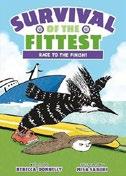
Six animals compete to show off useful ideas for improving human transportation. Donnelly and Saburi once more return to the premise established in their first series outing: Contestants taking part in a Shark Tank –esque game show wind up imparting information to eager readers. The ingenious way that human engineers theoretically might or actually do model technological advances on animal fins, feathers, and other features gives this latest installment a special spark. But the dazzle is less dazzling this time around, as too many of the nature-tech connections seem minor or more speculative than practical. It’s hard to get excited, for example, over a tiny refinement based on an owl wing edge that makes the electrical connector atop a high-speed train quieter, or a vague suggestion that software for driverless cars could replicate the ways swarming ants avoid bumping into each other. For laughs, Donnelly does introduce a comically aggressive bombardier beetle; she also adds a loud and witless megamouth shark to the tank of shark judges, but Saburi strains for visual gags in flurries of wordless, sometimes inscrutable nonsequential panels that interrupt the story’s flow. At last a winner is declared, and the author does provide fuller explanations of each contestant’s pitch, with a lead to further resources, at the end.
A step back from previous outings, though not without a few glimmers of wit and insight. (Graphic nonfiction. 8-11)
Evans, Gabriel | Viking (32 pp.) | $18.99 February 10, 2026 | 9798217038732

In this Australian import, a stuffed hippo tries to cheer up a young boy through elaborate imaginative adventures before discovering what the little one really needs. When young Billy tells Hippo he’s feeling sad, the well-meaning stuffed companion launches into a whirlwind of imaginative activities—dressing up in costumes, dancing among the cherry blossoms, embarking on pirate adventures, having flying carpet races, and planning a party. None of it works, and Billy at last reveals that he just wants a supportive friend to listen. Evans’ watercolor and colored pencil illustrations shine, particularly in the expansive double-page spreads. The pirate ship scene relies on diagonal composition and a massive curling wave to create drama and movement, while the flying carpet sequence employs aerial perspective over a bustling, colorful cityscape to convey breathtaking scope. Other scenes have an appealing retro charm reminiscent of early Olivia books. The text, however, isn’t quite as successful. Billy’s dialogue feels unnaturally adult (“It’s not what I need right now”), and the didactic message dominates the narrative rather than emerging organically. The book joins an increasingly crowded shelf of recent
picture books explicitly teaching emotional processing and active listening—though Evans’ artistic skill elevates it above many peers, the heavy-handed lesson-giving may wear thin for readers seeking genuine storytelling. Billy has dark hair and skin the white of the page. The artwork deserves attention, but the therapeutic agenda overshadows the narrative pleasure. (Picture book. 3-7)
Feuti, Norm | HarperAlley (272 pp.)
$24.99 | $15.99 paper | February 3, 2026
9780063354111 | 9780063354104 paper
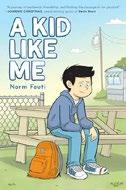
Adolescence is hard, humans are complicated, and despite best intentions, everyone has biases. Ethan and Ricky, friends since kindergarten, live in a trailer park with their financially struggling single moms. The white-presenting boys are worrying about navigating middle school, from finding their classes to being around “super snobby” rich kids from other towns in the district who they’ve heard will judge them for not being able to afford name brands. Ethan is embarrassed by his old-school flip phone. Ricky’s strategy is to assemble a crew of like-minded kids “who haven’t been spoiled their entire lives” to hang out with, and he quickly befriends Dillon, an edgy tough guy. Meanwhile, after some initial social setbacks, Ethan joins an afterschool club for the retro card game Bio Battle, where he meets a kind boy named Aiden. The club attracts a welcoming and racially diverse group, and Ethan is able to let his guard down. Of course, middle school isn’t easy, and this book doesn’t sugarcoat the challenges. Both Ethan and Ricky are hurt by others’ prejudicial attitudes toward their neighborhood. Feuti presents a complex and age-appropriate glimpse into social issues that will resonate with
many readers. His heartfelt author’s note describes the personal experiences that inform the story. Clean, straightforward panels allow the nuances of the story and the relatable and sympathetic characters’ emotions to shine.
An honest and authentic portrayal of navigating an underprivileged childhood. (Graphic fiction. 8-12)
Fier Jasinski, Jen | Illus. by Lisa Chow Doubleday (32 pp.) | $18.99 February 10, 2026 | 9780593518021
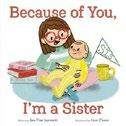
Getting ready to become a big sister, a child daydreams about the life she and her sibling will have together. The story opens with exciting new baby preparations like room decorating and selecting a name. But as the young narrator soon learns, her responsibilities really kick in once the baby is born. She imagines what the two of them will do when they’re older—for instance, creating an artistic masterpiece (on the wall) and hunting for treasure (under the couch cushions). On one poignant spread, the protagonist discusses all the feelings she’ll experience: excitement, pride, even jealousy. And though from time to time the siblings will have had enough of each other, they’ll also savor plenty of tender, loving moments. Chow’s illustrations bring Fier Jasinksi’s text to life, adding comic relief and providing specific context for more generalized lines. “We’ll spend a lot of time together. And I mean a lot. Sometimes, we might wish for less” is transformed into a scene of the two buckled in car seats realistically mid-squabble. One parent and the baby have tan skin and light brown hair; the other parent and the big sister are pale-skinned. The younger sibling isn’t specifically gendered; a variety of older siblings will be able to see their experiences reflected. Realistic and hopeful, this title is ideal for parents eager to support a soon-to-be big sister. Lovingly and accurately captures the sibling bond. (Picture book. 4-7)
Florian, Douglas | Beach Lane/Simon & Schuster (40 pp.) | $19.99 | March 31, 2026
9781665966757
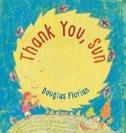
Verse and pictures expressing gratitude for nature’s gifts above, below, and all around. Sandwiched between circle poems addressed to the sun and its “magic mirror,” the moon, the veteran poet’s simply phrased rhymes offer thanks to 14 more wonders as vast as the stars, as small as snowflakes, and as varied as wildlife and landforms. Though characteristically incapable of passing up a pun—“How grand you stand, from base to crest. / Mountain, you peak my in-ter-est!”— Florian generally keeps to a reverent tone. “Thank you, Earth, where we all live. / You truly have so much to give.” His fancy flies more freely in the gouache and rubber stamp illustrations, which are done on paper bags and feature a multiracial cast of actively posed children lifting up the whole Earth, joyfully riding on the back of a huge bee, embracing a smiling thundercloud, or nestling in the crescent moon’s lap. Each short poem is distinct enough to stand alone, but with their unity of theme the verses can also be read straight through as articulations of a single feeling. Florian’s rhymes and rhythms fall so naturally that his lines never sound singsong; few poets can match him for readability or clarity of expression.
Gehl, Laura | Illus. by Julia Patton
Beaming Books (32 pp.) | $17.99
February 10, 2026 | 9781506492254
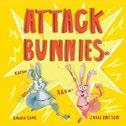
When Renard Fox moves into the neighborhood, two rabbits get ready to defend their community. Carrot Cake and Pufftail may look like “ordinary, cute little bunnies,” but these “whiskered warriors” are “trained to protect, to defend, and—when needed—to attack.” Their help is sorely needed: Newcomer Renard awakens Agatha Owl from her afternoon nap, hurls acorns at Sammy Squirrel, and chases the chipmunks. Worst of all, the bunnies overhear him scheming to steal Mrs. Quail’s eggs. Happily, our heroes opt for nonviolent tactics. Pufftail’s hypnotic words convince the fox to instead gobble up some walnuts—though he soon makes his way toward Mrs. Quail’s nest. Now the bunnies use another method: luring Renard into a lake via baked goods on a fishing line. When Renard emerges—sobbing and soliloquizing— the bunnies realize that the animals have misunderstood his awkward attempts to befriend them. All except poor Mrs. Quail; the fox admits that “If I can’t have any friends, at least I can have some scrambled eggs!”
Pufftail and Carrot Cake then invite Renard to a friendly picnic—with the caveat that he permanently stay away from Mrs. Quail and her eggs. Gehl’s gently humorous text flows well, offering messages of withholding judgment and welcoming strangers. Patton’s garish artwork ramps up the humor, with dramatically
More serious than silly, and vintage Florian. (Picture book/poetry. 5-8) >>>
Few poets can match Florian for readability or clarity of expression.
THANK
YOU, SUN

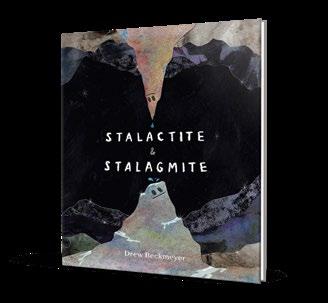
Drew Beckmeyer
By Corey R. Tabor
Matthew Forsythe

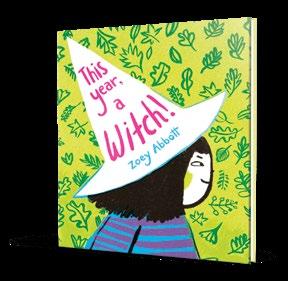
By Zoey Abbott


The author/illustrator of Mistaco answers our questions.
COMMUNICATING OUR exuberance over Mistaco , illustrator Eliza Kinkz’s picture book debut as an author, would take about 123 exclamation points. What we can offer in lieu is our starred review, naming Mistaco “a deliciously effervescent celebration of family and resilience,” as well as a spot on our list of the Best Picture Books of 2025. Kinkz told us more about the book by email.
skipping around with joy as I did the final paint strokes!
What inspired you during the writing process?
My Lita and Lito’s tiny house—and truly understanding as an adult what a miracle it was that all of us were able to fit in there. No wonder I have so many memories of happily eating under the kitchen table! But, it was such a safe place to create and be myself: a loving home that gave me the gift of playfulness that I still hold tight to and cartwheel into my creative process.


What was the original idea that started you working on Mistaco?
Definitely memories of making tortillas with my Lita and Lito (my grandparents), and how I could not roll out a round tortilla to save my life! I probably should have just tried SITTING on them! But my Lito would ease my frustration over my weird misshapen tortillas by simply saying, “I’ll eat all your mistakes, mamita!”
This is the first picture book you’ve written as well as illustrated. What’s the best thing about illustrating your own story? That I could spill as much queso on my artwork as I wanted! But, to be truly honest, it was that this book was all ME—200% Eliza KINKZ, bebé!! Usually, I try to keep my illustrations very simple for humor purposes, but this time I played with having patterns, as I had this urge to show extra affection to the illustrations—probably because there is so much of my family and childhood in this book. It’s truly a love letter to mi gente in Texas! No wonder I was
Where and when did you write?
In my treehouse, after I assemble a comfy, warm pile of 123 breakfast tacos to sleep on top of. Don’t worry!! They are each wrapped in foil as I roll around on them. Otherwise, it would be super gross when I ate them all later.
What was most challenging about writing the book?
The goat that would keep stealing it. (What a jerk!!) Also, patience with the revision process. As I tend to think that anything I write IS THE BEST VERSION OF A STORY IN THE HISTORY OF STORIES!!! (Maybe a publisher will make a book from this article?)
What books published in 2025 were among your favorites?
The Lone Wolf series (by Kiah Thomas, illustrated by K-Fai Steele) is HILARIOUS! Why is there not more talk about these books?! Grrrrrrrrrr.
Anything (by Rebecca Stead, illustrated by Gracey Zhang) was

Mistaco Kinkz, Eliza Kokila | 40 pp. | $18.99 April 1, 2025 | 9780593700235
EVERYTHING for me. Especially the spread with “How many anythings can I wish for? ” You’ll tumble into the drawing of all the possibilities. What a gorilla pictures a kid looking like in If You Make a Call on a Banana Phone (by Gideon Sterer, illustrated by Emily Hughes) has had me laughing, and terrified for days. Lastly, for the grand KaBOOM… Fireworks (by Matthew Burgess, illustrated by Cátia Chen) is the picture book that I firmly believe gatefolds were waiting in giddy anticipation for.
This is truly a magical age for picture books—as long as goats don’t steal them.
Interview by Megan Labrise
This review originally ran in the October 1, 2025, issue.
A charming oversize field guide that aims to transform young readers into “omnibird” detectives, encouraging them to investigate the fascinating world of birds through observation and deduction.
New Zealander Clarkson presents birding as an engaging mystery-solving adventure and introduces the concept of an “omnibird”—a universal bird template that helps readers identify and understand any species they encounter. The approach is refreshingly practical, moving beyond simple identification to explore bird behavior, anatomy, and ecology. What
sets this guide apart is its perfect balance of scientific accuracy and playful humor.
Clarkson’s colorful illustrations are particularly effective, combining detailed anatomical diagrams with whimsical touches—from cartoon speech bubbles revealing what birds might be thinking to amusing visual comparisons (like the fact that T. rex was an ancestor of modern birds). The substantial “Notes From 18 Investigations” section covers everything from duck behavior to owl anatomy, while practical “How To” sections will help hone concrete skills like spotting
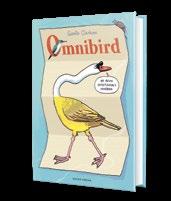
Clarkson, Giselle
Gecko Press | 96 pp. | $24.99 | October 7, 2025 | 9798765670514
fledglings, holding chickens, and helping a bird find its way back outdoors. The book’s detective framework cleverly reframes birding as puzzle-solving rather than memorization, making it equally appealing to dedicated young ornithologists and reluctant nature observers. The thick, durable paper and eco-friendly vegetable ink printing
enhance the detailed, delightful illustrations while demonstrating a genuine commitment to environmental values—a perfect complement to its naturefocused mission.
A truly stellar work that will delight bird enthusiasts while converting the ambivalent into eager avian investigators. (index) (Nonfiction. 8-13)

The comedy duo will write about picky eaters.
YouTube stars Rhett McLaughlin and Link Neal will make their children’s book debut next year, HarperCollins announced in a news release.
The press will publish the comedy duo’s Spaghetti Head & Chicken Fingers, illustrated by Erica Salcedo, in the spring. The publisher calls it
“a hilariously relatable picture book about what happens when you are what you eat―literally.”
McLaughlin and Neal, better known to their fans as Rhett and Link, host the YouTube variety show Good Mythical Morning, which has more than 19.4 million subscribers. They also host a companion show, Good Mythical More, and a podcast, Ear Biscuits
They are the authors of two previous titles, including The Lost Causes of Bleak Creek, a YA novel co-written with Lance Rubin.
Their children’s book will follow two young picky eaters: Saffy, who enjoys buttered noodles, and Lumo, a fan of chicken fingers. Saffy wakes up one day to find that her hair is now spaghetti, while Lumo’s fingers have been replaced by his favorite poultry treats.

nessed the daily drama of picky eating up close,” McLaughlin and Neal said in
a statement. “Our goal is to spark some smiles and laughter for both kids and parents alike.”
Spaghetti Head & Chicken Fingers is scheduled for publication on June 16, 2026.
—M.S.


silhouetted images of the bunnies by night, scenes of the pair striking superhero poses, and illustrations of the community enjoying jokes and carrot cake. Funny, heartwarming, and offbeat. (Picture book. 4-8)
Gordon, Brian | Farrar, Straus and Giroux (256 pp.) | $14.99 | February 3, 2026 9780374395018

His hellaciously embarrassing reputation drives a boy to try to transform himself in time for middle school. Dante Nimrod Ferno, who hails from the fiery-hot town of Brimstone and has horns, like many other residents, is about to enter Purg Middle School. Accidentally dropping his pants in the school cafeteria when he was 6 made him a laughingstock, and thanks to his nemesis, Phillip, no one has forgotten the incident. Dante, who’s cued neurodiverse, has trouble focusing, but he means well and wants to get along, no matter how much teasing he gets from classmates like the cliquey unicorns. He does befriend a couple of nicer kids, including Virgil, a winged boy from the neighboring realm of Blisshaven, who acts as an accomplice to many of Dante’s plots. Every page features an illustration that breaks up the text, and varied fonts are frequently employed for emphasis, adding to the visual interest. Gordon’s scribbly black-and-white art is lively and expressive. Dante’s maturing
personality and better nature come through as he interacts with friends and demonstrates his mastery of comic book superhero lore. He doesn’t solve all the problems in his life, but by the end of the book, his confidence and self-esteem have a fighting chance. Readers will have to wait for the sequel in order to see how he fares from here. An entertaining, afterlife-themed addition to the pantheon of insecure, goofy tweens who could use a good friend. (Adventure. 8-12)
Scar Like a River
Graff, Lisa | Christy Ottaviano Books (400 pp.) $17.99 | February 3, 2026 | 9780316570800
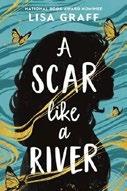
A 13-year-old girl growing up in Southern California is keeping secrets— until a sudden death in the family forces her to reckon with them.
Fallon Little was 5 when she had a life-changing experience that resulted in a facial injury, requiring her to undergo four reconstruction surgeries, spend months in the hospital, and do physical therapy. Now in seventh grade, Fallon is cast as the lead in their school play, Hello, Dolly!, along with her “second-best friend,” Kaia. Her other best friend, Trent, is the only person she’s opened up to about the terrifying attack, but the upcoming funeral becomes a catalyst for her to consider revealing the truth to her family. On top of everything, Fallon’s mom has been sick (and numerous
Will have readers building up self-control and tearing down overzealousness.
doctors have failed to explain her frequent “Crash Days”) and she must process the news that her infuriating aunt is moving in with them. The short chapters with pithy titles build intrigue and momentum, especially as Fallon advocates for changes to the play, which she argues promotes gaslighting; her campaign causes tension with Kaia. The story’s pitch-perfect tone balances sad and funny moments impeccably. Fallon demonstrates incredible depth and a rollicking sense of humor. Her return to therapy (despite skepticism based on previous failures) is instrumental to her reckoning with her secrets. Most characters are white, and Kaia is one of the few Black students. Darkness and light interplay with perfection. (content note, author’s note) (Fiction. 8-12)
Granillo, Ashley | Carolrhoda (336 pp.) $19.99 | February 3, 2026 | 9798765671351

The daughter of a former rock star in Los Angeles is torn between playing in a band with her sisters and her wish to sing in a choir. At 13, Alondra Yniguez has more experience with the world of rock music than most teens. Her dad was once the frontman of the popular emo band Past Perfection, among the first all-Latino bands in the genre. He’s trained her and her younger sisters, Elisa and Gloria, in everything from piano and drums to violin and bass. Now Past Perfection is launching a reunion tour, and the girls’ band, Beyond the Valley, will be the opening act. It’s a dream come true for most kids—and it might even be enough to bring home their music publicist mother, who’s separated from their dad. But instead of sounding gritty and tough, Alondra’s voice is coming out “clear and pure.” What’s unsuitable for emo is perfect for the choir club that a classmate
convinces her to join. But trying to keep the club a secret from her family, perform with Beyond the Valley, and pass the eighth grade might be too much for Alondra. Warm and funny with strong, realistic characters, Granillo’s sophomore novel explores issues including parental conflict and the representation of girls, women, and Latine people in rock. Mexican American Alondra navigates dating as someone who is asexual and “probably aromantic.” An emotional, well-realized story about finding your voice. (discussion questions, author’s note) (Fiction. 10-14)
Grant, Vicki | Tundra Books (272 pp.) $17.99 | July 29, 2025 | 9781774884683

Eleven-year-old Manya Brown loves science, her best friend, Isaac Mancini, and blending into the background. She’s not as wild about her parents’ joke shop, their wacky outfits, and all their gross and goofy ideas. When their new product, a whoopee cushion “filled with sulfur-scented gravy,” detonates before they give a presentation at school, killing the custodian, Manya’s parents are arrested for murder. Manya is certain (isn’t she?) that they’d never take a joke that far. So who’s responsible— and who could die next? Grant balances the Brown parents’ silly humor with Manya’s and Isaac’s sincere interest in science—both play a part in unraveling the increasingly dangerous mystery. Manya is a sympathetic protagonist; any middle schooler would be mortified by her loving parents’ over-the-top behavior. As Manya and Isaac set out to prove her parents’ innocence, they’re surrounded by frazzled adult characters, like the defense lawyer who just wants a quiet place to eat
her sandwich before heading back to work. The economic reality of keeping a small, struggling business like Pranks-A-Million going grounds the story within the overall goofiness. On the cover, Manya appears white, and Isaac has brown skin and curly black hair.
An enjoyably wacky and sciencecentered mystery. (Mystery. 9-12)
Gravett, Emily | Boxer Books (40 pp.) $18.99 | March 3, 2026 | 9781454712923
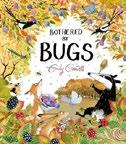
Woodland animals learn to appreciate their nemesis: bugs. After flies interrupt storytime, Pete the badger and his friends capture the insects in jam jars. They don’t stop with flies, though: “Then they noticed the whole woods were crawling with pests, / So they set about capturing all of the rest.” Satisfied with their work, the animals set off to harvest some fruit—but can’t find any. And after attempting to “go potty,” a rabbit reports another problem: “No one’s cleaned up. The whole woods are SO grotty.” From their captivity, the bugs school the animals in their usefulness: “The flies, moths and butterflies, the wasps and the bees / Pollinate all of the flowers and trees” (hence the fruit shortage). This may be news to young readers, who should find the book so diverting that they may not realize they’re on the receiving end of a science lesson. Not all of Gravett’s rhymes scale Seussian heights, but some bounce pretty high. Her art teems with finely detailed vignettes showing the scavenging animals in action and in thought. (A two-page spread depicts several animals looking guiltily at the lamentably trapped bugs.) The story ends in autumn, with the animals and bugs enjoying fruit-centered dishes together; readers who find themselves salivating can satisfy their
appetites by following the recipes printed on the book’s endpapers. Now this is how to educate and entertain. (Picture book. 4-8)
Hartman, Brooke | Illus. by Michael Slack Flamingo Books (40 pp.) | $18.99 February 17, 2026 | 9780593693339
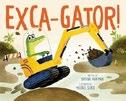
An overeager gator learns a lesson in teamwork.
Deep from the swamp, an alligator jumps into an excavator, ready for a day’s work. He is, in a clever twist of wordplay, called “Exca-Gator!”
Exca-Gator joins his crew on the job site. When there is dirt to be moved, Exca-Gator enthusiastically volunteers.
“CLEARING! CLUMPING! DIGGING! DUMPING!” He does it all. But when there is other work to be done, Exca-Gator jumps in quickly, too, even if it isn’t his skill set. Is he good at spreading cement? Should he lift that beam onto the tower? Exca-Gator just can’t control his impulses, and everything comes crashing down. Luckily, his team is there to remind him of a crucial truth: “We’re excited, just like you. But— // We build the best when we’re a crew!” Hartman’s bright, bouncy rhyme sets a fast-moving pace. Slack’s swampy greens and browns add to the muck and mire of the construction site, while brightly colored trucks zoom around, each doing its own important work. Construction fans will delight in spotting (and naming) each vehicle, and adults will cheer the cooperation message.
A satisfying tale that will have readers building up self-control and tearing down overzealousness.
(Picture book. 3-6)

Kirkus Star
Haydu, Corey Ann | Quill Tree Books/ HarperCollins (336 pp.) | $19.99
January 13, 2026 | 9780063348141

A sixth grader swaps places with a princess from the world she created. Fantasy lover Auden “Denny” Greene has been writing about fairy-tale world Sorrowfeld with best friend Runa Rossi for years. But lately, Runa has been less interested in adding to their journal, The Tale of Dragons True, and more focused on fitting in with the mean, popular girls; her latest worldbuilding contribution is the rule that at 12, “a true princess is not a child anymore.” After Denny and Runa’s disastrous shared 12th birthday party, Denny looks into a mysterious mirror adorned with dragons—her present from Runa— and suddenly she’s in Sorrowfeld, where she’s now Princess Auden. In the real princess’ viewpoint chapters, she’s anxious about turning 12 and clueless about how to fulfill her duty to stop the threatening dragons. Trading lives and ending up in Denny’s world initially offers her a reprieve, but she’s ill-equipped to handle modern preteen social dynamics. Both girls’ storylines explore childhood warring with heavy pressures—the dragons plaguing Sorrowfeld and Denny’s mother’s struggles with alcoholism. Even antagonistic characters are
given nuance. Both girls find their way through their problems with courage, compassion, and creativity. The parallels between the story arcs shine, lending authenticity even to the most fantastical elements and adding emotional weight as the girls, who are cued white, grapple with the destructive aspects of grief and expectations. The ending emphasizes heart and understanding. Come for the fun, magical premise; stay for the hopeful, beautiful story. (Fantasy. 8-13)
Hutchison, Roger | Illus. by Ag Jatkowska
Beaming Books (32 pp.) | $17.99
January 20, 2026 | 9798889834793
Series: Sparrow Stories, 2

Sparrow spends the 40 days of Lent reviving his garden.
The young bird who, along with friends Turtle, Mousie, and Buck, was introduced in the tale Sparrow’s Prayer (2023), returns. With only 40 days to go before Easter, our hero has plenty of work to do to transform his “disaster” of a garden. He and his pals work steadily, clearing out the dead plants, tilling the soil, carefully sowing seeds, and transplanting old growth to new locations. Holy Week is gloomy, culminating with a bad storm on Good Friday, but Buck cheers the others up: “Easter is a promise of new life!” And so it is; together, the friends rejoice in the flowers that bloom by Easter morning. Hutchison’s gracefully written text reads aloud well, and Sparrow and his friends each emerge
Come for the fun, magical premise; stay for the hopeful, beautiful story. THE ORDINARY AND EXTRAORDINARY AUDEN GREENE
with distinct characteristics. Jatkowska’s gentle illustrations reflect the story’s upbeat tone. Her personified animals are generally cheerful as they go about their work; their expressive faces display concern as the skies darken and dismay at the results of the disastrous storm. A particularly effective spread shows a cutaway view of the growing plants and flowers, with worms and bugs and a smiling mole tunneling away amid the swelling roots. The colors brighten as the story and the season progresses. An appealing representation of the Lenten period to share with young children. (Picture book. 4-9)
Islam, Farhana | Illus. by Nabila Adani Running Press Kids (32 pp.) | $18.99 February 10, 2026 | 9798894143316
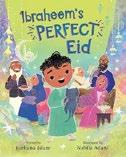
Young Ibraheem learns that celebrating Eid is about more than just receiving gifts. Eid is “the most perfectly perfect” day of the year, with so much to look forward to—especially presents. Every Eid, Ibraheem searches the house for gifts; this year, none can be found anywhere. Did everyone forget? Are there no presents this year? Ibraheem and Baba walk to the mosque for the special Eid prayer, and soon Ibraheem is swept away by daydreams of ice cream, the imam’s Eid-day stories, and the movements of the prayer. When the two return to their house, wrapped in festive cheer, Ibraheem is once more disappointed at the lack of presents, but Baba encourages the little one to reflect. Isn’t there more to Eid than gifts? Islam’s tale is centered on an important holiday for Muslims but contains a message relevant to children observing many other holidays. Ibraheem learns that the greatest gift is time spent with family and community, with cherished moments like shared meals, fun games, and tender embraces. Perfectly matching Ibraheem’s emotional ebbs and swells, Adani’s illustrations
feature layers of vibrant colors and a variety of patterns that give them depth and complexity. Ibraheem and the family are cued as South Asian and are a part of a diverse community. A joyous look into an important holiday that both informs and encourages introspection. (Picture book. 4-8)
Iverson, Haven | Illus. by August Zhang Roaring Brook Press (32 pp.) | $18.99 March 24, 2026 | 9781250353085

Backpacking trips teach life lessons. On the face of it, this is a story about an East Asian–presenting family’s yearly journeys into the mountains. They enjoy their time together and appreciate the flora, fauna, and landscapes. As their child grows, the little one proves capable of carrying a backpack and mastering map skills. But the deeper message concerns what can be learned in the wilderness: quiet, bravery, confidence, strength, how to carry both fear and wonder, and how to refuse to carry things that cause sadness, like loneliness. And when the world gets to be too much, the wilderness can do the carrying, sharing its strength. All of this is related in lyrical language that evokes nature and in relatable snippets of kid life. The lengthy backmatter offers an in-depth discussion of the term wilderness and notes that it differs from Indigenous people’s conception of the topic. Iverson also considers wilderness protection and provides additional facts and ideas for being a good steward. Zhang’s digital illustrations use perspective masterfully to trace the family’s wanderings in the great outdoors, scratchy textures in the art bringing to mind sticks and pine needles. Facial expressions and body language are spot-on—younger children could tell a tale of their own just from the pictures. No matter
your age, after reading this, you can’t help but think that the world would be better if we all went out in the wilderness more. Break out the backpacks. (Picture book. 3-9)
Jaigirdar, Adiba | Illus. by Avani Dwivedi Quill Tree Books/HarperCollins (320 pp.) $18.99 | January 13, 2026 | 9780063285989

Eight-year-old Nadia and her family travel to Bangladesh over the summer. Nadia tries to convince her parents to postpone the trip so she can spend her first Ramadan fasting with her best friend, Yasmin. When that fails, she decides to try to turn her observations into a newsworthy article to bag the editor-in-chief role at Sweetside Elementary School’s paper. When her favorite aunt, a journalist, accompanies the family to report on a story about flooding and climate change, Nadia’s discontent turns into excitement. The family heads to Sylhet, where they meet her grandparents, uncle, aunt, and twin cousins. As they prepare for Ramadan, the kids get competitive about who can keep the most fasts. Nadia also accompanies her aunt on interviews; she learns from her aunt’s mentoring and meets a dynamic changemaker who helps families displaced by the recent floods. Pages from Nadia’s notebook containing facts and investigative questions and Dwivedi’s endearing illustrations are interspersed throughout this story, which introduces Bangladesh’s landscapes, foods, and environmental challenges. Though some repetition and a slow-moving plot weigh down the story, Jaigirdar’s middle-grade debut brings nuance to the climate change discourse as she avoids sanitized approaches and examines the dangerous effects of rising sea levels on vulnerable populations. Readers learn
about the spirit of Ramadan through scenes that show the characters learning about self-control, good intentions, and helping others. An immersive story about climate disasters and how faith, family, and community can bring about change. (Fiction. 8-12)
Jenkins, Martin | Illus. by Jason Cockcroft Candlewick (32 pp.) | $19.99 | April 14, 2026 9781536250091
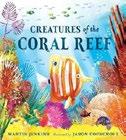
Jenkins invites readers to pretend to be butterflyfish, flitting through a coral reef and marveling at some of its colorful denizens.
“You’re in a coral reef,” he burbles. “Lucky you!” Spiky mounds of coral and crowds of brightly patterned tropical fish swimming through them glow vibrantly in Cockcroft’s serene, sunlit marine scenes as the author offers a quick tally of wild residents and explains how “tiny organisms” (actually, zooxanthellae, a term introduced in the afterword) help coral polyps build reefs over thousands of years. Neither the polyps nor their symbiotic companions are actually depicted in close-ups, though, so they and the process of reef building remain abstract. Still, even younger audiences will be affected when the pictures’ intense colors fade to ashy hues while the author discusses how pollution and climate change cause coral bleaching— and then burst back to full glory in later views as the reef rebounds and Jenkins closes with references to researchers who are finding types of corals that can survive in the warmer waters. The afterword expands on the topic of climate change and discusses what children can do to express their concerns about it; Jenkins concludes with a reassuring message that though the threat is real, so far at least bleached-out reefs have “usually recovered quite well.” An insightful call to action, loaded with visual appeal.
(Informational picture book. 6-8)
Will resonate most with readers who share space in an extended household.
Kachala, Elaine | Illus. by Catherine Chan Orca (96 pp.) | $26.95 | March 17, 2026 9781459839564 | Series: Orca Think, 21

Kachala considers dual and dueling problems— an acute worldwide housing shortage and constructiongenerated pollution—and offers some inspiring potential solutions. The author emphasizes positive approaches such as construction automation, “upstream thinking,” and housing variety. She convincingly connects the origins of the shortfall to climate change, arguing that these aren’t necessarily conflicting issues; rather, they can and should be addressed together. Kachala boldly tackles political realities: NIMBYism, government inaction, zoning laws, and more. As she describes proposed fixes, readers will learn about robotics, machine feedback loops, digital tools such as virtual reality, and innovations in materials (especially mass timber) and design (for instance, 3-D printing using recyclable or even waste materials).
Kachala bases her case on the universal human right to shelter and especially stresses the meaning and importance of “home” for kids. Bright photos, informative captions, and lucid summaries and sidebars offer easy entry to thorny issues. Precise, cheerful line-and-color graphics enlivening every spread often resemble a more realistic version of typical architectural projections. Final pages provide a dozen-plus ways for kids to get involved. Kachala’s expository flair, enthusiastic and informal tone, and her clear, in-depth
content convey confidence in her readers’ ability to tackle the circumstances they are inheriting. Here they’ll learn what they need to know to grapple with that future. People depicted are diverse. Realistic yet uplifting—a testament to the power of STEAM. (glossary, resources, index) (Nonfiction. 8-12)
Kemp, Laekan Zea | Illus. by Magdalena Mora | Little, Brown (40 pp.) | $18.99 September 9, 2025 | 9780759556850
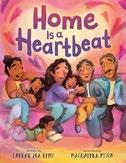
A full house promises wholehearted comfort in Kemp and Mora’s intimate picture book. In the early morning light, a modest house stands still amid a swathe of plants and trees. The sounds of slippers and Abuela’s rolling pin signal the start of the day. Snuggled up in a bed shared with Mami, the pipsqueak narrator gazes at the ceiling with its plastic stars, considering the familia living under the same roof. Abuela preps the tortillas in the kitchen, with memories of her apá stirred by the radio on the windowsill. Meanwhile, Abuelo toils away in his workshop, where his amá’s lucky hammer—the same one used to build the house—resides. Infused with sweeping, broad swirls of heart-stamped purples and pinks, Mora’s lush artwork portrays a multigenerational brown-skinned Latine familia with evident affection, evoking love from every corner of this home. Each family member also shines thanks to Kemp’s lyrical text, which conjures lifetimes out of vignettes. Tía Imelda finds her special place in the living room, where she
watches her telenovelas and paints her nails, while Mami snuggles up with her favorite book by the window. Photographs of previous inhabitants— long-gone relatives and their memories—form the beating heart of home as well. A lovely, poignant tribute, this meditation on the bonds of familia will resonate most with readers who share space in an extended household. After all, it’s presented here at its most inviting. Like a snug hug. (Picture book. 4-8)
Kimmel, Eric A. | Illus. by Alette Straathof Kar-Ben (24 pp.) | $19.99 | January 6, 2026 9798765663493
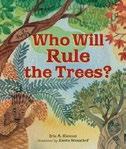
In the days after Creation, each tree species tries to prove why it should be their leader. God instructs all the creatures of the Earth to choose who will rule over them. Fish, birds, and land animals each make their selection, but the trees cannot agree. The oak touts its strength, the pine its towering vantage point, the maple its beauty, and the fig and date their delicious fruits. Finally, the olive speaks up. The other trees are incredulous that the small, drab tree could have much to offer. But the olive explains that its fruit can be pressed into olive oil, which, when made into a lamp, brings light. Since God made light first, and light is the source of the rest of Creation, the trees decide that the olive will be their leader. Straathof’s art is particularly appealing, with layers of watercolor and ink, shifting colors, and expressive tree faces. The deeply textured backgrounds will have children running their fingers over the pages. The story, by contrast, isn’t quite as engaging. The trees all have similar voices and are equally assertive in their claims to leadership, leaving the poetic ending about the importance of light without deeper resonance. A concluding author’s note explains the story’s roots in Jewish midrash; caregivers and educators may want to share this title on or near Tu B’Shevat, the
Jewish holiday known as “New Year for the Trees.”
A visually compelling ode to flora. (Picture book. 4-8)
Krossing, Karen | Illus. by Cathie Jamieson
Groundwood (48 pp.) | $19.99
September 2, 2025 | 9781773066356
Series: Better Paths

A street brings back memories of what once was.
Stroll along the pavement and learn more about Danforth Avenue in Toronto. Krossing warmly acquaints readers with the people who live there now—and “everyone who once did.” Relying on the refrain “my street remembers,” she offers snapshots of the history of the road, starting more than 14,000 years ago, when mammoths and mastodons roamed. Next, Krossing speaks of First Nations people and the harmonious relationship they enjoyed with the land. With three impressive, wordless spreads of people fishing, canoeing, and preparing food, Jamieson, an Anishinaabe and Haudenosaunee descendant, lets readers soak in the tranquility of life before colonialism. But in the 17th century, the arrival of European settlers changed everything. The British pressured the Mississauga into signing unjust treaties; settlers built homes and widened roads. Reconciliation eventually followed, with Canada making an official apology to First Peoples. Jamieson’s naïve-style, symbol-laden artwork will inform readers while also encouraging them to reflect on their own relationships with the Earth. Krossing’s thoughtful text is rife with vivid imagery (“hard-heeled boots”); her well-researched backmatter
supplements the narrative with historical context and urges youngsters to be mindful stewards of the land. A historical account with a wholly original perspective, imbued with a crucial environmental message. (author’s and illustrator’s notes, sources) (Informational picture book. 6-10)
Kurilla, Renée | Little, Brown (40 pp.)
$18.99 | February 10, 2026 | 9780316570152
Series: Celebrate the Seasons, 3

Kurilla’s latest seasonal tale explores the ways the world comes back to life after winter. The author/ illustrator explores the hallmarks of spring: rainy days, the reemergence of animals and insects, the appearance of buds and blooms, and holidays like Easter, Passover, and Mother’s Day. The rhyming verse bounces along, exhorting readers to take part in all the season has to offer: “Grow flowers for the bumblebees. / Hang a feeder. / Plant some trees.” “Crack a baseball! / Fly a kite! / Enjoy the extra spring sunlight.” The concise text and exuberant tone result in a book that’s just right for the eager ears of the toddler and preschool crowd. Kurilla’s cartoonish illustrations are a standout, too. Filled with greens and blues as well as pops of pink and yellow, they truly evoke spring’s charms. An especially enticing spread perfectly captures the joys of the season: A child bikes through a puddle, a youngster in a wheelchair blows bubbles that rise to the top of the page, and two kids in the background stomp in the mud. Kurilla varies page compositions, alternating vignettes with full-page
An idyllic world, imbued with cozy vibes and a message of self-acceptance.
spreads; her visuals pair well with her text while encouraging readers to linger over details. The cast is diverse in terms of skin color, hairstyle, and ability. An irresistible glimpse at the delights of spring. (Picture book. 2-4)
LaReau, Kara | Illus. by Ariane Moreira
Random House (80 pp.) | $15.99
February 10, 2026 | 9798217025879
Series: Witchycakes, 3

The residents of the seaside village of Shellville are ready for spring. Blue, a young witch-to-be who uses they/them pronouns, and their Mama Moon have much to do to prepare for the upcoming Spring Festival. Mama Moon must bake plenty of beach-inspired treats, like rocky reef muffins and conch custards. Blue has to deliver treats to the grumpy Ms. Crabbe and set up the Witchycakes booth at the festival. And Mama Moon’s frazzled new assistant, Marlin, causes one disaster after another. Eager for everything to go perfectly, Blue happens upon a solution. A few spritzes of Mama Moon’s “perfect potion,” and Marlin seems to transform into a model employee. Blue uses the potion in other situations, with mixed results, and eventually learns that perfection is impossible; what matters is doing one’s best. Once more, LaReau evokes an idyllic, magical world, low on dramatic tension but imbued with invitingly cozy vibes and a nicely integrated message of self-acceptance. To depict the pre-spring setting, Moreira relies on muted colors: soft yellow for flowers and Blue’s rain slicker, mossy green for grass and shrubs, and gray-blue for cloudy skies and rain-slicked streets. Blue and Mama Moon have tan skin; the supporting cast is diverse.
Another satisfying visit to a cheery beachy town, with an empowering lesson and baked goods to boot. (recipe) (Fiction. 6-9)
FOR THE WIN
Ed. by Latham, Irene & Charles Waters
Carolrhoda (48 pp.) | $20.99 March 3, 2026 | 9798765667996
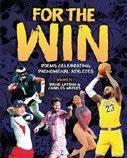
Twenty-one poets celebrate the achievements of 20 contemporary athletes. The 10 men and 10 women spotlighted here excel across sports, from baseball, football, and soccer to basketball, tennis, gymnastics, and more. The poets each begin with a boldly declarative title, praising their subjects for their ability to triumph over childhood challenges and to withstand the intense pressures of competition, as well as for their humanitarian work. In “Naomi Osaka Takes a Breath,” Anita Yasuda threads the tennis star’s accomplishments with her boundary-breaking decision to temporarily step away to seek help for depression and practice self-care. “She is more / than chasing / racing after titles, / because she’s willing / to say, no more.” Accompanying each poem is a quote from the athlete, an action photograph, and a sidebar with a thumbnail biography. Athletes and poets alike represent a broad array of cultures, races, and backgrounds. Suni Lee is the first Hmong American Olympian gymnast. Chargers’ wide receiver Keenan Allen endured a litany of derailing injuries, bouncing back after rehabilitation. Some athletes are immigrants to the U.S.; others play for their home countries, like Argentinian soccer star Lionel Messi. At 12,
swimmer Jessica Long became the youngest Paralympic competitor. Sarah Grace Tuttle marvels, “Water welcomes you / to celebrate your strengths.” A theme that emerges throughout this wholly edifying and well-composed work: the support of parents for their youngsters’ dreams. Successfully utilizes poetry to illuminate athletic excellence. (about the poets, source notes, about the poetry, photo credits) (Collective biography/poetry. 7-10)
Leathley, Philippa | Illus. by Brie Schmida Storytide/HarperCollins (352 pp.)
$19.99 | January 6, 2026 | 9780063376564 Series: Inkbound, 2

The lives of Meticulous Jones and her loved ones are endangered as Metty attempts to join a secret magical society.
A year after the events of the series opener, Metty finds herself invited into the League of Shadows, a powerful organization of people gifted with natural magic. In exchange for favors, the League will protect Metty and Magnificent, her aunt—they can both resurrect the dead using their life force. Bringing inanimate objects to life is illegal in New London, however, and Aunt Mag is hiding Sundar, the clockwork boy she animated years ago, in her home. If anyone finds out, Aunt Mag risks imprisonment, and Sundar could be disenchanted—a fate that’s akin to death. Despite these dangers, Aunt Mag forbids Metty to join
the League. When Aunt Mag is threatened by a blackmailer and comes under police suspicion, Metty resolves to join anyway. To do so, she must pass three tests before the next full moon. But time is short, and each trial increasingly taxes her magical, physical, and emotional resilience. And can Metty really trust the League’s members? Leathley balances rising tension with humorous details, such as school satchels that tattle on their owners and an animated feline book. Metty’s relationships with friends and family are nuanced, and her frustration with her dad’s and aunt’s protectiveness is sympathetic. Metty has dark hair, like her father and aunt, who are oliveskinned. Final art not seen.
An enchanting second outing. (index of common fates) (Fantasy. 9-12)
Lebourg, Claire | Trans. by Sophie Lewis Transit Children’s Editions (37 pp.) $18.95 | February 3, 2026 9798893380293 | Series: Mousse, 3
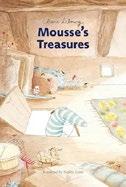
Earnest Mousse opens his seaside home to his niece. True to form, our long-snouted, blue-and-white striped protagonist prepares assiduously for his niece’s visit by stocking up on food, cleaning (and recleaning), and even readying art supplies. Everything’s in order, but anxious Mousse is nevertheless rattled when the doorbell rings (“Already?!”). His vivacious sister chatters incessantly as she drops off Pistachio (a tiny version of Mousse but with yellow stripes rather than blue). Food and activities await, but Pistachio’s obsession with swimming undermines most of her uncle’s careful preparations. A compromise at bedtime sets the stage for an amiable, give-and-take relationship, which evolves almost effortlessly in the ensuing pages. This modeling of respectful behavior is affirmed by Mousse’s bond with his
best friend, Barnacle the walrus, who arrives with his large family to take part in a yard sale initially proposed by Pistachio. While the first installments in this chapter-book series easily stand alone, this one likely won’t hold the attention of readers unfamiliar with Mousse; it retains the whimsical watercolors, world-building that relies on homey details, and a lyrical, sophisticated translation from French, but it contains virtually no drama. While the adult creatures experience a moment of panic toward the end, the overall languid, gently humorous tone belies expectation of anything but a sweet conclusion.
An endearing, lowkey outing, though too understated for any but the most ardent series fans. (Chapter book. 6-10)
Arthur’s Cat
Leynaud, Johan | Trans. by Sarah Ardizzone Eerdmans (40 pp.) | $18.99 | March 10, 2026 9780802856586

Animal lovers’ enthusiasm for their pets knows no bounds.
A rthur absolutely adores his turquoise cat, Zeffo. He’d love to be around Zeffo all the time—bouncing on the trampoline, playing hideand-seek together, or even giving Zeffo a new hairdo. Unfortunately, Zeffo doesn’t feel the same way, and each time Arthur attempts to connect with his pet, Zeffo flees. When Arthur picks up his beloved kitty one day, Zeffo reacts with a disdainful scratch. Ouch! After some
time apart, they both realize that they can still spend time together—so long as Arthur is mindful of Zeffo’s boundaries. Author/illustrator Leynaud has crafted a lovely look at bodily autonomy. Translated from French, his elegant text explores the feelings experienced by both kid and kitty in terms that young children will readily appreciate (“Zeffo waits for / the days to pass / and the night sky to twinkle / so the sadness can shrink // and Arthur’s heart / can heal”). His pencil, ink, pen, and digital illustrations are comprised of black outlines set against a stark white backdrop punctuated by dreamy pastel clouds of color, giving the tale a sophisticated yet child-friendly look. Young readers with stubborn kitties of their own will relate to this pair’s journey as they come to understand the importance of compromising and giving others space when needed. Arthur is tan-skinned with hair the white of the page.
A profoundly thoughtful look at the push and pull needed to forge a truly deep bond. (Picture book. 4-7)
Liao, Jenny | Illus. by Lenny Wen Knopf (40 pp.) | $18.99 February 24, 2026 | 9780593806975

A family observes the Chinese holiday of Qing Ming, also known as Tomb Sweeping Day. The young narrator notes that today the family will be visiting Yeh Yeh’s (Grandfather’s) grave. The child’s memories of Yeh Yeh are floating away,
A thoughtful look at the push and pull needed to forge a truly deep bond.
ARTHUR’S CAT
Mahoney, Kristi | Illus. by Chantelle Thorne & Burgen Thorne | Gnome Road Publishing (32 pp.) | $19.95 | March 10, 2026 9781957655635

This feathered replacement isn’t quite up to the job. The title’s premise may upset expectations; after all, owls—Athena’s bird—are renowned for their wisdom. In outline, the plot reprises the creators’ Alpacas Make Terrible Librarians (2024). A substitute educator runs amok until the real professional finally returns, to the kids’ heartfelt appreciation. But the details are, naturally, entirely
>>> and the little one frets: “I close my eyes and see Yeh Yeh’s face…But I have trouble remembering the sound of his laugh.” And the child remembers painting calligraphy with Yeh Yeh but struggles to recall “how his hand steered mine.” But, as Mama and Baba point out, visiting the gravesites of loved ones helps keep their memories alive. Arriving at the cemetery, the family sweeps leaves and weeds from the grave, puts out Yeh Yeh’s favorite foods, lights incense, and prays. The child tells Yeh Yeh about highlights from the family’s year (“Mama’s art is famous!” “And I’m starring in the school play!”). Wen’s soft, colorful gouache, pencil, and brush pen illustrations include a glowing figure of Yeh Yeh floating from the tombstone to enjoy the family’s offerings and stories. When the family burns joss paper, the protagonist also includes a few drawings of things that Yeh Yeh might enjoy in the afterlife, like a bicycle and a calligraphy brush. With this warm story, Liao highlights the love between a grandparent and grandchild while also clearly explaining a major Chinese holiday that gets little attention in the West. A sweet introduction to a significant Chinese tradition, glimpsed through the eyes of a loving family. (author’s note, glossary) (Picture book. 4-8)

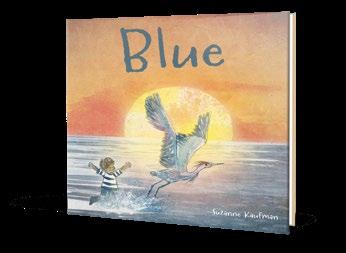
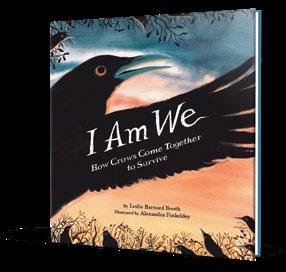



The author of Cat Nap answers our questions.
WHEN BRIAN LIES’ cat briefly went missing one day, the incident inspired a bit of anxiety—and a jaw-droppingly beautiful picture book. Imagining the adventures his pet might have embarked on, Lies dreamed up Cat Nap, in which a kitten takes a tour of the masterpieces housed at New York City’s Metropolitan Museum of Art. To bring Kitten’s escapades to life, Lies worked by hand, re-creating everything from artwork adorning an Egyptian tomb to a Georgia O’Keeffe landscape. The story was named one of our Best Picture Books of 2025, and Lies told us more about it by email.
of the Met’s collection, such as a Van Gogh painting or Degas’ famous statue of a young ballerina. But I realized they would feel like parodies, so then I focused on lesser-known pieces and chose ones that I thought were a challenge but doable.
I did have to learn some new techniques, such as making two-part silicone molds and gilding. But that was the fun part—the self-dare of the thing!
Was there an especially challenging work to re-create? An especially rewarding one?


Say something about how this book came to be.
Our Russian blue/Siamese mix, Dylan, disappeared one day, and we couldn’t find him anywhere in the house. A few hours later, he reappeared, unruffled, but his whiskers were full of spiderwebs. We wondered where he had gone and surmised that he had found a wormhole in space and time—maybe he’d gone back to ancient Egypt, where cats were revered, and had adventures there! That idea morphed into a wider story about Kitten journeying through works of art from different times and cultures.
How did you select the artworks you re-created?
I paid a visit to the Met and threw my imagination out to pieces as I walked by them—how could Kitten interact with those characters? Or in this situation? At first, I chose highlights
I had never carved wood before, so the [West African] Mblo portrait mask was the one I had the most doubts about. With wood carving, you have to be careful not to hack away too much at one time. It’s different with clay sculpture, because you can always add more to the piece as you go. But the most rewarding piece was the altarpiece of Saint Anthony of Padua. It was one of the first pieces that I finished and really gave me the sense that this whole crazy project was going to work. I’ll probably do more of this kind of work in the future.
Why was working by hand so satisfying?
As I wrote in the backmatter, it would’ve been much easier to do this whole project with Photoshop—simply splicing images of Kitten into photographs of old artwork. But that wouldn’t have a human feel to it, and I thought it would be cheating. I doubt many people would hold up a piece of art they had created through AI and say, “Look what I made!” with deep

Cat Nap Lies, Brian Greenwillow Books | 48 pp. | $19.99 September 30, 2025 | 9780062671288
pride. It’s the computer that made the thing, and the human input was just the string of characters in the application’s prompt box.
I think that most of us value the time, thought, and effort that go into making something by hand. If we buy a hand-carved spoon in a small shop, I think we prize it more than something we pick out of a bin at a big box store. Things that we humans feel, think, and bring into the world— whether objects, images or words— still matter!
Interview by Mahnaz Dar
different, starting with the bird’s nocturnal schedule, which dictates that all school activities take place after sundown. This turns out to be the easiest adjustment: It’s pajama day (or rather, night)! Everyone dons pjs except the owl, who is, shockingly, wearing nothing but a necktie and big round spectacles: “Awkward.” The kids hide their class hamster before it becomes prey and try to beat Owl in a hurdle race (the prize is no homework), only to discover that he conceals long legs in his plumage. During math class, the youngsters learn that owls can rotate their heads 270 degrees; English is painfully sidetracked by the unbearable screeching of talons on the board. Regurgitated owl pellets are the last straw for the children, but luckily their real teacher soon shows up. The energetic art ramps up the fun as the saucer-eyed students’ emotions come through clearly, likely mirroring readers’ own feelings of surprise, dismay, and disgust. Fans of the alpaca book—and everyone who enjoys a topsy-turvy day—will love this one. Classroom chaos done right. (Picture book. 4-7)
Makhijani, Pooja | Illus. by Lavanya Naidu Roaring Brook Press (32 pp.) | $18.99 February 3, 2026 | 9781250906885
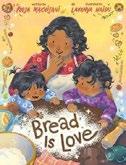
A family gathers for their weekly ritual of baking bread. A mother and her two young children get to work (the elder narrates). They measure and mix flour, water, salt, and starter into a dough. Both kids are eager apprentices, and their mother takes their little messes in her stride. As they wait for the dough to rise, the narrator complains that “bread is slow!” Mama reminds the child that “bread is patience.” They work the dough till it’s a smooth ball. While the loaf rests for the night, the protagonist sleeps, too, dreaming of delicious breads. In the morning, Mama and children bake the
loaf and wonder if it will balloon to a beautiful crust or collapse, “flat like a Frisbee.” Either way, Mama declares, “It does not matter. Bread is delicious.” They enjoy their treat with marmalade, chutney, and butter, basking in the comfort and joy of their beloved tradition. Makhijani’s endearing story sprinkles in baking basics with life lessons: “Sometimes bread is moody.” “Bread is unpredictable.” Tactile experiences—wet dough, gloppy sour starter, bready bubbles, and the fragrant baking smells—engage all the senses. Patterned textiles and foods cue this brown-skinned family as South Asian. Bright, jewel-toned illustrations, muted with a yellow light, create a cozy, lived-in feel.
A warmhearted story about togetherness and baking as a labor of love. (author’s note, recipe) (Picture book. 4-8)
Maldonado, Torrey | Illus. by Teresa Martínez | Nancy Paulsen Books (32 pp.) $18.99 | January 20, 2026 | 9780593624968

An uncle’s small but powerful actions make a boy feel celebrated and secure.
At the store, Toby picks out gifts for his dad and his uncle. Though Toby can’t wait to give out his presents, Dad barely looks up from his phone (“Oh, more socks”). Toby’s downcast (“He’s right…he has enough socks”), but Ma comforts him (“He’s not right”)—and her words linger with him: “If a person ain’t right, they won’t make you feel right.” This emphasis on intuition and feeling encourages Toby to give the other gift to his uncle, someone who always makes him feel good . His uncle, who owns El Tio Auto Repair, zooms Toby over to his personalized chair, giving him undivided, excited attention. Throughout, Martinez’s illustrations mirror the boy’s emotions: static when something “doesn’t feel right,” exuberant and full of motion when he soars. Maldonado’s story
could be a useful teaching tool for children to reinforce trusting your intuition. Many will identify with Toby’s sadness as he notices broken glass and a playground under construction in his rundown neighborhood or his disappointment as Dad dismisses him. More directly, Maldonado shows adult readers ways to convey security and love to the children in their lives. He models specific strategies for making youngsters feel seen and valued. Toby and his family are brown-skinned; hints in the text suggest Latine heritage. An affirming story that highlights the impact secondary caregivers can make in children’s lives.
(Picture book. 4-8)
Mancusi, Mari | Little, Brown (320 pp.) | $8.99 paper | September 2, 2025 | 9780316588164
Series: New Dragon City, 2

A boy in upstate New York is thrust into the center of a dangerous war in this prequel to New Dragon City (2022). Twelve-year-old Lucas Murphy cares strongly about his 7-year-old neighbor, Noah Miller, although Noah’s father’s vocal espousal of conspiracy theories is tiresome. But when Mr. Miller rushes his family to a bunker, believing that dragons are invading, Lucas becomes convinced that this time he might be right. Using the computer password and the key to the basement that Mr. Miller gives him, Lucas takes his friends, twins Jace and Jacinda Alvarez, to investigate. They aren’t the only ones interested in the evidence they discover, however. Meanwhile, a young, cat-sized dragon named Cinder, whose mother is the queen of their herd, has been injured and separated from everyone else. When Lucas discovers terrified Cinder, his remaining doubts about the presence of dragons are erased—and the split-second decision he makes to save her has
serious consequences. As the conflict between dragons and humans escalates dangerously, fanned by misunderstandings on both sides, Lucas and Cinder become trapped in the middle and must help guide everyone to harmony. Deeply woven themes of the importance of media literacy, trust, and forgiveness wrap around realistically complex friendships and plenty of exciting dragon action. As strong as the worldbuilding is in this entry, exposition never dominates the narrative, and readers will be enthralled from beginning to end. Lucas reads as white, and Jace and Jacinda are cued Latine. Smart, fulfilling, and full of heart. (Fantasy. 8-12)
Martin, Emily Winfield | Random House (48 pp.) $19.99 | January 6, 2026 | 9798217023981
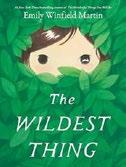
After the Wild arrives, Eleanor transforms into the wild thing she knew was hidden inside. Adult readers who see the phrase “wild things” will likely think back to Maurice Sendak’s Where the Wild Things Are (1963). Indeed, this lush work pays tribute to that celebrated tale. Besides emotionally resonant elements such as Eleanor’s wolf stuffie or a bed set amid a verdant forest, both books offer profound meditations on what it means to embrace the “wild inside.” One night, pale-skinned, dark-haired Eleanor dreams of the “things with fur and fin,” and when she awakens, foliage and forest creatures are streaming through her window. Mimicking the animals gives her the courage to be who she’s always longed to be, to draw her “own kind of tracks,” to howl and be “noisy” and “free.” Martin’s language rises like a crescendo, starting out with timid statements that become increasingly bold as Eleanor joyously rewilds. After a leap and tumble toward
Proof paw-sitive that dogs and cats can become the best of friends.
SHMOOF
a chandelier—or perhaps the moon?— the tired, satiated child heads to bed, where a parental-like figure offers reassuring words of love. The wild slips away, but Eleanor has changed. She’s smudged, leaf-covered, and newly “bloomed.” Luscious full-bleed spreads are graceful and expansive. Natural tones, especially springy greens, seem rife with possibility, while the visiting animals are charmingly bestial. Every aspect, like a bunny barrette hinting at Eleanor’s untamed potential, feels nuanced and purposeful.
A dreamy homage that’s its own budding classic. (Picture book. 4-8)
McKinnon, Heidi | Little, Brown (32 pp.) $15.99 | September 30, 2025 9781523532605 | Series: Floof, 2
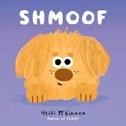
Can Shmoof and Floof get along? Meet Shmoof! This extremely fluffy brown pup is…well, “shmoofy.” “Super shmoofy” at that. And Shmoof wants nothing more than to befriend Floof, a kitty who is “floofy”—indeed, “the floofiest.” Shmoof has plenty of skills: finding tennis balls, leaping in pools, and becoming extra shmoofy after a blow-dry. But Floof’s too busy to acknowledge Shmoof’s tricks; Floof has “better things to do”—like knocking over a plant (into Shmoof’s bowl). But these two very different roommates finally unite over a common enemy: the dreaded vacuum cleaner! When their owner decides to do some cleaning, both pets flee, then find a way to put this infernal device out of order forever. “Maybe Floof can be friends with
Shmoof. Maybe Shmoof can stay.” The final spreads depict the two playing, sharing a meal, and at last curling up for a snuggle…but what’s in that box marked “Robo Vac 6000”? “Uh-oh.” McKinnon’s follow-up to the adorable Floof (2024) is an equally sweet new sibling tale. Her digital illustrations rely on scribbly textures and plenty of white space; they almost fluff off the page. Brief, understated text allows the visuals to tell the story, and the animals’ use of body language is spot on, from Floof’s arched back and upright tail to Shmoof’s play bow.
Proof paw-sitive that dogs and cats can become the best of friends.
(Picture book. 2-6)
Messner, Kate | Illus. by Falynn Koch Bloomsbury (224 pp.) | $12.99 February 3, 2026 | 9781547609413
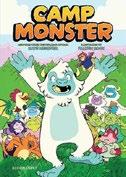
A classic summer camp story with a supernatural twist.
Tasha, a young yeti, can’t wait for her family to reopen their summer camp. Previously, the camp was only open to fellow yetis, but it’s now going to include all monsters for the first time. The diverse bunch of campers, who include goblins, a griffin, a vampire, a werewolf, and an ogress, have a variety of needs and preferences. Their differences initially cause tension in the camp as they struggle to cooperate with one another. All the while, the adults in charge fret over the looming possibility of being found by humans. In the end, the monsters’ differences make them
stronger, and they’re finally able to find ways to get along, even using their different abilities to protect the camp from humans. The summer camp setting keeps this fantastical story grounded, and the lessons that the young monsters learn are applicable to real-life scenarios. The cast of characters is fairly large, but each creature feels relevant to the story, and a bulletin board with “Meet Your Fellow Monsters” camper profiles is handy. The panels feature bright and lively artwork and are detailed without being overly busy; the variety in the character designs is a particular strength. Monstrous puns add plenty of humor. Delightfully relatable and full of spooky charm, this book will leave readers shrieking for more. (Graphic fantasy. 8-12)
Mihaly, Christy | Illus. by Mariona Cabassa Eerdmans (56 pp.) | $19.99 | April 21, 2026 9780802855510 | Series: Incredible Lives for Young Readers
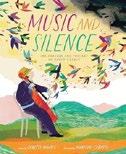
A lyrical tribute to a Catalan child who grew up to become one of the 20th century’s most renowned cellists. By age 5, Pablo (or Pau, to use the Catalan form of his name) Casals was singing in his local choir, and by 14, he was giving solo concert performances on the cello. What Mihaly highlights here, though, are his special relationships to Bach’s Cello Suites and to his native Catalonia in the wake of the Spanish Civil War and the
rise of Generalissimo Franco. Leaving Spain in 1939, Casals helped to resettle fellow refugees—but in a public silence that lasted until 1950, he refused to perform in any country that recognized Franco’s regime. Only an invitation to mark the 200th anniversary of Bach’s death enticed him back on stage at last; the author leaves him there, receiving his audience’s rapturous ovation “for his music and for his silence,” but does fill in the rest of his storied career in a substantial afterword. A view of Barcelona (identifiable by the distinctive silhouette of the Sagrada Familia cathedral) being bombed isn’t the only Catalonian setting that seems to burn in Cabassa’s impressionistic, intensely hued illustrations. But she closes with a dove of peace, and images of birds and abstract daubs of bright color swirl throughout to evoke the music pouring from the dramatically posed young musician and the applause pouring back. Intense and heartfelt. (author’s and illustrator’s notes, timeline, select recordings and videos, websites, bibliography) (Picture-book biography. 7-9)
Moyer, Rich | Union Square & Co. (272 pp.)
$24.99 | February 17, 2026 | 9781454957683

An orange cat and his best friend, the purple hairball he coughed up, save the universe. The universe is broken, and it’s all the fault of chaotic feline Huck and scientific genius Hairball. After all, it was Huck’s irresponsible use of Hairball’s invention,
the titular litterbox time machine, which created an alternate present in which neither of them should exist. The friends—or, as logical and emotionless Hairball calls them, co-workers—must effect a seemingly insignificant positive change in the past to benefit the present and undo the paradox that threatens to end the world. Our heroes, with the random addition of a Black-presenting Timber-Scout named Azrael, who meets them while selling cookies door to door, are pursued through the past and present by elderly, brown-skinned Father Time and blond, blue-eyed Baby New Year, celestial beings tasked with eliminating the time anomaly. Fans of Moyer’s Ham Helsing series will enjoy the book’s irreverent humor, though many of the references feel targeted towards older audiences; it’s unclear whether young readers will understand the ’80s slang and jokes, for example. The humor is also the book’s main focus, to the point that the time-travel ramifications don’t hold up to close scrutiny, making the worldbuilding feel like an afterthought. Still, with its humor and lively, cartoonish illustrations, this graphic novel will likely find its audience.
Absurdly funny. (Graphic science fiction. 8-12)
Mϋhle, Jörg | Trans. by Melody Shaw Gecko Press (32 pp.) | $18.99 February 3, 2026 | 9798765670538

A playdate suddenly goes wrong. When Weasel arrives home, he’s surprised to find his friend Bear playing with Badger. “We’re in the middle of a game,” says Bear. “Would you like to make us something to eat?” Thus starts an epic fight between Bear and Weasel as they argue over who gets to be pals with Badger, which games to play, and who gets to play whom in various scenarios. Eventually, the fed-up Badger leaves and declares he’ll be playing with Fox tomorrow. Young
readers still figuring out the dynamics of friendship—when to give in and when to assert yourself—will certainly relate to this combative twosome. Mϋhle’s text, translated from German, is frank and straightforward, mirroring the bluntness of a child’s interactions and emotions, including Badger’s helplessness as he’s caught between the two battling friends. Spare watercolor and colored pencil illustrations set against stark white backgrounds match the tone of the text. Notably, this is no morality tale with a neat and tidy ending; rather, it’s a strong example of what not to do that honestly explores the consequences of jealousy and stubbornness.
A candid and authentic glimpse at the rocky road that is negotiating social interactions. (Picture book. 4-7)
Neri, G. | Illus. by Corban Wilkin Candlewick (96 pp.) | $18.99 March 3, 2026 | 9781536239577

Neri embarked on an unforgettable journey when he crisscrossed the U.S. with his parents and two older brothers in 1976.
“All my stories begin with some experience I’ve had out on the road,” Neri reveals—including this book. Thus far, he’s been to 48 of the 50 states and to such faraway destinations as Antarctica and Siberia. His adventurous spirit was spurred at age 8, when his mother suggested that the family commemorate the Bicentennial with a road trip: “We could be in Washington, DC, for the Fourth of July!” Their 1967 station wagon was equipped with a pop-up tent trailer as they prepared to drive 8,000 miles through 26 states in seven weeks. Highlights were many: the Grand Canyon, Gettysburg, New York City, Chicago, St. Louis, Las Vegas, and Texas, where they visited Neri’s
cousins. Neri acknowledges the challenges of tight quarters and occasional breakdowns. He’s also sensitive to less celebratory details: Confederate flags, a visit to a former slave plantation, immigrant roundups, racial and economic inequality. Artist Wilkin returns for a third collaboration, transforming Neri’s adventures into eye-popping multilayered collages of maps, photographs (both personal and stock), doodled lists, and detailed illustrations. His cartoon version of expressive young Neri in striped shirt and “Bing Surfboards hat” is particularly affecting. Neri and his family, all with brown skin, are of Mexican, Filipino, and Creole descent. An indelible family adventure exploring all things American—the good, bad, and ugly. (author’s note, more about the U.S. and American history, recommended reading, source notes, photo credits) (Memoir. 7-10)
Newman, Patricia | Illus. by Isabelle Follath Margaret Quinlin Books/Peachtree (48 pp.) $19.99 | February 10, 2026 | 9781682637272

The captivating confluence of a gifted cello player, the brilliant songs of the nightingale, and the wonders of early radio.
Beatrice Harrison, nicknamed Baba by her musical family, was born in India in 1892, but soon after, they moved to England, where the Harrisons were originally from. While still a toddler, Baba encountered her first cello during a performance by her military father’s regimental band. Newman’s lively and informative text describes her subject’s early years as she insists that “Baba play Tello.” After learning the basics of music on the violin and piano, she finally got her first cello at age 9, and the instrument “sang like a nightingale”—a subtle bit of foreshadowing. Lauded by audiences worldwide, she also performed for injured soldiers during World War I. One night while playing in her garden,
she was amazed as a nightingale began to sing along with her cello; here the illustrations take on a glowing, almost magical quality. Beatrice convinced the fledging BBC to make the first recording ever of a wild bird singing while she played. For the next 12 years every spring millions around the world would listen to this enchanting duet. With a nod to Baba’s Edwardian world, the precise ink and watercolor illustrations work seamlessly to extend the vibrant story and to set the scene for Beatrice’s lifelong interest in nature and music. A charming look into an unusual musical collaboration. (timeline, author’s note, bibliography, photographs, information on Beatrice’s life, nightingales, and early radio) (Picture-book biography. 5-9)
Kirkus Star
Nickum, Nora | Illus. by Elly MacKay Candlewick (32 pp.) | $18.99 February 10, 2026 | 9781536234701

Every year, the Pacific Northwest’s Salish Sea becomes a pit stop on one of nature’s most majestic migrations.
Leaving Baja California each February, 20,000 gray whales embark on a monthslong journey to the Arctic, where they spend each summer feasting on shrimp and growing strong. The migration is arduous; the whales eat almost nothing along the way and lose one-third of their body weight. Among the travelers are 12 whales with a sense of adventure, willing to risk a detour with the promise of a valuable payoff. Sometimes called the Sounders, these whales break off from the group each year at the tip of Washington State and enter the great network of waterways called the Salish Sea. Their 170-mile detour leads them to shorelines so shallow that whales who don’t pay
attention to the outgoing tide are at risk of being stranded. Here they scrape great heaps of ghost shrimp from the sea floor, leaving behind giant pits in the sand that are visible when the tide turns. The Sounders eat hundreds of pounds of shrimp during their short stay in the Salish Sea before continuing their journey to the Arctic, bellies full. Nickum’s quiet, flowing prose sets the scene with vivid, sensory detail. MacKay’s captivating ink and paper illustrations were layered and enhanced with wire, colored filters, and light and then photographed for a glowing and serene three-dimensional effect. The speckled whales seem ready to splash off the page in each dioramic scene. A stunning and unforgettable journey. (more information on the whales, suggested reading) (Informational picture book. 5-7)
O’Brien, Sean | Illus. by Karyn Lee Norton Young Readers (288 pp.) | $17.99 October 14, 2025 | 9781324053095
Series: White House Clubhouse, 3
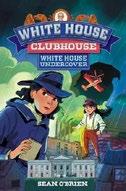
Marissa and Clara Suarez, whose mom is president, find themselves involved in another timetravel adventure, in which they experience Franklin Delano Roosevelt’s Washington, D.C.
In the secret White House Clubhouse used by generations of child residents, the sisters meet Curtis “Buzz” Dall, the 5-year-old grandson of Franklin and Eleanor Roosevelt. He begs them to help him find a missing “boid” (bird) statue. Buzz speaks like a pint-sized gangster, a quirky detail that brings humor to this fact-filled story. As in the two earlier series entries, significant events in history come to life through the girls’ empathetic eyes. In this one, Marissa and Clara witness the desperation of the Great Depression and the birth of the New Deal. While chasing down the bird statue (in
itself a delightful, slapstick comedy caper) they meet notable figures, including Dr. Mary McLeod Bethune, Amelia Earhart, Lorena “Hick” Hickok (reporter and close companion of the First Lady), and Alice Roosevelt, who are refreshingly and appealingly humanized as real people. The girls’ modern speech and witty observations add irreverence to the story, but beneath all the fun is an important message that Marissa articulates: “I think anytime you have an opportunity to make a difference you have a responsibility to do it.” Lee’s blackand-white illustrations add zest and convey a sense of the time period. Marissa and Clara are cued Latine, Bethune is Black, and other main characters read white.
Entertaining, engaging, and empowering. (author’s note) (Adventure. 8-12)
Pastores, Jenine & Josh Jackson
Penguin Workshop (112 pp.) | $12.99
February 24, 2026 | 9780593754313
Series: The Adventures of Tubby Nugget, 1

A friendly little blob eschews uniformity.
Based on the affirmational internet cartoon of the same name, this capable comic recounts Tubby Nugget’s relatable origin story. Tubby lives on Planet Nüg and leads a simple life with his loving parents, but as he gets older, the time for transformation approaches. When nuggets reach adulthood, they get dipped in gold, go to work, and no longer enjoy easy pleasures like savoring yummy snacks, drawing, and playing outside. Though this is a somewhat heavy-handed allegory for the soul-crushing slog of adulthood, it’s earnestly told, and Tubby’s such a sweetie, it’s hard to resist his emotional arc. When he declares he won’t be gold-encased— ”What I’d like most is the chance to
be myself”—a dramatic escape, aided by his supportive parents, ensues. Finally, Tubby departs his planet and tumbles into the arms of his earthly guardians, the creators of his online cartoons (one is pale-skinned; one is brown-skinned). The visuals are glossy, rounded, and accessible, with a few sci-fi set pieces and spaceships thrown in for good measure. While simple, it rings true. Who hasn’t felt the crushing weight of conformity and dreamed of a lighter life? Bringing the Tubby Nugget ethos to book form offers a fresh opportunity to share his comforting message with fans and readers of all ages.
A heartfelt celebration of staying young at heart. (map, sketches, authors’ note) (Graphic fiction. 8-12)
Peele, A.B. | Illus. by Lala Watkins Simon & Schuster (40 pp.) | $19.99 March 24, 2026 | 9781665953566

When bananas cut loose, no one can stay upset for long.
The opening pages depict a series of anthropomorphized bananas who all feel down in the dumps. A skateboard trick goes wrong; overwhelmed office workers struggle to field calls on both rotary and cell phones; a downcast clown can’t muster a smile. Luckily, a group of performers (the name Bandnana festooned across their drum kit) arrives on the scene, with horn, percussion, and strings, to get everyone up and moving: It’s time to “SHAKE, SHAKE, SHAKE!” Their clarion call—“Bananas of the world unite”— summons friends to take part; one even parachutes in. “Psychic Banana,” “Duck Banana,” “Chef Banana,” and others join the activities, which include surfing and flying. The nonsense lyrics of the “Shake, Banana” song provide the text, leaving whatever narrative there is to the bright, childlike art. It’s a banana world. Clowns, pets, grandmas, ghosts, babies, you name it—everyone in the book is a banana. Limbs are stuck on, faces peek
out from the peels, and accessories (cowboy hat, Viking helmet) help identify roles—for instance, a Marie Antoinette lookalike and a witch. The final spread contains a bustling array of bananas—including the clown, who happily, is finally grinning. Giggles and get-up-and-go excitement galore. (Picture book. 4-8)
Pennypacker, Sara | Illus. by Jon Klassen Balzer + Bray (288 pp.) | $18.99 February 3, 2026 | 9781250392817
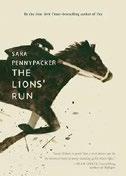
An orphan in occupied France during World War II finds his courage and a sense of family.
Thirteen-yearold Lucas Dubois is a foundling who’s growing up in the abbey orphanage in the village of Lamorlaye. He has such a tender heart that the other boys call him “Petit Éclair.” Lucas rescues a litter of kittens from being drowned on a nun’s orders and goes to hide them in one of the stables left empty in nearby Chantilly after their owners took their thoroughbreds and fled from the Nazis. But the stable is already in use—Alice, the teenage daughter of an English horse trainer, is protecting a racehorse from being commissioned for the war until she can be smuggled to Kentucky in a month’s time. Lucas’ job delivering groceries takes him into the nearby Lebensborn, a maternity home that takes babies who meet “Aryan” standards away from their young mothers and sends them for adoption by Nazi families. There, Lucas befriends Claire, who’s desperate to keep her baby, and his empathy leads him to a rash and dangerous nighttime flight along the five-kilometer horse training track known as the Lions’ Run. This immersive story is driven by Lucas’ emotional yearnings and the sometimes complicated relationships
among the well-drawn characters, but the history and the specific setting are accurate and carefully delineated, creating a strong sense of place. Klassen’s spot art and map of the region adorn the text. Compassionate and complex. (author’s note) (Historical fiction. 8-13)
Phelan, Matt | Farrar, Straus and Giroux (40 pp.) $18.99 | March 3, 2026 | 9780374393557

A nonconformist polar bear navigates classroom dynamics on his own terms.
“Everyone says NO sometimes. Bartleby says, ‘I prefer not to.’ He says it a lot.” Dressed nattily in his red bowler hat, tie, and overalls, Bartleby sets himself apart from his peers, distancing himself physically and opting out of group activities. “For free play, everyone chooses a toy. ‘I prefer not to,’” says Bartleby, sitting alone. Circle time, music class, recess? He’d prefer not to. I prefer not to is quite different than saying no, and Bartleby’s refrain of passive resistance has a particular effect on his perplexed-looking classmates. When their teacher, Ms. Melville (natch), invites the students to create self-portraits at art time, bystander Bartleby finds a creative way to participate on his own terms, in his own time. Secondary characters—all anthropomorphic animals—and scenery in gently expressive ink brush lines with muted watercolor tones starkly contrast with knobby-eared Bartleby’s eccentric scarlet attire and crisp white fur, further emphasizing the youngster’s singularity. In this ever-so-slightly philosophical
addition to the canon of you-do-you picture books, the pragmatic text and diminutive trim size further bolster a civilly dissenting message. Brace yourselves, grown-ups: Bartleby’s refrain, taken straight from Herman Melville’s “Bartleby, the Scrivener,” seems destined to enter vernacular among young readers, whether you’d prefer that or not. Politely contrarian and utterly charming. (Picture book. 3-6)
Prevo, Patty Cisneros | Illus. by Mirelle Ortega | Abrams (40 pp.) | $18.99 March 24, 2026 | 9781419772849
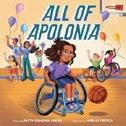
A wheelchair basketball player plans a party. Apolonia can’t wait to celebrate her birthday. She’s inviting “todos— teammates and primas!” to the gym, where they’ll play wheelchair basketball and eat tacos de arracheras, arroz y frijoles, and tres leches. But her racially diverse teammates anticipate pizza and ice cream—what if they don’t like Papá’s menu? And when Apolonia’s cousins learn they’ll be “playing basketball en sillas de ruedas,” they giggle: “So weird!” Apolonia worries that wheelchair basketball and her Mexican American family won’t mix. Finally, she tells Mamá to cancel the party, “because I’m always so different…even from you.” But the next day, Mamá brings Apolonia to the gym, where friends and family surprise her with a flawless fiesta. Apolonia’s heart soars as she joins the basketball game: “Everyone is there. Juntos. All of Apolonia!” Energetic, expressive cartoon illustrations convey Apolonia’s
A nonconformist polar bear navigates classroom dynamics on his own terms.
BARTLEBY
many emotions and, above all, her family’s love. In an author’s note, Prevo defines inclusion, belonging, and social identity and explains that the story is based on her experiences as a Mexican and disabled person. Readers navigating multiple cultural identities will empathize with Apolonia’s conflicting feelings, and disabled readers will welcome the acknowledgment that being disabled in a nondisabled family can be lonely. All will cheer for Apolonia. Interspersed Spanish words are understandable through context. Apolonia and Mamá have tan skin; her family’s complexions vary. A heartwarming story of family and belonging. (Picture book. 4-7)
Rasano, Eva | Candlewick (24 pp.) | $7.99
February 3, 2026 | 9781536247145
Series: Merlin First Concept Board Books

Teaching the concept of opposites is easy when you’ve a cheery birdie helping you along. Merlin the bird, who has a teardrop-shaped black body, blue wings, and an orange beak, is the star of the show in this simple paean to contrasts. With flat art resembling cut pieces of paper against the white two-dimensional space of the page, it could be difficult to make it clear that Merlin is sometimes far away rather than simply smaller. Rasano compensates by making the book about much more than simply “near” or “far.” This is an opposite concept book, and that means that Merlin can now be “right” and “left,” “in” and “out,” “above” and “below,”
and more. Rasano leaves the titular “near” and “far” element to the very end. When near, the cheery bird fills the entire page from one side to another. When far, Merlin is small, distant, saying “Bye-bye!” to mark the end of the book. As feared, this simply looks like Merlin is sometimes big and sometimes small—the plot of the simultaneously released Merlin, Are You Small or Big? (2025). In spite of this confusion, the book is a charming introduction to the subject for the very young. Merlin is sprightly and fun, easy to spot against the white of the page.
Just plain fun! (Board book. 2-4)
Rasano, Eva | Candlewick (24 pp.) | $7.99 February 3, 2026 | 9781536247152
Series: Merlin First Concept Board Books

Young readers learn a lesson in relativism. In this tale that relies on the simplest of words and pictures, Merlin the bird comes to realize that whether something is considered small or big depends on the context. When we first meet Merlin, the bird is defined as “small,” pictured beside a “BIG” elephant. But in just a turn of a page, Merlin becomes the “BIG” one, while a ladybug in flight is “small.” The pattern continues, the typography always keeping the word small all in lowercase letters and big all in caps. One moment, Merlin is small, dwarfed by buildings, trees, and birds of prey. The next, our hero appears big alongside worms, flowers, and hummingbirds. So what’s the verdict?
Fun and frolic for kids for whom “big” and “small” are new concepts.
MERLIN, ARE YOU SMALL OR BIG?
Is Merlin big or small? The book turns the question around to readers. “Are you small or BIG?” With that little mic drop, small children now have the chance to readily compare themselves with things that are larger or tinier. With its premise, this appealing tale is a slightly younger companion to Mo Willems’ 2024 titles Are You Big? and Are You Small? Bright colors against white backgrounds let Rasano’s fetching art (which resembles cut paper) really pop.
A potentially complicated topic results in fun and frolic for kids for whom “big” and “small” are new concepts. (Board book. 2-4)
Reidy, Jean | Illus. by Amy Jindra Hodgson
Rocky Pond Books/Penguin (32 pp.) | $18.99 February 24, 2026 | 9780593858943

What’s the point of being the best when no one talks to you at all?
Bob, a hulking blue bear sporting a yellow knit hat and red-and-yellow striped sweater, doesn’t need anyone to tell him that he’s the biggest, strongest, and smartest guy around. After all, he’s perfectly comfortable telling everyone else. No one questions Bob. Enter Bill, a bespectacled, diminutive badger, equally into sweaters and knit caps, who has nothing but questions on his mind. To Bob’s bafflement, Bill proceeds to ask everyone he encounters pertinent queries about their life and work. A confrontation is inevitable, but when Bill introduces himself, he asks Bob a slew of unexpected questions about his workout routines, favorite trails, and more. Bob is so taken aback by Bill’s interest that he begins to reciprocate by posing questions of his own. Now the bear once filled to the brim with braggadocio comes to understand that the most rewarding thing of all is getting to know other people. While Bob’s transformation
feels a bit too instantaneous, readers will hardly care thanks to the good-natured telling of the tale. Especially delightful is Hodgson’s variety of knit headwear and colorful characters, giving the pages a jaunty, vibrant feel throughout. Modeling the key to making friends, this gentle tale wields its messaging with a whisper rather than a thump. (Picture book. 4-8)
Renfro, Jo | Beaming Books (32 pp.) | $18.99 February 24, 2026 | 9798889836155
Series: Peg’s Adventures, 3
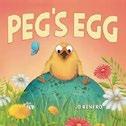
In her third outing, a wellmeaning chick learns the importance of a good sense of humor.
After Peg finds an egg left in a field all by itself, she remembers how scared she felt all alone in her shell and decides to take care of it. She keeps it warm, safe, and dry. But Peg grows impatient and gives the egg a little nudge, which sends it bouncing down a hill and into the farmyard. Suddenly she discovers it’s not an egg after all; it’s just a speckled ball. Embarrassed, Peg’s tempted to run, hide, or scream, but she realizes the best thing to do is laugh at herself. Peg is a cute little chick, with fluffy yellow feathers and big cartoon eyes. Most of the illustrations feature the green field, but there is plenty of emotion and movement in the simple setting. One stunning layout shows Peg determined to protect her egg from the rain, shielding it with a few small green leaves, raindrops rushing all around her. When the egg starts to roll, with Peg darting after it, a blur of feathers and color ricochets across the page. The message that everyone errs from time to time is simple and effectively conveyed without belaboring the point. The just-right blend of silliness and concise lesson make the tale appropriate for preschoolers. Imbued with a sweetly simple takeaway, an endearing adventure with a plucky pullet. (Picture book. 4-7)
Reynolds, Aaron | Illus. by Peter Brown Simon & Schuster (96 pp.) | $13.99
February 3, 2026 | 9781665961110
Series: Jasper Rabbit’s Creepy Tales!

In the latest installment of the delightfully disturbing chapterbook series, the mundane once more takes on supernatural qualities, this time in the form of veggies.
With this follow-up to Troubling Tonsils! (2025), our host, Jasper Rabbit, once more channels Twilight Zone creator Rod Serling. As Jasper narrates, we meet our heroes: fourth graders Thaddeus Badger and Oliver Possum, who love nothing more than eating junk food, particularly the hamburgers at Hurt-A-Burger (a mildly brilliant corporate name on the author’s part). When Oliver’s parents trick the two into a dinner of salads at their favorite fast-food joint, Thaddeus feels betrayed, but Oliver experiences something a little more dire. Soon after, Oliver starts acting strangely, and his parents begin behaving even more oddly. What’s going on? And does it have anything to do with the full moon? Tone is the true star of the show in this series; the mystery unspools thanks to the buildup of unnerving moments. Reynolds combines suspense with a keen ability to artistically frame both sunny innocent sequences and those rich with dark foreboding. Notably, this is no morality tale about eating your vegetables—this tale is fully on the side of its child readers. Brown’s black-and-white images, punctuated with eerie pops of green, heighten both horrifying and comedic moments. Disconcerting and possibly deadly dealings are afoot; certain to charm younger fans of the macabre. (Chapter book. 6-9)
Richter, Jennifer Ann | Holiday House (272 pp.) $17.99 | January 27, 2026 | 9780823456574
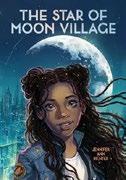
A 12-year-old girl takes a journey beyond the stars to test her limits but finds challenges to her perceptions of herself and others.
Priscilla Cobb, a budding botanist and space science enthusiast, is the youngest person chosen to be on the North American Space Alliance’s first trip to the moon for students with exceptional talents. She’ll be traveling with her father (who got into the adult focus group) and Hoshiko, a new friend from the trials in Houston, who’s a brilliant musician from Canada. Priscilla’s excitement over the trip is dimmed when the VIP celebrity guest turns out to be Starletta, a teen pop star from Priscilla’s hometown. Priscilla, who hopes to impress the Moon Village scientists and pave the way for her future career, fears that Starletta’s presence will become a distracting, “glittery mess”— and it seems as if her fears are coming true. But she remains determined to highlight the science and research aspects of Moon Village that are important to her. Priscilla and Starletta’s frenemy relationship arc feels incomplete, and the resolution happens too quickly. But the imaginative descriptions of space travel and technology hold real appeal for readers and will connect them with the story. Priscilla is cued Black, and names and physical descriptions point to broad ethnic diversity in the supporting cast. Strong worldbuilding and a STEM focus allow readers to imagine a world beyond their own. (author’s note) (Science fiction. 8-12)

Beasts
By Ingvild Bjerkeland;
trans. by Rosie Hedger
Dark and achingly upsetting; highly appealing for a great many horror readers, new and old. 2 The Stolen Songbird By Judith Eagle; illus. by Jo Rioux
Assured and atmospheric: a winner.
A Little Too Haunted By Justine
Pucella Winans
Sweet meets spooky—and it’s absolutely spectacular.

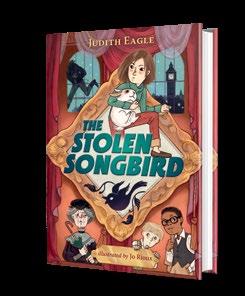
The Midwatch Institute for Wayward Girls By Judith
Rossell
By Jennifer L. Holm
An
Kate
Unforgettably


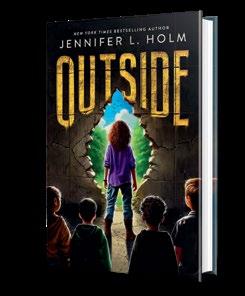
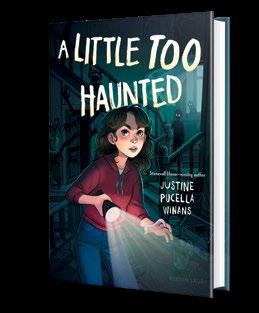

The author of The Teacher of Nomad Land answers our questions.
IN HIS LATEST novel, Daniel Nayeri explores a side of the Second World War that will be new to many readers young and old: the role of Iran. The Teacher of Nomad Land: A World War II Story centers on a 12-year-old Babek, whose father is killed when the British and Soviets invade the country in 1941. Following in his father’s footsteps, Babek leads his younger sister into the Zagros Mountains in hopes of becoming a teacher to a tribe of nomads; the pair encounter British soldiers, evade a Nazi spy, and join forces with a young Jewish refugee. The book made our list of the Best Middle Grade of 2025, and Nayeri answered our questions by email.
of Samir, the Seller of Dreams , which is set along the Silk Road in the 11th century. The challenge there had been to dive deeply into how people lived. I [was] caught by a historian trying to have a character use his pockets when those hadn’t become common in clothing until centuries later in that part of the world. The research for Nomad Land had several advantages in that regard. First, life in the 1940s was much more recognizable to us now. They may not have had cell phones, but at least they had pockets! And second, the era is marked by the advent of film, which means I could watch much of the history with my own eyes in the form of documentaries. That was a delightful surprise for someone who spends much of his imagination in the centuries even before the printing press.



What made you decide to set your novel in Iran?
As storytellers, we’re trained to look for the conflict in situations. It makes sense, then, that most people would look to the European and Pacific theaters—after all, those were warfronts. But one challenge I had for myself was to show the global nature of that conflict. Iran at that time was an occupied nation after the AngloSoviet invasion and, as result, [it was] a neutral territory for refugees from Europe to wait out the war. It [presented] different people at cross-purposes, and that’s always a good place to start a story.
Can you describe your research? When I started this book, I had just finished The Many Assassinations
Why do so many writers (and readers) gravitate to this period?
I read once online that World War II represents a foundational event for the modern world, and I think it’s a decent assessment of our postwar era. That was the war that established the borders of the current world, for the most part. We still use the moral framework of that conflict as our own to assign who we think are “the bad guys.” And, in many ways, the rest of history from that moment forward was a reverberation [from] those events. Another way to say it is that I’m not sure we’ve yet resolved World War II.
What inspired you during the writing of the book? What were you reading, listening to, watching?
A type of Persian music from the 19th century is called dastgah, wherein the singer wanders through various melodies—gushehs—to evoke various moods. It’s not quite chanting, and it’s not as discrete as a song. It’s a bit of a meander. I listened to this sort of thing on repeat and spent much of my time reading about the incredible ecosystem of the Zagros Mountains, imagining myself among the nomads. To be useful to them, it seems to me, would be a deeply satisfying thing—a theme that comes out in the story as well.
Interview
by Mahnaz Dar
LULU AND THE OTHERS
Kirkus Star
Houdini’s
Rosenstock, Barb | Illus. by Mar Delmar Knopf (48 pp.) | $18.99 | February 17, 2026 9780593570135
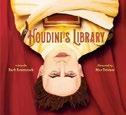
Anyone interested in magic has likely heard of Harry Houdini; less well known is the crucial role books played in his escapades.
Born into a Hungarian rabbi’s family in 1874, Erik Weisz (as he was then known) was 4 when his father sought a better life in Appleton, Wisconsin. As Rosenstock applies her considerable research to document how a poor immigrant with little formal education became a worldfamous entertainer, she weaves in her subject’s lifelong appreciation for and acquisition of magic books—a collection that grew to 15,000 volumes. Although Erik was devastated when job loss forced his father to sell his library, the boy later found a secondhand magic book by Jean Robert-Houdin that inspired a career, stage name, and passion for developing his own library. Rosenstock tells a compelling and wholly original tale, accompanied by Delmar’s stunning 3-D dioramas; created with cut paper and gouache, they employ multiple light sources to yield intricate interior and exterior scenes contrasting glowing illumination and shadowy depth. Miniature postcards, posters, and pages featuring diagrams depict milestones: Houdini’s marriage to a circus performer, his travels across America and Europe, and his feats of
escape from locked chains or submersion in water. A particularly striking composition shows repeated images of the magician swirling through light-filled strips of paper paired with the words: “Books are Harry’s greatest escape. They spark imagination. They bring the past to life.”
Pure magic. (author’s and illustrator’s notes, photographs, sources) (Picture-book biography. 5-9)
Sanders, Rob | Illus. by Gabbie Benda Charlesbridge (32 pp.) | $17.99
January 20, 2026 | 9781623546472
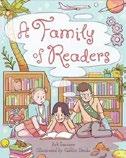
The library is central to a family’s day. The titular characters enter the building and begin browsing. Meanwhile, staffers shelve books, French students work on their pronunciation, chefs find titles on baking bread, actors in costume perform an elaborate storytime, a group of moms convenes for a book club, preteen members of a robotics club gather, and gardeners outside harvest tomatoes. Eagle-eyed youngsters will spot a tan-skinned child clad in green overalls who appears throughout, silently observing from the sidelines. As the day winds down and everyone leaves, the little one walks out, accompanied by a parent and holding a book, and the story closes with the youngster reading at last. Sanders has crafted an invitingly alliterative ode to libraries; this isn’t the stuffy, silent place of yesteryear, but a space that’s vibrant, welcoming, and wholly alive. Benda’s crowded, crisp illustrations feature
people of varying skin tones, hairstyles, abilities, and ages. Some are tattooed; one wears a hijab. A Pride flag sits on the librarian’s desk—this is truly a place for every member of the community. The book is both a lovely way to convince newcomers to visit their local library and a comforting read for those who already feel at home there.
A hopeful and joyful love letter to the public library. (Picture book. 4-7)
Schrefer, Eliot | Illus. by AG Ford
Clarion/HarperCollins (40 pp.) | $19.99
February 10, 2026 | 9780063205376

A bonobo raised in a human household must navigate the confusing transition from her familiar world to life among her own species. Schrefer crafts a narrative that probes questions about identity and belonging. His author’s note reveals the story’s foundation in real rehabilitation efforts, particularly the case of Mimi, a bonobo who spent her first 15 years in a human home before joining a sanctuary in the Democratic Republic of the Congo. Lulu’s dual nature—ape body, human upbringing—creates a cognitive dissonance she cannot articulate, but Ford’s illustrations powerfully express her feelings. His colored pencil and ink artwork employs a sun-drenched yellow-green palette that bathes domestic interiors and the jungle scenes in warm, welcoming light, visually suggesting continuity rather than opposition between Lulu’s two worlds. Ford varies his compositional approach across both environments, shifting between sweeping double-page spreads and focused vignettes that highlight telling details—Lulu using the toilet in her human home, wild bonobos climbing trees and eating fruit. Ford renders bonobo facial expressions with remarkable psychological acuity; Lulu’s wide-eyed dismay upon arriving at the
sanctuary, her uncertain glances at the wild bonobos, and her reassuring smile when, later, she comforts a newcomer all convey complex emotional states. Schrefer’s matter-of-fact prose establishes normalcy before gently dismantling it, respecting young readers’ capacity to grasp cultural displacement. The tale’s honesty about Lulu’s struggle rings true. A moving narrative about the complexity of belonging in two worlds. (Picture book. 4-8)
Star
Shaloshvili, Natalia | Trans. by Lena Traer Enchanted Lion Books (40 pp.) | $17.99 January 27, 2026 | 9781592704774

An endearing kitten learns about the essentials of life.
Relying on concrete ideas and simple sentences, translated from Russian by Traer, Shaloshvili answers the titular question with the basics: “Two small eyes. Two small ears….And whiskers, big and long.” She introduces humor when, before the unseen narrator can mention the kitten’s need for a tail, the wide-eyed black cat runs off without one. She returns for the appendage, then flees to capture a mouse—and returns again, the rodent’s tail dangling from her mouth. (The mouse escapes, but a big teacup of milk resolves the kitten’s hunger.) Sometimes the white page provides the background; other spreads show the protagonist hiding in a gauzy flower garden, sailing in the teacup, or interacting with a supportive bird community. These blue/gray settings, rendered in acrylics and watercolor pencil, are soft as felt. Orange, yellow, and white touches add warmth. As necessities are enumerated, readers will wonder if the kitten has a home.
Eventually a small shelter surrounds her; a window and patch of sunlight follow. The author acknowledges the need for darkness, too; it is present “outside the
window.” The climax reveals what animals (and humans) need most of all: someone to snuggle with, here in the form of a light-skinned child. Shaloshvili has a knack for creating aesthetically and emotionally rich narratives that even young children can appreciate, and this latest is no exception. Beautifully captures the vulnerability and wonder emanating from small creatures. (Picture book. 2-6)
Ruth | Illus. by
(32 pp.) | $19.99 February 24, 2026 | 9780063237766
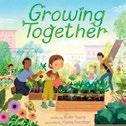
A diverse group of gardeners work together to cultivate a bountiful harvest. A tan-skinned child invites readers to join the many neighbors lending a hand in the community garden. Spiro’s text rhymes with a bouncy beat, using plain language and concise phrasing to explain how to plant, tend, and harvest plants. This garden is rife with delicious offerings— Swiss chard, peas, mint, and beets that “can’t be beat”—and readers are encouraged to volunteer their own favorites. On nearly every spread, friends and neighbors are depicted tending garden beds together in groups of two or more. Little garden lovers will enjoy the variety in Escobar’s illustrations, some showing the bountiful garden in full, others zooming in on small details, like underground roots. Characters vary widely in terms of age, gender, skin tone, and ability, creating a welcoming community, diverse in people and plants, where everyone’s efforts are valued. Consider this tale a fun springtime read-aloud for older toddlers or preschoolers to kickstart discussions about gardens, the plants we eat, and the importance of working together as a team.
A sunny celebration of community, teamwork, and cooperative gardening along with its delectable rewards. (more information on plants, fruits, veggies, and pollinators) (Picture book. 3-7)
Sterer, Gideon | Illus. by Nik Henderson
Clarion/HarperCollins (88 pp.) | $19.99
February 17, 2026 | 9780063357990

Nature responds dramatically to the destruction wrought by humanity. While sitting in a car headed to a home in the woods, a pale-skinned, dark-haired child gazes upon an industrial landscape. The youngster’s view of chugging factories, overflowing dumpsters, landfills, and wastewater captures humanity’s sphere of influence. Arriving home, the child reflects and ponders a solution. By the light of the moon, our protagonist watches a wolf howl for its kin. The sound brings what appears to be simply a cloud formation, then stars, then the eyes of a whirlwind of wolves. This magical swarm forms one immense wolf, who bends to acknowledge the watching child. Though it’s a dreamy experience, when morning comes, the world begins to change. Giant animals appear everywhere: An ant flies beside an airplane, an iguana halts deforestation, and a polar bear dwarfs an ocean oil rig. While some humans look on in confusion, a group of children, led by the strong-minded protagonist, form the outline of a massive person to stand beside the beasts. This wordless, intense narrative celebrates nature’s grandeur, ubiquity, and worth by having animals literally loom large. In good company with Shaun Tan’s and Guojing’s visually rich, affectingly allegorical work, this is a resonant reminder to resist ecological encroachment and stand up for nature. A simple message of environmental protection, skillfully conveyed. (Picture book. 5-10)

A remarkable American story of talent, perseverance, and familial support.
THE
Kirkus Star
Stout, Shawn K. | Peachtree (272 pp.) $17.99 | February 3, 2026 | 9781682635889
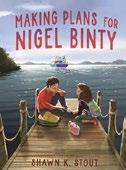
Alternating chapters chronicle the last months of sixth grade for a serious, anxious boy and a strong, angry girl. Nigel Binty’s parents have split up. His longtime best friend, Milo Birch, has new friends now, and Nigel feels like he keeps failing the first step of their middle school survival plan: “Don’t Do Anything Weird.” Glory Bea Medford, newly arrived in Nigel’s class, tells her own part of the story in letters addressed to the father who’s deeply disappointed her, whom she addresses as “Rev.” Glory Bea left Tennessee to live with her Aunt Pauline in Maryland, far away from where Reverend Bartholomew Rhys Medford is serving time in prison after stealing from his church. When Glory Bea’s secret gets out at school—and it’s Nigel’s fault—he finds that his worries and chronic stomachaches surprisingly fade away as he tries to focus on a plan to repair the damage and show Glory Bea that she has an ally in him. Stout portrays Nigel’s introspection and anxiety authentically. His unhappiness is both deeply poignant and darkly humorous. Glory Bea’s forthright, essential goodness allows her to show Nigel the kindness and understanding both children need. Stout’s latest is a genuine, believable look at the way a single connection can be redemptive, even in what can feel like the worst time of one’s life. The cast largely presents white.
Beautifully wrought; convincing, affirming, and entertaining. (Fiction. 9-13)
Thomas, Garen & Lori Rozsa | Harper/ HarperCollins (240 pp.) | $19.99
January 20, 2026 | 9780063311442

A detailed account highlighting the experiences that shaped the life of the first Black woman to become a Supreme Court justice.
Ketanji Brown Jackson was born in Washington, D.C., and raised in Miami, Florida, near extended family. Her parents, an educator and a lawyer, believed in the power of education and sought out the best learning environments for their bright, self-directed daughter, who had a positive outlook even in the face of challenges. They also worked hard to ground her in Black history and culture. Ketanji’s involvement with a high school speech and debate team had a lasting impact as she became determined to follow her father into law. Her powerful work ethic, academic success, and depth of experience brought her to the attention of influential figures in her field, and her winning personality enabled her to surround herself with supportive friends and a loving husband. The authors write in a conversational tone, providing an engaging and inspiring account of Jackson’s life—peppered with ample quotations—while placing each aspect of her journey within the broader context
of African American history. Thomas and Rosza successfully merge background information with biographical details to give readers insights into her journey. The book closes with Jackson’s advice for a successful life (taken from her speeches) and an annotated list of 10 women she’s named as her heroes. A remarkable American story of talent, perseverance, and familial support. (endnotes, bibliography, glossary, index) (Biography. 10-14)
Thomas, Isabel | Illus. by Sara Gillingham Phaidon (224 pp.) | $24.95 November 12, 2025 | 9781837290635
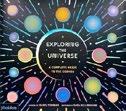
An illustrated guide that explores the science of “what we know about the universe beyond Earth’s surface, and how we know it” from the creators of Exploring the Elements (2020) and Full of Life (2022).
The book opens with an introduction that encourages readers to explore its contents however they wish rather than feeling constrained to read in order from beginning to end. Science writer Thomas divides the information into six sections: “Earth,” “Near-Earth Space, “Our Solar System,” “Stars,” “Galaxies,” and “The Universe.” Readers can tighten their Kuiper Belt and head through the Oort cloud to explore the thoughtfully laid-out topics, each covering a two-page spread. The clear writing is dense with information. Factoids about subjects such as tardigrades and exploding meteors will reel in younger readers, while information about topics like the cosmic web and measuring gravitational waves speak to a more sophisticated audience. The stylized font used for many headers can be difficult to decipher. Timelines, key facts, and text boxes accompany the entries, with succinct explanations arranged in colorful squares. Catchy subheadings (“Are We There Yet?,” “What Is It Made Of?”) and Gillingham’s generous use of
color and gradient shading against black backgrounds keep the look lively and the information flow organized. The plentiful illustrations use saturated colors and crisply rendered geometric forms to support concepts, present diagrams, and portray space scientists from around the world. Brightly presented and packed with facts. (glossary, resources, index) (Nonfiction. 8-14)
Threets, Mychal | Illus. by Lorraine Nam Random House (32 pp.) | $18.99 February 3, 2026 | 9798217026029

The author—a social media influencer, former librarian, and host of the revival of PBS’ Reading Rainbow —celebrates the familiar pleasures of a library visit. Threets, who has promoted libraries and reading online, follows his positive message to its logical conclusion: a picture book that seeks to cultivate “library joy.” As the book begins, Threets, sporting his signature soft, fuzzy Afro hairstyle, opens the library’s doors wide to a crowd of kids and grown-ups. Patrons pour in. A Black mom with cornrows lifts a toddler to a bookshelf, a pale-skinned blond child cuddles her dads while perusing a book about butterflies, and a tan-skinned girl watches her abuela mend a teddy bear. At the reference desk, a bespectacled, pale-skinned child asks Mychal for animal books and is soon deep in study behind a tall stack. Of course, the library isn’t just for books—kids garden and play board games, and a parent checks out a set of cymbals. Finally, the book reaches a gleeful moment—storytime! Offering a simple script for the essential experience of a family library day and positioning librarians as friendly guides, Threets provides a perfect read-aloud for before, during, or after a library visit. Nam’s bright, solid-colored illustrations are simple yet
involving, following a visually specific cast closely through relatable moments, with characters grinning at and embracing one another easily. In this well-considered tale, library joy is simple, and library joy is real. (author’s note) (Picture book. 3-8)
Thummler, Brenna | HarperAlley (320 pp.)
$24.99 | January 13, 2026 | 9780063335288

From the creator of the Sheets series comes a graphic novel about young sleuths who chase a notorious mailstealing bandit. Willa, who presents white, is known as the “quiet girl” in her fictional town of Stony Lonesome. Willa dreads speaking to people outside her immediate family and struggles to connect with others. She dreams of becoming a mail carrier and being “part of the world’s most beautiful way of communicating”— writing. When Willa is mistaken for the mail thief Two Gum Tilly, her dream of becoming a postal worker seems to be threatened. In an effort to clear her name, Willa joins the Gumshoe Gang, a racially diverse group of runaway girls whose mission it is to capture Two Gum Tilly. As a member of the gang, Willa finally feels accepted, and she gradually learns that the others have their own unique struggles. Thummler uses vibrant shades of yellow, pink, purple, and blue to depict the Arizona landscape. Flashbacks filling in Two Gum Tilly’s story are portrayed in a sepia-toned palette. The characters speak in a style reminiscent of Old West movies (“Darn tootin’”), and both the mail workers and the Gumshoe Gang sport kitschy, cowboy-inspired uniforms. Willa’s inner dialogue authentically reveals her struggles with social anxiety; the other runaways’ backstories feel
underdeveloped and unconvincing, however. Additionally, Willa’s parents feel one-dimensional in their response to her disappearance and mental health.
A visually appealing, girl-powered, Western-inspired mystery that affirms quiet kids. (Graphic mystery. 9-12)
Torii, Yuko | Rise x Penguin Workshop (32 pp.)
$17.99 | March 3, 2026 | 9780593887271
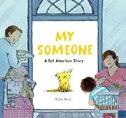
A stray dog desperately seeks a better life.
“I don’t like being alone,” a scruffy yellow pup states flatly. As the book opens, we see the pup scavenging in garbage cans, ducking fights with bigger, threatening mutts, and dodging gigantic, deafening trucks. Taking shelter during a downpour, the shivering pooch gazes longingly at dog and human families on the sidewalk nearby, hoping to be noticed, only to encounter animal rescue workers. They give the dog a bath and shots (“I REALLY don’t like this,” our narrator comments). At last an East Asian–presenting parent and child arrive to see the dog (attentive readers will recognize them from the sidewalk spread). Cautiously, the dog sniffs the child’s hand, and the child scoops up the dog. Inside the humans’ bright, cheery house, the dog declares, “I like this place…it’s warm and quiet.” While no place is perfect, our protagonist feels safe and loved at last, with “my someone.” Torii’s watercolor and ink artwork balances moody washes of gray and blue with expansive white space to convey the little dog’s emotional journey, effectively using varying perspectives and comic book–style illustrations for humor and engagement. Spare, poetic text anchors readers in the dog’s inner monologue, with emotions heightened by the pooch’s comical expressions. A heartwarming tale of trust and belonging. (Picture book. 3-6)
THE STARTUP SQUAD
Star
Tiny Garden
Underwood, Deborah | Illus. by Jax Chow Abrams (32 pp.) | $18.99 | March 3, 2026 9781419774911

Good things come in small packages. Andrew, a young boy who presents East Asian, finds the neighborhood gardens outsize: “Too big. Too tall. Too much.” So he digs a rectangular plot about the length of his trowel. When a neighbor criticizes it as “far too small,” Andrew is polite but firm: “This will be a tiny garden.” He adds seeds, “tucking them in with soft pats.” Time and water produce green sprigs and colorful blooms: “a tiny, perfect jewel box of a garden.” The green-booted passer-by, judging in terms of human utility, asks rudely, “What is the point? You can’t walk in it. You can’t sit in it. You can barely see it!” Andrew is unruffled, and soon a moth flying by can’t “believe her compound eyes,” finding rest and relief there. A tiny earthworm, hummingbird, and ladybug find the garden “just right”; Andrew dubs them “small friends.” The neighbor, impervious to beauty or blind to scale, still doesn’t see the point, but Andrew calmly replies, “That’s okay…I do.” Underwood’s sweet story valorizes “little things” and the true gardener’s intoxication with the earth. Chow’s illustrations are brilliant. First dominated by green and brown, with pops of red and blue, her richly saturated watercolors
transition to carmine, teal, emerald, and sapphire once the little garden is thriving, building to a final, gloriously vibrant spread.
A tiny delight that celebrates patience, Zen-like focus, and appreciation for the small things. (Picture book. 4-8)
Vedder, Leslie | Illus. by Abigail Larson Putnam (304 pp.) | $18.99 | February 10, 2026 9798217004188

An elusive and all-devouring beast from Nowhere threatens not just Covenant Keep but the entire Waking World in this sequel to The Labyrinth of Souls (2025).
Returning to Candle Corps Academy as a second-year Spark, 13-year-old Ix Tatterfall still wrestles with feelings of inadequacy. She’s also sad to be separated from her parents, who are in the Labyrinth of Souls, a realm that’s largely off-limits to the living: Ix’s mother is Death, the Soul Reaper, and her father is a Lesser Sorrow, the Melancholy of Regret. But the twin menaces of a hungry, growing monster that’s “hiding in someone’s shadow” in between attacks and ominous signs that the school’s magical foundations are crumbling thrust her into the center of events that are dangerous enough to test even her closest relationships. Most of the cast falls into familiar types, but Vedder includes an abundance of Ding Bats, Bully Goats, and other creative Nightmares. She clearly aims to amuse as well as engage readers by sending her
protagonist into realms that are normally considered metaphorical—notably Nowhere, which gathers up all the lost and forgotten things, from keys to wishes—on the way to a properly frightful All Hallows’ Eve and a resolution that’s founded more on compassionate understanding than flashy magic. Characters are diverse in skin tone. Final art not seen. Will please fans of magic school stories, with enough tweaks to feel fresh. (glossary of Nightmares) (Fantasy. 9-13)
Wallace, Sandra Neil | Illus. by Evan Turk Calkins Creek/Astra Books for Young Readers (48 pp.) | $19.99 | February 10, 2026 9781662680694

An immigrant preserves, then elevates, a fragile, centuries-old art. Baba teaches Marie to craft Easter “pysanky— beautiful, decorated eggs—in the same way Ukrainians had done since ancient times.” Grandmother and grandchild labor over homemade dyes and fresh chicken eggs, painstakingly etching with beeswax the intricate and symbolic designs. Each pysanka is “a story, a wish, a prayer, a gift,” “for the legend goes that as long as pysanky are decorated, there will be good in the world.” Displaced by the “fighting and famine” of World War II, Marie flees Ukraine and resettles in Minneapolis, where the vibrant immigrant community inspires her to resume her handicraft. Marie passes on the tradition to her children and theirs, expanding the imperiled folk art while supporting herself and her family. Canting shifts in perspective capture the family with aquiline features, ruddy cheeks, and golden skin that’s frequently echoed in yellows throughout the detailed lines of Turk’s bold illustrations.
Extensive backmatter includes a note on Wallace’s Ukrainian heritage and the real-life Marie Sokol Procai, and cultural respect rings through thoughtful elements including complex embroidered fabrics and recurring motifs like wheat and sunflowers. Exploring the power of art to preserve vulnerable heritage, the tale offers potential cross-discipline appeal; pair it with Julie Paschkis’ picture book P. Zonka Lays an Egg (2015) and Katherine Marsh’s novel The Lost Year (2023) for rich lessons in history and holidays.
A proud and meticulously wrought ethnography. (more information on pysanky, playlist, bibliography, photographs, photo credits) (Picture-book biography. 5-9)
Weatherford, Carole Boston | Illus. by Savanna Durr | Abrams Appleseed (40 pp.) $18.99 | October 14, 2025 | 9781419771507

Weatherford celebrates the strengths and achievements of famous African American women. This companion volume to Hair Like Obama’s, Hands Like Lebron’s (2024) uses the power of poetry to highlight important figures while demonstrating how young people can emulate them. The 17 women highlighted come from various walks of life. The book’s young narrator ventures forth with “nerves as steady as Harriet’s” and “feet as firm as Rosa’s.” Apart from historical figures Tubman and Parks, Weatherford also pays tributes to the likes of former Vice President Kamala Harris and Supreme Court Justice Ketanji Brown Jackson. While the subjects may come from different worlds, Weatherford draws deft connections between them; former First Lady Michelle Obama and basketball coach Dawn Staley both possess strong leadership skills, for instance. The author lauds her subject’s physical traits (“With skin as bronze as Imam’s / I’m kissed by the sun’s bright light”) as well as their
inner qualities, emphasizing that readers, too, can display such resilience and perseverance. Her smooth rhymes enliven this text and bring to life the importance of role models. Filled with vibrant colors, Durr’s digital illustrations make clear the connection between the young protagonist and the accomplished subjects; this little one twirls like ballerina Misty Copeland, quilts like artist Faith Ringgold, and gazes through a telescope as NASA mathematician Katherine Johnson works on equations. Brief biographies are a welcome addition in the backmatter.
Further examples of Black excellence in action—rousing and inspiring. (author’s note) (Picture book. 3-6)
aggressive marketing. Fortunately, Resa divulges her dilemma to her friends, who rally to help with product development and a coherent sales strategy. They’re a team for a reason; they know that every angle of the process counts. With functional, bright illustrations, occasionally stiffened by long stretches of dialogue, and a straightforward storyline, there’s definitely a lesson here, relayed with conviction. Resa’s frustrations with her friends add a dash of drama to entice even skeptical readers to invest. Resa and her grandmother are brown-skinned and Latine, and other characters represent a diversity of skin tones. Business smarts and collaborative creativity laid out clearly in comics form. (note on business practices) (Graphic fiction. 8-12)
$22.99
Weisfeld, Brian & Bonnie Bader | Illus. by Nadia Hsieh | Philomel (176 pp.) |
$12.99 paper | February 3, 2026 9780593621646 | 9780593621653 paper Series: Startup Squad

A fresh business venture faces challenges in the big city. In a new story separate from their previous series, the Start-Up Squad— a group of young friends who have run a range of businesses, from a lemonade stand to wedding planning— have made the move from prose chapter books to comics, and they’ve also left home to visit Resa’s Abuela in New York City. Resa’s friends get along swimmingly with Abuela, and Resa quickly begins feeling like the fifth wheel. But Abuela sprains her ankle and has to stay home, so Resa offers to work at her grandmother’s shop in her stead, hoping to escape her frustrations. Serendipitously (or suspiciously) she contributes capital funds—questionably procured from the cash register—to support two girls planning to make and sell dog bandanas. The girls flippantly accept her hastily offered cash and nearly tank their business with sloppy product and overly
Willems, Mo & Kate Miccucci
Union Square Kids (64 pp.) | $10.99
February 24, 2026 | 9781454951476
Series: Elephant & Piggie Like Reading!

The strength of the subconscious is strong in this tale of puppetry and performance. In this latest entry in the Elephant & Piggie Like Reading! series, cheery, gray-skinned Monster, sporting a jaunty red cap, spots a green puppet abandoned on the street. Once on Monster’s hand, Puppet immediately launches into a conversation, encouraging Monster to put on a show. Game, Monster dubs it “The MONSTER and PUPPET Show,” before being corrected by Puppet: It’s actually “The PUPPET and Monster Show.” It becomes fairly clear that Puppet is the one calling the shots with this act. Monster is told when to tell jokes, perform funny dances, and sing. Fed up at last, Monster launches Puppet into the air, and the two come to a mutual understanding. Kids learning
to read will find the words clear and rarely longer than the titular heroes’ names. The story is delightful and even contains a moment of existential crisis when Puppet has to inform Monster that they are one and the same. Monster’s response? “WHOA!” Meanwhile the well-laid-out, cartoonish art expertly expresses every emotion, sometimes with just the characters’ eyelids alone. Monstrous fun awaits those willing to combine learning to read with puppetry hijinks. (Early reader. 4-8)
Williams, Alicia D. | Illus. by Anna Cunha Caitlyn Dlouhy/Atheneum (40 pp.) | $19.99 February 3, 2026 | 9781665914222
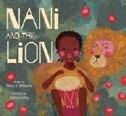
Near an African village, a lion lurks in the grasslands, frightening people and animals alike, until a little drummer girl changes the big cat’s tune. Nani loves to drum; the music she makes echoes the sounds of nature and inspires her neighbors to dance. Cunha’s digital inks balance warm and cool tones, vibrantly contrasting human characters’ brown skin, brightly patterned dresses, and textured foliage with pink and yellow clouds and the dark blues of the forest. Each page turn leads to yet another artful spread. Animals frolic to Nani’s drumming, but farmers tending their crops are terrified of the predator who looms and shush her. As Nani ventures further out to find a space safe for her boisterous art, the world around her shifts and grows; she encounters polka-dotted giraffes and “aardwolves.” But when the lion makes himself known with thunderous roars and crushed flowers beneath his paws, the subtext of this colorful allegory about confronting bullies becomes most potent. Nani, of course, stands up to the lion, playing her drum so beautifully that he has no choice but to dance. Exhausted at last, he falls to the ground. The scene of the villagers rejoicing, their arms splayed wide above their heads,
with a botanical foreground and a pink mountainous sky behind them, is exuberantly charming. The image of Nani and a slumbering lion that follows offers a serene but cohesive contrast to conclude the story.
A lion-taming tale with rhythm and heart. (Picture book. 4-8)
Williams-Harry, Donette | Illus. by AmélieAnne Calmo | Tiger Tales (32 pp.) | $18.99
January 6, 2026 | 9781664300606

A little girl’s favorite day of the year poses some unique challenges, but she handles it with the grace of a queen. With her bonnet still on, Kayla looks out the window to see costumed dancers amid the thunderous boom of the recently set up speakers. After helping Grandma cook Caribbean treats and sitting with Mommy to have festive and colorful beads put in her hair, Kayla dons the glittery outfit that she’ll be rocking today as a Carnival queen. With “pretty costumes and BIG ENERGY,” Granny, Mommy, and Kayla test out their moves; their brown skin, their colorful clothing and accessories, and Kayla’s ornamental hair beads and headdress are all vibrantly illustrated to capture movement and cultural flourishes. But maybe they’re moving too fast too soon—Kayla slips and rips and pops out of her costume. Sadly, there’s not much time before the carnival begins. But Granny reminds young Kayla—and readers—that the real purpose of the festivities isn’t costumes, but rather a connection to the ancestors, a global celebration of pan-African
heritage, as Williams-Harry notes in her backmatter. And it should be no surprise that the community eventually comes together for Kayla, taking her costume to another level as the Soca music blares and she rises again in her richly colored, feathered, and shining new dress as “CARNIVAL QUEEN!”
A celebration of a celebration, both fun and inviting. (note on Carnival) (Picture book. 4-8)
Winston, Sherri | Bloomsbury (240 pp.) $17.99 | January 20, 2026 | 9781547617029

A n adoptee from Washington, D.C., makes a birthday wish to know who she is and where she’s from—but the truth is beyond her wildest dreams. Zahara-Grace Jones, a Black girl with attention-grabbing blue eyes, lives with her Black adoptive mom and grandfather, G-Pop. On her 12th birthday, G-Pop gives Zahara-Grace a DNA test, and Mom reveals that she’s finally allowed to talk about her birth mother, Yala St. Claire, who was killed in an accident along with Zahara-Grace’s birth father. Yala also left a letter and gifts for her daughter. Soon another surprise arrives: Zahara-Grace’s biological maternal grandfather, King Zumari Babatunde of Maliwanda, has found her through the DNA test and reveals that she’s a princess and heir to the throne. An overwhelmed ZaharaGrace gets caught up in her friend Persephone’s obsession with a curse stretching back to ancient Egypt that’s
Easter fun delivered along with advice for staying on top of necessary tasks.
LITTLE BUNNY’S TO-DO LIST
purported to haunt the women in Zahara-Grace’s lineage—one that must be broken before it claims ZaharaGrace’s life. The strength and love of Zahara-Grace’s family and friends form the center of this novel. The curse storyline is entertaining, but where the novel really shines is in its depiction of the nuances of Zahara-Grace’s experience as an adoptee and her journey to coming to terms with her love for both her adoptive and biological families. The depiction of the intensity and complexity of tween friendships is also strong and will resonate with readers.
A delightful story that combines creative fantasy elements with rich character development. (Adventure. 8-12)
Yang, Kao Kalia | Illus. by Jen Shin Univ. of Minnesota (36 pp.) | $17.95 February 10, 2026 | 9781517907976

Room by room, a young narrator nostalgically recalls Aunt and Uncle’s long-ago home, cramped, chaotic, yet so filled with love.
The address remains exact—“off Maryland Avenue, behind a bar on Payne Avenue, on the east side of St. Paul”— even if the titular blue house is long gone. Once upon a time, it was a duplex, “its first floor rented to Hmong refugees.”
Sometimes the upstairs neighbors had to “thump, thump, thump” when “we children downstairs played too loudly, laughed too hard, or jumped too high.” The porch was the two boy cousins’ room, where their hair would freeze overnight during winter. All the kids ate on the mismatched sofas in the dark living room. The three older girl cousins danced to cassette tapes in their room. The favorite back porch was where Uncle was welcomed home after surgery. Although it was Aunt and Uncle’s home for just two years, “my memory of that house kept them close to me long after our lives in America had spread us far from each other.” Artist Shin’s architectural prowess enables spectacularly
meticulous illustrations from multiple viewpoints that undeniably elevate Hmong American Yang’s poignant, longing prose. Intricate full-color details—hanging flyswatter, scattered sneakers, fading hopscotch grid, a child too small to reach the faucet—add resonating depth, underscoring a loving family in constant motion. Cherished memories transform a sagging house into a vibrant home, long after the family’s move. (Picture book. 5-10)
Zax,
Helen Kemp | Illus. by Kiersten Eve Eagan | Abrams Appleseed (40 pp.)
$14.99 | January 6, 2026 | 9781419779480
Series: A Magical List Book

It’s almost Easter! How is Little Bunny preparing? Though the holiday is quickly approaching, Little Bunny still has a long to-do list. After a few nibbles of magic carrots, Little Bunny transforms from an ordinary-looking rabbit in a hutch into an anthropomorphic creature clad in a bowtie, suspenders, and striped trousers. Our hero must gather and decorate eggs, collect jelly beans, and pull chocolate rabbits from a magical hat before delivering baskets full of treats to youngsters, with a little help from some supportive animal and gnome friends. Eagan’s digitally created springtime pastel illustrations burst with energy, pairing well with Zax’s simple descriptive phrases. Read the book slowly to notice the gentle rhymes and pore over the detailed images, or zip through it to mirror exuberant Little Bunny’s bustling Easter preparations. After such a packed day, it’s no wonder that Little Bunny is ready to snuggle close with the other rabbits in the hutch. Readers should check out the copy of Little Bunny’s To-Do List that is hidden under a flap at the end of the book for an early organizational nudge; as Zax notes, “To-do lists are more than pure magical fun. / They
help us keep track of what needs to get done!”
Easter fun delivered along with sound advice for staying on top of necessary tasks. (Picture book. 3-5)
Zephaniah, Benjamin | Illus. by Melissa Castrillón | Clarion/HarperCollins (32 pp.) $19.99 | February 17, 2026 | 9780063472297

Stunning illustrations showcasing one family’s connection to trees are paired with spare, lyrical text from the late British poet Zephaniah. The story opens with a Black child peacefully enjoying nature in the shade of a prodigious tree. A pale-skinned youngster joins the first child, and the tree remains a constant presence as time passes and the pair become adults and have a little one together. But when nearby trees are felled and their ancient, beloved tree is marked for destruction, the couple’s brown-skinned, pigtailed child becomes distraught. The family joins a community protest to save the trees. Zephaniah’s text is an uncomplicated, wholly sincere love letter to trees and a call to action to save them, encapsulated in the repeated refrain “Leave the trees, please. / Because the trees / work with the breeze / to put all living things at ease.” Dominated by shades of burnt orange, reds, and greens, Castrillón’s striking art depicts a forest filled with lush flora and fauna that comes alive due to the illustrator’s deft use of wavy line movement. The text and images are each excellent on their own, but they enhance each other as they work together, creating both a universal plea and a specific, moving story. Backmatter explains photosynthesis and suggests ways kids can protect our planet.
An exquisitely crafted ode to trees, sure to inspire budding environmental activists. (Picture book. 4-8)

1 Seeds of Discovery
By Lori Alexander; illus. by Rebecca Santo Absorbing and inspirational.
2 My Presentation Today Is About the Anaconda By Bibi Dumon Tak; illus. by Annemarie van Haeringen; trans. by Nancy Forest-Flier
A brilliant use of anthropomorphic animals, serving up facts and entertainment.
3 Jella Lepman and Her Library of Dreams
By Katherine Paterson; illus. by Sally Deng
A stirring, singular tribute to a woman well aware of the importance of children’s books in times of
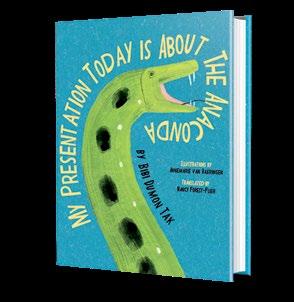


Doomsday Detectives By Cindy Jenson-Elliott; illus. by Theo Nicole Lorenz
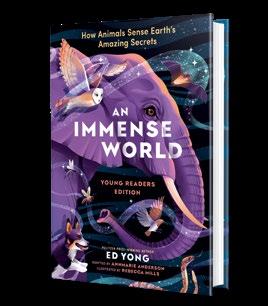

Uri Shulevitz

The adapter of the young readers’ edition of How the Word Is Passed answers our questions.
FOR SONJA CHERRY-PAUL, Clint Smith’s How The Word Is Passed was the book of 2021.
“It was the book I was most excited to read that year,” she tells Kirkus via email. “Clint has gifted the world with a compelling, poignant memoir about place, truth, memory, and also possibility. I remember the feeling of just not being able to put it down.”
According to Kirkus’ starred review of How the Word Is Passed (Adapted for Young Readers): Remembering Slavery and How It Shaped America , young readers are in for a similarly powerful experience. That’s why Cherry-Paul’s “important and phenomenally executed” adaptation is one of our Best Middle-Grade Books of 2025.
In adapting How the Word Is Passed for young readers, what ideas, principles, or rules guided your work?
I brought my experiences as a former classroom teacher, my continued work today with educators and their students, and my understanding of adolescent literacy development to this adaptation. My work is informed by critical pedagogies—ideologies and practices that affirm the full humanity of everyone, particularly those who are marginalized and oppressed. When young people have opportunities to develop their sociopolitical consciousness as readers, this empowers them to identify, question, and challenge oppressive structures and systems. Reading is a powerful form of resistance for young people who are
truth-seekers and are ready to put their ideas about freedom and justice into action.

What inspired you during the writing process? What were you reading, listening to, watching?
I reread some of the work of Audre Lorde, bell hooks, and Mariame Kaba for continued reminders about the importance of resistance, love, and critical hope in the collective work toward liberation.
Where and when did you write? Describe the scene, the time of day, the necessary accoutrements. My sunroom is the place I love to write the most. There are large windows across the room that look out to Japanese maple and evergreen trees. I prefer to write in the morning, when I’m feeling most hopeful. I enjoy hearing the robins and blue jays that frequent these trees. The light and warmth of the sunroom, the sound of bird-music, and a hot cup of peppermint tea are my writing tools.
What was most challenging about writing the book? And most rewarding?
It was exciting to think about the nonfiction reading experiences readers would be bringing to this text—and leaning into this. The structural changes made to the book create a unique, accessible reading experience to a wide range of young people. Most challenging was deciding what to remove, and considering the impact that removing something in one part of the book would have on another part. Really knowing the text well, and


How the Word Is Passed (Adapted for Young Readers): Remembering Slavery and How It Shaped America
Smith, Clint | Adapt. By Sonja Cherry-Paul Little, Brown | 272 pp. | $18.99 September 2, 2025 | 9780316578509
maintaining a bird’s-eye view of it, was critical to making sure that the purpose and meaning of Clint’s work wasn’t lost. It was rewarding to develop this adaptation in ways that didn’t water down the content. Clint and I are both former classroom teachers who respect the brilliance of young people and all that they’re capable of as readers and thinkers.
What book or books published in 2025 were among your favorites?
Black in Blues: How a Color Tells the Story of My People by Imani Perry; Original Sins: The (Mis)education of Black and Native Children and the Construction of American Racism by Eve L. Ewing; and Toni at Random: The Iconic Writer’s Legendary Editorship by Dana A. Williams.
Interview by Megan Labrise


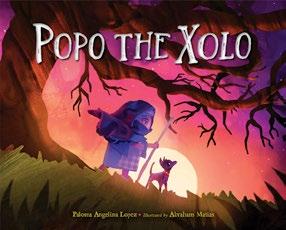










EDITORS’ PICKS:
Heart the Lover by Lily King (Grove)
Schott’s Significa: A Miscellany of Secret Languages by Ben Schott (Workman)
Dead Ends! Flukes, Flops & Failures That Sparked Medical Marvels by Lindsey Fitzharris & Adrian Teal; illus. by Adrian Teal (Bloomsbury)
K-Jane by Lydia Kang (Quill Tree Books/HarperCollins)
THANKS TO OUR SPONSORS:
The Tale of Mr. Crocodile Takes Tea by Lance Lee, illus. by Cilla Hunkeler
Teddy & Freddy by Debra Burr Downing, illus. by Jason Velazquez
Spell Ya Later by Zoe Shae

An actor and comedian has some fun with middle-grade fiction.
BY MEGAN LABRISE
On this episode of Fully Booked I’m joined in conversation by Kate McKinnon, author of Secrets of the Purple Pearl (Little, Brown, September 30), Book 2 in the No. 1 New York Times –bestselling middlegrade series, The Millicent Quibb School of Etiquette for Young Ladies of Mad Science. “In a race against their enemies, the Porch girls must find a peculiar pearl in order to foil a fiendish plot,” Kirkus writes in a starred review of a sequel that’s “unforgettably quirky, fastpaced fun.”


McKinnon is a bestselling author and award-winning performer, who is celebrated globally for her work in film and television. Young readers will recognize her as the voice of Ms. Frizzle in The Magic School Bus Rides Again for Netflix. She recently played Weird Barbie in Greta Gerwig’s worldwide blockbuster hit film, Barbie.
Here’s a bit more from our review of Secrets of the Purple Pearl: “After defeating a monstrous Kyrgalops in The Millicent Quibb School of Etiquette for Young Ladies of Mad Science (2024), Gertrude, Eugenia, and Dee-Dee Porch find themselves at Lake Kagloopy’s Purple Pearl Hotel with their mentor, Millicent Quibb. Quibb informs the trio that they must find the titular pearl before the members of their evil mad-scientist rivals, the KRA, do. If they fail, the KRA plans to use the gem to bestow the Gift of Endless Vibrancy on the villainous Talon Sharktūth.…Jokes aside, the girls’ story is intriguing, offering more clues to their mysterious backgrounds and tantalizing tidbits promising later adventures. McKinnon offers bountiful backstory and

Secrets of the Purple Pearl McKinnon, Kate Little, Brown | 320 pp. | $17.99 September 30, 2025 | 9780316555296
enough guffaw-inducing jokes, zany footnotes, and creative jargon to enthrall readers both new and old with her delightful sophomore effort. Mixing humor, found family, and well-wrought worldbuilding, this sequel is a certain crowd pleaser.”
McKinnon and I discuss a panoply of topics, including but not limited to: storytelling, mad science, wild hairdos, secrets, Sappho, seafood buffets, sisterly bonds, the writing process, Roman numerals, Echinodermata, the excellence of children’s literature, and kids these days.
Then editors Laurie Muchnick, John McMurtrie, Laura Simeon, and Mahnaz Dar join me to discuss their top picks.
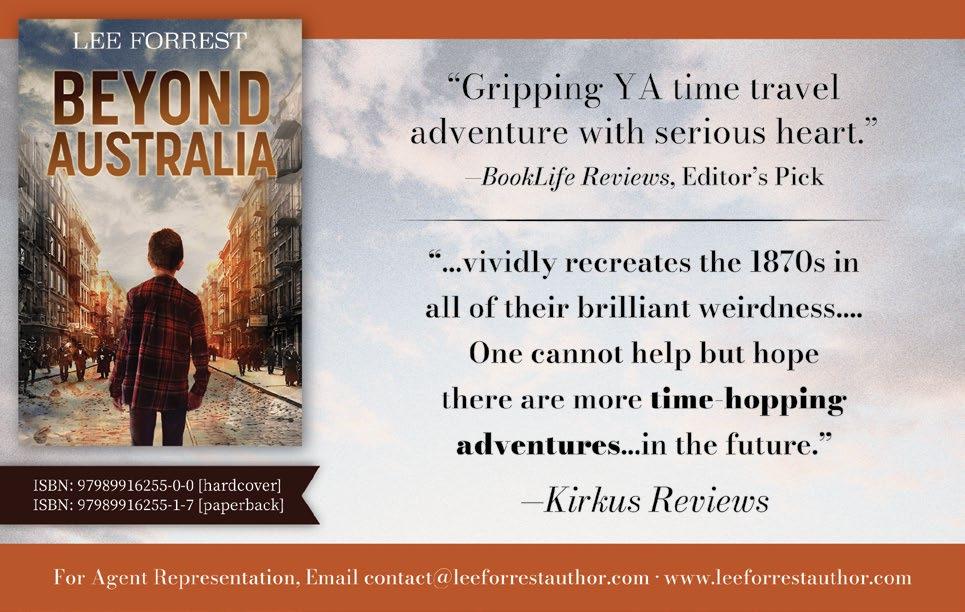
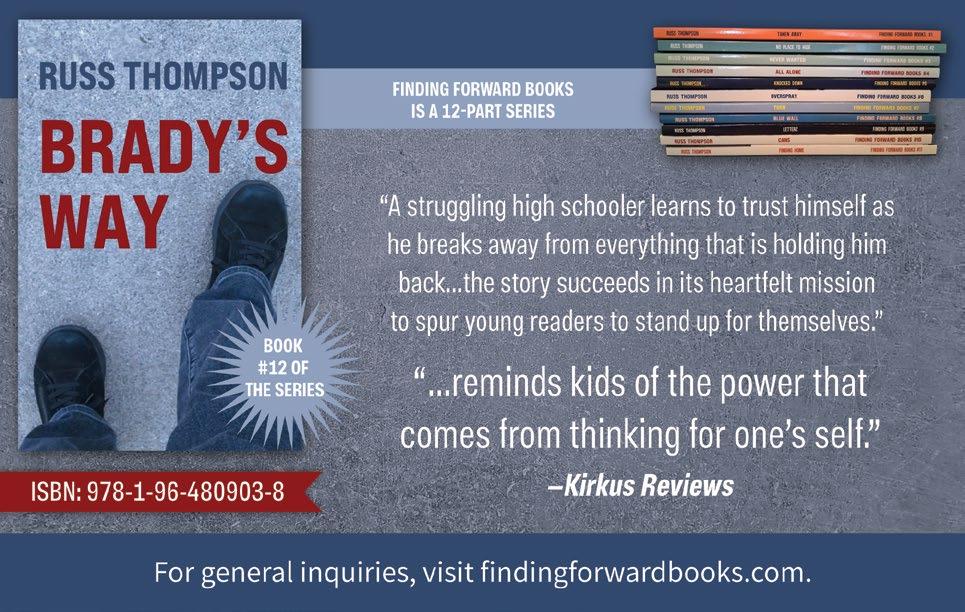

It’s truly a joy to pause and reflect on the bounty on our list of the best YA releases of the year. We have a variety rich enough to satisfy any teen: books by bestselling fan favorites and debuts that are sure to take the world by storm, much-anticipated sequels and series openers that will leave readers anxious for future volumes, books that satisfyingly elevate genre tropes and those that experimentally push boundaries. Read on!
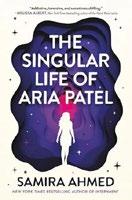



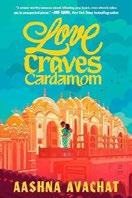
Ahmed, Samira | Little, Brown (368 pp.)
$19.99 | May 13, 2025 | 9780316548687
A heart-pounding coming-of-age story of a girl trapped in the whirl of a “multiversal tornado.” (Speculative fiction. 12-18)
Ancrum, K. | Harper/HarperCollins (384 pp.)
$19.99 | April 22, 2025 | 9780063285835
Queer resilience at its finest. (Romantic thriller. 14-18)
Åstot, Moa Backe | Trans. by Agnes Broomé | Em Querido (192 pp.) | $19.99 October 14, 2025 | 9781646145751
Limns the volatile peaks and valleys and emotional quicksand of adolescence with compassion and wry humor. (Fiction. 12-18)
Atkins, Marcie Flinchum | Versify/ HarperCollins (320 pp.) | $19.99 March 4, 2025 | 9780063339316
Powerful, necessary reading. (Verse historical fiction. 13-18)
Avachat, Aashna | Joy Revolution (320 pp.) | $12.99 paper May 20, 2025 | 9780593571583 Series: Love in Translation, 2
A compelling stand-alone debut blending adventure, romance, and self-discovery. (Romance. 12-18)




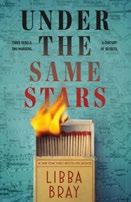
Azar, Kiera | Storytide/HarperCollins (464 pp.) | $15.99 | September 2, 2025 9780063427792 | Series: Thorn Season, 1
A gripping, gorgeously written debut that refuses to play it safe. (Fantasy. 14-18)
Bausum, Ann | Roaring Brook Press (368 pp.) | $21.99 | August 12, 2025 9781250816573
Essential reading. (Nonfiction. 12-18)
Boulley, Angeline | Henry Holt (384 pp.) $19.99 | September 2, 2025 | 9781250328533
A powerful story of family, belonging, and identity interlaced with thriller elements. (Thriller. 14-18)
Braun-Arnold, Lily | Delacorte (320 pp.) $19.99 | January 7, 2025 | 9780593899489
A beautifully realized addition to the genre. (Post-apocalyptic. 14-18)
Bray, Libba | Farrar, Straus and Giroux (480 pp.) | $24.99 | February 4, 2025 9780374388942
A breathtaking journey that will leave a lasting impression on readers’ minds and hearts. (Historical mystery. 13-18)



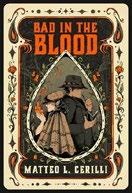

Bridge, Mikayla | Farrar, Straus and Giroux (416 pp.) | $20.99 | July 15, 2025
9780374393427
High-stakes competition, swoony romance, and expertly crafted worldbuilding distinguish this debut. (Fantasy. 13-18)
Browne, Mahogany L. | Crown (160 pp.)
$19.99 | March 11, 2025 | 9780593486474
Heavy, important, powerful and evergreen; remembers kids during the time when the world stopped. (Fiction. 13-18)
Buffini, Moira | Storytide/HarperCollins (452 pp.) | $19.99 | October 28, 2025
9780063358263 | Series: The Torch Trilogy, 2
Heartbreaking, heartening, wondrous. (Dystopian. 14-18)
Cerilli, Matteo L. | Tundra Books (400 pp.)
$19.99 | September 2, 2025 | 9781774882337
A cinematic and enthralling flare of fey magic. (Paranormal mystery. 14-18)
Cheng, Linda | Roaring Brook Press (336 pp.) | $19.99 | November 4, 2025 9781250865816
Intense and atmospheric; sure to live on in readers’ minds long after they finish. (Horror. 14-18)


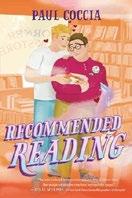
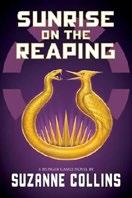
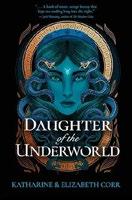
Chewins, Hayley | Viking (336 pp.) | $19.99 March 25, 2025 | 9780593623862
A beautiful, introspective slow burn of a book. (Verse fiction. 14-18)
Ciccarelli, Kristen | Wednesday Books (464 pp.) | $20 | February 18, 2025 9781250866929 | Series: The Crimson Moth, 2
A captivating finale to a highly addictive and entertaining duology. (Fantasy. 13-18)
Coccia, Paul | Zando Young Readers (320 pp.) | $19.99 | January 28, 2025 9781638931492
10/10 would recommend! (Romance. 14-18)
Collins, Suzanne | Scholastic (400 pp.)
$27.99 | March 18, 2025 | 9781546171461
Series: The Hunger Games, 5
A heartbreaking crescendo and another grimly irresistible chapter in the saga of this interlocking series. (Dystopian. 13-adult)
Corr, Katharine & Elizabeth Corr Candlewick (448 pp.) | $19.99 September 9, 2025 | 9781536244533
Series: House of Shadows, 1
Jaw-dropping reveals make this intense, feminist fantasy a must-read. (Fantasy. 14-18)

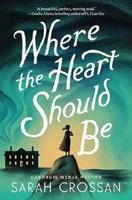
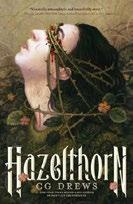

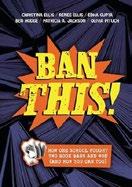
Then There Was One
Cross, Wendy | Puffin/Penguin Random House UK (304 pp.) | $17.99 paper May 20, 2025 | 9780241641576
A wild ride of a debut featuring mystery, murder, and mayhem that will keep readers riveted. (Science-fiction thriller. 12-18)
Crossan, Sarah | Greenwillow Books (400 pp.) | $19.99 | January 21, 2025 9780063384910
Hauntingly beautiful. (Verse historical fiction. 13-18)


Hazelthorn
Drews, CG | Feiwel & Friends (368 pp.)
$19.99 | October 28, 2025 | 9781250376299
A uniquely arranged bouquet of terrors, as disturbing as it is beautiful. (Horror. 13-18)
Ed. by Dyer, Madeline | Page Street (384 pp.) | $18.99 | October 7, 2025 9798890033024
Authentic and broadly diverse representation enhances this uniformly strong collection. (Horror anthology. 14-18)
Ban
Fought Two Book Bans and Won (and How You Can Too)
Ellis, Christina , et al. | Zest Books (168 pp.)
$38.65 PLB | September 16, 2025
A compelling take on tackling censorship that elevates the authentic voices of youths and their allies. (Nonfiction. 12-18)
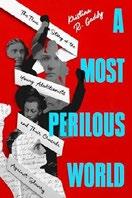

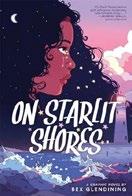
Huda F Wants To Know?
Fahmy, Huda | Dial Books (224 pp.)
$24.99 | $17.99 paper | April 1, 2025
9780593855614 | 9780593855621 paper
An uplifting, insightful model for positive change. (Graphic fiction. 12-18)
in the Jungle: Murder, Betrayal, and the Lost Dream of Jonestown
Fleming, Candace | Anne Schwartz/ Random (368 pp.) | $19.99
April 29, 2025 | 9780593480069
Extraordinary and illuminating. (Nonfiction. 12-18)
A Most Perilous World: The True Story of the Young Abolitionists and Their Crusade Against Slavery
Gaddy, Kristina R. | Dutton (320 pp.)
$19.99 | June 10, 2025 | 9780593855522
Engaging and original narrative nonfiction. (Nonfiction. 14-18)
Ghosh, Mina Ikemoto | Scholastic (544 pp.)
$27.99 | $18.99 paper | April 15, 2025 9781546152668 | 9781546152644 paper
A bold and immersive work combining prose and art to form a compelling adventure. (Fantasy mystery. 14-18)
Glendining, Bex | Abrams Fanfare (192 pp.) | $24.99 | September 30, 2025 9781419765049
Stunning from beginning to end. (Graphic fantasy. 14-18)


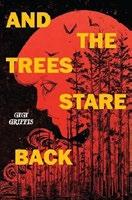


Goodwin, Idris | Atheneum (256 pp.)
$19.99 | October 14, 2025 | 9781665973120
Simultaneously lyrical and discordant; finds a universal sweet spot. (Verse fiction. 12-18)
Green, Simon James | Union Square & Co. (120 pp.) | $9.99 paper | April 1, 2025
9781454960317 | Series: Everyone Can Be a Reader
A delightfully authentic story about friendship, love, and taking chances. (Romance. 13-18)
Griffis, Gigi | Holiday House (368 pp.)
$19.99 | May 27, 2025 | 9780823459124
Speculative, unsettling, and intensely emotional. (Horror. 14-18)
Hamilton Murray, Lauryn | Roaring Brook Press (416 pp.) | $20.99 | June 3, 2025
9781250348159 | Series: Storm Weaver, 1
An impressive debut that highlights the importance of fully embracing one’s true self. (Fantasy. 14-18)
Howe, Jenny L. | Delacorte Romance (384 pp.) | $12.99 paper | July 22, 2025 9780593809105
A heartwarming, strongly characterized romance in which being truly seen for who you are is the greatest prize of all. (Romance. 13-18)

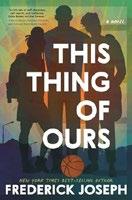

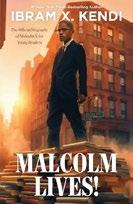
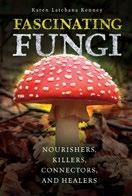
Isaacs, Cheryl | Heartdrum (336 pp.)
$19.99 | September 16, 2025
9780063287440
A deeply rewarding sequel that’s equal parts uncanny and moving. (Supernatural. 13-18)
Joseph, Frederick | Candlewick (384 pp.)
$18.99 | May 6, 2025 | 9781536233469
A thought-provoking exploration of storytelling dynamics in a social media–driven society. (Fiction. 14-18)
Kang, Lydia | Quill Tree Books/ HarperCollins (336 pp.) | $19.99 October 21, 2025 | 9780063354623
A nuanced, skillfully executed, and highly entertaining exploration of cultural belonging. (Fiction. 13-18)
Kendi, Ibram X. | Farrar, Straus and Giroux (400 pp.) | $19.99 May 13, 2025 | 9780374311865
A humanizing portrait showcasing history as a blueprint for radical change. (Nonfiction. 12-18)
Kenney, Karen Latchana | Twenty-First Century/Lerner (136 pp.) | $37.32 PLB October 7, 2025
An extraordinarily appealing book on a fascinating subject. (Nonfiction. 12-18)



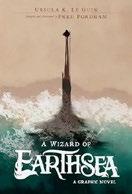

Kulper, Kendall | Holiday House (352 pp.) | $19.99 | November 4, 2025 9780823458295
Delightful timey-wimey adventure that would make smashing television. (Historical paranormal. 13-18)
Kumagai, Clara | Amulet/Abrams (400 pp.) | $19.99 | August 12, 2025 9781419768538
A thrilling and creative story of growth. (Supernatural. 13-18)
LaDelle, Ebony | Simon & Schuster (384 pp.)
$19.99 | May 20, 2025 | 9781665948678
In this sweet romance, a serendipitous moment paves the way for radical growth and transformation. (Romance. 14-18)
Le Guin, Ursula K. | Adapt. by Fred Fordham Illus. by Fred Fordham | Clarion/ HarperCollins (288 pp.) | $26.99 March 11, 2025 | 9780063285767
A beloved cornerstone of the genre brought vividly to life through striking illustrations. (Graphic fantasy. 12-16)
From the Guatemalan Genocide
Leon, Pablo | HarperAlley (240 pp.)
$18.99 paper | September 2, 2025
9780063223554
A beautiful reminder that hope is never out of reach. (Graphic fiction. 14-18)
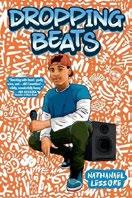


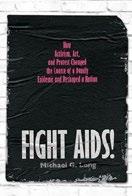

Lessore, Nathanael | Little, Brown (288 pp.) | $12.99 paper | February 11, 2025 9780316576987
A hilarious, witty story centered on embracing your quirks and the importance of friendship. (Fiction. 12-14)
Lockhart, E. | Delacorte (320 pp.) $22.99 | November 4, 2025 9780593899168 | Series: We Were Liars
Atmospheric and emotionally rich. (Fiction. 13-18)
Lockington, Mariama J. | Farrar, Straus and Giroux (352 pp.) | $19.99 October 14, 2025 | 9780374388904
An emotional, engaging story of love and growth. (Romance. 12-18)
Long, Michael G. | Norton Young Readers (288 pp.) | $19.99
June 3, 2025 | 9781324053538
Inspiring. (Nonfiction. 14-18)
Marchesini, Irene | Illus. by Carlotta Dicataldo | Trans. by Carla Roncalli Di Montorio | First Second (192 pp.)
$25.99 | April 1, 2025 | 9781250359087
Haunting yet filled with warmth, this luminous story of identity and belonging will fascinate readers. (Graphic fantasy. 12-18)

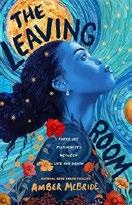
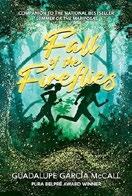
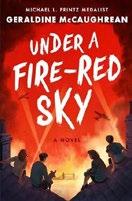

Mason-Black, Jennifer | Carolrhoda Lab (304 pp.) | $19.99 | May 6, 2025
9781728493299
Beautifully written and powerfully uplifting. (Fiction. 14-18)
McBride, Amber | Feiwel & Friends (224 pp.) | $19.99 | October 14, 2025
9781250908087
Compelling and evocative: a must-read. (Verse fiction. 14-18)
McCall, Guadalupe García | Tu Books (352 pp.) | $23.95 | October 21, 2025
9781643796994 | Series: Seasons of Sisterhood, 1
A rich, mythic story about selfhood and soul-deep family ties. (Fiction. 13-17)
McCaughrean, Geraldine | Flatiron Books (240 pp.) | $24.99 | November 4, 2025
9781250225542
Compelling, heartbreaking, and vibrantly alive with hope and courage. (Historical fiction. 13-18)
Meyer, Marissa | Feiwel & Friends (432 pp.) | $19.99 | November 4, 2025
9781250320957
Bloody brilliant! (Supernatural mystery. 14-18)
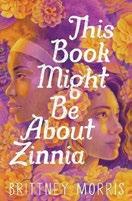

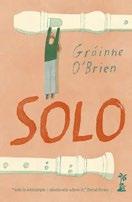
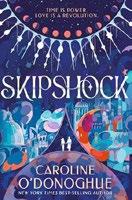
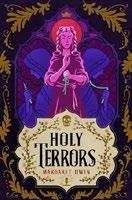
Morris, Brittney | Simon & Schuster (352 pp.) | $19.99 | July 1, 2025 9781665904018
A compelling, introspective journey into identity and the power of familial love. (Fiction. 12-18)
Nguyen, Trung Le | Random House Graphic (224 pp.) | $17.99 paper October 7, 2025 | 9781984892669
Tender, sweetly romantic, and enchanting; an encouraging coming-of-age story. (Graphic fiction. 12-18)
O’Brien, Gráinne | Little Island (280 pp.) | $12.99 paper | May 27, 2025 9781915071798
A tightly written, incredibly well-characterized work: bravo. (Verse fiction. 14-18)
O’Donoghue, Caroline | Walker US/ Candlewick (400 pp.) | $19.99 June 3, 2025 | 9781536228816
Series: Skipshock, 1
Incredibly immersive and utterly unique. (Fantasy. 14-18)
Owen, Margaret | Henry Holt (560 pp.) $21.99 | April 1, 2025 | 9781250831170
Series: Little Thieves, 3
Deeply affecting and satisfying. (Fantasy. 14-18)


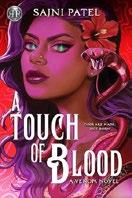
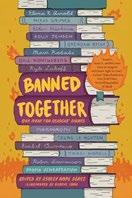

Park, Soyoung | Trans. by Joungmin Lee
Comfort | Delacorte (448 pp.) | $20.99
May 6, 2025 | 9780593809143
Series: The Snowglobe Duology, 2
Layered, distinctive, and memorable. (Dystopian. 12-adult)
Parker, Natalie C. | Candlewick (320 pp.)
$19.99 | January 7, 2025 | 9781536230093
A heart-pumping, high-stakes ride. (Adventure. 13-18)
Patel, Sajni | Rick Riordan Presents/Disney (416 pp.) | $18.99 | February 25, 2025
9781368098779
A riveting companion novel that will leave readers eager for more. (Fantasy. 14-18)
Ed. by Pérez, Ashley Hope | Illus. by Debbie Fong | Holiday House (304 pp.)
$19.99 | March 4, 2025 | 9780823458301
A n empowering and critically timely blueprint for action. (Anthology. 13-18)
Pettersen, Siri | Trans. by Tara Chace Arctis Books (415 pp.) | $20
February 25, 2025 | 9781646900169
Series: Vardari, 2
Vast in scope, intricately plotted, and utterly original. (Fantasy. 14-adult)

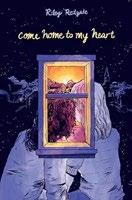
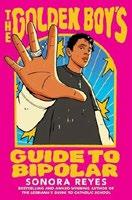

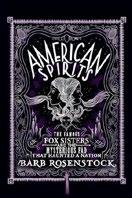
Proudman, Sandra | Wednesday Books (336 pp.) | $20 | May 20, 2025 9781250895080
A heartfelt, swashbuckling, standout novel. (Historical fantasy. 13-18)
Redgate, Riley | Union Square & Co. (336 pp.) | $19.99 | May 6, 2025 9781454957119
A palpably genuine and romantic queer coming-of-age story. (Fiction. 14-18)
Reyes, Sonora | Harper/HarperCollins (384 pp.) | $19.99 | September 16, 2025 9780063358409
Deeply cathartic. (Fiction. 14-18)
Rivera, Adrienne | Page Street (384 pp.) $18.99 | August 19, 2025 | 9798890032935
Hilarious and sweet: a monster of a good time. (Romance. 14-18)
American Spirits: The Famous Fox Sisters and the Mysterious Fad That Haunted a Nation
Rosenstock, Barb | Calkins Creek/Astra Books for Young Readers (304 pp.)
$24.99 | April 15, 2025 | 9781635928051
A suspenseful, well-researched read. (Nonfiction. 14-18)

Roux, Madeleine | Quill Tree Books/ HarperCollins (336 pp.) | $19.99
June 10, 2025 | 9780063284845
A grim triumph. (Fantasy. 14-adult)
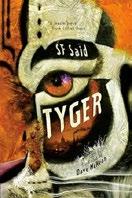
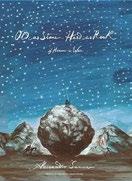
Said, SF | Illus. by Dave McKean | Penguin Workshop (304 pp.) | $18.99 | $9.99 paper | July 1, 2025 | 9780593887240 9780593887257 paper
A vividly novelized parable that explores all-too-timely social themes. (Fantasy. 12-14)
Sanna, Alessandro | Trans. by Ammiel Alcalay | Unruly (184 pp.) | $34.95
February 4, 2025 | 9781592704217
A haunting interpretation of one of humanity’s existential dilemmas. (Picture book. 12-adult)
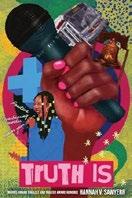
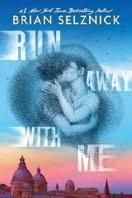
Sawyerr, Hannah V. | Amulet/Abrams (480 pp.) | $21.99 | September 23, 2025 9781419776830
An unforgettable, dynamic, and emotionally resonant novel in verse. (Verse fiction. 14-18)
Selznick, Brian | Scholastic (320 pp.) $24.99 | April 1, 2025 | 9781339035529
Intricate and wondrous. (Romance. 14-18)

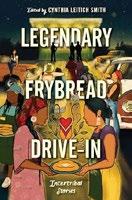
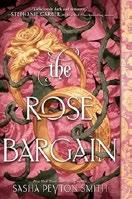

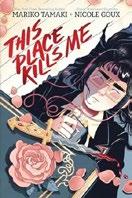
Simpson, T.L. | Flux (272 pp.) | $14.99 paper | April 22, 2025 | 9781635831054
A wise, emotionally rich tale of a young man finding his way through family trauma. (Fiction. 14-18)
Ed. by Smith, Cynthia Leitich Heartdrum | (352 pp.) | $19.99 August 26, 2025 | 9780063314269
Superlative. (Anthology. 13-18)
Smith, Sasha Peyton | Harper/ HarperCollins (400 pp.) | $19.99 February 4, 2025 | 9780063372528
Familial duty unfolds into an exploration of desires and selfsacrifice in this promising series opener. (Fantasy. 14-adult)
Soto, Julie | Wednesday Books (352 pp.) $20 | May 6, 2025 | 9781250377173
A haunting page-turner that smartly explores the complexities of teenage relationships and feelings of self-worth. (Thriller. 14-18)
Tamaki, Mariko | Illus. by Nicole Goux Abrams Fanfare (272 pp.) | $26.99 August 19, 2025 | 9781419768460
Truly exceptional; a standout. (Graphic mystery. 12-18)
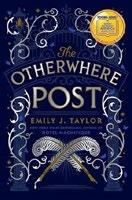
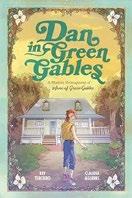

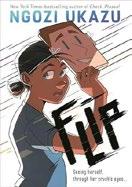
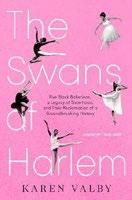
Taylor, Emily J. | Putnam (416 pp.)
$20.99 | February 25, 2025
9780593404546
A magically thrilling, gripping, and thoroughly enjoyable read. (Fantasy. 14-18)
Terciero, Rey | Illus. by Claudia Aguirre Penguin Workshop (256 pp.) | $24.99 June 3, 2025 | 9780593385579
An effervescent search for belonging and a heartfelt ode to a beloved classic. (Graphic fiction. 12-16)
Tobias, Trisha | Sweet July/Zando (320 pp.) | $19.99 | January 14, 2025 9781638931027
A deliciously dark and mysterious debut. (Horror. 13-18)
Ukazu, Ngozi | First Second (320 pp.)
$25.99 | $18.99 paper | September 23, 2025 9781250179517 | 9781250179524 paper
Flipping awesome. (Graphic fiction. 14-18)
Valby, Karen | Delacorte (288 pp.) | $19.99 January 14, 2025 | 9780593643563
A poignant and gripping piece of little-known history. (Nonfiction. 14-18)

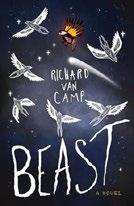

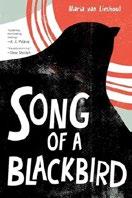

VanBrakle, Khadijah | Holiday House (272 pp.) | $19.99 | August 26, 2025
9780823454860
An engrossing, emotionally rich meditation on faith, family, and the courage it takes to create your own story. (Fiction. 14-18)
Van Camp, Richard | Douglas & McIntyre (320 pp.) | $14.95 paper | June 3, 2025 9781771624145
Delicately balances a gripping storyline with well-rendered cultural elements and accessible writing. (Supernatural thriller. 13-18)
Van Draanen, Wendelin | Holiday House (256 pp.) | $19.99 | September 2, 2025 9780823460380
A fun, twisty mystery with a likeable narrator. (Mystery. 12-18)
van Lieshout, Maria | First Second (256 pp.)
$25.99 | $17.99 paper | January 21, 2025 9781250869814 | 9781250869821 paper
Powerful, moving, and utterly unforgettable. (Graphic fiction. 12-adult)
Volbeda, Ludwig | Trans. by Lucy Scott Levine Querido (240 pp.) | $19.99 November 4, 2025 | 9781646145775
Breathtakingly raw and fresh, just like adolescence itself. (Fiction. 12-18)

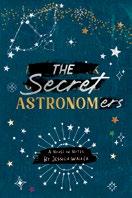

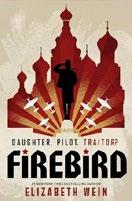
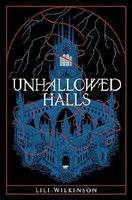
Walden, Tillie | Image Comics (256 pp.) | $14.99 paper | July 8, 2025
9781534397378 | Series: Clementine, 3
A bittersweet, hope-tinged conclusion to a stirring trilogy. (Graphic horror. 14-18)
Walker, Jessica | Viking (304 pp.) | $19.99 November 4, 2025 | 9780593692677
A wholly original novel that celebrates connection in unlikely places. (Fiction. 13-18)
Ward, Patricia | Harper/HarperCollins (368 pp.) | $19.99 | October 7, 2025 9780063235168
A deeply atmospheric portrait of generational trauma. (Supernatural mystery. 14-18)
Wein, Elizabeth | Union Square & Co. (144 pp.) | $9.99 paper | September 16, 2025 9781454962724 | Series: Everyone Can Be a Reader (War Birds Cycle)
An action-packed exploration of courage and loyalty. (Historical fiction. 13-18)
Wilkinson, Lili | Delacorte (464 pp.) | $19.99 February 18, 2025 | 9780593810989
Moody, gripping dark academia steeped in magic. (Fantasy. 14-18)
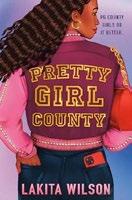
Wilson, Lakita | Viking (320 pp.) | $19.99
July 1, 2025 | 9780593525647
A tale of the power of inner worth told in a distinct and humorous voice. (Fiction. 14-18)


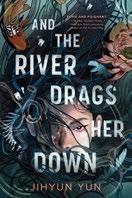
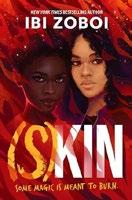
I Wish I Didn’t Have To Tell You This: A Graphic Memoir
Yelchin, Eugene | Candlewick (432 pp.) | $22.99 | September 16, 2025 9781536215533
An exceptional work: underpinned by strong but restrained feelings. (Graphic memoir. 14-18)
All the Tomorrows After Yi, Joanne | Atheneum (400 pp.) | $19.99 August 19, 2025 | 9781665972550
A powerful, deftly told story of loss and love that will linger in readers’ hearts. (Fiction. 14-18)
Yun, Jihyun | Knopf (400 pp.) | $20.99 October 7, 2025 | 9780593904879
A beautifully written, grief-filled tale that’s equal parts creepy and heart-wrenching. (Horror. 14-18)
Zoboi, Ibi | Versify/HarperCollins (400 pp.) | $19.99 | February 11, 2025 9780062888877
A vividly creative, heart-pounding poetic journey infused with Caribbean folklore. (Verse fantasy. 14-18)

LAURA SIMEON
EVEN AS THIS year brought unrelenting waves of deeply troubling news, there was a bright spot: Reading and spotlighting the many truly exceptional new books for teens offered me a sense of purpose. I clung to the knowledge that I was doing my bit—in however small a way—to connect young people with books that would bring them something valuable, be it longed-for solace, validating recognition, much-needed escape, or a few hours of simple pleasure. Among our Best Teen & YA Books of 2025, the following stand out as exceptionally worthy of notice.
Rebis: Born and Reborn by Irene Marchesini, illustrated by Carlotta Dicataldo, translated by Carla Roncalli Di Montorio (First Second, April 1): This luminous, fantastical
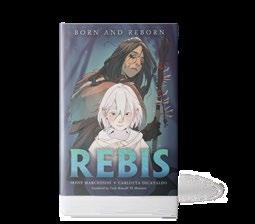
graphic novel from Italy explores intolerance and gender nonconformity and celebrates found family. A baby born with albinism in medieval Europe grows up in a fearful community under the shadow of a rumored curse. The child, who adopts the name Rebis, eventually finds a loving home—and full acceptance—with a group of banished women in the forest.
This Thing of Ours by Frederick Joseph (Candlewick, May 6): This fiction debut packs a gut punch, effectively weaving together themes of family legacy, social media toxicity, socioeconomic disparities, censorship, and the silencing of Black voices. Following a career-ending injury, multitalented Ossie pivots from basketball to a
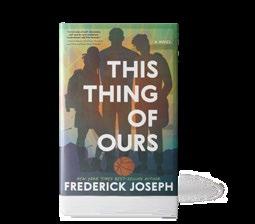

prestigious high school writing program. But Ossie’s complicated new friendships are threatened when his impulsive attempt to fight racism misfires tragically.
And the River Drags Her Down by Jihyun Yun (Knopf, October 7): This atmospheric debut—simultaneously dark, foreboding, and intensely beautiful—immerses readers in the intensity of grief and longing. Soojin Han loses first her mother and then her sister, Mirae. Disregarding warnings never to use the secret family magic to resurrect people, she brings Mirae back. But the initial giddiness of reconnection soon devolves into something horrifying.
Under a Fire-Red Sky by Geraldine McCaughrean (Flatiron Books, November 4): Against the catastrophic backdrop of the Blitz, world-renowned author McCaughrean’s latest is a jewel of a book that focuses on four Greater London teens whose lives become unexpectedly intertwined. With deft
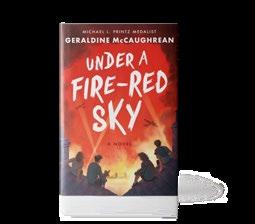

economy and sincerity that never tips into sentimentality, she brings to life the hopes, dreams, personal victories, and tragedies of an array of characters.
Self Portrait by Ludwig Volbeda, translated by Lucy Scott (Levine Querido, November 4): In this award-winning debut from the Netherlands, a teen, despite being an avid artist, grapples with a spring break homework assignment to draw a self-portrait. Jip’s transformative, affirming story unfurls through conversational letters to a crush, many adorned with Volbeda’s enchanting spot illustrations. Readers form a deep understanding of Jip’s exploration of gender identity and selfhood.
The Secret Astronomers by Jessica Walker (Viking, November 4): Artist Walker’s authorial debut is a true visual delight. Using the aliases “Copernicus” and “Kepler,” two teen girls in rural West Virginia—one a Bay Area transplant— correspond via sticky notes, collages, and drawings in a 19th-century astronomy textbook in the school library. Their anonymity fosters raw emotional vulnerability even as they investigate an intriguing mystery surrounding Copernicus’ late mother.

Laura Simeon is a young readers’ editor.
A Black teenager vacations in the Shenandoah Valley and uncovers a legacy of bigotry and racial violence. When she was a baby, Naomi Ward was kidnapped from a grocery store. Over a decade later, the woman who took and raised her was arrested and imprisoned. Now, 16-yearold Naomi has been reunited with her family, who know her as Camryn Stoakes. Her parents try to make the homecoming as smooth as possible, but Naomi grieves the loss of her old identity. Determined to unify the family, which includes siblings Maya and Blake, Dawn
and Andre Stoakes rent a cabin in Virginia for a few weeks. But soon after their arrival, Naomi feels deeply unsettled: A rotten stench that only she detects permeates the air, she’s visited by the ghost of a Black girl, and she learns that Sparksburg, Virginia, was a sundown town. When Naomi hears about two recent missing persons cases, she becomes convinced they’re related to the town’s evil history. But will anyone believe her? This well-paced debut’s immersive narrative and descriptive language support its strong characterization. Stratton effectively crafts complex
Alechia Dow
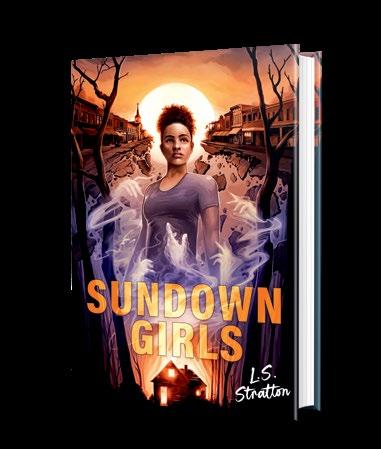
Stratton, L.S. | Nancy Paulsen Books | 320 pp. $19.99 | January 27, 2026 | 9798217004942
family dynamics, and Naomi’s struggle to reconcile the love she feels for her kidnapper with the heinous crime is compelling. The nail-biting final act, which leads to a shocking reveal,
will make readers feel as though they’re right beside Naomi, fighting for survival. A riveting, emotionally resonant thriller infused with supernatural intrigue. (author’s note) (Thriller. 13-18)
By Brigid Kemmerer
By L.S. Stratton







The author of Dropping Beats answers our questions.
NATHANAEL LESSORE’S bright, lively debut, Dropping Beats , is an obvious choice for our Best YA Books of 2025 list with its irresistible combination of witty wordplay, propulsive plot, and charming protagonist. Thirteen-year-old aspiring rapper Growls is navigating online humiliation, an unrequited crush, a missing best friend, and financial stress at home. Originally published in the U.K. in 2023 as Steady for This , the book won the Branford Boase Award and was shortlisted for the Yoto Carnegie Medal and the Jhalak Children’s & Young Adult Prize. Lessore answered questions by email.
me. I once got stuck in a pram in public and had to wriggle around in my underwear to get free. I had a cockroach fall out of my pocket on a visit to the doctor. My aunt used to call me “Head in the Clouds,” and that’s how Growls’ voice developed. I wasn’t depressed about being poor because everyone was poor and I didn’t know what I was missing. My book is a comedy because life is funny and absurd, but conflict and serious issues are also a reality.



What originally inspired Dropping Beats?
I was home alone during the pandemic. I’d watched everything on Netflix and got to the point where I was reenacting scenes from Tangled to entertain myself. I decided to write something, just to see if I could. I wanted to show my London neighborhood to be the vibrant, community-friendly place I grew up in. All the news articles were negative, and I wanted to show that there was so much more to my area than a crime-ridden stereotype.
We don’t have enough genuinely funny books for teens that also address challenging topics. I was always told to “write what you know.” What I know is that I was a goofy kid who grew up in a fun area that had a bad reputation. The majority of scenes are taken from experiences that happened to me or people around
I appreciate how the U.S. edition preserved the richness of the original slang. The thing I love about reading is that I get to experience life through someone else’s eyes. One minute I’m in Nigeria experiencing the Biafran War in Half of a Yellow Sun [by Chimamanda Ngozi Adichie] and the next I’m on a road trip through the gothic South thanks to Flannery O’Connor. The authenticity of characters and places is what transports me, and my editor’s keeping the British slang hopefully does the same.
Were you a keen reader as a teen?
I wasn’t a keen reader at all; it was considered geeky. That changed when Malorie Blackman wrote the Naughts and Crosses series—reading suddenly became cool. I studied creative writing at university, [but] one editor told us that if you’re not a posh white lady, you don’t have much of a chance, so I decided to go into marketing instead. When my book got published, my day job was writing articles about plug sockets.
What responses to the book mean the most to you?

Lessore, Nathanael
Little, Brown | 288 pp. | $12.99 paper February 11, 2025 | 9780316576987
Parents, librarians, and teachers tell me that teenagers who never read loved Dropping Beats . Many reluctant readers tell me that this was the first book they enjoyed. On school visits, the most disruptive teens are the first to barge to the front of the queue and get their books signed—this at a time when, more than ever, teenage boys need empathy, kindness, and open-mindedness from any source they can get it from. I think that in the past, intolerant voices were given a microphone, and right now they’re being given a megaphone. Young people especially are exposed to intolerant ways of thinking, and books are an antidote to that poison.
Interview by Laura Simeon
THE
Coyiuto, Mae | Feiwel & Friends (320 pp.)
$19.99 | February 17, 2026 | 9781250293091

A teen in the Philippines gets a second chance to say goodbye after being visited by her father’s ghost. Five years after her father’s death, Nika Ilagan, a Chinese Filipino 17-year-old, is still struggling with grief, and she’s unhappy with her mother’s decision to remarry. Nika is furious when her mother’s fiancé joins the family while they’re visiting her father’s grave. She storms off in anger and doesn’t pagpag— stop somewhere else on her way home. A Filipino belief says that a spirit can follow you home from a wake, funeral, or cemetery unless you make a detour. Nika dismisses the superstitions that her mom is obsessed with, so she’s shocked when her father’s ghost appears. Realizing that their time together may be limited, Nika wonders if there’s a way to keep Pa here, so she never has to say goodbye again, and she finds herself desperately holding on to what her family used to be. Nika’s palpable grief will particularly resonate with readers who have experienced loss; her personal growth is satisfying as she takes steps towards healing and embracing change. The strong, banter-filled voice and hearty dose of humor balance the emotional weight of the novel. Set in Manila, the novel primarily centers on Chinese Filipino characters, and Tagalog and Hokkien words sprinkled throughout add to the sense of place. A tender yet funny story about family, grief, and saying goodbye. (trigger warning, glossary) (Fiction. 13-18)
de la Cruz, Melissa | Putnam (304 pp.)
$20.99 | February 3, 2026 | 9798217002610

Three friends are devastated when they receive letters of rejection from Sibylline College of Magical Arts, the Ivy League equivalent “for the magically inclined”; little do they know that danger lurks behind its hallowed stone walls. Desperate to understand their own powerful forms of magic, Raven Chen, Atticus Garcia, and Dorian Winthrop leave New York City for Vermont, taking staff jobs at the college in hopes of slipping into lectures and accessing lesson plans. Ensconced in strategic positions around campus, they quickly discover that the school isn’t the idyllic institution of learning they’d imagined it to be. Its history is filled with dark secrets, and when someone turns up murdered, the administration seems to know more than they’re letting on. To expose the truth, the trio must push their magical abilities (and their tangled feelings for one another) further than ever before, even if it means shattering the glittering facade of the country’s most elite magical college. This duology opener, with its shadowy library, cobblestone streets, and bookshop cafe where the characters eat cinnamon rolls, captures cozy dark academia at its best. However, too much time is spent rehashing the trio’s romantic feelings for each other, diluting the central mystery. An unexpectedly explicit sex scene toward the end feels jarringly out of place relative to the rest of the book, making the intended audience unclear. Names and physical descriptions cue
ethnic diversity among the cast members. Dorian presents white. Richly atmospheric but unevenly executed. (Fantasy. 17-adult)
Desamours, Channelle | Wednesday Books (320 pp.) | $20 | February 17, 2026 9781250337702

Simone Washington is turning 18, and she wants to throw the spookiest party ever for her Pinegrove Academy friends. She’s planning to hold a sleepover at a cabin in the woods near Yearwood Lake. Popularly known as Doll’s Head Lake, the locale is reputed to be haunted by a ghost and is littered with the body parts of dolls that people leave as offerings. The setting is perfect for creepy campfire stories and scary pranks, but the party takes a terrible turn when Simone does something that costs her best friend, Kira, her life. Hoping to undo the damage, she makes a deal with Regret, a cursed witch who’s trapped at the lake: If Simone can free the witch in 14 days, she’ll save Kira and erase her own regrets too. Every morning a doll named Gabby Greta counts down the days, reminding Simone that the clock is ticking. This atmospheric story leads Simone on a quest that involves searching the town archives and conducting unsettling interviews with local elders. While unearthing the tragic past, she’s forced to confront her own history. Desamours’ sophomore novel, which centers on a Black cast, features an intriguing historical ghost story that mirrors contemporary events. She includes plenty of red herrings and misdirection, carefully doling the clues out in a way that maintains a strong, suspenseful forward momentum and respects readers’ deductive reasoning skills. Suspenseful and well-paced; a strong addition to the genre. (Horror. 13-18)
Dow, Alechia | Feiwel & Friends (320 pp.) $19.99 | February 3, 2026 | 9781250375773
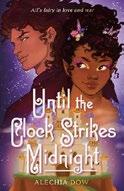
Two immortal beings compete to influence their human client’s fate and win an influential mentorship.
Darling Sparkleton is the first fairy to graduate from the Mortal Outcome Academy. Having overcome significant discrimination from celestials, Darling is excited to enact meaningful change and ready to bestow Happily Ever Afters on her mortal clients once she wins the Mortal Outcome Council mentorship. Fellow grad Calamity, a Misfortune who leads clients away from chaotic Unhappily Ever Afters toward stable Ordinary Ever Afters, is desperate to escape his hostile, neglectful father. When a clandestine mission earns him a chance at the mentorship, Calamity sees a way out. Darling and Calamity have seven midnights to influence their client, Lucy Addlesberg, the owner of a struggling bookshop. In a magical altercation, they immediately reveal their true selves to Lucy. Now they must pretend to be a couple and influence her choice through friendship rather than magic, all while their annoying—and annoyingly attractive—rival constantly derails their plans. Written in engaging prose, this enchanting cozy fantasy with adult crossover appeal has it all—creative worldbuilding, well-developed characters, and a sweet, swoonworthy romance. It balances whimsy with thoughtful, authentic bipolar disorder representation. The story, which captures the essence of Brandy’s Cinderella, features refreshingly realistic relationship development—no glass slippers here!— while honoring fairy tales’ worldchanging magic and emphasizing a message of kindness and care. Darling
and Lucy read Black, and Calamity is implied Black and Asian. Many characters are in queer relationships. Unmissable. (content warnings) (Fantasy. 13-adult)
Ferko, Christina | Sourcebooks Fire (416 pp.) | $12.99 paper | February 3, 2026 9781464236310
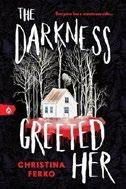
A teenager heads to a summer camp for a “therapy program and wellness retreat” that turns into a waking nightmare filled with her fears and buried memories. In the wake of her abusive father’s death, Penny Davidson’s mental health has plummeted. She struggles with Harm OCD, and her head is a minefield of intrusive thoughts that greatly affect her everyday life. At Camp Whitewood, Penny joins a small group of girls, all of whom are seeking intensive therapy. The campers soon realize that the isolation of the Appalachian Mountains setting puts them uncomfortably close to a shadowy figure that emerges in the night, but hallucinations make them question what’s real. Ultimately, they’ll have to face their demons if they hope to save themselves. The gory horror is complete with gruesome deaths described in detail, and readers will truly feel the plaguing persistence of Penny’s innermost thoughts as she wrestles with her OCD, trauma, and tenuous grip on reality. Unfortunately, aside from flashbacks to the campers’ traumatic pasts, there isn’t enough meaningful character development to fully differentiate them. This debut is overwhelmingly dark and heavy, although small moments of lightness emerge from an appealing queer romance as Penny’s budding relationship with fellow camper Harper unfolds. Penny and Harper read white, and there’s racial diversity among the supporting cast.
A metaphor for coping with mental health issues and trauma, this book reads like a hair-raising horror film. (content notes) (Horror. 14-18)
Garrett, RaeChell | Little, Brown (352 pp.) | $19.99 | February 24, 2026
9780316372442

Ahead of a date with her crush, a high school junior fake dates her childhood friend in hopes of identifying what “makes guys go from [her] to relationship goals.”
Dru Eason is dealing with a lot. Her soccer team made it to the playoffs, but there’s infighting. Her sister Moriah is close to having a wedding meltdown, and both her sisters act like Dru, the baby of the family, can’t do anything right. Excitingly, her crush, Kai Waller, actually likes her back—but she’s launched every boyfriend she’s ever had into a perfect relationship with another girl. So, when Kai asks her out, she panics and pretends her team has a no-dating pact through playoffs to buy herself some time to figure out how she’s ruining her relationships. She asks childhood friend Winston— whose brother is marrying Moriah—to be her fake boyfriend and help her identify where she’s going wrong. But Winston is way better at this boyfriend thing than Dru expected—and things quickly get complicated. This sweet romance centering on a majority Black cast will make any romance reader giddy. The writing is stellar—Garrett skillfully crafts realistic characters readers will want to root for—but the story shines most in its introspective moments, particularly explorations of Dru’s romantic and familial relationships. Unfortunately, the reflection that drives change comes too late, making the story drag in the middle and Dru’s growth feel slightly truncated. A surefire goal for romance readers. (Romance. 12-18)

Garrity, Shaenon K. | Illus. by Emily Holden Colors by Monica Nguyen-Vo McElderry (208 pp.) | $24.99
February 3, 2026 | 9781534495869

A superintelligent humanoid escapes from the university lab where she was made—and gets a job in a coffee shop. At Inkcap, Ruby sees all her tasks as systems to understand. Most of them, such as sweeping up spilled coffee beans, are simple systems with easily measurable success conditions. Humans, however, are systems that defy reason, so Ruby repeatedly revises her approach to finding their success conditions—in other words, what makes them happy. After observing a meet-cute between customers, Ruby begins to carefully orchestrate romances. Her targets include Mira, her coworker and best friend, and the hot “Comic Book Girl” who frequents Inkcap. While the scientists who created Ruby attempt to track her down, her own romance with the stranger “Decaf Americano” might prove to be her downfall. The supporting characters, while lightly developed, are delightful; a romantic subplot about two eccentric Inkcap patrons offers welcome pauses from the central narrative. But the queer romance at the book’s conclusion feels tacked on and leaves a loose end. Irreverent humor abounds, whether in the 20-foot-long tardigrade designed to control the population of squirrels on campus or in the recurring references to Mira’s constantly shifting college major. The full-color illustrations are pastelforward, matching this graphic novel’s sprightly romantic tone. Ruby has light
skin and pinkish hair, Mira has peachtoned skin and brown hair, and there’s some diversity in the secondary cast. A cheerful tone and clever premise let down by uneven execution. (Graphic science fiction. 14-18)
Glock, Sophia | Little, Brown Ink (288 pp.)
$18.99 paper | February 24, 2026 9780316459037

A girl faces grief and finds romance in her dreams.
Four years ago, Alicia Campos’ father passed away. Her best friend, Marisa Garza, was there for her, and Alicia believes Marisa is the only one who really understands her. The light-skinned teens, who are implied Latine, are different in many ways. Marisa is always thinking about boys and sex, while Alicia is preoccupied by a recurring dream—in it, there’s a house in the distance that draws her, but she can’t get any closer to it. She reads a book on lucid dreaming and slowly learns to control her dreams. Over the summer, while Marisa is away working as a camp counselor, Alicia bonds with Quintin, Marisa’s brown-skinned basketball player boyfriend, who works at a video rental store. When Alicia and Quintin develop a romantic connection in their dreams (which are portrayed in full color), the waking world (which is depicted in a muted gray and pale yellow palette) becomes more complicated. This graphic novel gently explores grief after losing a loved one.
Glock thoughtfully and realistically portrays Alicia’s unresolved feelings of shame and guilt and delicately handles her changing relationships. While there’s a strong focus on internal character development, the art is less visually engaging; many of the facial expressions are similar and repetitive, but sincere emotions still come through and drive the story. The ending feels somewhat too easy but is still satisfying. An affecting tale of love, loss, and dreams. (Graphic fiction. 13-18)
Graham, Jennifer | Wednesday Books (336 pp.) | $14 paper | February 24, 2026 9781250323835

In this thriller, a flyer on the cheer team at her small-town Texas high school is dragged back into the awful events that claimed her best friend and her boyfriend. Senior Iris Henley was horrified when her boyfriend, Rocky Koenig, and her former best friend, Lynette Zeiger, were found dead in a presumed murder-suicide the previous school year. She and Lynette, whose drug use was spiraling out of control, had already fallen out, but Iris had no idea Rocky was cheating on her with Lynette. But when anonymous social media posts claim that Iris herself is responsible for their deaths, her life becomes a nightmare of accusations and betrayal. Employing first-person, present-tense narration that feels immediate and anxious, this mystery builds steadily over the course of 25 days during which Iris feels increasingly desperate and unsure whom she can trust. Her troubled relationships with her friends and family are multidimensional and render her a sympathetic and likable narrator, who worries about her own reliability as she was drunk and high the night of the deaths. In particular, a subplot involving Iris’ growing understanding
of her younger sister, Noelle, lends emotional depth to this whodunit. The central cast is white, and surnames suggest that some members of the supporting cast are Latine, including Iris’ best friend.
A taut yet winding mystery that will keep readers guessing. (Thriller. 14-18)
Hakim, Joy | MITeen Press/Candlewick (196 pp.) | $24.99 | February 3, 2026 9781536222951 | Series: Discovering Life’s Story, 3

An overview of scientific research into genetics. Hakim dives into the stories of scientists who explored the structure and function of cells and teased apart the mysteries of “the code that carries the instructions that make us who we are.”
Thirteen chronological chapters interweave breakthroughs in cell research with major social, political and technological factors that facilitated advancements, such as better microscopes, advances in photography, and a new culture of collaboration. The book also covers setbacks and dead ends, which helps readers better understand how scientific progress is made (“Science is full of wrong conclusions.…Even brilliant thinkers can make mistakes”). Hakim emphasizes the cooperative nature of research and discovery and highlights contributors whose work went unacknowledged due to racism and sexism, including Ernest Everett Just and Rosalind Franklin; she profiles some of these figures in eye-catching text boxes with colorful backgrounds. The presenttense narration immerses readers in the drama of discovery, such as when early-1900s Columbia University researchers studied Drosophila melanogaster in the Fly Room (“That’s the kind of mutation Morgan has been waiting for!”). The frequent illustrations, bold design, chapter heading
quotations, and approachable writing style provide teen appeal. Though the scientific content grows increasingly complex as the book covers subjects such as transfer RNA and messenger RNA, Hakim presents the big-picture ideas clearly and closes by setting the stage for the next series entry. Rivetingly told, with an eye to inclusive coverage and collaborative efforts. (further reading, source notes, bibliography, image credits, index) (Nonfiction. 13-18)
Harris, Carrie | Running Press Kids (288 pp.)
$12.99 paper | February 10, 2026
9798894141640
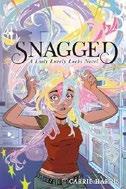
A cosplayer’s wig transports her to a fantasy world in this re-envisioning of an ’80s franchise. When 16-yearold Leigh Carroll encounters a mysterious vendor during a comic con, she acquires the final piece she needs for her project: a multicolored pastel wig that’s perfect for her updated version of Lady Lovely Locks. The princess comes from a storybook that once belonged to Leigh’s mother, who vanished when Leigh was a baby. But when Leigh goes home and puts on the wig and costume, she finds herself in the book’s hair-themed fantasy world. There, she’s the new Lady Lovely Locks, with magical helper Pixietails who enable her to travel home. During an encounter with villain Ravenwaves in her tower, Leigh finds a painting of her own mother. She must balance learning about the fantasy world and her mother’s secrets with her real-world obligations and crumbling relationships, especially with her father and her best friend, Ari. The fast-moving, easy-to-read story combines very light romance with more adult financial concerns, and the mixture is sometimes heavy-handed in execution. Leigh’s geek cred rings true
and her glib, quippy humor is genresavvy. Occasionally the story grazes interesting themes, such as referencing fairy tales’ black-and-white morality, but there’s little in-depth exploration of these topics, and the conclusion offers few payoffs, leaving readers to wait for a sequel for answers. Racially ambiguous Leigh, who’s “tanned,” has a “pastywhite” father, and Ari is Black. Lightweight cotton candy. (Fantasy. 12-16)
Jean, Emiko | Sarah Barley Books/Simon & Schuster (352 pp.) | $19.99 February 3, 2026 | 9781665974370

A Seattle teen who’s skeptical about romance receives letters from the future that try to change her mind.
After witnessing her parents’ marriage fall apart six years ago, 17-year-old Emma Nakamura-Thatcher, who’s white and Japanese American, has vowed to avoid heartbreak. She doesn’t take risks in love or in life, but at the Tanabata festival at the Japanese garden over the summer, she wishes that everlasting love were real. As her senior year begins, Emma starts receiving mysterious letters written by someone who says they’re from the future: “I’ve come back for you, Emma. And if you let me, I’m going to change your life.” This person promises to fulfill her wish, thus ensuring her happy future. As different boys enter her life, Emma tries to determine which one could be the letter writer, her guarantee of “love with none of the risk, none of the pain.” There’s cute, nerdy childhood best friend Theo Beckett, who’s always there for her; hot cello genius Ezra French, who’s her after-school music intensive mentor; and handsome rich kid Colin St. James, whose house she cleans. The boys and the letter writer push Emma out of her comfort zone, allowing her to fully experience life, love, and even heartbreak. This charming, funny, time-traveling romance

1 On Starlit Shores
By Bex Glendining
Stunning from beginning to end.
2 A Wizard of Earthsea
By Ursula K. Le Guin; adapt. by Fred Fordham; illus. by Fred Fordham
A beloved cornerstone of the genre brought vividly to life through striking illustrations.
3 Angelica and the Bear Prince
By Trung Le Nguyen
Tender, sweetly romantic, and enchanting; an encouraging coming-of-age story.
4 Old as Stone, Hard as Rock
By Alessandro Sanna; trans. by Ammiel Alcalay
A haunting, poetic visual interpretation of one of humanity’s existential dilemmas.

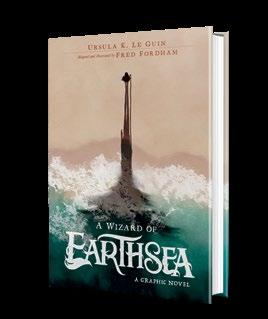
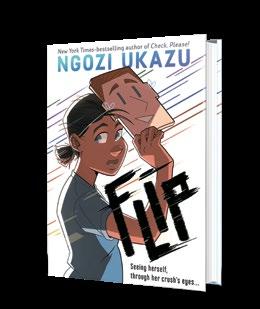
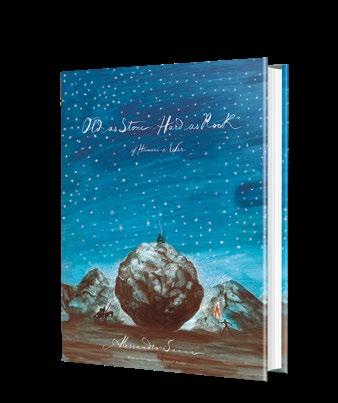
By Eugene Yelchin


The author of Huda F Wants To Know ? answers our questions.
HUDA FAHMY HAS garnered an avid following for her webcomic, “Yes, I’m Hot in This,” and her loosely autobiographical YA graphic novels, including National Book Award finalist Huda F Cares?. Her latest, Huda F Wants To Know?, one of our Best YA Books of 2025, showcases her signature blend of pointed observations, hilarious commentary, and expressive art. In this nuanced and relatable story, Huda, an academically driven high schooler whose parents are divorcing, struggles with her mental health, but the halaqa at the masjid provides much-needed support. Fahmy answered our questions via email.
prioritize my mental health, and it makes me wish I had access to these kinds of resources when I was younger. It’s like time travel—I get to go back and tell teenage Huda she’s not broken.
What was most challenging about writing this book?

What media were you consuming while working on this book?
I wish I could say I watched some nice comfort shows, but I began writing this book at the end of 2023, and I was glued to the news. My heart has been with the people of Palestine the entire time. Between writing, sketching, inking, and coloring, I watched the news, fundraised for displaced families, prayed for the genocide to end. This was one of the hardest books to write because the state of our world made it difficult to find joy in other pursuits.
What sparked your decision to focus on mental health?
I initially wanted to explore divorce from a Muslim point of view because it’s so rarely talked about. But, as I was writing, I realized the way my character processed her parents’ divorce mirrored the stages of grief. Today, as a (sort-of) functioning adult with a fully developed frontal cortex, I try to
Walking the line between telling Huda’s story and telling her parents’ story. I never get into the details of why Huda’s parents are divorcing. That was intentional: People tend to draw parallels between these books and my real life. People just be nosy. And I didn’t think it mattered why. Regardless of the reason, Huda’s grief wouldn’t be any less real.
And most rewarding?
Getting to write stories about Muslim kids struggling with their mental health while also normalizing therapy is incredibly fulfilling.
Tell me about your use of humor. I love talking about humor! It gives me a chance to look at why I gravitate towards laughter as a way to process serious topics. Why does humor work so well to disarm people’s defenses? I believe our shared trauma leads to shared laughter, which is why I try to write about experiences that both unite and frustrate us. My goal is always twofold: to make people laugh and to make people think.
What book or books published in 2025 were among your favorites?
In no particular order: Perfect Victims: And the Politics of Appeal by Mohammed El-Kurd, the Amina Banana series by Shifa Saltagi Safadi, My Mother, the Mermaid Chaser by


Huda F Wants To Know? Fahmy, Huda Dial Books | 224 pp. | $24.99 April 1, 2025 | 9780593855614
Jamie Jo Hoang, The Story of My Anger by Jasminne Mendez, One Day, Everyone Will Have Always Been Against This by Omar El Akkad, Great Big Beautiful Life by Emily Henry, and Detective Aunty by Uzma Jalaluddin.
Was there anything else you’d like to tell readers?
The world is changing, and we must act on courage: Share stories that pull back the curtain, that challenge us, that bring us face to face with uncomfortable truths. It’s only scary at first, I promise. Courage wouldn’t be courage if you weren’t doing something that scared you. But we must persist. Be the change. Write the change. Publish the change.
Interview by Laura Simeon
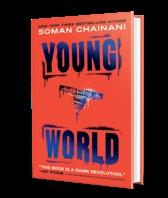
by Soman Chainani
Random House will publish Young World in the spring.
Soman Chainani will publish a new young adult novel in 2026.
Random House Books for Young Readers will publish Young World next spring, the press announced in a news release. It calls the book “a renegade thriller about a teenager elected President of the United
States, sparking a global revolution of young leaders—until one of them is murdered and he’s the prime suspect.”
Chainani made his literary debut in 2013 with The School for Good and Evil, illustrated by Iacopo Bruno, a fantasy novel about two girls who attend the titular magical academy. The book spawned several sequels and two prequels. It was adapted into a 2022 film.
Young World is about high school senior Benton Young, who runs for U.S. president to impress a girl and finds himself elected by a write-in vote. Several other young people follow his example, becoming national leaders, and one of them is murdered during a summit in Sweden.
“Young World is my call to revolution,” Chainani said in a statement. “For myself: tearing away from escapist fairy tales to invent a new kind of novel, in neon-bright color, equal parts words and visuals. And for the world: a siren call to protect the fast-disappearing right to be young.”

Young World is scheduled for publication on May 5, 2026.
—M.S.







BY LANCE LEE


“…gorgeously unusual…”
—Kirkus Reviews


The series will be based on E. Lockhart’s 2017 young adult novel.
The actor is known for her role as Taylor Jewel in The Summer I Turned Pretty, the popular Amazon Prime series adapted from Jenny Han’s trilogy of novels. The series recently aired its final season, and a follow-up film is currently in the works at Amazon Prime.
The Genuine Fraud series will be written by Sinead Daly, a co-executive producer of The Summer I Turned Pretty and Tell Me Lies , the series based on Carola Lovering’s 2018 novel of the same name.








Rain Spencer will star in a series adaptation of E. Lockhart’s Genuine Fraud, Deadline reports.







Lockhart’s hugely successful YA novel We Were Liars , published in 2014, was recently adapted into an Amazon Prime series starring Emily Alyn Lind, Caitlin FitzGerald, and Mamie Gummer. It premiered in June and has been renewed for a second season.
—M.S.
“…charmingly illustrated…inspiring…”
—Booklife Reviews (Publishers Weekly)
—LoveReading4Kids UK



“…lyrical….a story to be shared across generations.”
—Readers’ Favorite, 5 stars
Paperback: 979-8-21830-614-4
Hardback: 979-8-21830-612-0



“…a quick, light-hearted read…[a] magical tale.”
Lockhart’s young adult novel, published in 2017 by Delacorte, follows Jule West Williams, an 18-yearold woman posing as her best friend, missing heiress Imogen Sokoloff, at a resort in Mexico. In a starred review, a critic for Kirkus wrote that the book “will challenge preconcep tions about identity and keep readers guessing.”
Spencer, who will also executive produce, will play Jule in the series, which is being developed by Amazon MGM Studios.







weaves in themes of personal growth and shifting family relationships, rounding out Emma’s development. Many readers will relate to her frequent struggles with learning to live in the present. An endearing, lightly magical romantic comedy. (Romance. 12-18)
Keenan-Bolger, Andrew | Penguin Workshop (352 pp.) | $19.99 February 24, 2026 | 9780593889244
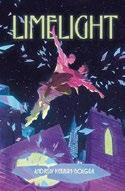
In 1996, a Staten Island teen gets into an elite performing arts high school and tries to find his place in the world. Danny Victorio has had a hard year. He and his mom left his abusive father and their materially comfortable old life in exchange for a cramped, dingy apartment belonging to Danny’s deceased uncle. With only the cassette tapes of Broadway cast recordings Uncle Richie left behind as inspiration, Danny auditions for LaGuardia High School of the Performing Arts. When he’s unexpectedly accepted, he’s thrilled to leave behind his Catholic school, which students call “St. Pete’s Cellblock for Horny and/or Satanic Boys.” At LaGuardia, he quickly befriends a quirky group of young fellow artists, including Christian, a Filipino American drag queen and ballet dancer, who gives white-presenting Danny butterflies. But to discover where he truly belongs, Danny will not only have to step outside his comfort zone, he’ll have to let his friends see the real him. Broadway actor Keenan-Bolger evokes musical theater classics like Billy Elliot and Fame along with even older performing arts school novels like Rumer Godden’s Thursday’s Children and Noel Streatfeild’s Shoe Books series. The rich setting and beautifully developed main characters balance the more two-dimensional side characters and quickly wrapped up ending. Still, musical theater fans will devour this story of finding your “corner of the sky.”
A vivid queer Broadway celebration with a classic feeling. (author’s note) (Historical fiction. 14-18)
Kirkus Star
Kemmerer, Brigid | Bloomsbury (448 pp.)
$22.99 | January 27, 2026 | 9781547613458
Series: Forging Silver Into Stars, 3
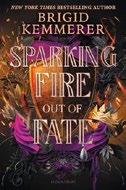
Amid rumors of impending war between Emberfall and Syhl Shallow, a radical faction of the Truthbringers forges a shocking alliance in this high-stakes series finale.
Following a deadly attack targeting human magic-users, or magesmiths, King Grey returned to Emberfall in hopes that leaving Syhl Shallow would protect his wife, young daughter, and subjects from harm. But physical separation creates new dangers for the sovereigns and their allies. The Truthbringers, who fear and hate magic, and a militant band of scravers, who are determined to reclaim and protect it, have found a common purpose—to destroy all magesmiths. Magic successfully functions as both a literal and figurative representation of power, physical ability, and otherness, drawing profound parallels to nationalist rhetoric that scapegoats vulnerable groups, as well as to themes of bodily autonomy and consent. Meanwhile, the four white-presenting primary narrators—Tycho and Jax (who has a prosthetic foot) in Emberfall and Callyn and Alek in Syhl Shallow—embark on reconnaissance missions for the king and queen. Each couple must also confront the individual histories, perspectives, and traumas that influence their relationships and choose whether to repeat or release old patterns. Kemmerer expertly weaves each narrator’s voice and vulnerable emotional progress into organic dialogue that promotes compassion, understanding, trust, and unity across differences, all while inexorably pulling her protagonists and plot threads toward a final standoff. Themes of sacrifice and courage in the face of terrible
odds underpin a well-earned and gratifyingly thorough conclusion. Electrifying. (map, character list) (Fantasy. 14-18)
Kon, Adeline | Dial Books (320 pp.) | $25.99 $17.99 paper | February 24, 2026 9780593696958 | 9780593696965 paper

A teen figure skating champion winds up training for the Olympics alongside her biggest rival. Lydia Chen, an 18-year-old Chinese American skating phenomenon, is unmatched in technical precision but lacking in artistry. Elaine Yee, 20, a Malaysian skater and Lydia’s biggest competition, has mesmerizing performance skills but struggles with clean technique. Their rivalry began three years ago during a fateful encounter at the Grand Prix, and since then it’s only intensified under the spotlight of media and skating world scrutiny. When Elaine joins Lydia’s training camp in Boston 267 days before their projected Olympic debuts, tensions run high. Each skater is thrown off by the other’s presence, and their personalities clash mightily: Lydia is cold and guarded, whereas Elaine is well-liked and cheerful. But beneath their friction lies an unspoken understanding of the sheer drive and sacrifice it takes to be the best. Gradually, a bond develops that neither girl expects, but every slow-burn step toward romance leads to the unavoidable question: How do you fall for someone who might someday take everything from you? The illustrations in Kon’s debut are the standout: The skating sequences are full of reverence for both the beauty and athleticism of the sport. Each black-and-white panel bursts with movement, expression, and atmosphere as the story tenderly explores themes of queerness, ambition, and mutual pining. An emotional graphic novel about two girls reaching for gold—and each other. (author’s note, sketches) (Graphic fiction. 14-18)
Lord, Petra | Henry Holt (432 pp.) | $22.99 February 3, 2026 | 9781250362971
Series: Queen of Faces, 1
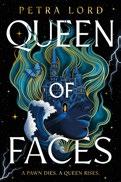
Two outcast teens join forces to fight an infamous witch who’s at the head of a violent rebellion.
Anabelle Gage has one year left to live unless she transfers her Pith to a new body. Working as a maid, she can’t afford the cost of replacing her decaying Edgar chassis; all her hopes ride on attending Paragon Runic Academy, Caimor’s ultra-exclusive magic school. But when her rejection letter arrives, desperation drives Ana into a reckless heist that goes horribly wrong and a criminal partnership with someone she never expected would help her: Nicholas Carriwitch, Paragon’s headmaster. Carriwitch sees Ana’s potential and wants her help hunting down Khaiovhe, the dark witch in charge of the international terrorist organization Commonplace. However, Ana won’t be working alone. Weston Brown, an Ousted noble and former Paragon student, lost everything when his mother exiled him—working for Carriwitch and killing Khaiovhe is Wes’ only chance to return to his old life. Although this debut shows glimmers of potential, with its characters’ urgent goals and its overarching sense of danger, the story suffers from messy worldbuilding and uneven pacing. Ana, who presents as the fantasy equivalent of white and East Asian, with her Caimorian father and Shenti mother, describes her Edgar chassis as ethnically vague. Wes is cued white. The exploration of gender identity in this world conflates sex and gender, presenting a stuck-in-the-wrongbody narrative.
A poorly developed twist on magic school fantasy stories. (content warnings, the four schools of magic, author’s note) (Fantasy. 14-18)
at the
Metcalf, Lindsay H. | Charlesbridge Teen (304 pp.) | $18.99 | February 10, 2026 9781623546335

A fictionalized account of the life of Eunice Newton Foote (1819–1888), a pioneering but long overlooked climate scientist, inventor, and women’s rights advocate. Metcalf traces her subject’s early years in a family that nurtured her curiosity, eventually sending her to New York’s only science-focused girls’ seminary, where her roommate was Elizabeth Cady Stanton’s sister. She married Elisha Foote, a lawyer and inventor, who supported her experiments and her fight for gender equality. In 1856, the American Association for the Advancement of Science accepted Foote’s groundbreaking study on greenhouse gases—but demanded a man present it at their convention. Elisha was voted a member of the AAAS; Foote was not. In 1860, English scientist John Tyndall was credited with “discovering” greenhouse gases. Still, Foote carried on, patenting her inventions. A speculative section in which Foote and her daughter Mary travel to Europe and confront Tyndall feels inessential to the narrative. The final chapter describes how, in 2010, retired geologist Raymond Sorenson stumbled upon Foote’s original 1856 report and wrote an article that set the record straight. Although at times her reliance on figurative language feels excessive, Metcalf’s research shines through in the vivid details and contextual information about racial and gender bias surrounding Foote, who was white. This novel in verse effectively illuminates the life of a woman who pursued science despite systemic barriers.
A valuable corrective to erasure in climate science history. (note on quotations, author’s note, family tree, source notes, bibliography, image credits) (Verse historical fiction. 13-18)
Quinn, Katherine | Delacorte (464 pp.) $21.99 | February 3, 2026 | 9798217117215
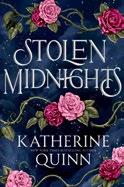
Teens from different social spheres collaborate, investigating magical mysteries while navigating their shared attraction. When 18-yearold Wren Hayes doesn’t receive a magical gift from the three Fates—Dawn, Day, and Dusk—she’s shunned by Aurilian high society. Unbeknownst to Wren, 19-year-old Damien, a thief from the Void (a part of the city she’s forbidden to visit) has taken the locket that should have been her gift from the Fates. He’s shocked to discover a photo of himself inside. Using his own Fates’ gift—a mirror with powers of invisibility—Damien infiltrates a party and steals a silver watch from a guest. But his gift isn’t fully functioning, and Wren tackles him, sending them both tumbling into the mud. They tussle and exchange flirty barbs before Damien makes off with his prize, losing Wren’s locket in the process. Unsure why someone from the Void would possess such a gift and determined to uncover why hers was “unjustly kept” from her, Wren tracks down Damien. Seeking answers of his own, he agrees to work with her. Their well-crafted dance of desire and restraint is on point (“She stifled a stunned noise as I placed a menacing kiss—a mere graze of my lips—on the back of her hand”), melding seamlessly with the plot. The story addresses sexism, privilege, and wealth while hurtling the characters into a whirlwind of action and disturbing revelations. Wren presents white, and Damien has tanned skin.
A sexy, swoony, action-packed duology opener. (map) (Romance. 14-18)
Reynolds, Hannah | Putnam (352 pp.)
$12.99 paper | February 3, 2026
9780593859032
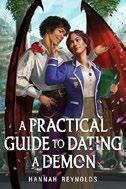
A fake demon fiancé becomes inconveniently real when a scholarship student’s romantic dodge backfires spectacularly.
Eighteen-yearold Naomi bat Yardena, who presents white and Jewish, wants nothing more than to study cryptography at the prestigious Lyceum. But persistent suitors seeking access through her to her influential aunt inspire Naomi to tell an elaborate lie about being engaged to a demon. The ruse backfires when bronze-skinned Daziel, an actual demon, materializes in her dorm, insisting that their betrothal is real. As Naomi grapples with her spellresistant supernatural lodger—who brings her croissants and uses his powers to improve her living space— the natural magic around the nation of Ena-Cinnai becomes dangerously unpredictable. Daziel’s domestic charm masks a hidden agenda, which might have something to do with the destabilizing disasters and the ancient scrolls Naomi is deciphering. The magic system is intertwined with letterform spellcasting and primordial beasts that govern natural forces. Naomi emerges as a pragmatic, driven hero, while Daziel’s initial deception gives way to genuine vulnerability. Their romance showcases genuine affection built on shared experiences, support, and easy banter. The secondary cast members, including Naomi’s cryptography cohort and dorm-mates, serve their narrative functions well, although some figures lack the depth their important roles warrant. Although the pacing
occasionally stumbles under multiple subplots, the central mystery provides satisfying stakes beyond the romance. Jewish cultural and religious elements throughout the worldbuilding enrich the book.
A cozy fantasy that intertwines academic intrigue, magical peril, and slow-burn supernatural romance. (Fantasy. 14-18)
Sanderson, Jennifer | Cheriton Children’s Books (48 pp.) | $11.99 paper
January 1, 2026 | 9781917509411
Series: Teen Online Survival Guides

A concise survival guide that helps teens spot deepfakes for themselves. As part of a series on internet safety, this informative guide outlines how deepfake images and videos affect people’s safety and privacy. Sanderson clearly and concisely presents information from an objective, fact-based perspective. Each chapter begins with a brief introduction in bold type that outlines the topic and explains its relevance. Each chapter closes with a summary of the main points framed in colorful text boxes. Information about face-swapping technology, AI-generated videos, and the malicious use of images (e.g., for scams, bullying, or spreading disinformation) highlights dangers readers should be aware of. The book offers preventative tips for self-protection, including selecting strong passwords and being careful about sharing personal information online. Realworld case studies describe deepfakes of public figures and emphasize the impact the technology has on famous people and average citizens alike. Teens are encouraged to remember their right to privacy and seek help without shame should they find themselves victims of a deepfake crime. This matter-of-fact tone presents balanced information on deepfakes’ pros and cons without
condescension or fearmongering, focusing on the essentials teens need to know. Readers will be intrigued to learn, for example, about the potential medical applications of deepfakes to assist with diagnoses. The practical strategies, appealing images (which show racially diverse young people), and accessible language keep the content fresh and interesting. Empowers teens to make informed decisions in an AI-driven world. (picture credits, glossary, resources, index) (Nonfiction. 12-16)
Toalson, R.L. | Little, Brown (416 pp.) $19.99 | February 17, 2026 | 9780316587136

This work of historical fiction in verse highlights Sylvia “Sivvy” Plath’s high school and college years. The Bell Jar has long been considered semiautobiographical, and the parallels between this volume of poetry and Plath’s life are evident in this fictional account, which spans her junior year of high school in 1948 to her graduation from Smith College and departure for the University of Cambridge in 1955. Sivvy’s first-person narration captures the intensity of her emotional life. She’s determined to make a name for herself and denounces conventional expectations for women. Although she presents an image of vitality to the world, with an active social life and several publications in national magazines, beneath her sunny image, self-doubt and depression deplete her for days on end. Her mental health struggles come to a head in college, and after a traumatic series of shock treatments, Sivvy attempts suicide. She’s ultimately able to resume her studies, receiving a Fulbright Fellowship to study in England. The story concludes with Sivvy on board the
Queen Elizabeth, sailing toward her hopeful future. The stream-of-consciousness narration immerses readers in Sivvy’s highs and lows. Readers become confidants in this highly relatable portrayal of a complex life. (content warning, afterword, resources, author’s note) (Verse fiction. 14-18)
Upperman, Katy | Sourcebooks Fire (400 pp.) | $13.99 paper | February 3, 2026 9781464217814
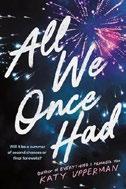
Two teenagers reconnect when they both need it most. After three years, Piper and Henry, who are both cued white, reconnect by chance. The night they met, Piper was dealing with the grief of losing her parents, who died in a crash caused by a drunk driver, as well as with loneliness and academic stress. Seventeen-year-old Henry, from Spokane, Washington, was visiting his dad in Sugar Bay, Florida; he was the calming presence she needed. Now, Piper’s coping with tense relationships with 32-year-old Tati, who’s both her sister and her guardian, and Gabi, who reads Black and is her former best friend. Hypercritical Tati feels Piper is headed down a bad path, and Gabi feels betrayed by Piper. Henry is back for the summer, staying with his dad, who runs a sports bar, and dealing with his own relationship issues. While the narrative is engaging, it moves at a slow pace and can be repetitive. Still, as Piper and Henry reconnect, their characterization forms the heart of the novel. The story alternates between the leads’ first-person perspectives, and their sincerity makes them sympathetic. Piper’s experience of grief offers a reminder that we don’t always know what others are going through, while Henry’s struggles will resonate with readers who are navigating troubling family relationships. Upperman effectively discusses difficult topics like alcohol abuse, consent, and reproductive choice.
A touching, character-driven romance about second chances that will appeal to patient readers. (Romance. 13-18)
White, Owena | Illus. by Suzana Harcum First Second (352 pp.) | $25.99 | $18.99 paper | February 24, 2026 | 9781250330741 9781250330734 paper | Series: Tripping Over You, 2

In this second series installment, two young men, Liam Schwartz and Milo Dunstan, continue to grow up together. This volume opens with Liam and Milo as in love as ever, even though they’re facing challenging issues, both individually and together. Milo, who’s at university and studying theater and dance, has a new baby sister whose arrival makes him feel disconnected from his family; it’s as if his mother is “starting her life over.” Liam, who’s back living at home, feels burdened by the weight of his father’s expectations. Now they’re no longer at boarding school, it’s hard for them to spend as much time together, which opens up room for misunderstandings and mixed signals, putting a strain on their relationship. As they navigate early adulthood—including seeking employment and choosing career paths—their story arcs continue to develop the theme of the importance of clear, honest communication, something that plays a decisive role in the plot. The banter between Liam and Milo will engage readers and get them rooting for their relationship to succeed, and the inclusion of classic romance tropes helps lighten the mood even as they navigate some more serious coming-of-age topics. Unfortunately, the British setting is superficial and unconvincing in its portrayal. The full-color art, which has a retro style and slightly faded palette, accentuates the characters’ angular features. A sweet and endearing queer romance. (Graphic romance. 14-18)
Wildermuth, Renate | Fitzroy Books (210 pp.) | $18.95 paper | February 24, 2026
9781646036844

Seventeen-yearold Talya has perfected the art of avoiding attention. After her parents were killed in a carjacking, she relocated to an unnamed town to live with her mysterious uncle. When new student Axel arrives, Talya is immediately suspicious: He’s several years older than the rest of the senior class, and his clothes and shoes are oddly pristine. Convinced he’s a spy, she confronts him and reveals that her father was a secret agent. Axel reluctantly agrees to train Talya, who’s convinced she’s in danger, to protect herself. They break into the school’s rifle range, where Talya learns about ballistics and engages in target practice and hand-to-hand combat lessons with Axel. As the training intensifies, the two grow closer, although Axel’s protectiveness feels more like an imitation of Edward Cullen’s brooding control, minus the spark Stephenie Meyer brought to her characters, and the age gap and power imbalance between the two feels unsettling at times. The novel employs liberal foreshadowing, but it fails to generate real suspense, and the minimal character development leaves little reason for readers to care about the outcome. Odd behavior from students and teachers offers clues and red herrings about the event that brought Axel to town, but the plot often strains credulity, with characters leaping to wild conclusions and acting irrationally. The chapter headings and redacted names throughout point to the text being a transcript of recorded interviews. Main characters present white. An underdeveloped spy tale with implausible plotting and a flat romance. (Thriller. 14-18)
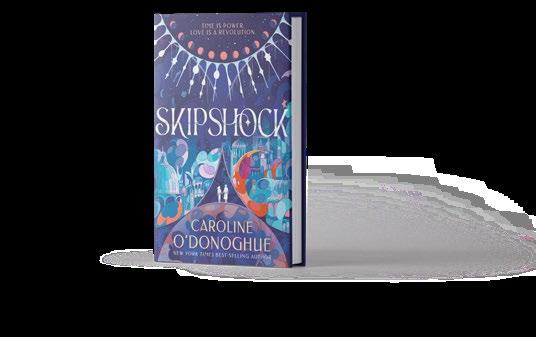



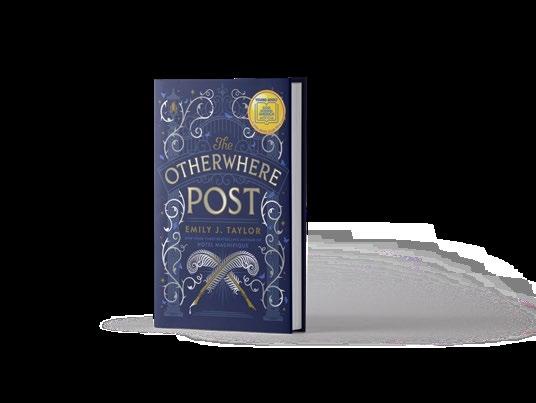



The author of White Lies answers our questions.
THE BATTLES OVER American history—and how it’s taught in our schools—are front-page news these days. Those currently in power want to impose a sanitized narrative that downplays the centrality of slavery, among other topics, to the story, while many scholars, teachers, and parents push back. Ann Bausum’s latest nonfiction book shows that the conflict is hardly a new one. White Lies: How the South Lost the Civil War, Then Rewrote History made our list of the Best YA Books of 2025, and Bausum told us more about it by email.
Wisconsin, where I live now, or in such states as South Dakota, Texas, and Utah. Many people have shared stories about their own experiences with misleading or incomplete accounts of history, and there is general agreement that we are better served when we learn from the past by studying the breadth of our nation’s story, both its triumphs and its tragedies.


What was the original idea that started you working on the book?
A dozen or so years ago, an old friend from Virginia tracked down for me copies of our childhood state history textbooks. By then, I knew those books from the 1960s had been flawed, but when I read them with fresh and wiser eyes, I was shocked by how seriously they had misled us about such matters as the nature of slavery, the cause of the Civil War, and the realities of Reconstruction. Such distortions are part of what’s known as the Lost Cause, a post–Civil War effort to maintain white supremacy and restore white rule in the South. I wrote White Lies to help others— and myself—understand the history of this effort and its continuing impact on Americans.
What kind of reception has the book had in schools and communities so far?
Support for White Lies has been strong, whether I’ve spoken in
What inspired you during the writing of the book? What were you reading, listening to, watching? Because I was writing a nonfiction book, I read a great deal of scholarly work about the Lost Cause and related history. That material was crucial, of course, but so was travel. In 2021, as soon as I’d gotten vaccinated against Covid, I headed to Virginia and Washington, D.C. I wanted to get a fresh look at familiar historical sites, see new ones, and view Confederate monuments slated for removal. I also rewatched relevant movies, such as Gone With the Wind By reconnecting with various forms of Confederate commemoration, I was able to describe and contextualize them for readers in a more compelling way.
Where and when did you write the book? Describe the scene, the time of day, the necessary accoutrements or talismans.
I write at my home office, a space stuffed with books, reference materials, family photographs, and objects from my past. One picture took on added significance during the five-year period of my work on White Lies. You’ll find it included with my author’s note. It shows my
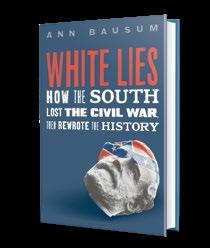
White Lies: How the South Lost the Civil War, Then Rewrote the History Bausum, Ann Roaring Brook Press | 268 pp. | $21.99 August 12, 2025 | 9781250816573
mother as a young girl in Louisiana circa 1935, surrounded by four older generations of her family. The oldest was the widow of a Confederate soldier who died from camp illnesses before ever reaching the battlefield. My mother’s family also had a relative from Louisiana who fought against the Confederacy. This photo reminds me of the complexity of our history, of how our nation’s story and our personal stories are one, and that our nation’s history is short! As a child, I sat on the lap of a woman who grew up sitting on the lap of a Civil War widow. That fact still amazes me.
Interview by Tom Beer
THE EXISTENCE OF the hairy, humanoid forest creature known as Bigfoot, or sasquatch, has never been confirmed, but that hasn’t stopped many, many people from trying—and this search, and the grainy photos and films showing alleged examples of Bigfoots, have become a well-known part of the popular culture. Surprisingly, though, there have been relatively few examples of sasquatches in TV shows and films, aside from a smattering of creature features—and, of course, the 1987 movie Harry and the Hendersons , in which a Bigfoot befriends a suburban family. The popular horror-fantasy CW show Supernatural even had a running gag that Bigfoots were one of the few monsters that didn’t exist. However, sasquatches have been the subjects of a great many books in a range of genres. Here are a few highlights from the wilds of Kirkus Indie:
D.J. Abear’s The Heart in the Forest isn’t the first paranormal romance to feature a Bigfoot as a

romantic lead, but 7-foot-tall Oomin isn’t like other Bigfoots. As our reviewer notes, he not only loves nature, as one might expect, but also “the poetry of Percy Bysshe Shelley, and…the loneliness of having a lost a mate”—just like avid 60-something camper Jane Armstrong, whom he rescues after she’s rendered unconscious following a fall. Initially, and perhaps unsurprisingly, Jane thinks she’s hallucinating when they first meet.
Intriguingly, though, the book is less about the oddness of Oomin’s sasquatch status than it is a reflection on aging and making connections. Our reviewer praised how the novel “skillfully combines compassion, humor, and a dash of suspense.”
The Sasquatch Murder: A Love Story by Jeffery Viles, as its title suggests, has mysterious elements— but it’s not a whodunit, by any means: When Jake Holly encounters a Sasquatch couple in a forest in Washington state, he panics, shoots one dead, and wounds the

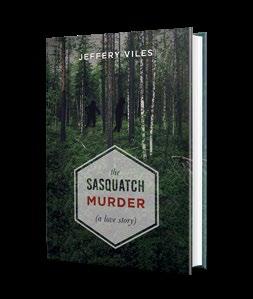
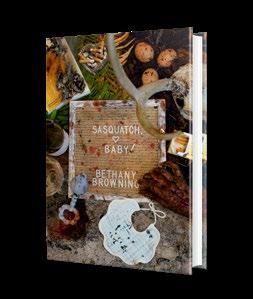
other, who escapes. Jake and his new girlfriend, Jess O’Reilly, bring the corpse to a funeral home, and when the existence of Bigfoots is revealed to the wider world, it seriously complicates everything— including Jake and Jess’ relationship. The book also delves into the history of the sasquatches in a manner that strives for believability, according to Kirkus’ reviewer, who called the book an “earnest, thoughtful” work “about the ways that people react to the unexpected in their own lives and in the world at large.”
By contrast, our reviewer calls Bethany Browning’s novel Sasquatch, Baby! a “sharp-edged novella” that “delivers the quirky, unhinged entertainment it promises.” Its protagonist,
Tabitha Eggs, is a heavy drinking, wealthy Californian who’s alienated her friends with her immature ways; she decides to go into self-destructive seclusion in a redwood forest cabin. She didn’t expect to discover two corpses on her land, to be sure; Bigfoot hunters think that that local Sasquatches are to blame, while protesters want to keep such hunters at bay. After a kindly Bigfoot turns up and rescues Tabitha from a fire, the event effectively upends her perspective on life—and kicks off what our reviewer called an offbeat love story that offers readers “a wild ride that’s as compelling as it is unorthodox.”
David Rapp is the senior Indie editor.
A set of portraits from an artist who helped to define an era of celebrity.
Photographer Edie Baskin’s distinctive hand-tinted images helped to set the aesthetically adventurous tone of the cultural juggernaut Saturday Night Live from the program’s first episode in 1975. She would go on to photograph the show’s hosts and musical guests for the next 25 years (the images would typically appear as “bumpers” between ad breaks), and her instantly recognizable shots of Steve Martin (perhaps her signature muse) or Elliott Gould or Sissy Spacek deliver memory-evoking kicks. Baskin’s images for SNL may bring Andy Warhol’s celebrity Polaroid snapshots to mind, but their effects are markedly different. While Warhol’s often harsh, cold, and flat
portraits distance the viewer from the subjects, Baskin’s vibrant enhancements (she used a variety of techniques to add pigment to her black-and-white shots) reveal quirky, human qualities—the viewer leans in, their relationship with the subject deepened. The brilliant and tragic Richard Pryor, for example, pictured wearing a psychedelic pink sweater, vibrates against a stark black background, his eyes full of the pain of the world. Some of Baskin’s pieces suggest well-known paintings: The photographer grants Shelley Duvall’s elongated features the languorous elegance of a Modigliani odalisque; a delicate image of Jodie Foster with straw-colored hair and sky-blue eyes seems plucked from an Andrew Wyeth canvas. At the other end of the
Edie Baskin
Jodi Lin

Baskin, Edie | ACC Art Books | 216 pp. $65 | October 7, 2025 | 9781788843430
spectrum, Rodney Dangerfield pulses with the inhuman energy and anarchic hilarity of a Warner Bros. cartoon. The cumulative effect of the collection is one of piercing nostalgia for a vanished era of show business that now seems impossibly humanscaled. Baskin’s subjects, as ecstatically celebrated here, were not like the machinetooled, media-trained, TikTok-ready stars of the moment; they could be
lumpy, awkward, weird, unpolished, real . The miracle of Baskin’s technique was that her alterations to the objective documentary “truth” of her photographs only made the work feel more authentic, more revealing of the subjects’ essential natures—a captivating magic trick that works again and again. A sumptuous and revelatory collection of 20th-century iconography.
To Heal the World
Batty-Capps, Allison | Atmosphere Press (368 pp.) | $19.99 paper | November 4, 2025 9798891328426
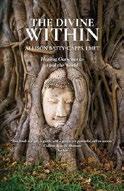
A guide to connecting with one’s internal wisdom to foster spiritual and emotional transformation.
Batty-Capps—a “licensed marriage and family therapist, yoga therapist, reiki master, intuitive spiritual guide, and channeler”—uses both her professional expertise and her personal experiences with profound trauma to guide readers toward healing in this work, which the author divides into three parts. Part One explores the power of one’s “inner compass” and describes the experience of sensing “a slight separation from your body sensations, emotions, beliefs, and thoughts, and yet you are fully in your body with what is present.” Part Two focuses on identifying and overcoming old wounds that significantly affect one’s ability to become a fully realized individual. Part Three touches on various topics regarding relationships with others on a philosophical level, with the author reflecting on such broad topics as justice and social hierarchies. Throughout the book’s wide-ranging discussions, Batty-Capps incorporates a wide swath of religious and spiritual practices—from Christianity and Judaism to Hinduism and Buddhism— to help make sense of the individual and humanity as a whole. Having experienced significant emotional and mental health problems (including a later-in-life diagnosis of PTSD due to repressed memories of sexual abuse, bipolar disorder, and schizophrenia), the author approaches healing from a traumacentric perspective and with the utmost care. She emphasizes that a particular meditation, for example, is not designed to help heal “exiles” (the word she uses to describe “parts that hold wounds and are out of conscious awareness”), and
counsels that, in the event that exiles do arise during the meditation, readers should contact a mental health professional. Despite repeated plugs for her YouTube channel, websites, and recorded meditations on Spotify, which quickly chafe, the author approaches her topics with a keen sense of awareness and support for trauma-laden individuals. Presenting the material via a competent and compassionate narrative voice, Batty-Capps creates a bubble of comfort and safety in which readers can confidently explore different holistic approaches to wellness.
A unique approach to mental health that blends the spiritual and scientific in a whole-body wellness plan.
Bianchi-Clark, Alice | Illus. by Chloe Chang Marshall Cavendish (36 pp.) | $16.80 paper August 16, 2024 | 9789815084504

In BianchiClark’s picture book, a playful child bonds with his grandmother in her garden. Alexander, who has light skin and brown hair, always has a new idea for a game to play with his Nonna, but she’s too busy deadheading flowers, stringing green beans, or cutting back the blackberry bushes—part of her never-ending list of outdoor tasks. She doesn’t have time for Alexander’s sword fighting and butterfly chasing, or even the camellias she wants to plant. In an effort to cheer her up, Alexander accompanies his Nonna to the garden center and slyly purchases a pack of seeds. He sows them back home but is devastated when birds eat them all up, so Nonna pauses her activities to help, showing Alexander the safest way to plant them. Watering the plants and waiting for them to grow become bonding moments for the two: “‘Before your seeds can grow upwards,’ Nonna says, ‘they need to grow downwards. Seeds take love, patience and time.’” Together, they tend both the garden and their own
relationship. This sweet, simple outdoor tale is layered and heartwarming, serving as a how-to guide for young readers learning to raise plants and for families learning to meet in the middle. Chang’s soft illustrations are full of light and warmth, which balance well with Alexander’s big, sometimes exaggerated expressions. A charming picture book about cultivating relationships outdoors.
Boden, G.R. | Self (172 pp.) | May 27, 2011
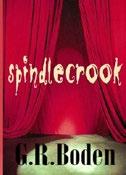
Boden’s middlegrade fantasy novel follows an 11-yearold English orphan who is taken to another dimension and forced to act in a play by cruel overlords.
Simon Favor hasn’t exactly lived an idyllic life. After his parents died a day apart in freak accidents six years earlier—one was killed by a falling piano and the other was flattened by a bulldozer—Simon’s foster parents sent him away to a private academy called Grynnless Middle. The school is surrounded by rusty razor wire and blanketed in a creepy fog, and Simon immediately knows he is in trouble. Miss Murkwater, the headmistress (who is obsessed with doling out unwarranted disciplinary measures) and Warden, a large, bullying roommate, make Simon’s first days a nightmare. The only saving grace is Pepper Benoit, a pretty girl who shows an interest in Simon and persuades him to join the school’s theater troupe, which is named Spindlecrook. Benoit turns out to be a collector—a talent scout of sorts. She is a mythical creature from another dimension who, with help, can cross the veil between worlds to find and abduct humans to act in her boss’s twisted theater productions. (Humans make the best actors because of their short lifespans.) Simon finds himself imprisoned (literally caged) in a strange, pseudo-medieval fantasy world replete with satyrs, shapeshifters, and dragons. Forced to act in a monster’s play with
other kidnapped humans, the 11-year-old desperately searches for a way home. Boden’s narrative is, tonally, very much comparable to the first Harry Potter novel, even putting aside the fact that both works feature 11-year-old orphans living in England who attend decidedly strange schools. Although there are dark plot threads that contain minor violence and evil machinations, the overall vibe of the story is fun and adventurous, with a glorious sense of wonder that underlies Simon’s quest to escape and return home. The fantastical supporting characters (including Pepper, a beautiful halfhuman/half-water creature, and Mungo, a scary but courageous cretin who is essentially a walking mountain) exemplify the childlike, awe-inspiring tone. Even the otherworldly crowd watching the theatrical performance reflects that wonder: “Simon stared curiously at the gawking spectators, some of them with luminescent pearly pink skin and huge glossy black eyes, and others with slender necks banded with multi-colored beads and crimson skin scaled like a fish. Still others appeared to be almost human-like, but they crawled and hopped across the ground on all fours and screeched like monkeys.” A streak of light-hearted humor permeates the entire story: “I… never dreamed that I would be in a strange town in another world, living in a birdcage and performing theater for an evil tyrant with a wolfman as a bodyguard.” The principal (minor) flaw is the lack of thematic weight. The author could have more deeply explored Simon’s quest to find (and define) home, his struggle to find his place in the world, and the themes of friendship and self-empowerment. Boden will, one hopes, further develop these elements in future installments. Young (and old) readers looking for a fast-paced and unique fantasy adventure will be pleasantly surprised.

A bighearted book with sharp illustrations and an important message.
A FATHER’S PRESENCE
Brooks, Rodney A. | Spiramus Press (186 pp.) $28 paper | April 30, 2024 | 9781910151495

Brooks examines the Freedman’s Savings Bank and the indelible damage its failure inflicted on the development of Black capital in the United States. In 1865, in the aftermath of the Civil War, Congress chartered the Freedman’s Savings Bank to serve newly emancipated people and Black Union soldiers. The author discusses how the bank quickly became a symbol of economic freedom and hope, designed to encourage thrift and financial stability in a population starting with nothing. Initially, the institution, which operated out of branches across the South and in major northern cities, enjoyed remarkable success, accumulating millions in deposits from over 61,000 Black Americans who entrusted their life savings to what they believed was a secure, government-backed institution. But in 1870, an amendment was made to the bank’s charter that allowed its funds to be invested in highly speculative and unsecured ventures, opening the door to catastrophic mismanagement and outright corruption orchestrated by unscrupulous, predominantly white officials and trustees. The bank tragically closed in 1874, causing the loss of nearly three million dollars in Black wealth. Brooks effectively makes the case that this single event decimated the economic foundations of Black America and
instilled a profound, long-lasting institutional distrust that became a significant barrier to intergenerational wealth-building (he heartbreakingly characterizes the institution’s failure as “a killer of Black dreams”). This argument is both compelling and timely. The book’s greatest strength lies in the author’s ability to connect 19th-century history to present-day socio-economic realities, underscoring the effects of structural inequality. The research is thorough, drawing heavily on archival records and legislative history, which provides a strong, authoritative backbone for Brooks’ premise. The author successfully demystifies complex financial and political maneuvers, making the material accessible to readers unfamiliar with Reconstruction-era banking laws. However, given the emotional weight of the loss, the book occasionally leans more heavily into legislative detail than personal storytelling, which might make the read feel somewhat dense in certain sections. Still, the meticulous accounting of institutional failure makes this an essential and sobering contribution to the literature on American economic history and racial injustice. A timely lesson on the corrosive, enduring effects of institutional betrayal.
Davis, Daniel C. | Illus. by Salar Seif Self (20 pp.) | $13.99 paper October 3, 2025 | 9798218770143
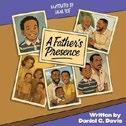
In Davis’ debut picture book, a boy with an emotionally absent father learns how to foster a loving family environment.
Curtis, a young Black child, would like to be closer to his dad. Curtis’ father spent little time with his own dad; as a result, he vowed to be there for his own son. Curtis’s father is physically present when not at work, but he’s emotionally distant and unable to express his feelings. As Curtis grows into a teenager, he learns from other men in his life (coaches, counselors, uncles) how to listen and relate. When Curtis marries and has a child of his own, he’s able to be both present and emotionally receptive. For Curtis’s son, a well-adjusted father-son dynamic becomes the norm. Davis tells this family story through matter-of-fact, sincere prose. Each page is quite text-heavy, and the life lesson seems aimed more at adults and adolescents than younger children. Nonetheless, the earnest delivery and striking presentation—featuring plain backdrops and foregrounded, emotional characters— will make the book accessible to a wide range of readers. Seif’s full-color illustrations evoke vintage children’s books and make clever use of light and shade to suggest mood and possibility. The positive change that Curtis’ family achieves over generations makes for a sober yet inspiring takeaway. A bighearted book with sharp illustrations and an important message.
Desplechin, Franck | Incrementum Press (240 pp.) | $24.99 paper | October 14, 2025 9798218737924

Desplechin, an expert mindset coach, draws on his experiences as a chef in a powerful book about growth mindset. Many professionals aspire to have the skills of an acclaimed chef—someone who’s honed their skills to lead their kitchen staff to greater heights, and who can create an edible masterpiece with precision. In these pages, Desplechin—a chef at
Michelin-starred restaurants, including Arles, France-based L’Atelier de Jean-Luc Rabanel—has condensed his own life’s stories into valuable lessons in an accessible work which focuses on growth mindset— the ability to improve one’s talents with practice and determination: “It is clear to me that those who adapt, who learn, and who commit to self-improvement will be the ones who lead the way forward,” he notes early on. From the start, it’s evident that the author speaks from credible experience, as described in a foreword from renowned restaurant owner Jean-Luc Rabanel, praising the chef’s skills and his engaging stories; Desplechin says that the tales included here were “born from the daily grind of hospitality and refined in the heat of the kitchen.” Each story supports his self-help assertions, elegantly weaving narratives into more meaningful lessons and action-oriented encouragements that readers can practice right away. For example, his charming narrative about how his passion started in the kitchen with his parents in his hometown of Châteaulin moves into a broader lesson about curiosity; his anecdote about being “restless” in traditional school at age 14 turns into a call to action about “defining your vision”; and a tale of a brief threemonth stint as a pastry chef tells readers that they could also experience careeraltering lessons by embracing the unexpected. Bulleted lists might have further sharpened his points; an early paragraph that urges the reader to “paint a picture in your mind” could have helpfully used such an approach. Overall, Desplechin’s message about growth mindset—”that you can become more than the person you see in this moment”—shines through on every page. Eating while reading is advised. An engaging self-help book about achieving one’s dreams through focused effort.
Dickson, H. Leighton | Entangled: Red Tower Books (512 pp.) | $32.99 November 4, 2025 | 9781649379139

Dickson crafts a rich fantasy world, deeply infused with the seafaring spirit of a pirate yarn. Ensign Bluemage Honor Renn of the Oversea Navy desperately clings to a plank of wood following a brutal battle with the Rhi’Ahr ship Endorathil that reduced her ship to charred splinters, sinking beneath the waves. Her hands—her tools as a magic-wielding mage—are horribly injured, leaving her helpless: “With a cry, I pulled them from the waves and froze in horror at what I saw….The flesh was torn away like ribbons, revealing glimpses of thin white bones and long yellow tendons.” Just as she’s about to give up, the legendary and mysterious Ship of Spells arrives to rescue her; she’s shocked and horrified to learn that the craft is helmed by Capt. Thanavar, a Rhi’Ahr whose people hail from the mysterious southern hemisphere known as the Nethersea. The Rhi’Ahr possess the secret of “chimeric,” a dangerous alchemical powder that enhances their munitions with caustic magical runes. Although Renn initially hates and mistrusts Thanavar, she comes to learn that he’s the key to her learning how the mysteriously healing of her wounds has left her with a deep connection to the chimeric—one that the Ship of Spells puts to use in an attempt to end the ongoing war. Dickson delivers an inventive riff on familiar fantasy tropes within the framework of a thrilling
High-seas adventure meets rich fantasy worldbuilding.
SHIP OF SPELLS
swashbuckler. Any pirate story lives and dies on the dynamics of the crewmembers, and in this, the author does not disappoint. Each character satisfies familiar tropes of fantasy and seafaring adventures while also thriving as fully realized individuals—whether it’s the telepathic faun, Echo; the jovial minotaur, Buck; or the stoic harpy, Kit. The relationships among the players develop in rewarding ways, and none more so than that between Renn and Thanavar. The narrative, rendered in clear, straightforward prose, also sketches out its fictional world in detail and drives readers relentlessly forward toward a satisfying conclusion, which will leave them wanting more.
High-seas adventure meets rich fantasy worldbuilding and strong character development.
Edwards, Kat | Sugar Pine Publishing (336 pp.) $16.99 paper | May 23, 2025 | 9781647049683
Series: A Riley Brighton Thriller, 1
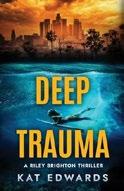
In Edwards’ series starter, a gutsy emergency room physician is drawn into the dangerous hunt for a vicious serial killer. Speeding to work just before sunrise, young trauma doctor Riley Brighton happens upon the body of an apparent hit-andrun victim in the middle of Los Angeles’s 101 freeway. A huge, menacing man with a black pickup abruptly warns her away from the scene; knowing first responders are on the way, Riley heads to LA City General, the hospital and medical school where she works in the ER. Her day only gets worse: The department head blindsides her with an interrogation about the recent death of a 6-year-old patient, a loss that shook Riley deeply (“Nothing had been the same since that night”), in a blatant attempt to scapegoat her for a colleague’s incompetence. The details of the hit-and-run suggest it wasn’t an ordinary accident—worse, there seems
to be a connection to another recent fatality on the same stretch of freeway. That evening, when the police show up at Riley’s home with questions, she surmises that the victims were transgender. Riley’s sense of justice is outraged by the hate crimes, and she may be in danger as a known witness. She contacts “Avenging Allies,” a mysterious group that’s investigating the first highway murder, and gets caught up (against her better judgment) in the dangerous search for a savage monster as the body count rises. The novel’s plot, with its constant new developments, is a complicated web with many threads that take time to connect. (They add up to page-turning intrigue, but there are no surprise twists and little suspense.) Riley is an engaging hero, kind to her patients and colleagues, and courageous whether confronting obnoxious colleagues or putting herself in risky situations. The key supporting characters—including heart-of-gold Holly, a new friend of Riley’s, and Joe, the chief pathologist whose crush on Riley is an open secret—are also well drawn, though less well rounded. The narrative moves briskly, and although the office politics subplot has no direct relationship to the main mystery, it doesn’t slow things down and effectively demonstrates Riley’s character. The story includes gruesome medical details and mentions of child abuse, though almost all of the violence happens off-page. A solid thriller and a promising series debut.
Focht, L. | SmallPub (245 pp.) | $16.95 paper August 25, 2025 | 9781069485403

A memoir reflects on the joys, mishaps, and hard lessons of country living in rural Canada. In this candid and often hilarious chronicle, high school teacher Focht recounts her unlikely
transformation from a city-dweller working at a Canadian Tire store to a small-town teacher and farmer in the “cute, quintessentially perfect Saskatchewan farming community” of Liberty. What begins as a one-year teaching contract in 2004 becomes nearly two decades of rural immersion—complete with bat invasions, misbehaving cows, and a terrifying encounter with a winged creature that she eventually identifies as a prairie chicken. Farm mishaps and local color dominate, yet Focht layers the comedy with deeper emotional undercurrents, discussing such topics as infertility, postpartum depression, and the isolating loneliness of motherhood on the prairie: “Would I do it all again? Absolutely,” she writes, “but I could do without some of those lessons handed down from some imperious god playing with me like a fantasy queen on a chessboard.” Amid raucous anecdotes showcasing her humor, tragedy lurks and finally takes center stage in a poignant final story about a troubled student whose trajectory leaves the author grappling with her own limits as a teacher, mentor, and member of a community that sustains and disappoints her, by turns. Focht’s prose is consistently sharp, funny, and unflinchingly honest, and she has a gift for comedic rhythm that provides constant entertainment. Her no-nonsense voice makes discussions about sex and sorrow feel authentic and charming without veering into sentimentality. Still, the book’s structure can feel uneven: the rollicking farm anecdotes dominate the text so thoroughly that the darker material feels slightly detached from the rest. Although Focht asserts that Liberty transformed her, the work feels more about the chaos of country life in general than about that town specifically. Even so, the author proves to be a gifted storyteller with an engaging, offbeat voice.
A witty and often poignant remembrance.

For more Indie content, visit Kirkus online.
A delightful feline interpretation of the human world.
MAYBE I’M NOT GOD
Frans, Russel | Worlds Collide Publishing (510 pp.) | $24.95 paper | April 12, 2024
9798990343726 | Series: Planewars Saga, 1

A brave general aims to overthrow an immortal wizard, whose ambitions could lead to an unprecedented age of darkness in Frans’ fantasy novel. This first book in The Planewars Saga introduces readers to a multiverse consisting of 27 known worlds, in which the seemingly immortal wizard Lord Brakken (known, among other names, as “the War Maker”) has at least partial control of four—and has his eyes set on the rest. But there is a growing faction of creatures—human, elves, dwarves—who are willing to rise against the dark wizard to finally find freedom. This group is led by Artorus Vallon, a grizzled general who has finally had enough, and his brave half-sister, Mala. As their rebellion grows, they seek help from a Sage (an immortal race who act as knowledge keepers for all the known worlds) named Kellos. Together, they will learn all they can about the wizards—including the three branches of magic that allow them to manipulate matter, teleport, and control people’s thoughts. But as the fight escalates and things turn increasingly violent, Artorus and his army of rebels hurtle toward a shocking conclusion. Frans has crafted a sprawling first-in-series that manages to be action-packed while still leaving plenty of room for more. The blend of fantasy and sci-fi (Lord Brakken picks fights with other planets through a “worldgate”) provides a fresh spin, while Artorus’ consistently compassionate
leadership and distaste for violence makes for a genuinely inspiring hero: “‘This ruthlessness, this fear and death,’ Artorus hissed, ‘this is the stuff of Wizards; of madmen and of warlords.’”
A sophisticated formal narrative voice and crisp dialogue help transport readers into Frans’ panoramic multiverse. While fantasy beginners may find the book’s 500-plus pages and lengthy glossary of characters intimidating, those who know and love the genre will delight in Frans’s intricate world(s) building.
A delicate balance of political intrigue, elaborate world building, and thrilling action merges into an epic medieval fantasy.
Gander, Stefania | Trans. by Chiara Gastaldi Gander Books (123 pp.) | $15.99 paper March 10, 2025 | 9791281230293

Gander presents the story of an irrepressible little domestic house cat named Kitty, told from his perspective. Readers meet Kitty when, as a frightened, tiny kitten, he is adopted and removed from his mother. (“You scoundrels, leave me alone! I said let me go… stop grabbing my scruff, or I’ll bite you, I’ll destroy you, I’ll annihila… Moooommm….”) His first impression is that he is being “catnapped”; Kitty fears that he has been stolen for ransom or, even worse, that he will be eaten. The male and female “two-legged one[s] feed him quite well, but what if they are just trying to fatten him up before consuming him? They keep calling out “Kitty-kitty,”
and the furry feline is sure there is someone out there designated to keep him in line. After a day or two, he is let out of his room and learns there are two other cats in the house. The older one, a female named Mimi, hisses at him, and the younger male, Felix, remains aloof and a bit jittery. As he explores his environment and gets into trouble, he deduces that his own name must be “Stop.” For the next few days, Mimi continues to hiss at him, but Kitty is determined to befriend her. She has a sweetness that conveys security, and she reminds him of someone—the word “mama” comes to mind. Gander’s imaginative tribute to all of the cats who have been part of her family over the years is a charming and entertaining excursion into the feline mind, and cat lovers will recognize Kitty’s antics and playfulness. The book is a quick read— sweet, witty, and poignant (keep a few tissues handy). There’s a bit of adventure, as when Kitty learns why his humans have been trying to keep him off the balcony railing, and tender moments as he tries to figure out what kind of creature the humans’ new baby is, concluding it is his responsibility to protect this strange addition to the family. Most of all, this is a story about love and the special relationships that develop between felines and their humans. A delightful feline interpretation of the human world, suitable for animal lovers of all ages.
Gardner, James | Self (382 pp.) | $24.95 paper | August 19, 2025 | 9798218740399

Football connects family members in Gardner’s memoir of love, life, and unexpected challenges. In the American college football circuit, each team and campus is anchored by traditions and mythmaking that can span generations and foster
unbreakable bonds. That spirit permeates this memoir, which combines a father’s journey with his son, who has Down syndrome, and a study of aspects of American history. When Daniel was born in Ohio in 1998, the author wondered what the future might look like for his child, particularly when it seemed that so many were ready to write off a person with a genetic disorder. At the age of 12, Daniel joined the first of what became regular “guy trips” with his father, grandfather, and uncle. Together, they visited several Southern college towns to watch football games and soak up the local color. The trips ended up being about so much more than just gridiron action; in this recounting, the author shares the background of Tusk VI, the Arkansas Razorbacks’ beloved Russian boar mascot; descriptions of William Faulkner’s home, Rowan Oak, in Oxford, Mississippi; and information on the founding of the first presidential library—the James A. Garfield National Historical Site in Mentor, Ohio—among other bits of history. The book also effectively serves as a guide to the culinary gems of the South; the author showcases the Gardners’ appreciation for good food and offers mouthwatering accounts of meals in places such as the Mississippi-based hot-tamale joint, Doe’s Eat Place, and award-winning chef Hugh Acheson’s restaurant, Five & Ten, in Athens, Georgia; there’s even a recollection of a memorable breakfast at a Waffle House in Clemson, South Carolina. The “guy trips” are really about creating memories, and, as such, the book overflows with beautiful and tender reminiscences.
Throughout, the author is open about grappling with the challenges of raising a son with Down syndrome, but Daniel’s joys and ambitions effectively shine through the entire work.
A heartwarming ode to a father’s love for his son and the road-trip experiences they’ve shared.

Gephardt, Jan S. | Weird Sisters Publishing (662 pp.) | $8.25 paper | September 24, 2024 9781950748105 | Series: The XK9 “Bones” Trilogy, 3

Gephardt’s third SF series entry propels readers through a meticulously imagined interstellar setting where sapient, telepathic dogs navigate politics, crime, and personal issues.
This final installment in a trilogy, following What’s Bred in the Bone (2019) and A Bone to Pick (2021), fuses highconcept SF with procedural rigor. The Transmondian Empire created genetically modified and cybernetically enhanced canines as part of the XK9 project. Among them were Rex Dieter-Nell and his mate, Shady Jacob-Belle, who were sold to the government of Rana, a deep-space station. As police dogs in the city of Orangeboro, they’re paired with human law-enforcement partners with whom they share a telepathic bond—Rex with Charlie Morgan, and Shady with Pam Gómez—and outfitted with high-tech collars to speak. The Ranans recognized the XK9s’ self-awareness (“please remember that XK9s are people,” the police chief advises someone at one point), and now inspectors from the Galactic Alliance intend to help governmental officials rule on whether they are sapient. Meanwhile, the dogs and their humans investigate prolific bombers who may be connected to a criminal syndicate. The novel’s inventive mechanics—telepathic links, advanced scent-tracking, microgravity logistics, and multispecies diplomacy—create a tactile, immersive environment. The narrative occasionally risks overloading readers with exposition, slowing momentum in council sessions and technical briefings. However, suspenseful action sequences, including pursuit through hidden corridors of the Vinebrook (the compound of one of Orangeboro’s most powerful families), are rendered with kinetic precision. Dense action sequences can also challenge spatial clarity, though careful
attention to character perspectives largely mitigates confusion. They’re balanced by reflective interludes that add emotional weight, as when the members of the XK9 Pack process trauma. Rex evolves believably from a tactical operative to a political actor, wrestling with responsibility and inexperience, while Shady’s scenes of empathy and pragmatism anchor the narrative. A tense, inventive SF novel of loyalty, politics, and heroism, set in a vividly realized universe.
Gillingham, Jenna | Archway (208 pp.) | $20.99 paper | August 3, 2025 | 9781665777681

A newly minted PI goes back to her hometown to solve a long-ago disappearance in Gillingham’s debut mystery novel. When Anna Fischer left the Chicago public defender’s office for a new job with an elite private investigation firm, she never expected her first case would be to solve the crime that’s haunted her for her entire adult life. Fifteen years earlier, Anna’s best friend, Betsy Thompson, went missing in their hometown of Penn’s Point, Wisconsin. “I know more about her disappearance than I have ever told anyone,” Anna reflects when she gets the assignment. “The moment I have been avoiding for the better part of the last decade has finally come.” She should refuse to take the case—there is a clear conflict of interest—but she feels she can’t say no, professionally or personally. She heads back to the small, secretive town of Penn’s Point, surrounded by all of the things she’d tried to leave behind, and starts digging into the scant clues: a police report, some old interviews, a necklace. Did Betsy’s allegedly violent boyfriend murder her? Did she get kidnapped by the reclusive fundamentalist family that lived next to the junkyard where Betsy liked to hang out? Does it have something to do with the intimidating county judge who lives
in the old Victorian manse Anna has always called “the witch’s house,” or the mysterious lights in his cornfields?
Complicating Anna’s investigation is the fact that her high school sweetheart is now a cop—and the statute of limitations on their feelings for one another hasn’t quite yet run out. Anna will have to decide who she can trust if she wants to solve this mystery, and if she chooses wrong, she might become a cold case of her own. Gillingham’s prose imbues the story with moody unease, turning the ordinary eerie in nearly every scene. The mystery more than delivers on the hook of its premise. Readers will anxiously await Anna’s future cases, whether they unfold in the eerie confines of Penn’s Point or elsewhere.
An artful and totally immersive cold-case mystery.
Hardis, Joanna | Finn-Phyllis (303 pp.) | $15.95 paper | October 6, 2025 | 9798992958836

C ognitive behavioral therapist Hardis presents an unconventional guide to responsive parenting. The author surveys the world of parenthood from the vantage point of both a mother and a therapist, and in this book, she addresses the problems that arise when mothers and fathers allow themselves to become “distress intolerant”—or unwilling to go with the flow when facing the inevitable stressors of raising children. She advocates a kind of “do nothing” parenting, although she emphasizes that the goal isn’t apathy— “It’s to pause before doing something, because doing something is going to make an already challenging situation even harder.” Some of the problems that arise from distress intolerance will be very familiar to many parents: taking on too much, risking burnout; not allowing children to experience bad moods; talking
excessively (including talking over one’s kids); not effectively listening; and so on, and she urges her readers to develop the “parenting superpowers” they need to avoid these pitfalls. The strategy she envisions centers on “learning how to co-exist with the distress so you can parent effectively and not be hijacked by the emotions you’re feeling.” Throughout her item-by-item discussion of topics such as screen time or social media (which, she says, offers “constant access to parenting ‘directives’—directives that often make [parents] feel even more stressed”), Hardis maintains a consistently friendly, authoritative tone, a valuable mixture of sympathy and firm instruction. The core of her message, amid practical advice and bullet points, is that well-intentioned parents should sometimes relax and let things happen. As such, parents at all levels of experience will find much of value in these pages. An energetically readable revisionist plan for de-stressing child rearing.
Huddle, Denise Diana | SmallPub (335 pp.) $14.99 paper | October 5, 2025
9798999482204 | Series: Iris Raines Mystery, 1

In Huddle’s mystery-series starter, a feisty private investigator and forensic genealogist investigates when her family’s building goes up in flames.
Iris Raines was abandoned as a child by a client at the San Antonio law office of brothers Addison and Justis Raines. Later, the same attorneys adopted her. Now 33, she runs her own agency, Raines Investigations, and Raines & Raines—the law firm that first gave her a home—is her largest client. Both businesses operate from temporary offices as their shared building, the Hampe Ewald, undergoes renovations. One night, Iris watches in horror as the Hampe Ewald explodes, killing two people. The disaster worsens when it transpires that the general contractor failed to secure insurance,
leaving Raines & Raines liable for the deaths and facing bankruptcy. Determined to uncover the truth, Iris looks into the case with the help of Sean Galen, a computer genius and her best friend. The investigation comes to involve blackmail, missing photographs, and a string of ritualistic murders that may connect to the conflagration. Meanwhile, Iris grapples with lingering PTSD from a kidnapping she experienced the year before—a struggle that threatens both her focus on the case and her burgeoning romance with handsome Barron Claver, whom she meets on a mystery writers’ cruise. Huddle, who’s a retired PI and forensic genealogist herself, grounds the story in realistic detail. However, the legal jargon may deter some readers, and Iris’ genealogy work adds little to the central investigation. The novel’s greatest strength lies in its depiction of Iris and her heartfelt connections with those around her. Her witty banter, especially with Grover Delacourt, the San Antonio Police Department’s deputy chief of investigations, brings a sense of warmth that acts as a balance to the story’s darker elements: “Damn, Iris, it’s eleven at night,” he complains at one point. “Gee, thanks for that temporal update,” Iris responds. “That whole big hand/little hand thing still baffles me.” The mystery wraps up predictably but satisfyingly, making it a rewarding read for fans of private-eye procedurals. A solid whodunit whose characterization is more intriguing than its central puzzle.
Kemp, Elizabeth | Sibylline Press (322 pp.) $20 paper | October 10, 2025 | 9798897409747
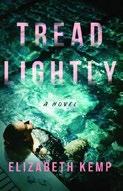
A former hostage negotiator helps authorities in Northern California solve a local murder in Kemp’s mystery. Eight years ago, Tierney Gillespie’s partner in the Dublin Crisis Intervention Squad, Norah Boyce, was gunned down by a vengeful
sniper at a gala event. Now, Tierney lives with her husband and young son in a “hoity-toity” Silicon Valley enclave, but the shooting still torments her. Unexpectedly, she gets another chance to be a hero when police discover the body of a young woman beaten to death at a local community pool. Tierney frequents the pool as a form of therapy, and she can’t resist helping peevish Det. Sgt. Howard Sutton solve the case—whether he wants her to or not. Along the way, Tierney juggles a host of other challenges, including raising her bullied kindergartner son, supporting a workaholic husband whose accounting firm represents high-tech firms in a wideranging financial scandal, and struggling to ingratiate herself with new friends, largely due to her baking prowess. There’s a lot going on in Kemp’s novel, which explains the expansive cast, but readers may find it arduous at times to remember who’s who. Nevertheless, it all leads to a taut hostage situation in which Tierney, a pregnant Norah lookalike, and the queen bee of kindergarten moms are locked in a bathroom by gun-toting drug dealers— who, disappointingly, are rather late additions to the cast. However, Tierney is an appealingly resolute hero with a big heart and an unwavering moral compass— and it’s hard to resist a novel with a line like “I used to be a hostage negotiator in Ireland for a few years before getting into baking.”
An absorbing whodunit and psychological drama with a strong protagonist.

For more Indie content, visit Kirkus online.
Kimmel, Mike | Self (244 pp.) | $24.99
December 1, 2025 | 9781953057174
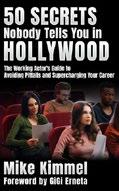
Kimmel helps readers navigate the unspoken rules of the entertainment industry in this guide. Every aspiring actor understands that, to succeed in Hollywood, one needs talent, tenacity, and a bit of luck. What they may not realize, however, is that there are additional expectations regarding how an actor should behave, many of which are not immediately apparent to outsiders. “Because the entertainment industry is so competitive, there are many secrets and bits of advice people will be reluctant to share with you,” writes the author in his introduction to this insider’s guide. “Many actors in Hollywood don’t know what they’re up against until it’s too late—and has already negatively impacted their careers.” Did you know, for instance, that certain agents will take on an actor with the intention of “shelving” him—sabotaging him on behalf of a similar actor whom that agent already represents? Or that there exists a “one-strike rule” that means the mere perception that you have wasted someone’s time, even accidentally, can get you blacklisted with that person forever? Or that posing for stock photos—photos taken and made available to advertisers as part of a massive library—can come back to haunt an actor when they unexpectedly
resurface years later? Drawing on his decades of experience as an actor on stage and screen, Kimmel lays out often harsh realities while detailing how actors can inadvertently undermine their careers. In 50 brief chapters, each only a few pages in length, the author guides would-be actors through lessons on dealing with managers, agents, and other performers, as well as the labyrinthine workings of the entertainment industry in general. The text includes practical advice (don’t sign with a single umbrella agency for television, film, and voice-over work), psychological tips (don’t succumb to envying other actors), and counsel specific to the peculiar traditions of Hollywood (never accept the offer of coffee at a business meeting).
Kimmel dispenses wisdom with the directness and economy of a weary veteran. “There are a lot of actors out there—far too many—who simply cannot get out of their own way,” the author writes with typical candor. “They can never meet an industry person without saying or doing something completely inappropriate— and thereby obliterating that new connection.” The author has a proudly old-fashioned sensibility; he advises actors against cursing and performing nude scenes, while encouraging them to always practice good table manners (he comes out against handshaking, though; there are many germaphobes in Hollywood). Some of his advice is common sense—find a flexible part-time job to pay the bills, don’t buy a fancy car you can’t afford, prepare thoroughly for your auditions—while other suggestions are less expected (the best way to learn how to act against another person? Take a stage combat class.) While some of Kimmel’s insider stories may feel slightly dated (the text includes references to thespians such as Al Lewis of The Munsters and Jean Carol of Guiding Light), for the most part, his wisdom remains evergreen. Readers will enjoy this demystification of the acting business, and some may save themselves from unnecessary Hollywood heartache.
A frank and insightful guide to thinking like a successful actor.
Lachman, Ranan | Stonehome Press (278 pp.)
$17.99 paper | September 16, 2025 9798993230306

Lachman discusses the ways in which the very routines that once kept us safe now threaten to make us obsolete in this nonfiction work.
Lachman observes that most people continue to rely on routines no longer suited to a world that has changed beyond recognition and endeavors to help readers recognize when their own routines have become “traps, rather than tools.” Research suggests rigid routines blind people and organizations to new opportunities; the author calls this “routine addiction,” a dependence that erodes adaptability. To counter this, Lachman introduces the ADAPT (Assess, Develop, Apply, Practice, Track) system, a framework that replaces rigidity with resilience, in which adaptation becomes the “default response to disruption.” The author argues that comfort has become a liability and that overriding comfort can spell the difference between irrelevance and reinvention. He suggests scheduling one “deliberate disruption” per week and tracking how the discomfort feels. What sets this book apart is its refusal to reduce adaptation to a quick fix. Instead, it frames resilience as a practiced skill, honed through repeated experimentation and an openness to discomfort. The ADAPT framework, combined with stories that range from tales of corporate disruption to individual survival, grounds abstract principles in vivid, memorable lessons. Leaders will find actionable tools for guiding their organizations through volatility, while other readers will gain a primer for reshaping both daily habits and long-term strategies. This is not a fearmongering manifesto but a cleareyed, science-backed guide to personal and professional transformation. The blend of neuroscience, psychology, and real-world examples makes the concepts
accessible, and the case studies give them weight. Lachman provides practical strategies for navigating uncertainty without succumbing to paralysis and inspiration to view change as an opportunity rather than a threat.
An engaging survival guide for anyone seeking not just to withstand disruption but to thrive on it.
LaVonne, Taylor | Self (347 pp.) | $11.99 paper | August 19, 2025 | 9798218742553

In LaVonne’s novel, a basketball player must navigate a career-threatening scandal while confronting a ghost from her past. When 25-yearold WNBA player Annie Larger steps off the court for an interview, the last thing she expects is to learn that the owner of her team (the fictional St. Louis Arrows) is her biological father, a secret her mother has kept since Annie was born. Shy and conflict-avoidant, Annie is terrified of what the revelation—and the accompanying rumors about how she was drafted and whether she deserves her spot on the team—will mean for her career. Her best friend, teammate, and Arrows superstar Jadea Jones, reaches out to Daniel Chan, the host of a popular sports show, after he publicly defends Annie online. She asks him to profile the team, hoping to shift attention back to women’s basketball. Jadea is unaware that Annie and Daniel dated in college…until a car hit Daniel and he abruptly ghosted her after leaving the hospital. Five years later, Annie is still smarting from the sudden end of their relationship. When Daniel agrees to cover the Arrows, Annie is startled to find their chemistry intact, making his past disappearance even harder to understand. As the scandal intensifies, Jadea proposes a bold distraction: Annie and Daniel should fake a relationship. Annie is stunned when Daniel agrees. Now, facing bullying from fans, shouldering pressure from her newfound biological family, and struggling to focus on the game she loves, Annie must
also untangle her complicated feelings for Daniel and find her own voice amid the chaos. Fans of the WNBA and newcomers to women’s sports alike will find this story, with its entertaining references to real-life figures, compulsively readable. The narrative effectively weaves in the inequities that plague women’s sports, providing a strong backdrop for Annie’s personal journey. While Annie’s avoidant, passive nature can sometimes be frustrating (“I opened my mouth to respond, but Coach turned away. I nibbled my lip, torn”), her relationships with Jadea and Daniel keep the story tender and compelling.
A heartfelt, entertaining story of love and basketball.
Lin, Jodi | New Words Press (102 pp.) $15 paper | July 17, 2025 | 9781968528003

A moving portrait of strength, renewal, and hope, told in narrative verse and prose poetry.
Lin’s work is a daring fusion of myth and memory, in which the journey of a goddess becomes inseparable from the author’s own. The collection carries readers through trauma and renewal in a haunting, lyrical exploration of resilience that lingers long after the final page. Structured into six sections, echoing the stages of life and death within the Tibetan Bardo, the book weaves together themes of identity, mental health, and spiritual transcendence. The poetic forms can be challenging—fragmented, elusive, and sometimes resembling shards of a broken mirror—but the disjointed style effectively underscores the work’s thematic concerns. Vivid imagery and striking metaphors ground the experimental framework, distilling recognizable human struggles into artful reflections. At its core, the narrative follows the Goddess Palden Lhamo as she traverses the underworld toward her next incarnation: Jodi, a transgender Pacific Islander whose life in
A sharp, worthwhile, story-driven guide.
DON’T WAIT, LEAD NOW
the United States is shaped by trauma and abuse. (“The body she chooses is me,” writes the poet in an author’s note). Some poems demand slow rereading, while others drift quietly by. The collection is strongest in its more frenzied and unpredictable works, which feel as if the poet captured them in the heat of the moment. Beneath the rawness lies a powerful meditation on karma, regret, and the precarious nature of choice: “Karma is constantly changing,” the speaker observes at one point.“I missed my chance to be the sacred queen. I was scared. In a split second the fear changed my fate. Perhaps the consequence was life.” These moments crystallize the book’s preoccupation with destiny and its reversals, broadening into ambitious explorations of suicide, time, and rebirth. With works that slide through centuries, continents, and lifetimes, Lin shapes a narrative that feels both intimate and universal, telling deeply personal stories of illness, heartbreak, and strength. A resonant meditation on rebirth and the enduring human desire for transformation.
Lord, Jim | Self (150 pp.) | $17.41 October 26, 2021 | 9798753989208

An actionoriented debut manual focuses on effective business leadership. In his slim guide, Lord draws on his extensive experience at all levels of management, working with business executives, to distill some key lessons about leadership and team supervision. He presents several core ideas, like more effective communication:
“I believe feedback should be given both vertically and horizontally—in all directions! Yet, this isn’t how we have been conditioned.” In fast-paced chapters, the author addresses several aspects of the corporate world, including cultivating the right work ethic, providing sufficient care for clients, and hiring and firing. When it comes to hiring, he recalls a saying he heard from an experienced executive—“Hire slow and fire fast”—and warns readers about ignoring such advice. “We fall into our comfort zone and try to quickly hire people that look and seem to be a lot like us,” he writes. “What happens is we find ourselves hiring people who are not a great match for the job, the culture, or the company.” Throughout, he weaves his own professional stories into his narrative, starting with his account of being invited to the retirement party of the experienced older professional who first took a chance on hiring him. These tales add an appealingly human dimension to what might otherwise have been a fairly standard business motivation book. But it’s Lord’s clarity about the nature of the lessons those stories impart that’s time and again the manual’s strongest element. The author is a thinker whose insights will be valuable to anyone in a leadership position, particularly when he discusses the admittedly nebulous concept of attitude: “If you believe your job is worthless and has no purpose, you’re probably right.”
A sharp, worthwhile, story-driven guide that explores energetic corporate leadership.

Street Brotherhood: Rise of the Underground
Metcalfe, A.D. | Calumet Editions (320 pp.)
$18.99 paper | July 30, 2025 | 9781962834483

For more Indie content, visit Kirkus online.
Metcalfe’s coming-of-age tale follows a group of high school friends and gang members in 1970s New York City. Readers meet Johnny Álvarez at the tail-end of an unspeakably difficult childhood. Coming from an abusive home, it is no surprise that he has fallen into small-time drug running. Together with his group of friends, including Jarrod (whose living room reeks of “cheap gin and Pall Malls”), Clyde, Chico, Mario, and a bevy of others (totaling 16 high school students and one 19-yearold), Johnny does pickup “runs” collecting large amounts of marijuana and cocaine for a local dealer, The Brick. Johnny’s gang (they call themselves the “Dogs of War”) are only bit players in the game at this point, but Johnny is looking to move up in the ranks. In addition to the allure of more cash, several of the Dogs of War, including Johnny, face tenuous housing situations and hope to pool the gang’s money to renovate a worn-down warehouse in which they can all live. Much of their gang activity is relegated to graffiti-tagging the most exotic spots they can find, and while on their way to an old tunnel, they run into an older, more experienced gang, Dos Cruces, known for their double-cross emblem. Though the DC crew lets them go, now the Dogs are on their radar, and Johnny discovers in short time that that’s not somewhere you want to be. The stakes increase quickly in Metcalfe’s novel (the second in a series), and the prose keeps pace, escalating from calm to panic with bracing speed: “As Johnny stood on the sidelines, watching the remaining members take practice shots, a dozen men jogged up from the subway station. They spread out around the court, fingers hooked in the chain-link fence. The double cross emblem was evident, stitched on clothing and tattooed on exposed
skin.” The author renders the New York City setting with grit and authority, making for a swift, satisfying read. A strong series entry with all of the elements of a classic street-crime novel.
Novane, Eira | Novane Publishing (289 pp.) $13.99 paper | July 14, 2025 | 9781967942046

In this debut novel, a series of unusual dreams and occurrences leads a restoration expert to memories of her past and a long-lost love. Caelin Wenriel restores the delicate artifacts of Elowen’s Fall, a city nearly destroyed centuries ago by a devastating collapse. She is especially intrigued by the glyphs that offer glimpses into the history of Elowen’s Fall and the magic that enchants the city. As her work progresses, Caelin has a series of cryptic dreams in which she sports violet wings and falls while hearing a man call her by a different name. When she wakes up, she experiences a burning sensation along her collarbone. Then the glyphs she studies respond to her touch, and violets bloom in unexpected places. Meanwhile, a man named Lucan Thiros awakens after spending centuries in a tomb deep within Elowen’s Fall. A revenant, Lucan has returned from the dead so he can reconnect with the woman who shares his “soulmark,” the hero who sacrificed her divinity for love. That woman is Caelin, but she has no memory of Lucan or the events that led to her losing her divinity. Drawn to the revenant,
Caelin soon finds herself in a race to recover her memories and choose her destiny before Lucan is lost to her forever. Novane’s captivating novel unfurls like a fairy tale replete with dynamic characters and a nimble, fast-paced narrative. Caelin is a vibrant protagonist whose empathy guides her work as a restoration expert and her dealings with Lucan. Her relationship with Lucan unfolds at a leisurely pace as she tries to retrieve her memories of their lost love. The author’s prose is lush and lyrical, especially when describing the effects of Lucan’s state as a revenant (“His fingers dissolved first, transparency creeping up his arms like frost on glass”). That said, while the descriptions are strong, elements of Caelin’s backstory are lacking. For example, considering her work as a restoration expert, additional details about her family would have provided insights into her long connection with Elowen’s Fall.
An enchanting romantic fantasy.
Oxendine, Kelvin Ray | Lulu.com (182 pp.)
$18.64 paper | April 9, 2025 | 9781300402022

T he infamous 1958 clash between the Lumbee Indians and the Ku Klux Klan is lightly fictionalized in Oxendine’s historical novel. Cecil Lowery (sometimes spelled “Lowry”), a young Lumbee man, is at the center of that fateful day, Saturday, Jan. 18, 1958. The novel opens with James “Catfish” Cole, preacher and Klan leader,
announcing a Klan rally near Pembroke, North Carolina, that very night. The Lumbees, from southeastern North Carolina, are determined to stand up to him. At first, Cecil is on the fence about the whole thing and needs encouragement to join the confrontation: This he gets in spades from his father, tribal historian Clarence Edward Lowery; his grandfather, Danny Leach Lowery; and finally his great-grandmother, Nelia Ann “Polly” Lowery. They each recount for Cecil relevant tribal history, especially of how they fought to defend their homeland in the swamps, and their suffering under Jim Crow, where they have their own special race category (“whites, blacks, and Indians”). The Lumbees’ revered ancestor and symbol of defiance is Henry Berry Lowrie, an avenging Robin Hood figure who defied the Lumbees’ enemies and, for seven years, frustrated the white man’s attempt to bring him to justice before disappearing like smoke. In the end, “Catfish” Cole is met by an overwhelming force of Lumbees (armed with pistols, rifles, shotguns, knives, bush axes, pitchforks, and hoes), and the Klan is ignominiously routed at the Battle of Hayes Pond. The story is ultimately a paean to Lumbee courage and toughness and (as Grandpa Danny phrases it) their unity in the face of adversity. It’s sometimes difficult to grasp the essence of Cecil’s character, but on the whole, the author handles him well in that he’s presented as initially reticent but eventually embraces his inner warrior. The writing style is poetic and almost mystical as befits what is, in essence, a spiritual undertaking. Oxendine has taken upon himself the role of speaker for the tribe, and there are testimonials in the back of the book to support that. Today, the University of North Carolina at Pembroke itself is a testament to the tribe’s survival and success.
An inspiring, imaginative novelistic reconstruction of an obscure but harrowing episode in mid-century American history.
Palmer, Debra | Self (222 pp.) | $18.99 paper September 16, 2025 | 9798998557705
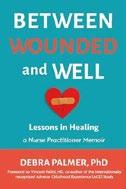
A nurse practitioner offers a memoir of her spiritual journey, featuring self-help elements.
Palmer divides her book into four sections, based on the four stages of wound healing: “Bleeding,” “Burning,” “Building,” and “Transforming.” In the first part, she covers her childhood and her experience of becoming pregnant at age 13. Palmer demonstrates impressive vulnerability as she explains how she advocated for herself and her child, setting expectations for her future. She notes that she made many personal sacrifices to get through a traumatic adolescence and later become a nurse. Palmer’s experiences were full of challenges—recurrent childhood trauma, career setbacks, miscommunications—and, in the book’s second part, she discusses how she dealt with the intense emotions she felt along the way. In the third part, Palmer is candid about her experience of raising children with her second husband. She says that she wanted to help people by becoming a medical advocate, and she continued to challenge herself through certification and training. She also learned that, even if one processes past trauma, it still can affect one’s present. The author is open and revealing about her career, marital, family, and financial struggles. In the fourth part, she recounts finding her purpose and a path forward, as well as resolving many past conflicts. Palmer’s memoir is heartbreaking at times, but ultimately encouraging and hopeful, showing the benefits of working hard to accept oneself and others: “The final stage of our emotional and spiritual healing requires acceptance of what we have no control over. Unlike physical healing, emotional and spiritual healing continue throughout our lives. There is always hope and possibility for more healing.” The thematic section and
chapter titles, and other aspects that draw on the author’s medical training, feature jargon that some readers may sometimes find difficult to understand. However, the book, which the author wrote “to inspire and encourage others on complex journeys,” is likely to help many readers looking for a greater sense of balance in their lives.
An often inspirational and ultimately joyous life story.
Kirkus Star
Petersen, Brian | Pronghorn Press (396 pp.)
$24.95 paper | June 15, 2025 | 9781941052761

A banker looking for second chances navigates the treacherous social currents of a small town in Montana in Petersen’s soulful novel. Returning to his boyhood home of Harlowton, Montana, after alcoholism, womanizing, and an occasionally violent temper demolished his career and marriage in Bozeman, Chet Norem takes a job as president of the Harlo International National Bank and starts rebuilding his life. That’s not easy, given the numerous oddballs and schemers among the townsfolk. First among them is his boyhood pal Charlie Shinola, a loose-cannon cowboy whom Chet is always rescuing from scrapes, including a two-day bender that concluded with Charlie driving Chet’s truck into a deer (which left Charlie with a ticket from the game warden and a major repair bill). Further complicating Chet’s life are the bank’s majority stockholder, who constantly questions Chet’s decisions, and Chet’s lawyer, who secretly spreads malicious rumors about the deer crash to besmirch his client’s reputation. Chet’s also fighting a cold war with his cruel ex-wife, Jess (“You look...smaller than I remember,” she jibes), and trying to repair his
relationship with his estranged son, Noel, a gay theater major and drug addict who believes that Chet is not his father—and is under the spell of a sinister artist. On the plus side is Lacey Dey-Lux, the multifaceted daughter of a wealthy rancher—she’s a southern belle, assertive businesswoman, and painter—who borrows money from the bank to build a riding arena; she and Chet begin a torrid affair, with Chet only somewhat perturbed by the fact that she’s married. Chet continues trying to shore up his family, friends, and business, but his moral compromises increasingly destabilize his situation and put his reputation as a steady financial pillar at risk, until tensions come to a head in a shocking eruption of bloodshed.
Petersen’s yarn feels like a sagebrush-flavored John Updike novel. It evokes the vast landscape of Montana cattle country, where even a banker must contend with winds and hailstorms, glittering but treacherous trout streams, and corrals knee-deep in manure. The labyrinthine narrative loops back and forth across generations of Harlo’s secret loves, vendettas, and hidden parentages, knotting the characters into intricate skeins of resentment and obligation. Chet is a tarnished but decent hero, a careful numbers guy with a yen for art and poetry stuck in mid-life, still grasping at sex and happiness but rueful and ruminative about his failings. (“He hadn’t hugged his daughter in several weeks, and he hadn’t spoken to his son in months. At some point, it dawns on a man that he just may never love again.”) Petersen’s prose luxuriates in pungent, pitch-perfect dialogue that banters obliquely around his characters’ conflicts—until it comes harshly to the point. (Confronted in flagrante by a jealous, knife-wielding boyfriend, Chet hears “the morning-after hacksaw voice of his lovebird waitress, the perfect tone and texture to convey her considerable wrath: ‘Lousy fucking chickenshit showing up here like this now…You stand back or I’ll blow you in half before you so much
as nick a hair offa his ever-lovin’ ass.’”) The result is a superb modern Western, full of evocative detail and hard-bitten wisdom.
A rich portrait of a man and a town hanging by a thread, beautifully written and deeply felt.
Fork’s Tale
Rodella-Purdy, Cindy | Creative Cat Media (34 pp.) | $14.99 paper | September 30, 2025 | 9781735881317
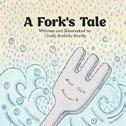
In author/ illustrator
Rodella-Purdy’s picture book, a fork has an adventure at the diner where it lives.
An unnamed fork narrates its day, starting with a relaxing sojourn in a dishwasher before a server carries it into an empty restaurant: “With the sound of footsteps and dishes clanking, it is time to go to work,” the fork notes. A baby immediately grabs it and upsettingly bangs it on a table; however, the child quickly puts the fork to use, stabbing a piece of broccoli, a squishy tomato, and a carrot, and leading the utensil to think, “Oh no! It is going to eat me!” The fork then dizzily spins through spaghetti before the baby flings it to the floor, where someone sweeps it up with a broom and treats it to another calming wash. There’s not a lot of story here, and young readers will surely have some questions; for instance, why would a fork fear being eaten? Is this its first day on the job? And who lets a small baby flail a pointy object around? However, the art is the real draw here. Rodella-Purdy’s soft watercolors are lovely to look at, and the fork’s face is remarkably expressive, effectively managing to convey distress,
sadness, surprise, and the wonderful serenity of a hot bath. A somewhat odd story, accompanied by appealing illustrations.
Saye, Bryan R. | Bowker (378 pp.)
$24.99 | $15.99 paper | October 8, 2025 9798988142331 | 9798988142348 paper

In Saye’s historical novel, a German Jewish émigré becomes a member of an elite group of United States Army soldiers trained to interrogate German POWs in World War II.
Readers first meet 17-year-old Johannes (Hans) Schmitt on Nov. 9, 1938, as he is walking with his father to the synagogue in Briedheim, Germany. His father is a tailor, and they are bringing clothes to the children in the orphanage attached to the synagogue. Hannah Becker (Hans’ girlfriend) and her father are also at the synagogue. It is a day that will end in Hell: The German Gestapo, riding in their long black Mercedes automobiles, fill the streets. While Hans and his father are at the orphanage, the Nazis attack the kosher butcher shop, breaking the glass windows, stealing all the meat, and beating the butcher to within an inch of his life. Hans and his father escape back to their tailor shop, but soon enough, the Gestapo arrives and kills Hans’ father. It is a scene repeated all around Germany on an occasion now known as “Kristallnacht,” the night of broken glass. Hans and his mother move into the orphanage, and in August 1939,
Graphic, frightening, and packed with military details.
THAT SUCH MEN LIVED
Hans learns that his mother has arranged for him to go to America, under the sponsorship of his father’s old WWI friend—now a professor at the University of Virginia. Professor Cohen is permitted to sponsor only one German, and Hans’ mother insists that he must be the one to escape Germany. Hans boards the MS Batory, the ship that takes him from Gdańsk, Poland, to the port in New Jersey. Moments after the Batory pulls out of the harbor, a German battleship, ostensibly in port to begin peace treaty talks, begins firing rockets at Gdańsk; it is the official beginning of World War II. In November 1943, Hans is inducted into the U.S. Army and posted first to Camp Pickett in Virginia and then to the secret Camp Ritchie in Maryland.
It is at Camp Ritchie that the novel gains steam, moving beyond Hans’ emotional, personal story to encompass the extraordinary tale of “class twenty-two” of the Ritchie Boys, whose unique mission was to elicit real-time battle plans and weaponry details from captured German soldiers. In the narrative’s first, terrifying heavy-action scene, class twenty-two, under fire from the ground, parachutes into France behind enemy lines in preparation for the invasion of Normandy: “The night exploded into day as the Skytrain flying beside us erupted in a fireball of brilliant orange and red. For a single moment, I watched in awestruck silence, too dumbfounded to react as the plane cartwheeled away, not a single parachute emerging from the tumbling wreckage.” Saye’s meticulous prose is graphic, frightening, and packed with military details, including intricate descriptions of German weaponry and organizational structure. From the fields behind Normandy to the Battle of the Bulge in Belgium to the discovery of the concentration camps, the chilling brutality of war pours off the pages. Hans is a passionate narrator who viscerally communicates his raw emotions throughout the story, particularly his love for Hannah and his mother, his raging hatred for the Nazis, and his fierce determination. Poignant, disturbing, and riveting.
Seibert, Elizabeth A. | Self (314 pp.) | $14.99 paper | August 5, 2025 | 9798998824609

Seibert’s second YA novel follows a 17-year-old Non-Super Regular Person who attempts to solve the mystery surrounding her mother’s death while maneuvering the pitfalls of high school.
After her mother died in a car crash three years earlier, Madeline Roberts’ life hasn’t exactly been idyllic. Living with her auto mechanic father, the teen’s daily existence revolves around swimming for her high school team (her older sister Arielle is the coach) and crushing on Golden Ace, Capital City’s most popular superhero—even though his suit is mustard-colored spandex! But when a new “Super” appears in the city—a black-clad mystery man named Dark Static, who may or may not be a villain—numerous revelations (and questions) upend Madeline’s world. Is the mayor, married to Madeline’s older sister, trying to kill her? Who’s Dark Static, and is he stalking Madeline or trying to help her? What does all of this have to do with Madeline’s mother’s death, which was ruled a tragic accident by the police? With the help of her best friend Kristen and a boy named Fox—whose parents died in the same crash that took Madeline’s mother’s life—the amateur sleuth begins investigating the massive conspiracy surrounding the car crash and begins a transformative journey of self-discovery. Action-packed, relentlessly paced, and featuring some impressively jaw-dropping plot twists, the story is an effortlessly readable. The only significant criticism is the missed opportunity when it comes to the lack of thematic depth and the absence of a deep examination of age-appropriate topics, specifically the exploration into sexual orientation. One main character’s queerness, for example, feels like an afterthought with only superficial analysis into family acceptance, peer prejudice, mental well-being,
etc. Lastly, although the novel’s conclusion is perfectly fitting—and satisfying—the potential is certainly there for Seibert to return to Capital City for more escapades featuring Madeline and company.
A fast-paced, fun fantasy for readers who enjoy their literary escapism powered by superheroes and villains.
Simon, Andrea | Sibylline Press (424 pp.) | $22 paper | September 26, 2025 | 9798897409785
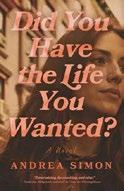
A Jewish woman from Brooklyn struggles through her first steps into adulthood in Simon’s introspective novel that probes the definition of a life worth living.
Anita Rappaport is a newly independent young woman in the Brooklyn neighborhood of Brownsville in 1968. When she becomes a victim of an attempted gang rape while in the field as a social-service caseworker, she reassesses everything in her life. Anita backpacks across Europe, and later bonds with her friends in a kind of quasi-group therapy; she also comes to terms with a childhood trauma. Overall, the novel travels across roughly a decade of Anita’s life, chronicling the beginnings of some key friendships she has with other women: Denise, her longtime pal turned roommate; Shirley, a single mother with whom she later starts a business; Cindy, a work friend with a deadbeat boyfriend; and Marilyn, a quiet and tragic figure who worked with Anita and Shirley at a publishing house. The concluding scenes, set in 1976,underline the importance of these friendships; Anita asks the book’s titular question to those close to her, leading to a bittersweet ending. The scenes set in Anita’s youth effectively mull over the meaning of life, while those set much later question whether she successfully led a meaningful
existence. Although the narrative’s time jumps sometimes give the work a disjointed feel, each scene is sharply focused and often emotionally powerful. Vivid moments of sexism arise throughout, as when her male therapist condescendingly simplifies her trauma, or when a judge initially ignores her personalized wedding vows, opting instead to read standard ones first, containing the word obey. A creative soul, Anita is unsatisfied with her editorial jobs, but it’s only when she’s in her 60s that she pursues a master’s degree in writing, which serves as a powerful reminder that it’s never too late to pursue a dream. A turbulent but often poignant fictional portrait of a life in progress.
Sir, Gramma | Self (32 pp.) | $9.99 paper August 13, 2025 | 9798999287106

An overly critical rabbit learns the errors of her ways in author/ illustrator Sir’s picture book. Bunny never leaves her burrow without tying her long ears up, so no one can see that one ear’s a bit floppy. “She wanted everything to be perfect. Maybe that’s why she was very judgy.” She finds fault with everyone she meets— Horse’s shoes are too small, Pig is messy, Goat is loud, and his diet needs improvement. Her criticisms leave them feeling anxious, embarrassed, and confused. The next day, Horse gets metal-bucket shoes, Pig takes a bath in a duck pond, and Goat eats Bunny’s carrots. Bunny, awakened by the commotion, runs out without styling her ears. Goat points out her floppy ear, and she begins to cry—but he assures her that “Ears can’t be wrong. They are just ears.” She’s perfect the way she is—in fact, they all are, he says. Accepting this, Bunny makes amends. The importance of being kind to oneself and others isn’t an
uncommon sentiment in kids’ books, but having young readers examine their own self-critical behavior is novel and worthwhile. The book also insightfully notes how a need for perfection can result in hurtful remarks. Sir’s colorful photo art is a treat, featuring cute, hand-felted animals posed in miniature fabric landscapes. An excellent lesson in being gentler, featuring adorable visuals.
Stanton, Christopher | Self (138 pp.) | $16 paper | August 22, 2025 | 9798297577206

Stanton’s novel tracks the intersecting lives of customers and employees of a 1980s mall. It’s 1983, and a brand-new indoor shopping center has just opened up on the edge of a large Ohio city. Built on the former site of a meadow filled with wildflowers, Dandelion Crossing is all things to all people: an eyesore and traffic magnet to local homeowners; a place of employment for lonely do-gooders, bookish transplants, and ex-convicts; a mark of progress for an ambitious local politician; and a glass-ceiling-shattering zenith in the career of the mall’s female executive. It’s a place where an artist, recently relocated from New York City and suffering from heartbreak, finds his groove coaching a team of high schoolers in a breakdancing competition; where a closeted gay teen decides to risk being recognized while seeing a movie about a male stripper; and where a widow in need of a new hairdresser finds herself in the chair of a spiky-haired goth whose receptionist seems unfamiliar with the concept of a perm. The mall brings together locals from across the metropolitan area who might otherwise never meet, allowing storylines to converge unexpectedly and longsimmering emotions to burst forth like
water from the mall’s fountain. Stanton revels in the ’80s setting, enhancing the stories with funny period references. A gang of rowdy teenage girls calls themselves The Benatars, for instance, and a hapless pet store employee evaluates her own sexual orientation based on the era’s detective shows: “Truth be told, Amy wasn’t sure where she fell. Except for her persistent crush on TV’s mustachioed Matt Houston, whose devil-may-care independence she greatly admired, it was rare for her to feel sexual attraction to anyone.”
(There’s even a phone-call cameo by art icon Keith Haring.) In Stanton’s capable hands, the sterile mall quickly transforms into an unlikely town square: a place where people not only search for goods and services, but for connection in all its forms.
A heartfelt and deeply human collective portrait set in a palace of consumerism.
Thorndike, John | Beck & Branch (268 pp.) $15 paper | September 15, 2025 9798992668216
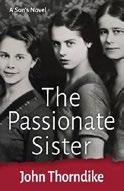
An alcoholic fights to reclaim her life while tending to a dying friend and young children in Thorndike’s luminous novel of recovery.
Fifty-seven-yearold anesthesiologist Ginny Thorndike is leaving rehab after overdosing on booze and pills following a downward spiral of addiction that broke up her marriage and got her medical license revoked. Helping her is her son Rob, who stays at her Sag Harbor, New York, cottage, flushes her stash, and distracts her from cravings. When he returns to his six-member group marriage at an Ohio commune, her other son Jamie and his boyfriend, Miles, fly up from Key West to continue the vigil, but the caretaking dynamic
flips when Miles develops Lou Gehrig’s Disease. As the fatal neurodegenerative ailment worsens, Ginny, with nothing better to do, moves to Key West and helps Jamie with Miles: She feeds him, helps him use the toilet, wheels him to the beach, and develops an intense spiritual bond with him as death approaches. Duty calls again when Rob’s group marriage collapses and his wife Natalia gives birth to twins; she abandons the family, prompting Rob to summon Ginny for emergency baby care. The twins run her ragged but also reinvigorate her, and over several years she regains her medical license and starts a thriving relationship with a man. Thorndike makes Ginny a complex, prickly, conflicted heroine, ashamed of her sins, apprehensive about her future, adrift and in search of redemption. Her story provides a vivid study of the psychic fragility of recovery, conveyed in haunting prose that evokes the unappeasable power of alcoholic yearning. (“She’s afraid of how she’ll feel when she’s alone, at dusk, at seven at night, at eight and nine and ten. She wants to say, Don’t leave me.”) The result is a moving testament to the ways in which taking up the burdens of others can lift a heavy weight from the heart. A captivating story of midlife renewal.
Turner, Kitty | Daily House (356 pp.) | $24 paper | August 26, 2025 | 9781733668781

A woman with a magical lineage gets involved in the shady dealings of a celebrity on a Caribbean island in Turner’s novel. Gemma August looks forward to the possibility of financial security when she accepts a job ferrying groups of “actresses and fashion models” by boat to the private island of the rich and famous musician Cowboi Rivers. She was already one of the few gainfully employed residents of St. Columba Island, but her seasonal work selling timeshares to tourists didn’t pay
the bills year-round. Sure, the job vacancy only occurred after her predecessor mysteriously went missing—but at $1000 per day, she knows that the gig would help her to realize her dream of starting her own charter company. She soon realizes, though, that whispers about missing women, drugs, and corruption at Cowboi’s Easter Cay island may be more than just rumors. Meanwhile, Gemma’s grandmother reveals that she comes from a long line of Vodou priestesses and that Gemma stands to inherit not only the leadership of Mariposa’s End, a beachfront settlement, but also the title of priestess. Although Gemma was born on the island, her Vermont upbringing has made it difficult for her to connect with her island bloodline; she’s “too American for the locals, too Island for the mainlanders.” When Gemma and her crew embark on a final pickup in the Dominican Republic, they get more than they bargained for. Turner’s psychological thriller is part character study, part commentary on the stratification of Caribbean society. The author effectively layers in themes of identity, exploitation, and survival into a story of suspense and ancient magic. Long passages of beautiful description create a strong sense of place: “The weathered wooden sign above the entrance swayed over the propped-open door, its paint chipped but still legible after years of exposure to sun and salt. Inside, ceiling fans spun lazily overhead, barely disturbing the humid, rumscented air that clung to everything like an invisible film.” Still, although these sensuous details successfully transport the reader to St. Columba, they also occasionally interrupt the plot. Readers who love a flawed protagonist will enjoy this satisfying beach read.
Vaho | Illus. by Felipe Flores | Mad Cave Studios (124 pp.) | $19.99 paper October 7, 2025 | 9781545812662
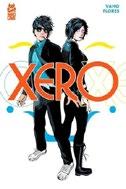
In a world where humanity is confined to a vintage shopping mall staffed by robots, a disconsolate gamer pines for his missing pregnant girlfriend.
In this SF/ fantasy graphic novel from the team of Vaho (script) and Flores (art), Xero is a videogame and music enthusiast languishing in the doldrums since the disappearance of his pregnant girlfriend, Donna. Her vanishing is hardly the strangest element of the story: Xero—and the rest of society—dwell in a state of perpetual consumerist amnesia, lodged in a vast, 1980s-style mall maintained by robots. Nobody seems to remember how they got there, and even Donna is a fuzzy recollection (“Life’s a movie and I’m a reel of film,” the confused Xero reflects). Xero crosses paths with a fearsome, sexy warrior who reveals to him the wasteland of Earth’s surface. It seems that a clan of techno-tycoons called the Rorks (think Ayn Rand) once dominated the planet, opposed by a rebellion led by rock-music idol Francis Faust, a guy with strong fixations on the pop-culture ephemera of the 1970s and ’80s. Though outgunned, Francis found some diabolical allies in the supernatural world, and the resulting stalemate has resulted in the present dystopia. The Rorks, taking post-human android-superhero forms, have evacuated to space as what’s left of mankind persists in blind ignorance in the kitschy mallworld concocted according to the magical Francis’ aesthetics. Where does Xero fit
A dazzling, reality-bending mix of cyber-future paranoia and occult demonology.
into all this? He seems to be a mostly ordinary, unimpressive, and bewildered guy, not a messiah figure. (But that’s where Donna fits in...) The narrative rapidly downloads a lot of head-spinning exposition, but the story manages to remain relatable. Fans of weird fiction and followers of alt-world Japanese anime/ manga will find much to appreciate here. Flores, whose work exhibits a strong Winsor McCay influence, has designed tarot card decks, and that symbolism is on display here, as are a number of pop-culture visual quotes, familiar song lyrics, and examples of girly art. The yesteryear mall-rat culture takeoffs are not as overdone and heavy-handed as they could have been, and you don’t need a tarot reading to predict that sequels lie beyond the open ending.
A dazzling, reality-bending mix of cyber-future paranoia and occult demonology.
Vander Velden, John W. | Self (572 pp.) | $27.98 paper | June 24, 2025 | 9798318801853

In this fourth volume of the late19th-century-set Misty Creek series, Vander Velden offers a deeply felt story about faith, resilience, and the meaning of family.
Elizabeth Sonnefelt, formerly a schoolteacher in Ohio, has made a new life in Kansas with her husband, Matthew, and the boy they rescued, Nick. Their days follow a comforting rhythm of millwork, prayer, and companionship until an unexpected letter disrupts their peace. Susan Wilson, a teacher they met years earlier, writes that the Wahls children—Lester, Frances, and Esther—have been abandoned after their grandparents fell ill. “It seems the poor little ones are no longer wanted by their father’s family,” Elizabeth reads with dismay. The couple must decide whether to take on the enormous responsibility of bringing the children into their home. Vander Velden builds the tension slowly,
through both Elizabeth’s quiet yearning—“‘How will I,’ she whisper[s] to the wind, ‘know my motives are noble?’”— and Matthew’s steady pragmatism. Their dialogue underscores the novel’s central theme: love requires courage. “Every time things move along smoothly,” Matthew reminds her, “something happens that forces you to change your plans.” The narrative intertwines the couple’s private struggles with broader spiritual reflections. Elizabeth grieves her barrenness and sees in the orphaned children both a burden and a blessing. Nick, once an outsider himself, wrestles with feeling a sense of belonging as he grows into manhood. Side characters, such as the gossip-prone but ultimately loyal Eleanor Lewis, add texture to the community and reveal Vander Velden’s gift for portraying both the flaws and quiet heroism of ordinary people. At times, the prose lingers on domestic details—Elizabeth washing dishes, Matthew adjusting a sluice gate—which may feel slow to readers expecting faster pacing. But those drawn to inspirational historical fiction will find that the measured rhythm mirrors that of frontier life, grounding the novel’s message of hope and perseverance. A welcome reminder that even in loss and hardship, unexpected light can guide us to love and renewal.
Van Rheenen, Erin | Sibylline Press (262 pp.) | $19 paper | September 16, 2025 9781960573476

In Van Rheenen’s novel, a woman travels to Costa Rica to track down her absentee father after the loss of her mother. It is April of 2010, and Lucy, a single, 30-something teacher with a scientific passion for insects, is reeling after the death of her mother. Lucy’s estranged sister, Faith, immediately claims the family’s California home for her family. Angry and grief-stricken, Lucy makes the impulsive decision to spend her eight-day spring break in Costa Rica to track down her biological father, Gabriel
Mora Soto, who left behind a stack of letters addressed to her mother and, as far as Lucy knows, may not even be alive. Arriving in the small village of Palmita, where Lucy and her family used to spend their summers, she meets friends both old and new, including her childhood friend, Inés (who now goes by Calaca), and Calaca’s son, Beto; Hilda, her kindly hostess for the week; and Gabriel’s discombobulatingly handsome bar-owner friend, Rafa. Each section of the narrative spans one day of the week, from Saturday to Saturday, as Lucy explores Palmita, discovers surprising personal connections to those around her, and tries to uncover the truth about her parents’ past. Van Rheenen crafts a delicate and thoughtful story of one woman’s attempt to find and make meaning in both her past and present, with the idea of nature as a healing force nudging Lucy along her path of self-discovery. While the pace occasionally lags, the smooth, sometimes poetic prose deftly leads Lucy through the twists and turns of her familial journey: “She felt all of Palmita tremble underfoot as old alliances and assumptions collapsed, and new ones sprang up. Where would she land in this seismic rearrangement?” Van Rheenen’s deep exploration of Lucy’s sense of self yields a fascinating and layered examination of how pain, rage, and grief can ultimately give way to hope and resilience. A beautiful homage to family that urges readers to rethink what “home” can really mean.
Welser, William | Radius Book Group (272 pp.) | $19.99 paper | October 28, 2025 9798895150801

Welser urges readers to reconsider their relationship with technology in this debut nonfiction work. Per the author, humans have always been drawn to the psychological power of stories—the cave art at Sulawesi tells the
tale of a Paleolithic hunting party from 45,000 years ago. Stories, at their core, reflect humanity’s ubiquitous desire for meaning. Yet, writes scholar and entrepreneur Welser, in an era of doomscrolling, AI-generated content for social media consumption, and influencers who peddle highly edited versions of their “real” lives, authentic stories are hard to find. Reflecting on a potential future economy in which, in the words of Bill Gates, “Humans won’t be needed for most things,” the author posits a novel, alternative economic model that allows individuals to break the manipulative tactics of “Big Tech” and restore their mental and physical well-being by leveraging their personal, authentic stories as “currency” in a “story-based marketplace.” While Welser’s promise to “rearrange capitalism” may be overly ambitious, the author offers convincing and harrowing social commentary on the destructive power of modern technology. (He compares smartphones to a “drug in [his] pocket, dependent on stimulation”). Among the many psychologically damaging aspects of technology covered in the book are Phantom Vibration Syndrome (a condition in which heavy phone users remain in a heightened state of alertness in anticipation of the next notification on their device) and the dopamine hits that become a daily part of an “internet junkie’s” daily routine. The author offers here a research-backed guidebook to freeing oneself from technology’s deprivations. As the former director of the Engineering and Applied Sciences Department at the RAND Corporation and the current CEO of Lotic.ai, Welser is far from a Luddite, and his insider’s perspective amplifies his dire warnings about unregulated Big Tech. The book’s engaging graphs and other visual aids accompany accessible text.
A well-researched and surprisingly poignant commentary on the dangers of technology.

For more Indie content, visit Kirkus online.
Available in hardcover, quality paperback, audiobook, and ebook formats


“A first purchase for all libraries.” School Library Journal
“A superb pick for readers interested in history and activism.” Kirkus Reviews
“Kadarusman reimagines a story of the past not o en told.” Booklist
“Inspired by the true story of a nineteenth century feminist.” Fuse 8, Betsy Bird







